Category
History of Photography
24 entries in this category | view all categories
New Year Liftoff
Posted January 2017 in Aerial Photography, History of Photography, New Additions, Significant Photographers
“Liberty cannot be preserved without a general knowledge among the people.”
– John Adams
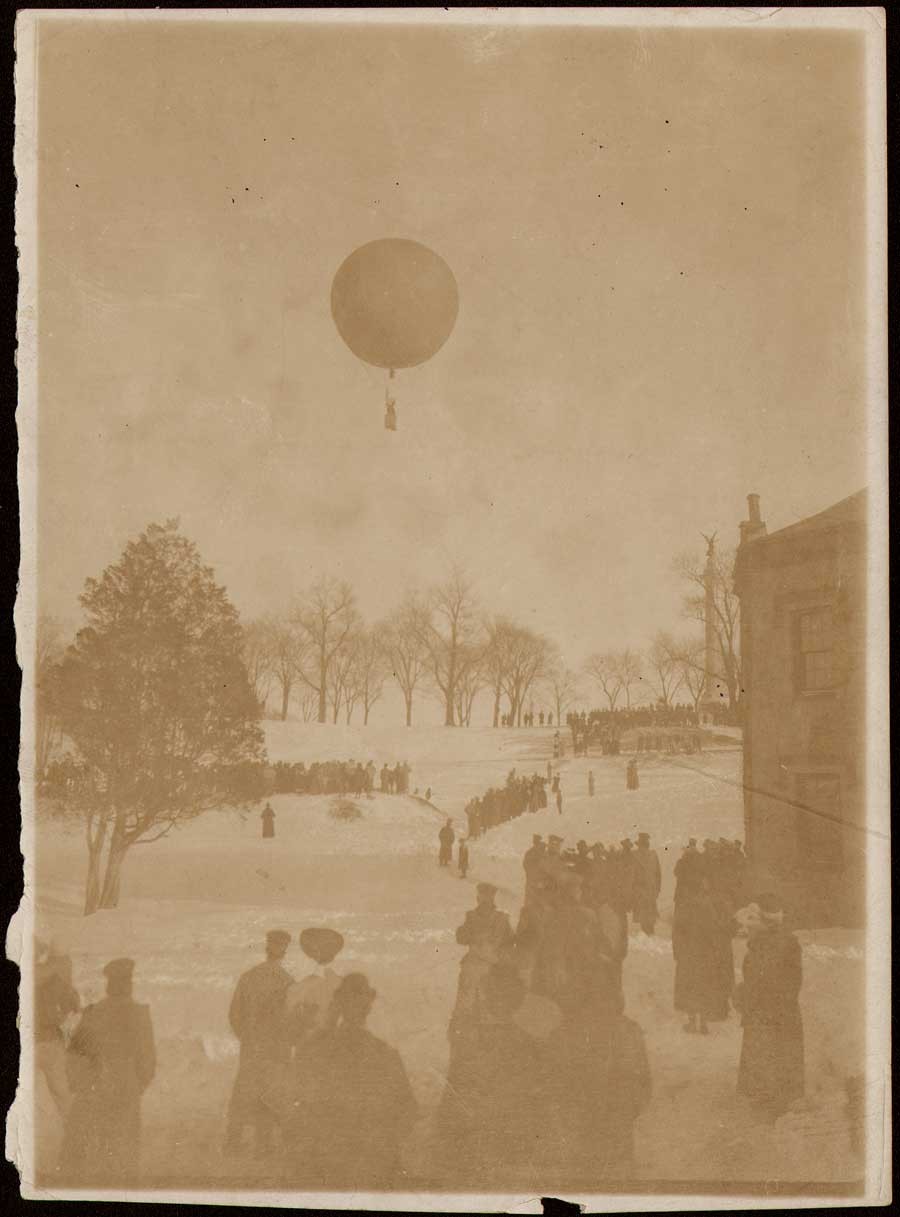 "First Balloon Flight Under the American Aero Club": 1906: James H. Hare: British: 1856-1946: Chloride print (POP) 17.05 x 12.05 | 17.6 x 12.8 cm: With a crowd looking on including officers, cadets and scientists, French aeronaut Charles Levee is seen ascending in the balloon "L'Allouette" from the siege battery at West Point Military Academy in New York State on Sunday, 11th February, 1906. This is the original photograph taken by pioneering British photojournalist Jimmy Hare of the ascent, which was published for his employer Collier's Magazine on 24th February of that year. The fledgling American Aero Club, based in New York City, hired Charles Levee to pilot their 28' diameter yellow balloon, which took 12,500 cubic feet of coal gas to inflate according to a New York Times dispatch. "Wearing an ordinary Winter overcoat and a close-fitting cap" Levee ascended at 3:55 p.m. in the basket of the balloon made of cotton-fabric (the first time a balloon launched from West Point) and traveled nearly 60 kilometers before finally descending at Hurley, New York at 8:10 p.m. with the aid of a rip cord. from: PhotoSeed Archive
"First Balloon Flight Under the American Aero Club": 1906: James H. Hare: British: 1856-1946: Chloride print (POP) 17.05 x 12.05 | 17.6 x 12.8 cm: With a crowd looking on including officers, cadets and scientists, French aeronaut Charles Levee is seen ascending in the balloon "L'Allouette" from the siege battery at West Point Military Academy in New York State on Sunday, 11th February, 1906. This is the original photograph taken by pioneering British photojournalist Jimmy Hare of the ascent, which was published for his employer Collier's Magazine on 24th February of that year. The fledgling American Aero Club, based in New York City, hired Charles Levee to pilot their 28' diameter yellow balloon, which took 12,500 cubic feet of coal gas to inflate according to a New York Times dispatch. "Wearing an ordinary Winter overcoat and a close-fitting cap" Levee ascended at 3:55 p.m. in the basket of the balloon made of cotton-fabric (the first time a balloon launched from West Point) and traveled nearly 60 kilometers before finally descending at Hurley, New York at 8:10 p.m. with the aid of a rip cord. from: PhotoSeed Archive
Lately, I’ve become worried about that general knowledge thing. But this is not a lecture, and a new year is upon us, so bear with me here. Late this summer, I came full-circle back to my native New England after retiring from a 30-year run wearing the hat of photojournalist for newspapers across the country. Photographing and sharing the stories of people from literally all walks of life has been my best teacher and given me the most valuable education and perspective I could ever hope for in my career: the nuance of which I often find lacking in the public discourse of late rising from these so-called divided States of America.
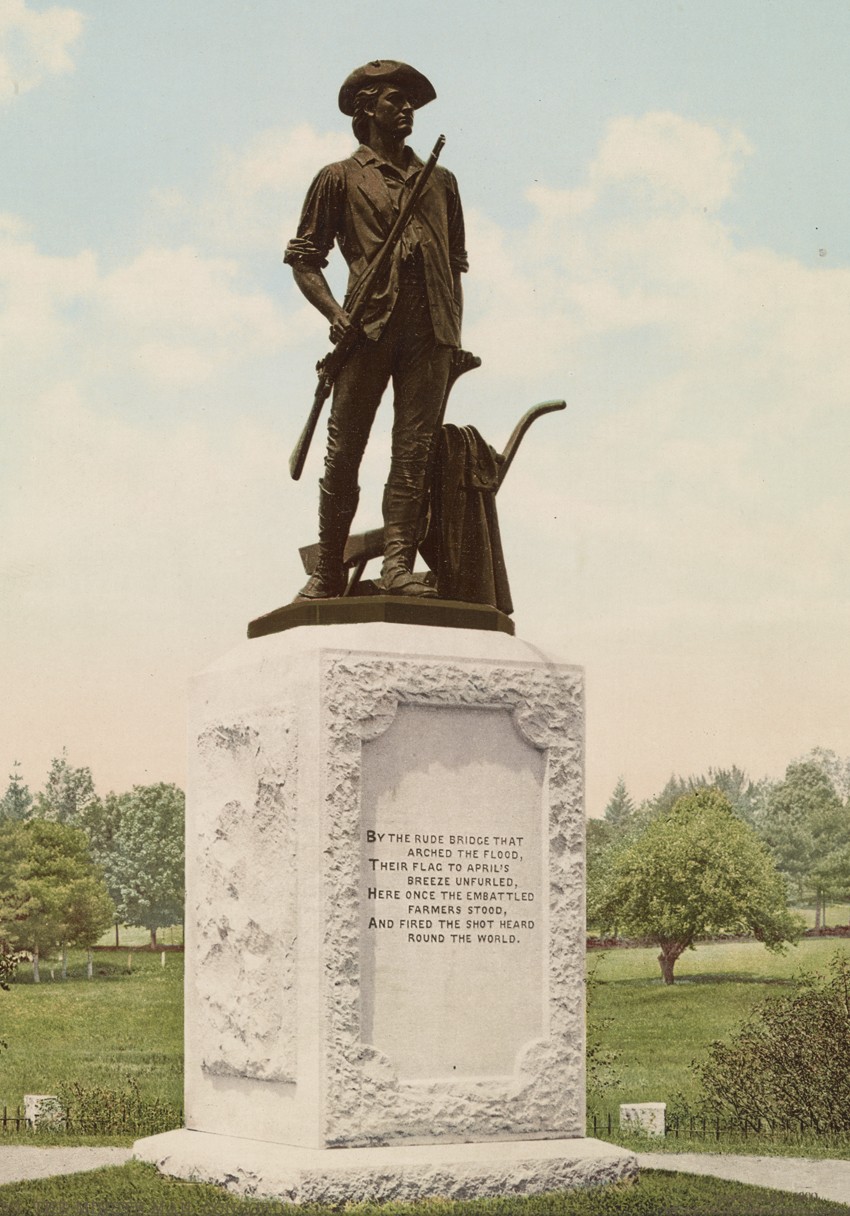 The Minute Man Statue: ca. 1900: by unknown photographer working for Detroit Photographic Company: Photochrom: from album (29.0 x 40.0 cm) of 48 Photochroms depicting mostly New England historical places and views prepared by the Detroit Photographic Co. for use as a catalog in their offices. Statue in bronze by American sculptor Daniel Chester French (1850-1931) dedicated on the centenary of the Battle of Concord on 19th April, 1875: During the first battle of the American Revolutionary War, which took place here at The Old North Bridge on the 19th of April, 1775 in the town of Concord, MA, (then located in the British Crown colony of the Province of Massachusetts Bay) a group of 37 Acton, MA Minutemen led by Captain Isaac Davis (b. 1745) faced off (with other militia companies made up of about 500 men) against 100 British "Regular" troops. Davis was the first casualty at the bridge during the American War of independence, with Acton Minuteman Abner Hosmer, (1754-1775) a private who played his drum into battle as company musician, the second mortally wounded after being shot through the head. (Acton Minuteman James Hayward also died later that day) On the base of this statue are inscribed the first stanza of American poet Ralph Waldo Emersons Concord Hymn from 1836:"By the rude bridge that arched the flood, Their flag to Aprils breeze unfurled, Here once the embattled farmers stood And fired the shot heard round the world." Said to be modeled after Captain Davis but also known to have been done from live models posing in the studio of sculptor Daniel Chester French, the Minute Man statue proudly shows the enduring American spirit during the nations struggle for freedom and independence. from: Library of Congress: Call Number LOT 12003, p. 30.
The Minute Man Statue: ca. 1900: by unknown photographer working for Detroit Photographic Company: Photochrom: from album (29.0 x 40.0 cm) of 48 Photochroms depicting mostly New England historical places and views prepared by the Detroit Photographic Co. for use as a catalog in their offices. Statue in bronze by American sculptor Daniel Chester French (1850-1931) dedicated on the centenary of the Battle of Concord on 19th April, 1875: During the first battle of the American Revolutionary War, which took place here at The Old North Bridge on the 19th of April, 1775 in the town of Concord, MA, (then located in the British Crown colony of the Province of Massachusetts Bay) a group of 37 Acton, MA Minutemen led by Captain Isaac Davis (b. 1745) faced off (with other militia companies made up of about 500 men) against 100 British "Regular" troops. Davis was the first casualty at the bridge during the American War of independence, with Acton Minuteman Abner Hosmer, (1754-1775) a private who played his drum into battle as company musician, the second mortally wounded after being shot through the head. (Acton Minuteman James Hayward also died later that day) On the base of this statue are inscribed the first stanza of American poet Ralph Waldo Emersons Concord Hymn from 1836:"By the rude bridge that arched the flood, Their flag to Aprils breeze unfurled, Here once the embattled farmers stood And fired the shot heard round the world." Said to be modeled after Captain Davis but also known to have been done from live models posing in the studio of sculptor Daniel Chester French, the Minute Man statue proudly shows the enduring American spirit during the nations struggle for freedom and independence. from: Library of Congress: Call Number LOT 12003, p. 30.
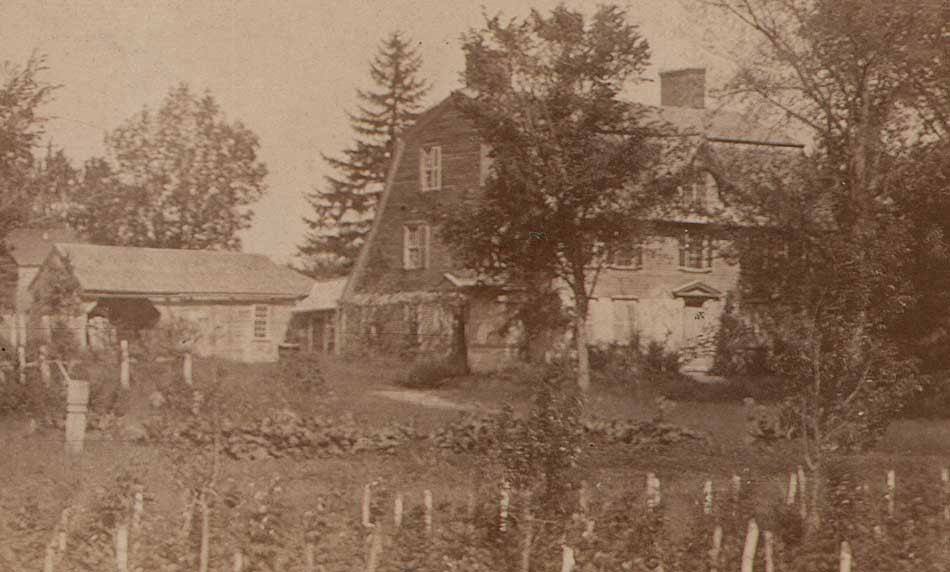 Detail: "Old Manse, No. 3" from: Views in Concord, Mass.: ca. 1885: Alfred Winslow Hosmer, American (1851-1903) Pasted Albumen print on oversized cabinet card with gilt edging: 11.2 x 19.8 | 18.1 x 21.4 cm: Approximately 110 years later, another Hosmer descendent to Private Abner Hosmer, the photographer Alfred Hosmer, photographed scenes in and around Concord like this one for sale as souvenir keepsake cabinet cards of battleground scenes and places, including the Minute Man statue. This view, showing the stately pile The Old Manse, was built in 1770 for the Rev. William Emerson, (1743-1776) whose family witnessed the battle at the Old North Bridge of 19th April 1775 from the upstairs windows of the home. Later, Emerson's grandson, the acclaimed Transcendentalist writer Ralph Waldo Emerson (1803-1882) lived in the home and later wrote his Concord Hymn of 1836 as referenced previously in this post. The photographer Alfred Hosmer, whose surviving archive of over 800 glass plate negatives is housed at the Concord (MA) Free Library, is also significant, according to the library, for "his role in establishing Henry David Thoreau’s reputation as a major American author. He was one of the earliest admirers and promoters of Thoreau’s life and writings. He expressed his sympathy with and interest in Thoreau through his own first-hand observations of the flora and fauna of Concord, his Thoreau-related photography, his correspondence with other Thoreau enthusiasts, and his active collecting of Thoreauviana." From: PhotoSeed Archive
Detail: "Old Manse, No. 3" from: Views in Concord, Mass.: ca. 1885: Alfred Winslow Hosmer, American (1851-1903) Pasted Albumen print on oversized cabinet card with gilt edging: 11.2 x 19.8 | 18.1 x 21.4 cm: Approximately 110 years later, another Hosmer descendent to Private Abner Hosmer, the photographer Alfred Hosmer, photographed scenes in and around Concord like this one for sale as souvenir keepsake cabinet cards of battleground scenes and places, including the Minute Man statue. This view, showing the stately pile The Old Manse, was built in 1770 for the Rev. William Emerson, (1743-1776) whose family witnessed the battle at the Old North Bridge of 19th April 1775 from the upstairs windows of the home. Later, Emerson's grandson, the acclaimed Transcendentalist writer Ralph Waldo Emerson (1803-1882) lived in the home and later wrote his Concord Hymn of 1836 as referenced previously in this post. The photographer Alfred Hosmer, whose surviving archive of over 800 glass plate negatives is housed at the Concord (MA) Free Library, is also significant, according to the library, for "his role in establishing Henry David Thoreau’s reputation as a major American author. He was one of the earliest admirers and promoters of Thoreau’s life and writings. He expressed his sympathy with and interest in Thoreau through his own first-hand observations of the flora and fauna of Concord, his Thoreau-related photography, his correspondence with other Thoreau enthusiasts, and his active collecting of Thoreauviana." From: PhotoSeed Archive
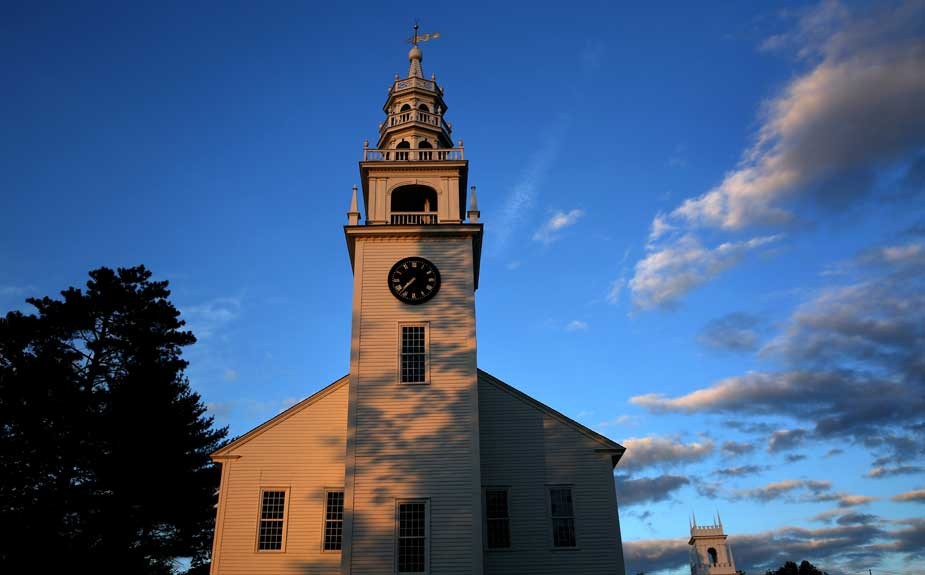 "Witness to a Revolution" (American): 2015: David Spencer for PhotoSeed Archive. With Mount Monadnock just off to the west, the waning light of day washes over the white clapboard siding of the Original Meeting House for the Town of Jaffrey, New Hampshire. Erected in 1775 only two years after the town's incorporation and after American Minutemen first began their armed fight with the British at Concord and Lexington, tradition states the frame of the structure was raised on Saturday, June 17th of that year, with workers recounting they heard booming cannon fire 70 miles east in Boston which they learned the next day was the Battle of Bunker Hill. Originally used by Congregationalists for church services and town business, worship took place here until 1844. The town website gives a few more details: "In 1822, the bell tower and spire were added, paid for by donations on the condition that the Town would buy the bell, which it did the following year. It was cast by the Paul Revere Foundry."
"Witness to a Revolution" (American): 2015: David Spencer for PhotoSeed Archive. With Mount Monadnock just off to the west, the waning light of day washes over the white clapboard siding of the Original Meeting House for the Town of Jaffrey, New Hampshire. Erected in 1775 only two years after the town's incorporation and after American Minutemen first began their armed fight with the British at Concord and Lexington, tradition states the frame of the structure was raised on Saturday, June 17th of that year, with workers recounting they heard booming cannon fire 70 miles east in Boston which they learned the next day was the Battle of Bunker Hill. Originally used by Congregationalists for church services and town business, worship took place here until 1844. The town website gives a few more details: "In 1822, the bell tower and spire were added, paid for by donations on the condition that the Town would buy the bell, which it did the following year. It was cast by the Paul Revere Foundry."
But I’m only one person, what can I do about it but spout a bunch of words? Photography of course. The so-called Universal language. Like everyone’s favorite sports team. Surely one can have opinions concerning old photographs? I’m betting yes and I hope you will.
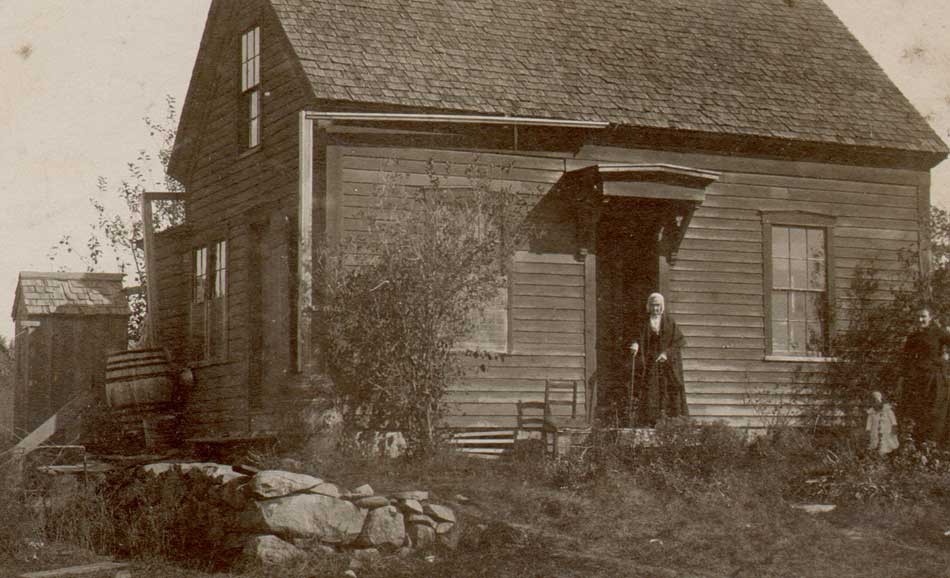 Detail: "Aunt Ward": ca. 1890-1900 : Attributed photographer: Charles Rollins Tucker, American (b. 1868): mounted brown-toned gelatin silver or albumen print on oversized card: 11.1 x 18.4 cm | 20.4 x 25.5 cm. Believed to have been taken in Massachusetts, and with cane firmly held in elderly hand, this unknown "Aunt Ward", who was a blood relation to the photographer, can be seen standing in threshold at center, could rightly epitomize the hardscrabble resourcefulness of a typical New England Yankee before all the modern benefits of the late 20th Century Industrial Revolution kicked into high gear. At the front of her weather-beaten Cape Cod style dwelling can be seen a trusty ladderback garden chair parked to the left of the doorway as well as wooden gutters overhead leading to large rain barrels front and back and anchored from behind at far left by a shingled outhouse. From: PhotoSeed Archive
Detail: "Aunt Ward": ca. 1890-1900 : Attributed photographer: Charles Rollins Tucker, American (b. 1868): mounted brown-toned gelatin silver or albumen print on oversized card: 11.1 x 18.4 cm | 20.4 x 25.5 cm. Believed to have been taken in Massachusetts, and with cane firmly held in elderly hand, this unknown "Aunt Ward", who was a blood relation to the photographer, can be seen standing in threshold at center, could rightly epitomize the hardscrabble resourcefulness of a typical New England Yankee before all the modern benefits of the late 20th Century Industrial Revolution kicked into high gear. At the front of her weather-beaten Cape Cod style dwelling can be seen a trusty ladderback garden chair parked to the left of the doorway as well as wooden gutters overhead leading to large rain barrels front and back and anchored from behind at far left by a shingled outhouse. From: PhotoSeed Archive
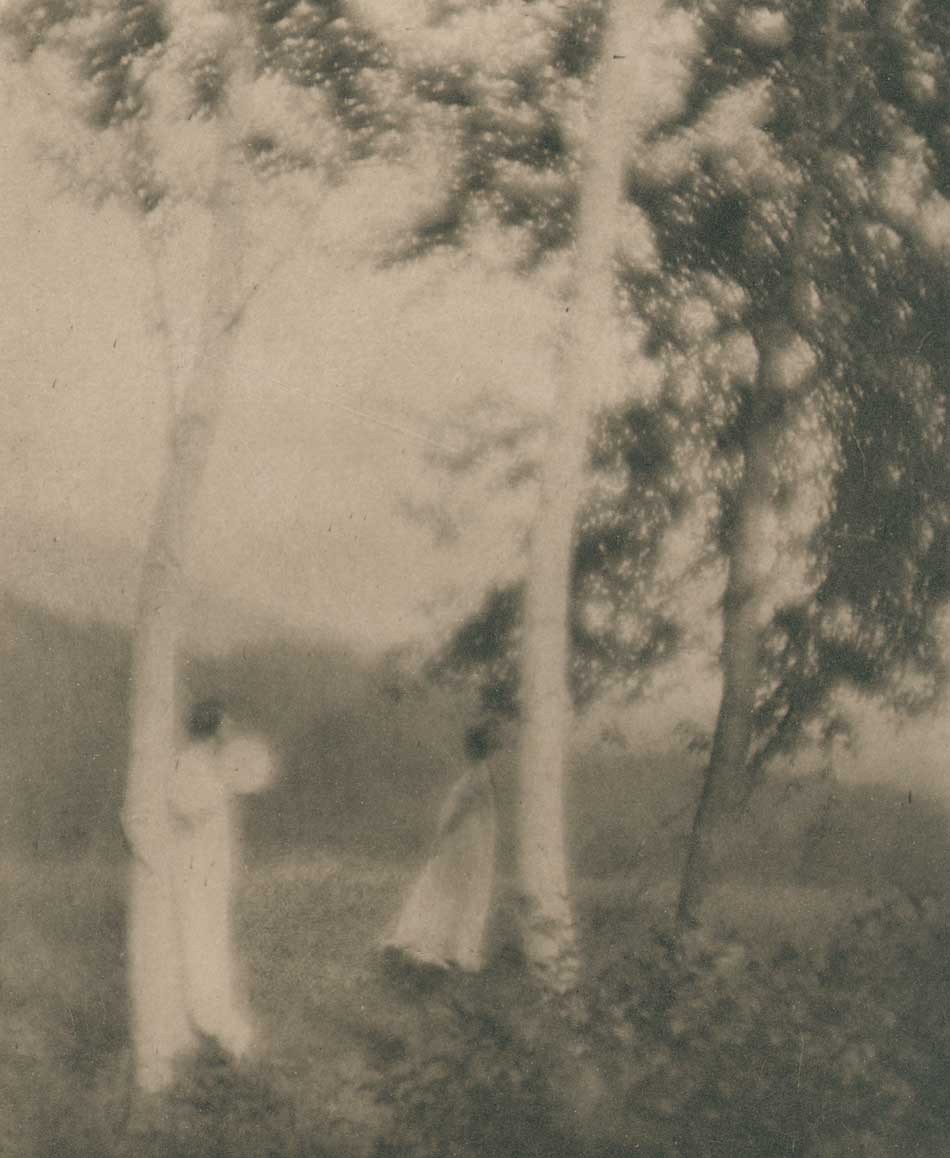 Detail: "VII. White Trees": 1910: George H. Seeley, American (1880-1955) : hand-pulled Japan-paper tissue photogravure by the Manhattan Photogravure Co. included with Camera Work issue XXIX:full image: 19.9 x 15.7 cm: Amateur photographer and painter George Henry Seeley, a native of Stockbridge, Massachusetts, made his living as supervisor of art for his local school district. In order to take full advantage of the showy beauty of the Berkshire region with a hint of the Taconic mountain range seen in the distance, he positioned his sisters in this plein air allegorical composition, with the trunk and back of a white birch tree (Betula papyrifera) anchoring this triangulated landscape at left. From: PhotoSeed Archive
Detail: "VII. White Trees": 1910: George H. Seeley, American (1880-1955) : hand-pulled Japan-paper tissue photogravure by the Manhattan Photogravure Co. included with Camera Work issue XXIX:full image: 19.9 x 15.7 cm: Amateur photographer and painter George Henry Seeley, a native of Stockbridge, Massachusetts, made his living as supervisor of art for his local school district. In order to take full advantage of the showy beauty of the Berkshire region with a hint of the Taconic mountain range seen in the distance, he positioned his sisters in this plein air allegorical composition, with the trunk and back of a white birch tree (Betula papyrifera) anchoring this triangulated landscape at left. From: PhotoSeed Archive
And photographic puns besides the point, I’ve learned there is no such thing as black and white-especially concerning peoples lives and how those lives are lived. Speaking of that aforementioned questionable public discourse, I’m more of the belief life is all about colorful nuance, and unless you have walked a mile in someone’s shoes, as my mother would say, what do you really know to be their reality and truths?
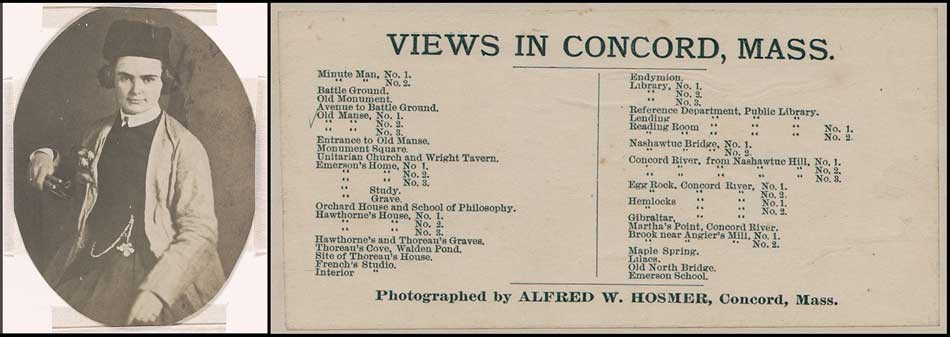 Hosmer & Sculpture: Left: Portrait of sculptor Harriet Goodhue Hosmer (1830-1908): by Frederick DeBourg Richards, American (1822-1903): ca. 1850-60: salted paper print on card mount ; photo (oval) 15.7 x 12.1 cm, on mount 35.5 x 27.9 cm: Considered the most distinguished female sculptor in America during the 19th century, and working in the neoclassical style, Harriet Hosmer clutches her sculpting tools seen at far left while wearing her artist's smock in this portrait probably taken in Rome, Italy. Born 50 years earlier than photographer and painter George Seeley, Hosmer finished her early education just north of Seeley's Stockbridge in the town of Lenox, completing a course of study at Elizabeth Sedgwick’s School for Young Ladies before learning disciplines including rowing, skating and riding. With an interest in anatomy at a young age spurred by her father Hiram's occupation as a physician, her artistic skills began to take form after she took private lessons when only 20. {Women were not allowed to attend medical schools during that time.} She decided to to travel to Rome to further hone her skills and quickly made a name for herself there, receiving her first commission in 1856. Many of her works survive, including a marble sculpture of Puck (Wadsworth Atheneum in Hartford, CT) and a towering 10' likeness in bronze of Missouri Senator Thomas Hart Benton dedicated in 1868 (recently refurbished) and located in Lafayette Park in St. Louis. Of this gender-breaking artist, Hosmer's friend Elizabeth Barrett Browning described Harriet as “a perfectly emancipated female.” from: LOC Call Number: LOT 14120, no. 20. Right: pasted paper label: "Views in Concord, Mass." ca. 1885: on verso of oversized cabinet card "Old Manse, No. 3": Photographed by Alfred W. Hosmer, Concord, Mass. label: 7.0 x 14.4 cm; card: 18.1 x 21.4 cm. Born 20 years after his cousin Harriet Hosmer, Alfred Winslow Hosmer (1851-1903) also had a connection with sculpture via his friendship with fellow Concord, Mass. resident and sculptor Daniel Chester French. French, whose first major commission was the Minute Man statue outlined in this post, also had his Concord art studio photographed by Hosmer, with several cabinet card views including French's life-size nude sculpture of the Greek mythical male shepherd Endymion listed here for sale. From: PhotoSeed Archive
Hosmer & Sculpture: Left: Portrait of sculptor Harriet Goodhue Hosmer (1830-1908): by Frederick DeBourg Richards, American (1822-1903): ca. 1850-60: salted paper print on card mount ; photo (oval) 15.7 x 12.1 cm, on mount 35.5 x 27.9 cm: Considered the most distinguished female sculptor in America during the 19th century, and working in the neoclassical style, Harriet Hosmer clutches her sculpting tools seen at far left while wearing her artist's smock in this portrait probably taken in Rome, Italy. Born 50 years earlier than photographer and painter George Seeley, Hosmer finished her early education just north of Seeley's Stockbridge in the town of Lenox, completing a course of study at Elizabeth Sedgwick’s School for Young Ladies before learning disciplines including rowing, skating and riding. With an interest in anatomy at a young age spurred by her father Hiram's occupation as a physician, her artistic skills began to take form after she took private lessons when only 20. {Women were not allowed to attend medical schools during that time.} She decided to to travel to Rome to further hone her skills and quickly made a name for herself there, receiving her first commission in 1856. Many of her works survive, including a marble sculpture of Puck (Wadsworth Atheneum in Hartford, CT) and a towering 10' likeness in bronze of Missouri Senator Thomas Hart Benton dedicated in 1868 (recently refurbished) and located in Lafayette Park in St. Louis. Of this gender-breaking artist, Hosmer's friend Elizabeth Barrett Browning described Harriet as “a perfectly emancipated female.” from: LOC Call Number: LOT 14120, no. 20. Right: pasted paper label: "Views in Concord, Mass." ca. 1885: on verso of oversized cabinet card "Old Manse, No. 3": Photographed by Alfred W. Hosmer, Concord, Mass. label: 7.0 x 14.4 cm; card: 18.1 x 21.4 cm. Born 20 years after his cousin Harriet Hosmer, Alfred Winslow Hosmer (1851-1903) also had a connection with sculpture via his friendship with fellow Concord, Mass. resident and sculptor Daniel Chester French. French, whose first major commission was the Minute Man statue outlined in this post, also had his Concord art studio photographed by Hosmer, with several cabinet card views including French's life-size nude sculpture of the Greek mythical male shepherd Endymion listed here for sale. From: PhotoSeed Archive
Through the platform of this website, I hope truth and reality of our shared photographic artistic past are presented with enough facts and context to make a difference. I’m hoping conversations will develop because it exists, and they will be shared in some fashion. Facebook likes, page views, and the latest and greatest apps don’t really concern me here. Instead, just about everything you see will be estate fresh, so dig in and have fun.
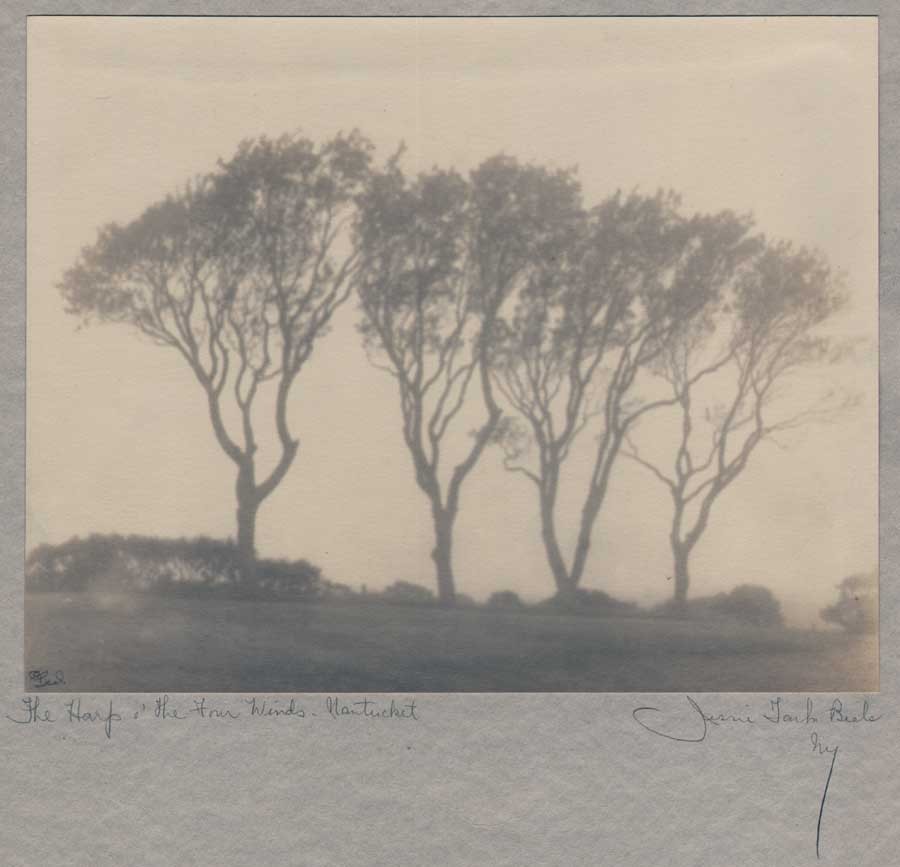 The Harp o' The Four Winds-Nantucket: Jessie Tarbox Beals, American, born Canada: (1870-1942) Gelatin silver print ca. 1905-15 (this example 1920-26 when she rented a salon-studio at 333 Fourth Ave. in N.Y.C.): 19.0 x 23.9 | 43.1 x 28.2 cm : Although not a New England native like Harriet Hosmer, Jessie Tarbox Beals was also groundbreaking for her gender, and is credited as being the first female photojournalist. New England and Massachusetts however played formative roles in her life. According to a short biography provided by the New-York Historical Society, which holds an extensive archive of Beal's work, Jessie was only 17 when she moved to Williamsburg, Mass from Hamilton, Ontario to join an older brother. There, her first job was teaching "seven pupils in a one-room schoolhouse for $7 a week"… later, she became interested in photography the following year in 1888 after acquiring her first camera in a magazine contest. Shortly, she became a professional after investing "$12 and bought a Kodak camera, with which she established a photo studio on the front lawn of her home. Local residents came to have their portraits taken, or to ask for pictures of their houses and other possessions. Beals was aided in her commercial endeavors by groups of Smith College students, (from nearby Northampton-ed) who wanted pictures to be made of their parties and picnics. By the end of two summers she was making more money taking photographs than teaching school." This example of Beal's landscape work was taken in the Bay State in Nantucket, a 1920 caption in the New York Tribune for it stating: "An early morning camera symphony—the Harp o' the Four Winds, Nantucket, Mass., at 5 a. m." From: PhotoSeed Archive
The Harp o' The Four Winds-Nantucket: Jessie Tarbox Beals, American, born Canada: (1870-1942) Gelatin silver print ca. 1905-15 (this example 1920-26 when she rented a salon-studio at 333 Fourth Ave. in N.Y.C.): 19.0 x 23.9 | 43.1 x 28.2 cm : Although not a New England native like Harriet Hosmer, Jessie Tarbox Beals was also groundbreaking for her gender, and is credited as being the first female photojournalist. New England and Massachusetts however played formative roles in her life. According to a short biography provided by the New-York Historical Society, which holds an extensive archive of Beal's work, Jessie was only 17 when she moved to Williamsburg, Mass from Hamilton, Ontario to join an older brother. There, her first job was teaching "seven pupils in a one-room schoolhouse for $7 a week"… later, she became interested in photography the following year in 1888 after acquiring her first camera in a magazine contest. Shortly, she became a professional after investing "$12 and bought a Kodak camera, with which she established a photo studio on the front lawn of her home. Local residents came to have their portraits taken, or to ask for pictures of their houses and other possessions. Beals was aided in her commercial endeavors by groups of Smith College students, (from nearby Northampton-ed) who wanted pictures to be made of their parties and picnics. By the end of two summers she was making more money taking photographs than teaching school." This example of Beal's landscape work was taken in the Bay State in Nantucket, a 1920 caption in the New York Tribune for it stating: "An early morning camera symphony—the Harp o' the Four Winds, Nantucket, Mass., at 5 a. m." From: PhotoSeed Archive
With mountains now in my backyard instead of the view of corn as high as an elephant’s eye from my last Midwest home, I’ve been thinking of late of the early ancestors and the roles they took-small but significant- in shaping from these parts an America I’m proud to call home.
Let me state off the top that my forebears did not come from money. Instead, other than the constant role of being soldiers in America’s early fight for Independence, they were hardscrabble Yankees: industrious farmers, deacons, bricklayers and later in the 19th century, stonemasons.
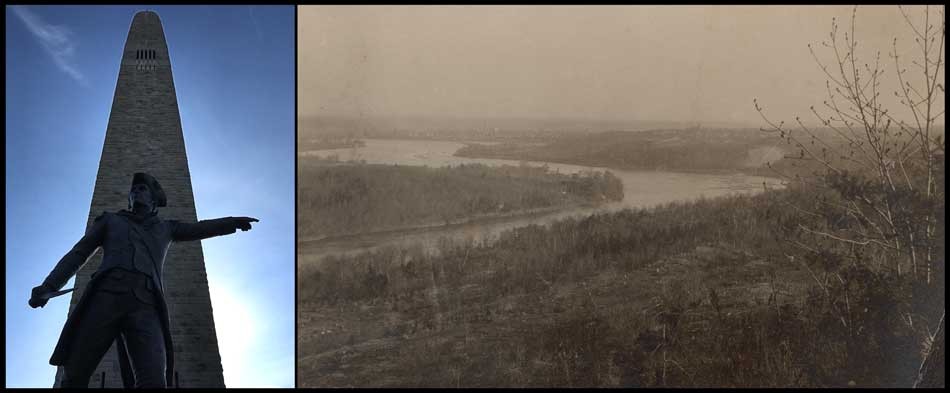 Left: American Revolutionary War Brigadier General John Stark (1728-1822) points the way at the base of the Bennington Battle Monument in Vermont. 2016: David Spencer for PhotoSeed Archive. On August 16, 1777, approximately 2,000 militia members led by John Stark soundly defeated British General John Burgoyne's army made up primarily of Hessians during the Battle of Bennington at Walloomsac, New York. Although the battle lead to Burgoyne's eventual surrender at Saratoga and "galvanized colonial support for the independence movement" (Wikipedia) the battle was not without 30 militia causalities, including 17-year-old Jonathan Hosmer, Jr., (1760-77) the second Hosmer to die in the American Revolution after his uncle Abner nearly two years earlier at Concord. Right: "The Connecticut": 1897: Charles Rollins Tucker, American (b. 1868): albumen print : 12.4 x 17.6 cm | 16.6 x 21.4 cm: Besides being a primary inland navigational route used extensively by Native American tribes hundreds of years before European colonization, the Connecticut River and its watershed encompassing the fertile Connecticut River Valley remains largely responsible for the regions continued development. This longest of New England rivers not only continues to fuel agriculture on a large scale but beginning in the late 20th Century, with its' large number of waterfalls, provided plenty of factories situated along its' banks the energy needed to power the Industrial Revolution, with the cities of Hartford, Conn. and Springfield, Mass being two of its most prominent to gain population and prominence. From: PhotoSeed Archive
Left: American Revolutionary War Brigadier General John Stark (1728-1822) points the way at the base of the Bennington Battle Monument in Vermont. 2016: David Spencer for PhotoSeed Archive. On August 16, 1777, approximately 2,000 militia members led by John Stark soundly defeated British General John Burgoyne's army made up primarily of Hessians during the Battle of Bennington at Walloomsac, New York. Although the battle lead to Burgoyne's eventual surrender at Saratoga and "galvanized colonial support for the independence movement" (Wikipedia) the battle was not without 30 militia causalities, including 17-year-old Jonathan Hosmer, Jr., (1760-77) the second Hosmer to die in the American Revolution after his uncle Abner nearly two years earlier at Concord. Right: "The Connecticut": 1897: Charles Rollins Tucker, American (b. 1868): albumen print : 12.4 x 17.6 cm | 16.6 x 21.4 cm: Besides being a primary inland navigational route used extensively by Native American tribes hundreds of years before European colonization, the Connecticut River and its watershed encompassing the fertile Connecticut River Valley remains largely responsible for the regions continued development. This longest of New England rivers not only continues to fuel agriculture on a large scale but beginning in the late 20th Century, with its' large number of waterfalls, provided plenty of factories situated along its' banks the energy needed to power the Industrial Revolution, with the cities of Hartford, Conn. and Springfield, Mass being two of its most prominent to gain population and prominence. From: PhotoSeed Archive
But like all families that have been here a while, I also have several relatives I’m quite certain are famous, and am most proud to say even significant. For details, please consult the small print under the respective photographs in this post for Private Abner Hosmer, an 18th Century Concord, Mass. Minute Man and Harriet Goodhue Hosmer, 19th Century groundbreaking American female sculptor.
The Hosmer’s & the Great Migration
The ancestors on my mother’s side, the Hosmer’s of Hawkhurst, Kent in England, were part of the so-called Great Migration. I’m now counted as a 12th generation Hosmer descendant, the first landing on these shores being James Hosmer, (b. 1605) a clothier who made the ocean voyage to the new world with his family aboard the good ship Elizabeth of London in April of 1635. They called themselves Puritans and were seeking religious independence from the Crown. (Charles I) It might have stopped there, and I for one am ever grateful it didn’t, because James’ wife Ann and two young daughters died during the trip or shortly after they arrived and settled in Cambridge in the Massachusetts Bay Colony. He remarried however, twice again due to death from disease in this new world, and went on to become one of the founders of Concord, Mass. two years later in 1637, where he made his living laying out grants of farmland and later serving as town selectman in 1660.
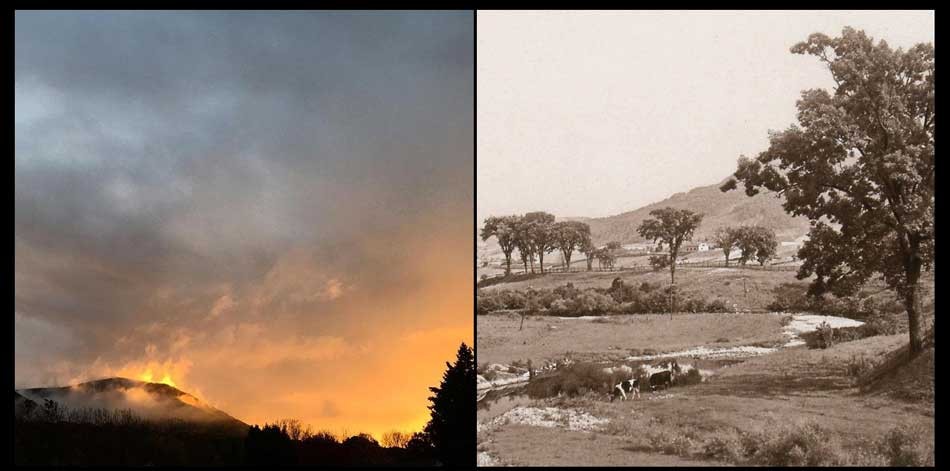 The Berkshires: Modern & Vintage: Left: "Sunset Glow over Mount Greylock State Reservation": by Shannon O'Brien: North Adams, Mass: Fall, 2016 (iPhone): Right: Detail: "Williamstown Hills, Williamstown" (Looking toward North Adams) "The encircling hills of Berkshire." : Arthur (Wentworth) Scott, American: 1899: hand-pulled photogravure plate included in volume: Nature Studies in Berkshire by John Coleman Adams published by G.P. Putnam's Sons: In the volume's introduction, "Our Berkshire" Coleman Adams sets the stage for the reader: "To know Berkshire is to love it. To love it is to feel a sort of proprietorship in it, a pride in its glories, a joy in its beauties, such as owners have in their estates and patriots in their native land. He who was born here clings to the soil if he stays, or reverts to it if he moves from it, with a New England steadfastness as intense and deep as a moral principle." (p. 3) From: Archive.org
The Berkshires: Modern & Vintage: Left: "Sunset Glow over Mount Greylock State Reservation": by Shannon O'Brien: North Adams, Mass: Fall, 2016 (iPhone): Right: Detail: "Williamstown Hills, Williamstown" (Looking toward North Adams) "The encircling hills of Berkshire." : Arthur (Wentworth) Scott, American: 1899: hand-pulled photogravure plate included in volume: Nature Studies in Berkshire by John Coleman Adams published by G.P. Putnam's Sons: In the volume's introduction, "Our Berkshire" Coleman Adams sets the stage for the reader: "To know Berkshire is to love it. To love it is to feel a sort of proprietorship in it, a pride in its glories, a joy in its beauties, such as owners have in their estates and patriots in their native land. He who was born here clings to the soil if he stays, or reverts to it if he moves from it, with a New England steadfastness as intense and deep as a moral principle." (p. 3) From: Archive.org
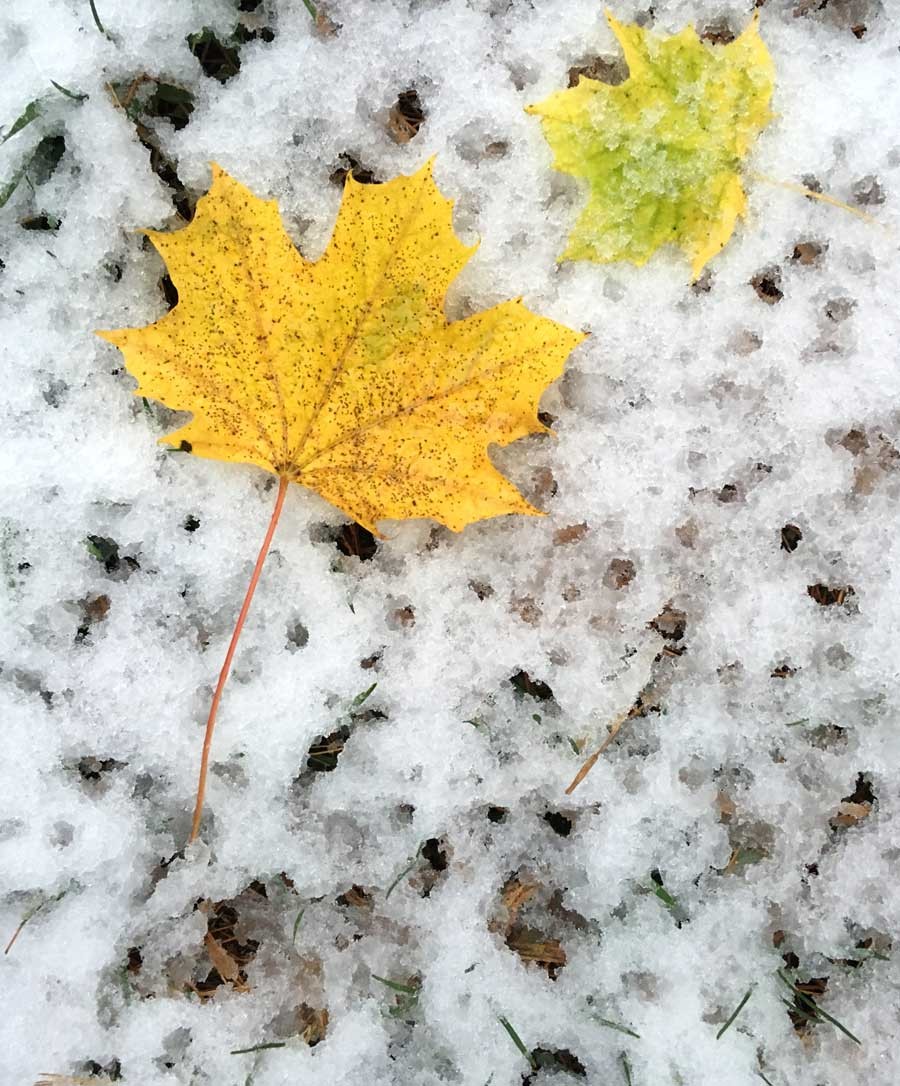 "Fall & First Snow: Williamstown": 2016: David Spencer for PhotoSeed Archive (iPhone)
"Fall & First Snow: Williamstown": 2016: David Spencer for PhotoSeed Archive (iPhone)
As a native of the Nutmeg state, I’m now proud to hail from the Bay state in the Berkshire Hills. Time and inclination willing, there will be many more photographic treasures from the past displayed for public consumption on PhotoSeed, as well as the planned rollout in the coming year-finally-of PhotoSeed Gallery, an e-commerce platform through Shopify selling vintage work. As your intrepid explorer and guide, I hope to present you with something worth thinking and conversing about in the new year and beyond.
-David Spencer-
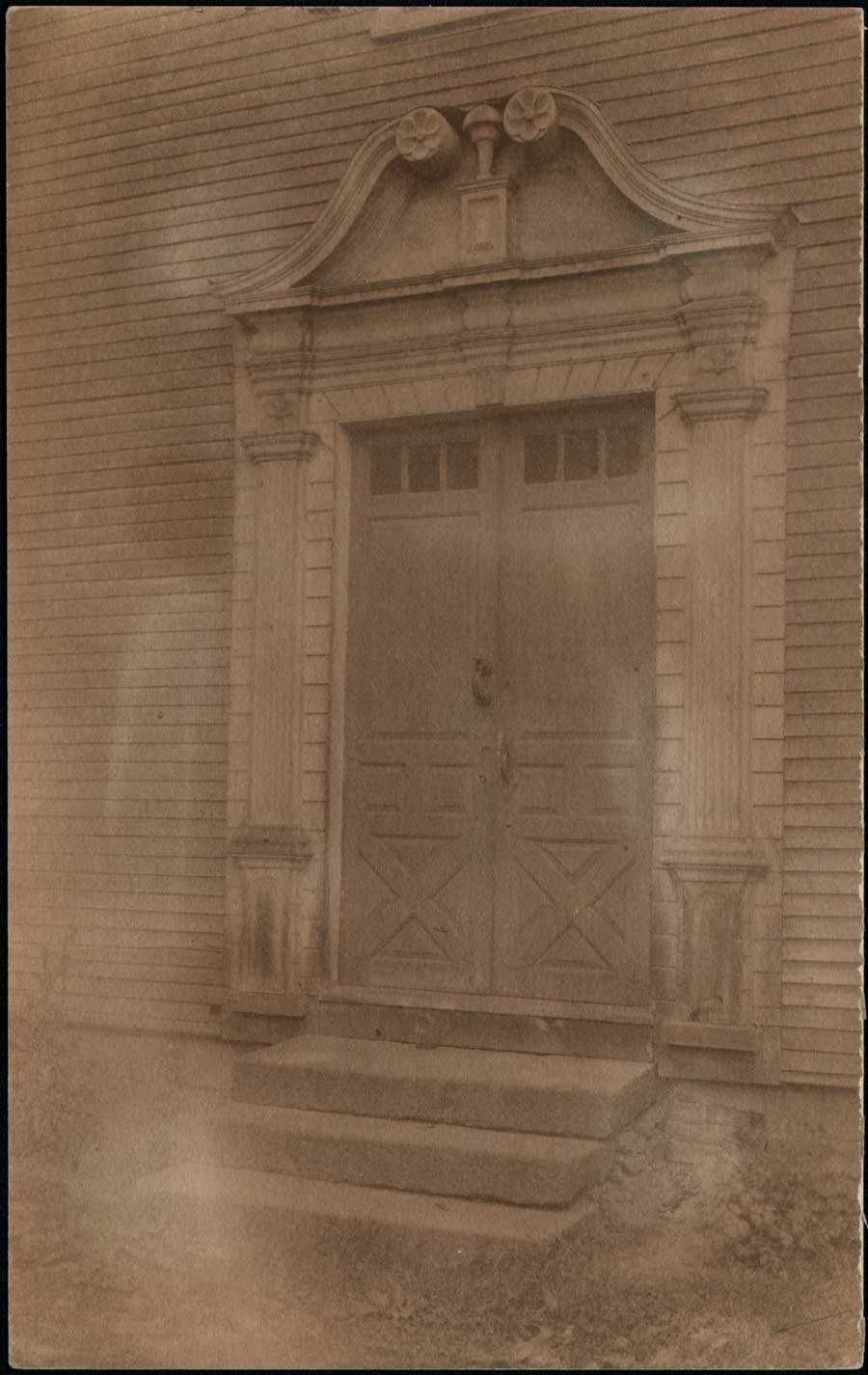 "Williams Door": Frances and Mary Allen, American: ca. 1895-1905: Platinum print: 20.2 x 12.7 cm: Made from native old-growth, eastern white pine, this view shows the Connecticut River Valley Doorway built by joiner Samuel Partridge which graces the front of the John Williams house in Old Deerfield Village, Mass. The home, and doorway, (since removed in 2001, placed on display and replaced by a reproduction) is named for the Rev. John Williams (1664-1729) in the village, and is now owned by Deerfield Academy. (the door is featured in the private school's seal) Rev. Williams was "a New England Puritan minister who became famous for The Redeemed Captive, his account of his captivity by the Mohawk after the Deerfield Massacre during Queen Anne's War." (Wikipedia) Working in the pictorial photographic style at the end and beginning of the 20th Century, the Allen Sisters of Deerfield did a brisk trade for tourists through their staged genre scenes and colonial views of Old Deerfield, including the Williams door seen here which carries a price tag on the verso of .50 cents. The home was originally built in 1760 by the Rev. Williams' son Elijah Williams, a shopkeeper and tavern-owner. From: PhotoSeed Archive
"Williams Door": Frances and Mary Allen, American: ca. 1895-1905: Platinum print: 20.2 x 12.7 cm: Made from native old-growth, eastern white pine, this view shows the Connecticut River Valley Doorway built by joiner Samuel Partridge which graces the front of the John Williams house in Old Deerfield Village, Mass. The home, and doorway, (since removed in 2001, placed on display and replaced by a reproduction) is named for the Rev. John Williams (1664-1729) in the village, and is now owned by Deerfield Academy. (the door is featured in the private school's seal) Rev. Williams was "a New England Puritan minister who became famous for The Redeemed Captive, his account of his captivity by the Mohawk after the Deerfield Massacre during Queen Anne's War." (Wikipedia) Working in the pictorial photographic style at the end and beginning of the 20th Century, the Allen Sisters of Deerfield did a brisk trade for tourists through their staged genre scenes and colonial views of Old Deerfield, including the Williams door seen here which carries a price tag on the verso of .50 cents. The home was originally built in 1760 by the Rev. Williams' son Elijah Williams, a shopkeeper and tavern-owner. From: PhotoSeed Archive
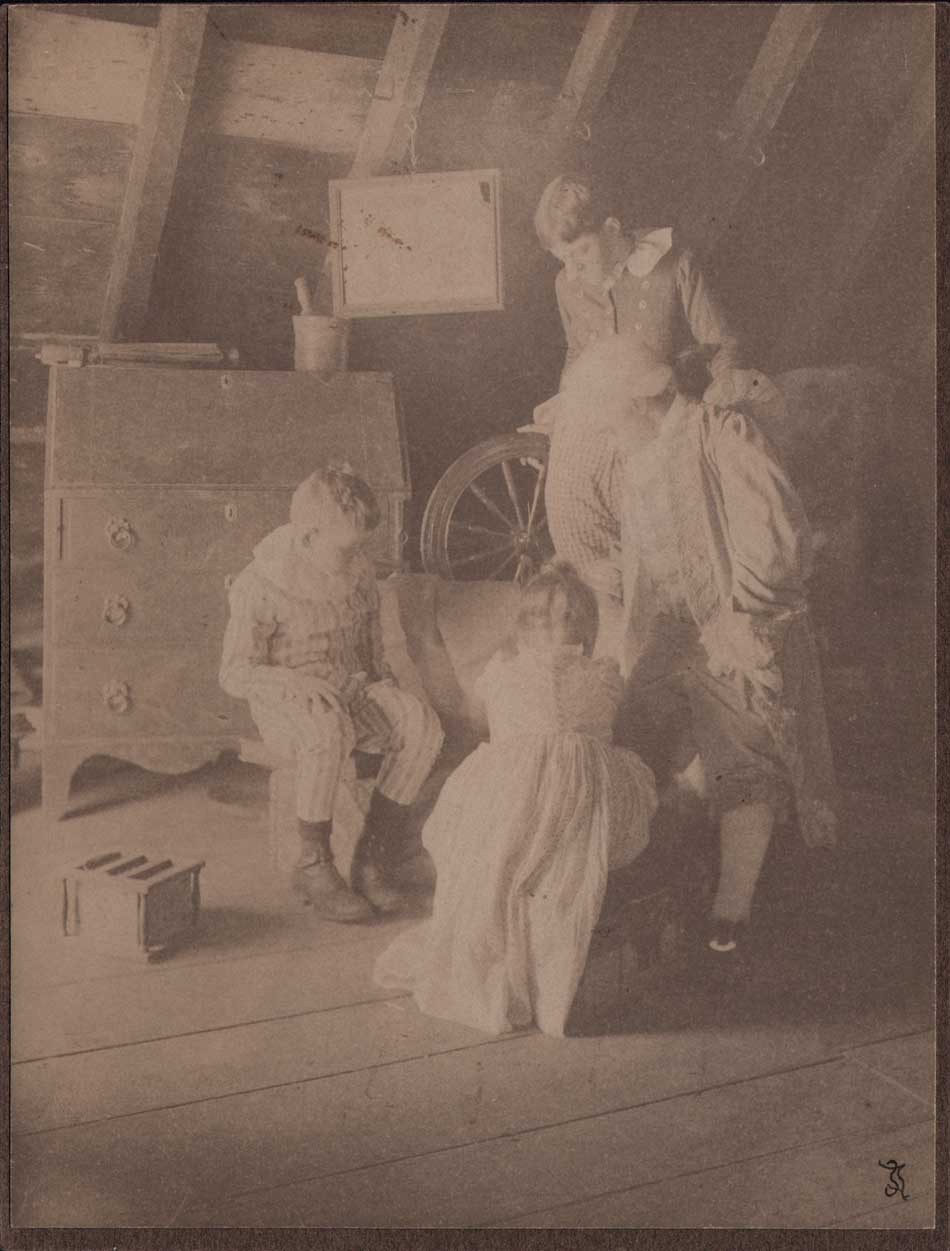 "Tom and Betty Put the Things on Ammi": 1910: Sarah Jane Dudley, American: (1859-1940) frontis plate to the volume: A Daughter of the Revolution by Jessie Anderson Chase: Boston: Richard G. Badger: The Gorham Press 1910: Platinum print, mounted, with Dudley's cipher at lower right corner: 20.2 x 15.3 | 20.5 x 15.7 cm: Besides her interest in amateur photography, Whitensville, Massachusetts native Jane Dudley, a graduate of Wheaton Female Seminary, was the organizer of the Samaritan Association of Whitinsville. This vintage example of a genre study showing children dressed in 18th century clothing while dressing their doll in an attic was done in the very popular style at the beginning of the 20th Century known as "Colonial Revival", which took advantage of America's love of its' colonial past. From: PhotoSeed Archive
"Tom and Betty Put the Things on Ammi": 1910: Sarah Jane Dudley, American: (1859-1940) frontis plate to the volume: A Daughter of the Revolution by Jessie Anderson Chase: Boston: Richard G. Badger: The Gorham Press 1910: Platinum print, mounted, with Dudley's cipher at lower right corner: 20.2 x 15.3 | 20.5 x 15.7 cm: Besides her interest in amateur photography, Whitensville, Massachusetts native Jane Dudley, a graduate of Wheaton Female Seminary, was the organizer of the Samaritan Association of Whitinsville. This vintage example of a genre study showing children dressed in 18th century clothing while dressing their doll in an attic was done in the very popular style at the beginning of the 20th Century known as "Colonial Revival", which took advantage of America's love of its' colonial past. From: PhotoSeed Archive
From: A Dissertation on the Canon and Feudal Law-1765
Liberty cannot be preserved without a general knowledge among the people, who have a right, from the frame of their nature, to knowledge, as their great Creator, who does nothing in vain, has given them understandings, and a desire to know; but besides this, they have a right, an indisputable, unalienable, indefeasible, divine right to that most dreaded and envied kind of knowledge, I mean, of the characters and conduct of their rulers.
–John Adams
Stages for Ages
Posted April 2016 in Exhibitions, History of Photography, New Additions, Publishing, Significant Photographers
All the world’s a stage, And all the men and women merely players: They have their exits and their entrances; And one man in his time plays many parts, His acts being seven ages.
-From As You Like It, Act II. Scene VII, Jaques’s speech
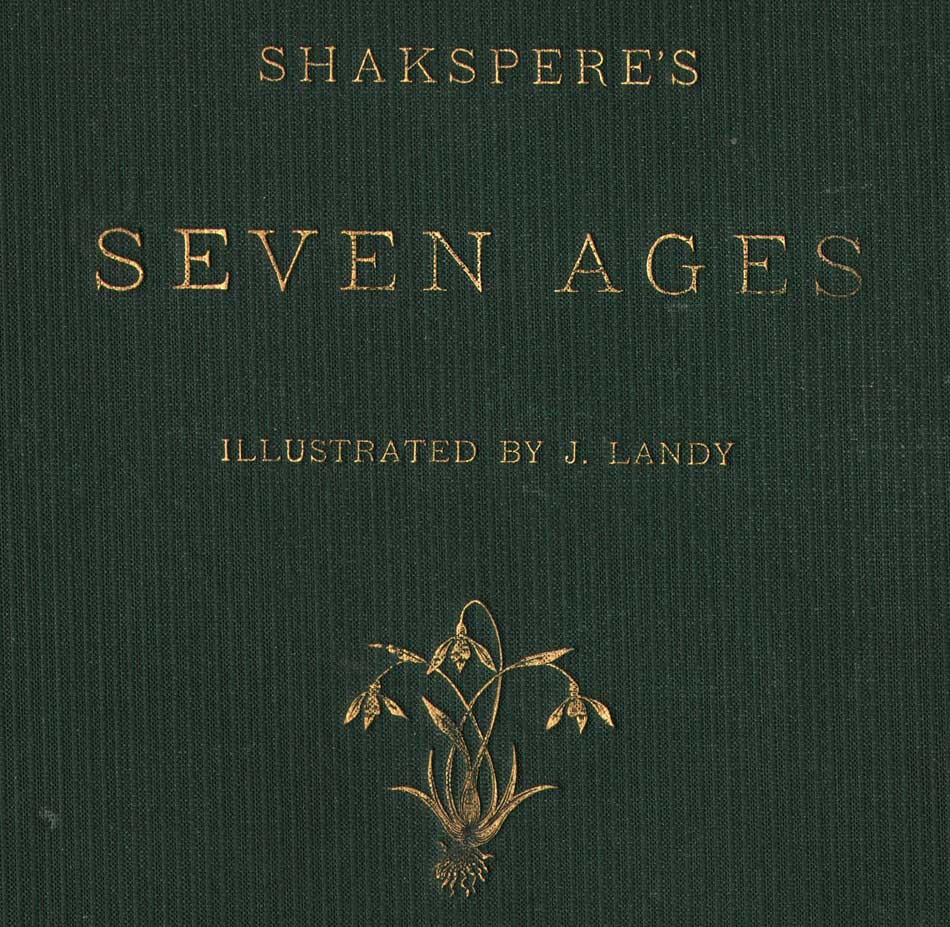 Detail: book cover: "Shakspere’s Seven Ages" Illustrated by J. Landy: Octavo with letterpress and seven individual pasted albumen portrait photographs by Landy: Cincinnati: Robert Clarke & Co., 1876: from: PhotoSeed Archive
Detail: book cover: "Shakspere’s Seven Ages" Illustrated by J. Landy: Octavo with letterpress and seven individual pasted albumen portrait photographs by Landy: Cincinnati: Robert Clarke & Co., 1876: from: PhotoSeed Archive
In life, Birthdays typically get all the attention. At least while your friends are around. Not so much death. But for certain souls long departed this mortal coil, it’s just as important. This is especially true for English playwright and poet William Shakespeare, whose passing on April 23, 1616 at 52 years of age- or 400 years ago today- seems like a perfectly good excuse to throw a party as well. Cincinnati portrait photographer James M. Landy (1838-1897) would have readily agreed, and he used the excuse of another anniversary-America’s first Centennial held in 1876 in Philadelphia- to showcase his new series of “character photographs” illustrating the Bard’s Seven Ages of Man from his play As You Like It . (1.)
Come along on a short photographic journey exploring these ages of the male species, according to Shakespeare. Have they changed with the passage of time?
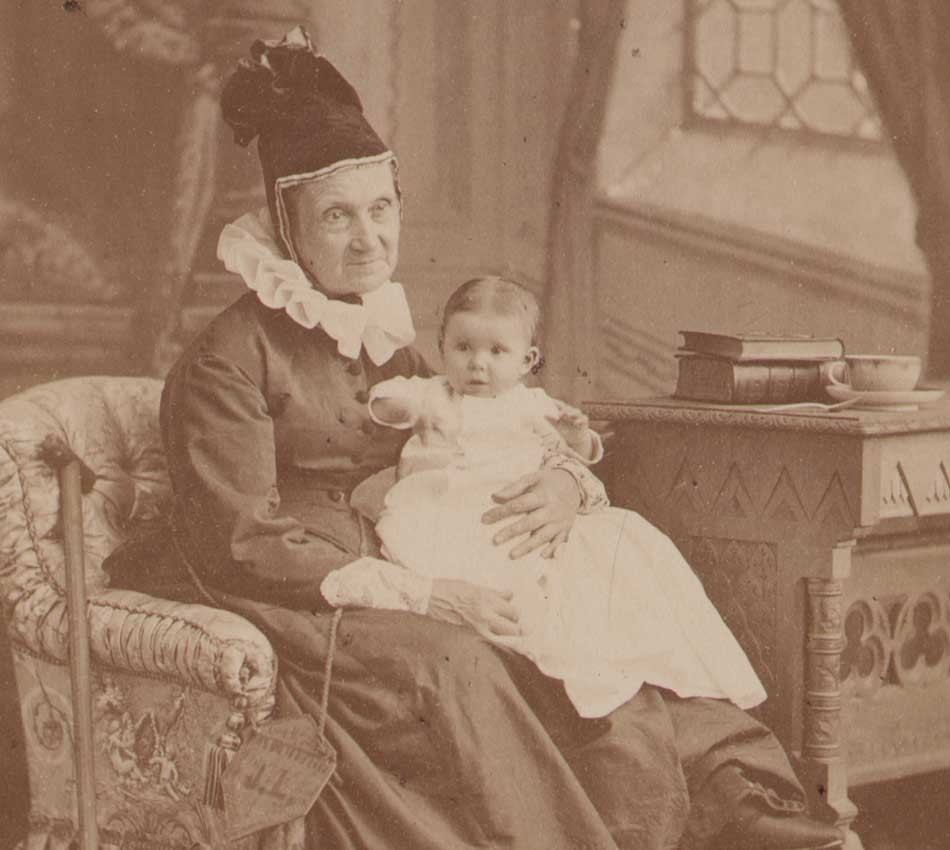 The First Age: Detail: "The Infant" : James M. Landy, American: 1876: pasted albumen print included in the volume "Shakspere’s Seven Ages": 14.0 x 9.9 | 24.7 x 19.0 cm: Cincinnati: Robert Clarke & Co., 1876. Captioned text opposite book plate: "At first the infant, Mewling and puking in the nurse’s arms.": From: PhotoSeed Archive
The First Age: Detail: "The Infant" : James M. Landy, American: 1876: pasted albumen print included in the volume "Shakspere’s Seven Ages": 14.0 x 9.9 | 24.7 x 19.0 cm: Cincinnati: Robert Clarke & Co., 1876. Captioned text opposite book plate: "At first the infant, Mewling and puking in the nurse’s arms.": From: PhotoSeed Archive
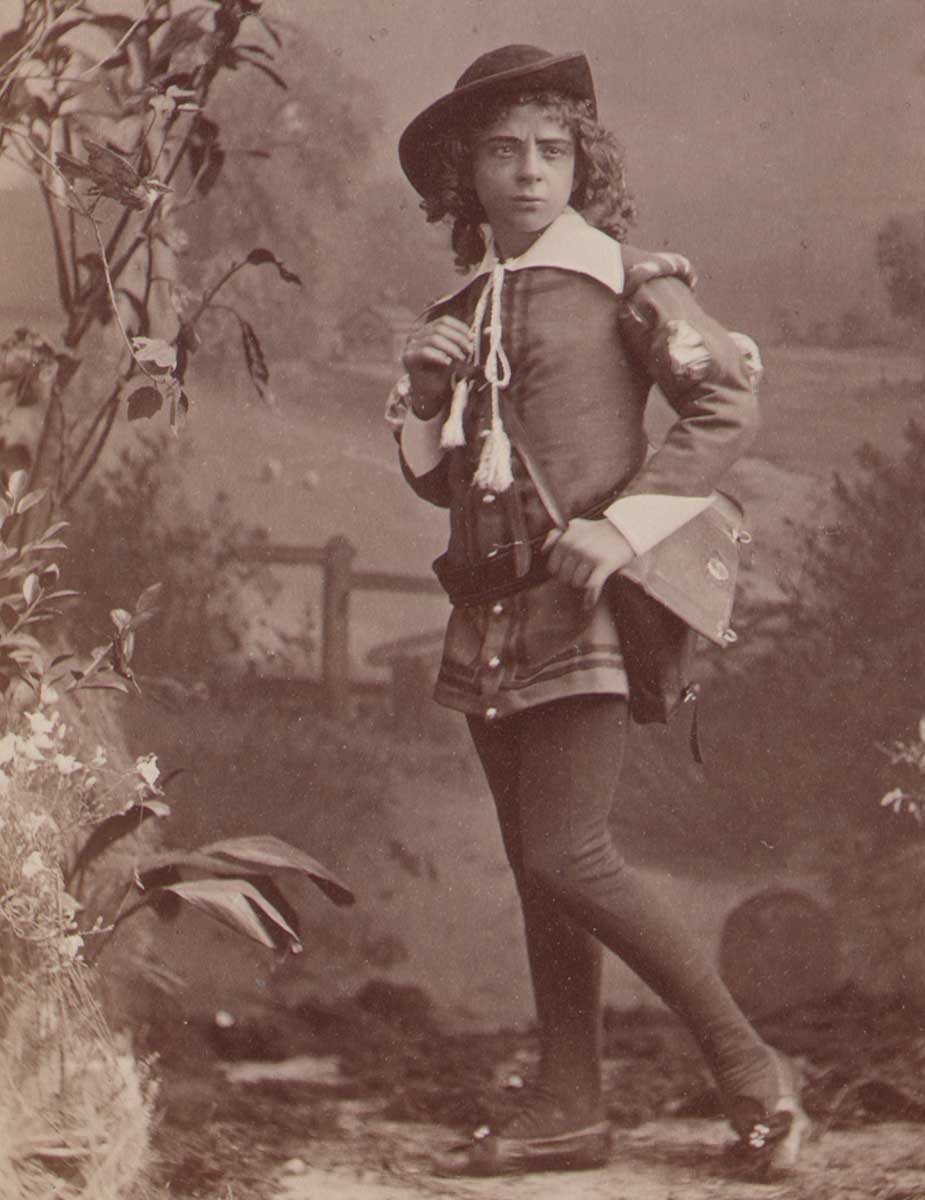 The Second Age: Detail: "The Schoolboy": James M. Landy, American: 1876: pasted albumen print included in the volume "Shakspere’s Seven Ages": 14.0 x 9.9 | 24.7 x 19.0 cm: Cincinnati: Robert Clarke & Co., 1876. Captioned text opposite book plate: "Then the whining school-boy, with his satchel, And shining morning face, creeping like snail Unwillingly to school." From: PhotoSeed Archive
The Second Age: Detail: "The Schoolboy": James M. Landy, American: 1876: pasted albumen print included in the volume "Shakspere’s Seven Ages": 14.0 x 9.9 | 24.7 x 19.0 cm: Cincinnati: Robert Clarke & Co., 1876. Captioned text opposite book plate: "Then the whining school-boy, with his satchel, And shining morning face, creeping like snail Unwillingly to school." From: PhotoSeed Archive
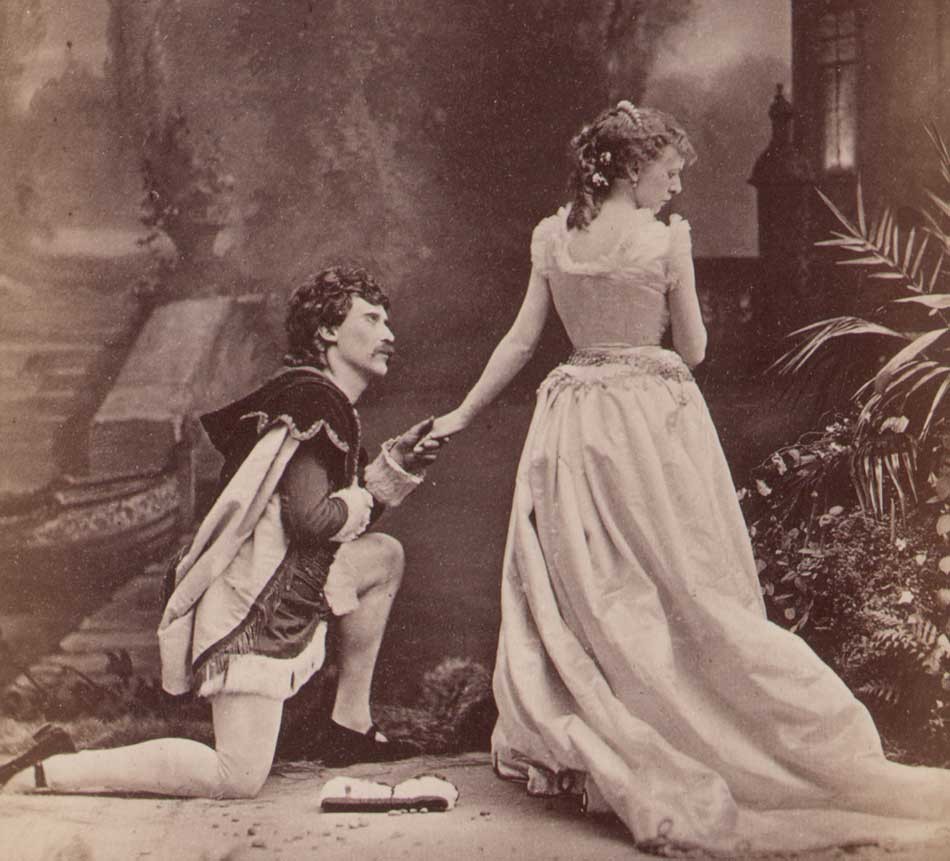 The Third Age: Detail: "The Lover": James M. Landy, American: 1876: pasted albumen print included in the volume "Shakspere’s Seven Ages": 14.3 x 9.9 | 24.7 x 19.0 cm: Cincinnati: Robert Clarke & Co., 1876. Captioned text opposite book plate: "And then the lover, Sighing like furnace, with a woful ballad Made to his mistress’ eyebrow." From: PhotoSeed Archive
The Third Age: Detail: "The Lover": James M. Landy, American: 1876: pasted albumen print included in the volume "Shakspere’s Seven Ages": 14.3 x 9.9 | 24.7 x 19.0 cm: Cincinnati: Robert Clarke & Co., 1876. Captioned text opposite book plate: "And then the lover, Sighing like furnace, with a woful ballad Made to his mistress’ eyebrow." From: PhotoSeed Archive
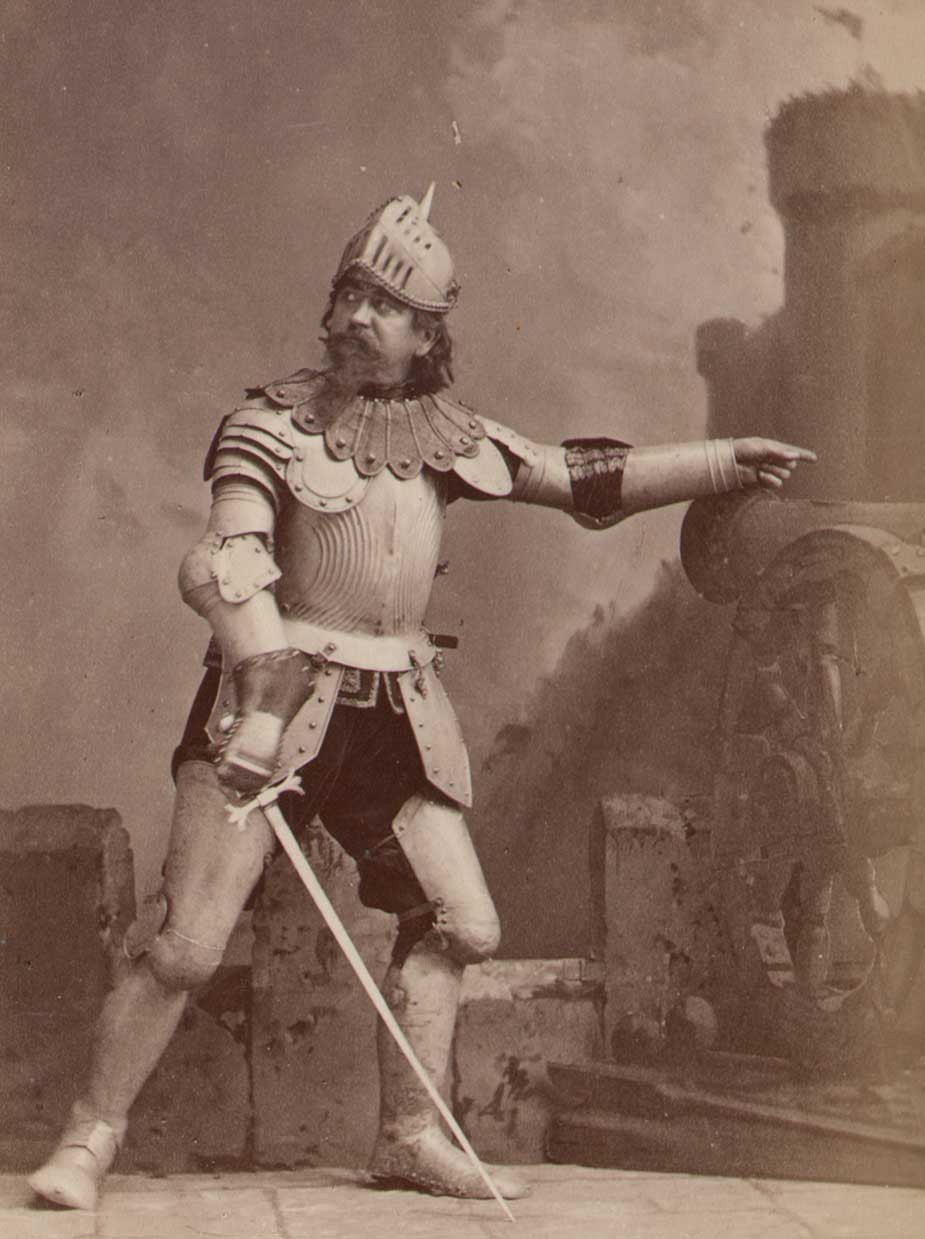 The Fourth Age: Detail: "The Soldier": James M. Landy, American: 1876: pasted albumen print included in the volume "Shakspere’s Seven Ages": 14.0 x 9.9 | 24.7 x 19.0 cm: Cincinnati: Robert Clarke & Co., 1876. Captioned text opposite book plate: "Then a soldier, Full of strange oaths, and bearded like the pard, Jealous in honor, sudden and quick in quarrel, Seeking the bubble reputation Even in the cannon’s mouth." From: PhotoSeed Archive
The Fourth Age: Detail: "The Soldier": James M. Landy, American: 1876: pasted albumen print included in the volume "Shakspere’s Seven Ages": 14.0 x 9.9 | 24.7 x 19.0 cm: Cincinnati: Robert Clarke & Co., 1876. Captioned text opposite book plate: "Then a soldier, Full of strange oaths, and bearded like the pard, Jealous in honor, sudden and quick in quarrel, Seeking the bubble reputation Even in the cannon’s mouth." From: PhotoSeed Archive
 The Fifth Age: "The Justice": James M. Landy, American: 1876: pasted albumen print included in the volume "Shakspere’s Seven Ages": 14.3 x 9.7 | 24.7 x 19.0 cm: Cincinnati: Robert Clarke & Co., 1876. Captioned text opposite book plate: "And then the Justice, In fair round belly, with good capon lin'd, With eyes severe, and beard of formal cut, Full of wise saws and modern instances; And so he plays his part." From: PhotoSeed Archive
The Fifth Age: "The Justice": James M. Landy, American: 1876: pasted albumen print included in the volume "Shakspere’s Seven Ages": 14.3 x 9.7 | 24.7 x 19.0 cm: Cincinnati: Robert Clarke & Co., 1876. Captioned text opposite book plate: "And then the Justice, In fair round belly, with good capon lin'd, With eyes severe, and beard of formal cut, Full of wise saws and modern instances; And so he plays his part." From: PhotoSeed Archive
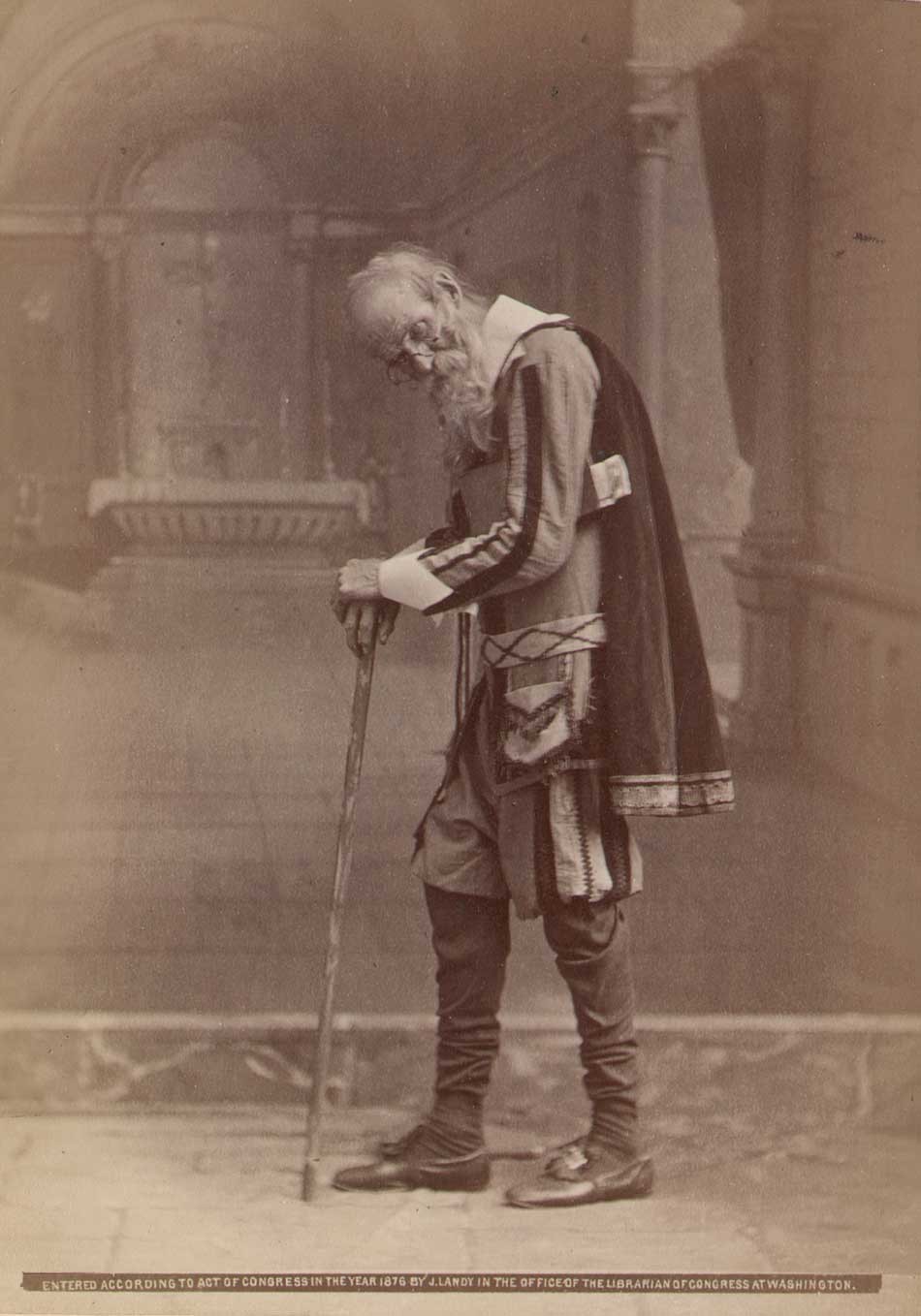 The Sixth Age: "The Lean and Slipper’d Pantaloon": James M. Landy, American: 1876: pasted albumen print included in the volume "Shakspere’s Seven Ages": 14.0 x 9.9 | 24.7 x 19.0 cm: Cincinnati: Robert Clarke & Co., 1876. Captioned text opposite book plate: "The sixth age shifts Into the lean and slipper’d pantaloon, With spectacles on nose and pouch on side, His youthful hose well saved, a world too wide For his shrunk shank; and his big manly voice, Turning again toward childish treble, pipes And whistles in his sound." From: PhotoSeed Archive
The Sixth Age: "The Lean and Slipper’d Pantaloon": James M. Landy, American: 1876: pasted albumen print included in the volume "Shakspere’s Seven Ages": 14.0 x 9.9 | 24.7 x 19.0 cm: Cincinnati: Robert Clarke & Co., 1876. Captioned text opposite book plate: "The sixth age shifts Into the lean and slipper’d pantaloon, With spectacles on nose and pouch on side, His youthful hose well saved, a world too wide For his shrunk shank; and his big manly voice, Turning again toward childish treble, pipes And whistles in his sound." From: PhotoSeed Archive
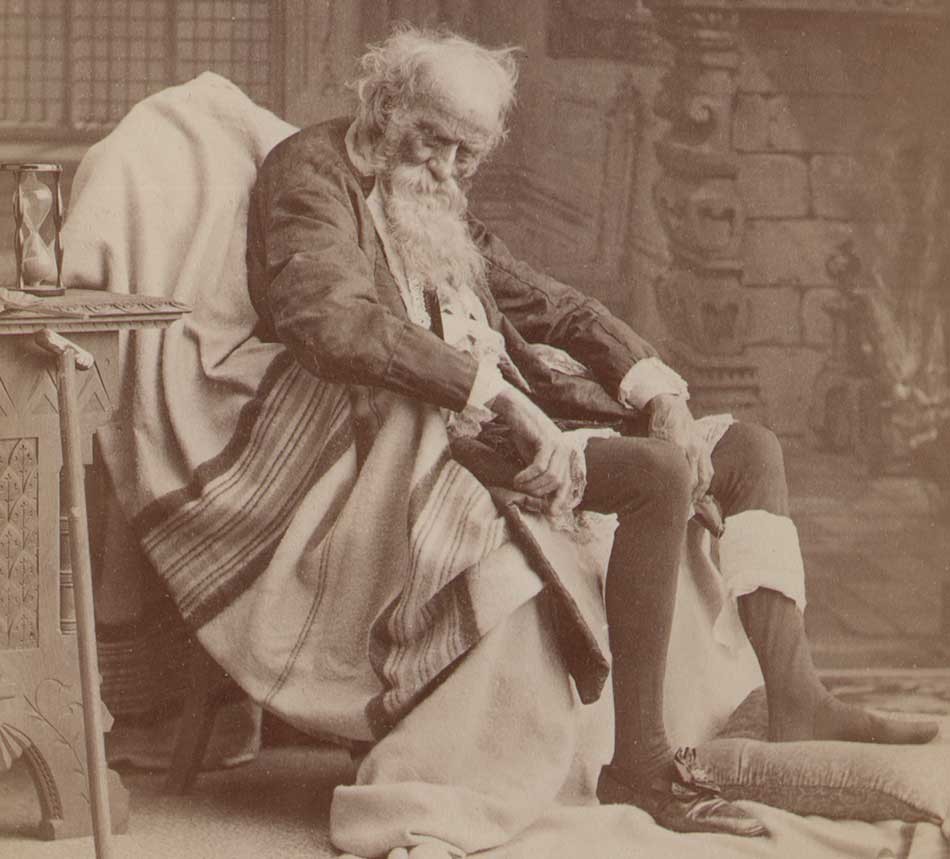 The Seventh Age: Detail: "Sans Teeth, Sans Eyes, Sans Taste, Sans Everything": James M. Landy, American: 1876: pasted albumen print included in the volume "Shakspere’s Seven Ages": 14.0 x 9.9 | 24.7 x 19.0 cm: Cincinnati: Robert Clarke & Co., 1876. Captioned text opposite book plate: "Last scene of all That ends this strange eventful history, Is second childishness and mere oblivion— Sans teeth, sans eyes, sans taste, sans everything.” From: PhotoSeed Archive
The Seventh Age: Detail: "Sans Teeth, Sans Eyes, Sans Taste, Sans Everything": James M. Landy, American: 1876: pasted albumen print included in the volume "Shakspere’s Seven Ages": 14.0 x 9.9 | 24.7 x 19.0 cm: Cincinnati: Robert Clarke & Co., 1876. Captioned text opposite book plate: "Last scene of all That ends this strange eventful history, Is second childishness and mere oblivion— Sans teeth, sans eyes, sans taste, sans everything.” From: PhotoSeed Archive
1. James Landy: from: Artists in Ohio, 1787-1900: A Biographical Dictionary, Mary Sayre Haverstock et al: Kent State University Press, 2000: p. 506
Blue Prince
Posted March 2016 in Alternate Processes, Childhood Photography, Exhibitions, History of Photography, Unknown Photographers, Unknown Photographs
Discovering a needle in a haystack, with apologies to this farmhand happily lounging atop a salt marsh haystack before the turn of the 20th century, is the proverbial sensation one beholds when encountering a fine blueprint, or cyanotype photograph, for the first time.
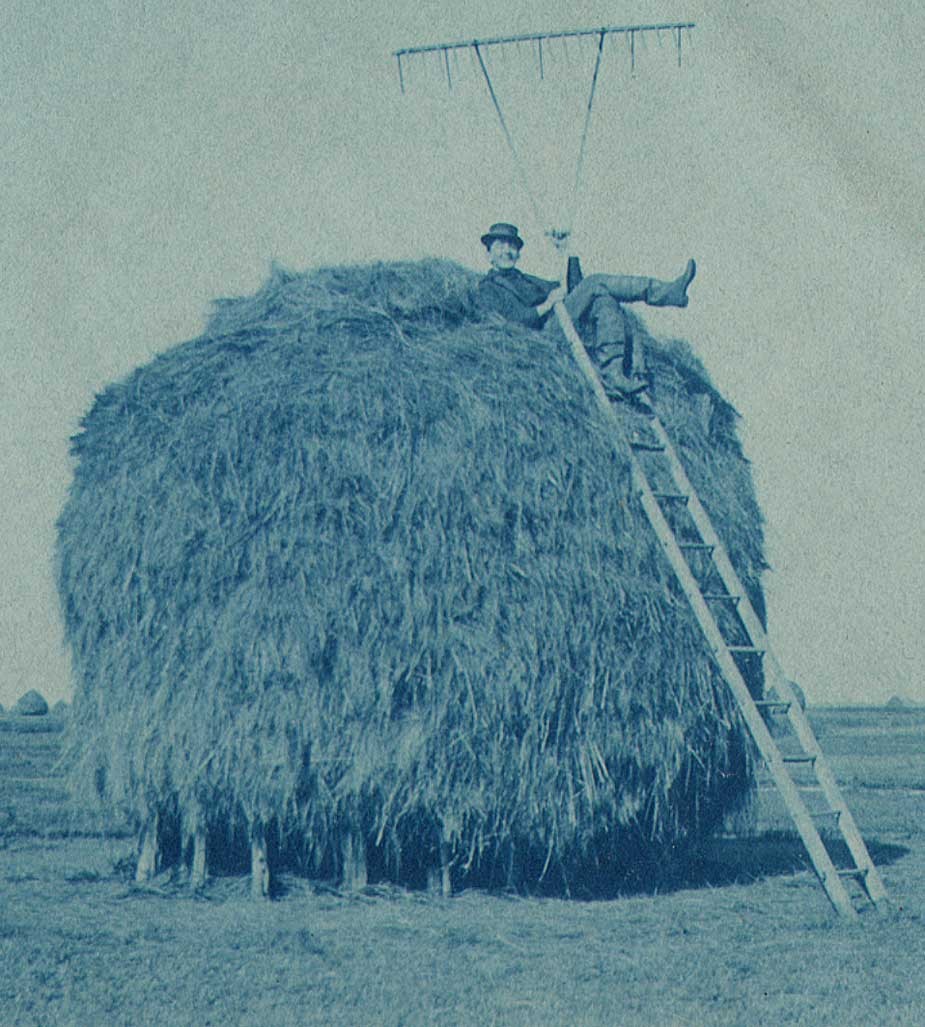 Detail: "Farmhand atop Salt Marsh Haystack" : anonymous American photographer: cyanotype: 1895-1900: 8.7 x 12.0 cm: The location of this photograph has been determined to be Plum Island in Newburyport, Mass, on Boston's North Shore. The marshes, in a tidal zone on the Atlantic ocean, is where salt marsh hay grows and then harvested. The farmhand would first use the wooden drag rake to collect the cut hay into piles. It would then be gathered and piled into layers above a platform (seen at bottom of photo) made from cedar wood staddles. This form of haystack making dates from the 17th Century is still practiced in the area in the present day. From: PhotoSeed Archive
Detail: "Farmhand atop Salt Marsh Haystack" : anonymous American photographer: cyanotype: 1895-1900: 8.7 x 12.0 cm: The location of this photograph has been determined to be Plum Island in Newburyport, Mass, on Boston's North Shore. The marshes, in a tidal zone on the Atlantic ocean, is where salt marsh hay grows and then harvested. The farmhand would first use the wooden drag rake to collect the cut hay into piles. It would then be gathered and piled into layers above a platform (seen at bottom of photo) made from cedar wood staddles. This form of haystack making dates from the 17th Century is still practiced in the area in the present day. From: PhotoSeed Archive
Given the excuse the Worcester Art Museum in Massachusetts is devoting significant wall space to their current exhibit: Cyanotypes: Photography’s Blue Period, (through April 24, 2016-publication here.) all while keeping with this institution’s admirable mission of presenting photography as an art form to the public since 1904, I’m mounting my own mini-exhibition of vintage cyanotypes from the PhotoSeed archive here with the added bonus of several photographs that literally embrace and further the definition of “blue print”. So like our “prince” above, whose raking abilities are indeed most impressive, here’s hoping your own photographic gatherings include finding the unique beauty these gems in blue offer.
-David Spencer, February, 2016
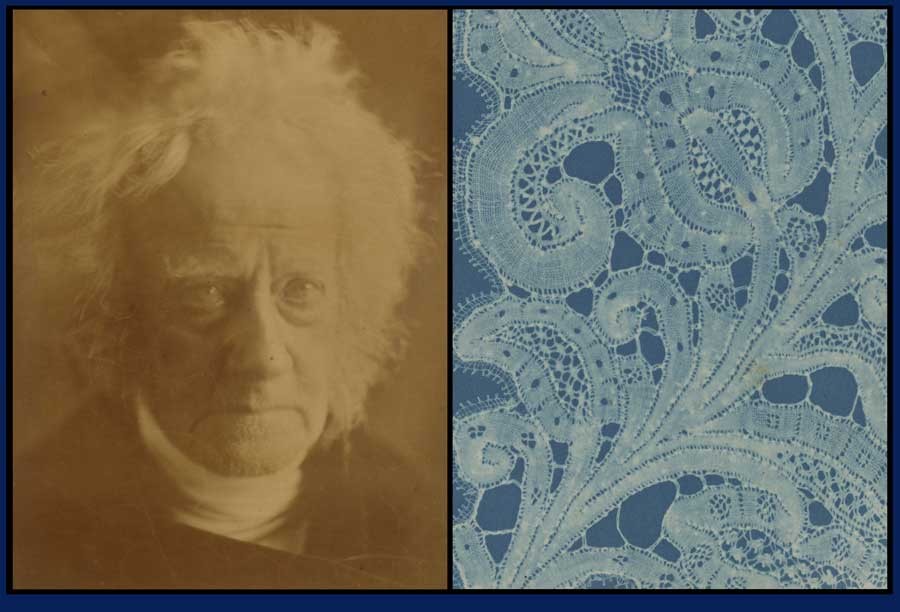 Left: Detail: "John Frederick William Herschel"(1792-1871): Julia Margaret Cameron: British: Albumen print: 1867: image: 35.5 x 27.1 cm (sight): The Cyanotype, or blueprint process, was first invented by John Herschel in 1842. It involves first exposing a negative, oftentimes through the contact print method with paper (or even cloth or another matrix) first treated with ammonium ferric citrate. In daylight, the matrix is then developed using a solution of potassium ferricyanide. The resulting print reveals itself as a brilliant blue hue known as Prussian blue. (ferric iron compounds being changed into ferrous iron). From: PhotoSeed Archive. Right: Detail: "Braid and Thread Lace": Julia Herschel: British : (1842-1933 ) : cyanotype: 1869 or before. It's intriguing to know the inventors daughter used the process herself (John Herschel was known to only use his blueprint process to reproduce notes and diagrams) to create artistic statements, like this original photograph bound with the volume: A Handbook for Greek and Roman Lace Making published in London in 1869 and printed by R. Barrett and Sons. From: Spencer Collection, The New York Public Library. "A handbook for Greek and Roman lace making" The New York Public Library Digital Collections. 1869. http://digitalcollections.nypl.org/items/7dd58e00-0898-0133-038f-58d385a7bbd0
Left: Detail: "John Frederick William Herschel"(1792-1871): Julia Margaret Cameron: British: Albumen print: 1867: image: 35.5 x 27.1 cm (sight): The Cyanotype, or blueprint process, was first invented by John Herschel in 1842. It involves first exposing a negative, oftentimes through the contact print method with paper (or even cloth or another matrix) first treated with ammonium ferric citrate. In daylight, the matrix is then developed using a solution of potassium ferricyanide. The resulting print reveals itself as a brilliant blue hue known as Prussian blue. (ferric iron compounds being changed into ferrous iron). From: PhotoSeed Archive. Right: Detail: "Braid and Thread Lace": Julia Herschel: British : (1842-1933 ) : cyanotype: 1869 or before. It's intriguing to know the inventors daughter used the process herself (John Herschel was known to only use his blueprint process to reproduce notes and diagrams) to create artistic statements, like this original photograph bound with the volume: A Handbook for Greek and Roman Lace Making published in London in 1869 and printed by R. Barrett and Sons. From: Spencer Collection, The New York Public Library. "A handbook for Greek and Roman lace making" The New York Public Library Digital Collections. 1869. http://digitalcollections.nypl.org/items/7dd58e00-0898-0133-038f-58d385a7bbd0
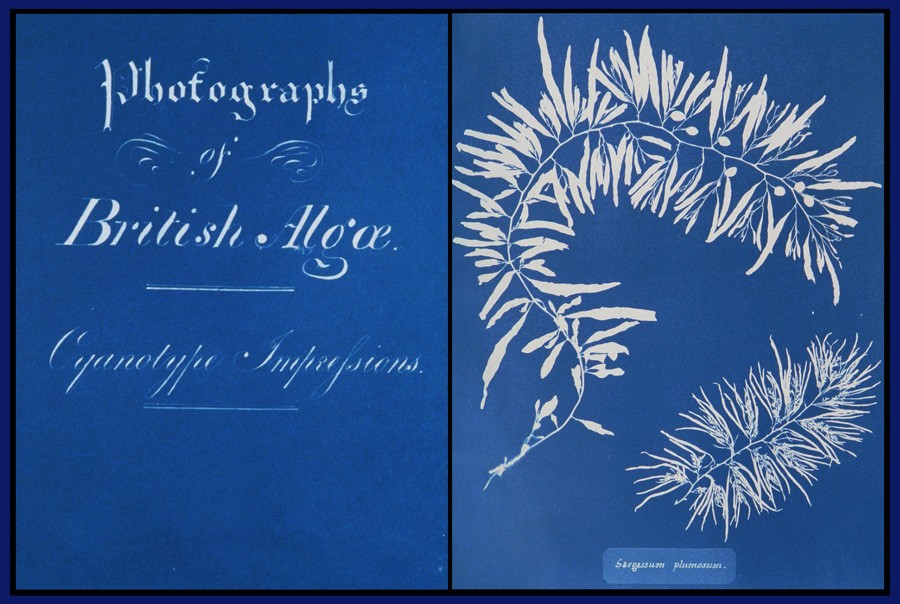 Left: Detail: "Title Page": from: Photographs of British Algae: Cyanotype Impressions: Anna Atkins: British: (1799-1871) : cyanotype: 1843-1853. This title page in the author's own hand is part of a multi-part volume of 231 original cyanotypes featuring contact prints of British seaweed specimens first copied on individual glass sheets by William Henry Fox Talbot's photogenic drawing method by Atkins and then reproduced by John Herschel's newly invented cyanotype or blueprinting process. The importance of the work is summed up by The New York Public Library, which owns this rare volume formerly in the library of Herschel: "Photographs of British Algae is a landmark in the histories both of photography and of publishing: the first photographic work by a woman, and the first book produced entirely by photographic means." From: Spencer Collection, The New York Public Library. "Titlepage." The New York Public Library Digital Collections. 1843 - 1853. http://digitalcollections.nypl.org/items/510d47d9-4af4-a3d9-e040-e00a18064a99. Right: Detail: "Sargassum plumosum":from: Photographs of British Algae: Cyanotype Impressions: Anna Atkins: British: (1799-1871) : cyanotype: 1843-1853. These beautiful seaweed specimens was the second plate in the pagination for Vol. 1 of "British Algae". From: Spencer Collection, The New York Public Library. "Sargassum plumosum." The New York Public Library Digital Collections. 1843 - 1853. http://digitalcollections.nypl.org/items/510d47d9-4af6-a3d9-e040-e00a18064a99
Left: Detail: "Title Page": from: Photographs of British Algae: Cyanotype Impressions: Anna Atkins: British: (1799-1871) : cyanotype: 1843-1853. This title page in the author's own hand is part of a multi-part volume of 231 original cyanotypes featuring contact prints of British seaweed specimens first copied on individual glass sheets by William Henry Fox Talbot's photogenic drawing method by Atkins and then reproduced by John Herschel's newly invented cyanotype or blueprinting process. The importance of the work is summed up by The New York Public Library, which owns this rare volume formerly in the library of Herschel: "Photographs of British Algae is a landmark in the histories both of photography and of publishing: the first photographic work by a woman, and the first book produced entirely by photographic means." From: Spencer Collection, The New York Public Library. "Titlepage." The New York Public Library Digital Collections. 1843 - 1853. http://digitalcollections.nypl.org/items/510d47d9-4af4-a3d9-e040-e00a18064a99. Right: Detail: "Sargassum plumosum":from: Photographs of British Algae: Cyanotype Impressions: Anna Atkins: British: (1799-1871) : cyanotype: 1843-1853. These beautiful seaweed specimens was the second plate in the pagination for Vol. 1 of "British Algae". From: Spencer Collection, The New York Public Library. "Sargassum plumosum." The New York Public Library Digital Collections. 1843 - 1853. http://digitalcollections.nypl.org/items/510d47d9-4af6-a3d9-e040-e00a18064a99
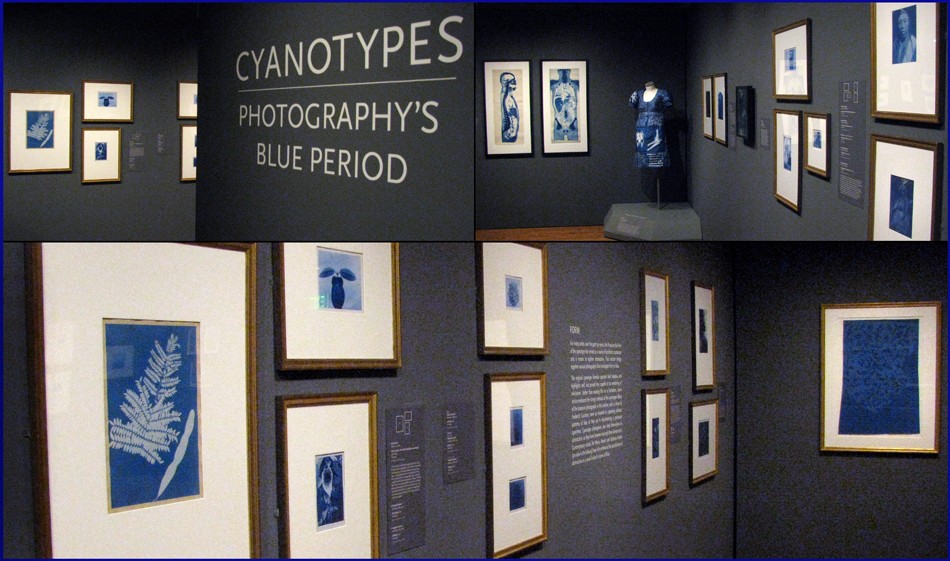 Composite: April, 2016 installation photographs from exhibit: "Cyanotypes: Photography's Blue Period" at the Worcester Art Museum in Worcester, MA. Running from January 16-April 24, 2016, the show was the first comprehensive exhibit on the medium of cyanotype ever held in the United States. Vintage examples from the museum's own holdings as well as loans from other institutions and private individuals spanned the period from the 1850's to the first decade of the 21st Century. The exhibit was curated by Nancy Kathryn Burns, Assistant Curator of Prints, Drawings, and Photographs at the museum & Kristina Wilson, Associate Professor of Art History, Clark University. Both additionally edited the volume: "Cyanotypes: Photography's Blue Period" published by the museum: ISBN# 978-0-936042-06-0. Installation photographs by David Spencer for PhotoSeed Archive
Composite: April, 2016 installation photographs from exhibit: "Cyanotypes: Photography's Blue Period" at the Worcester Art Museum in Worcester, MA. Running from January 16-April 24, 2016, the show was the first comprehensive exhibit on the medium of cyanotype ever held in the United States. Vintage examples from the museum's own holdings as well as loans from other institutions and private individuals spanned the period from the 1850's to the first decade of the 21st Century. The exhibit was curated by Nancy Kathryn Burns, Assistant Curator of Prints, Drawings, and Photographs at the museum & Kristina Wilson, Associate Professor of Art History, Clark University. Both additionally edited the volume: "Cyanotypes: Photography's Blue Period" published by the museum: ISBN# 978-0-936042-06-0. Installation photographs by David Spencer for PhotoSeed Archive
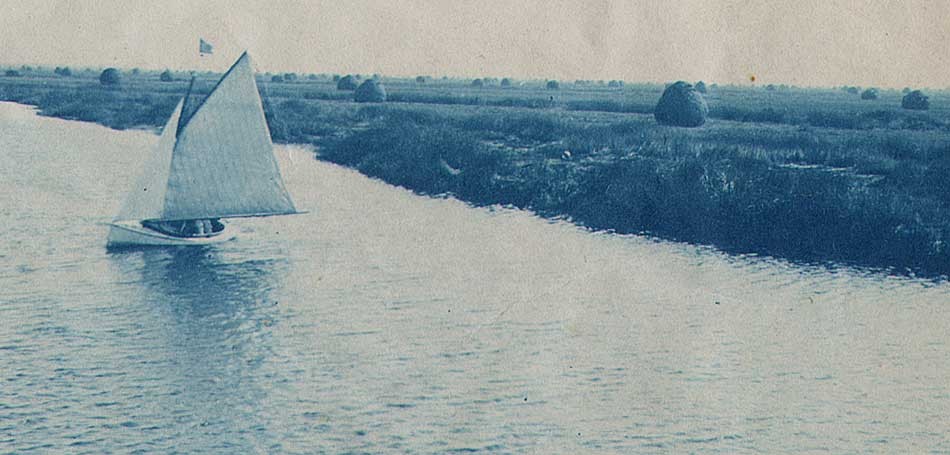 Detail: "Sailboat near Plum Island" : anonymous American photographer: cyanotype: 1895-1900: 9.2 x 12.5 cm: The location of this photograph has been determined to be Plum Island Sound (the Parker River) in Newburyport, Mass, on Boston's North Shore. In the distance can be seen many salt marsh haystacks. From: PhotoSeed Archive
Detail: "Sailboat near Plum Island" : anonymous American photographer: cyanotype: 1895-1900: 9.2 x 12.5 cm: The location of this photograph has been determined to be Plum Island Sound (the Parker River) in Newburyport, Mass, on Boston's North Shore. In the distance can be seen many salt marsh haystacks. From: PhotoSeed Archive
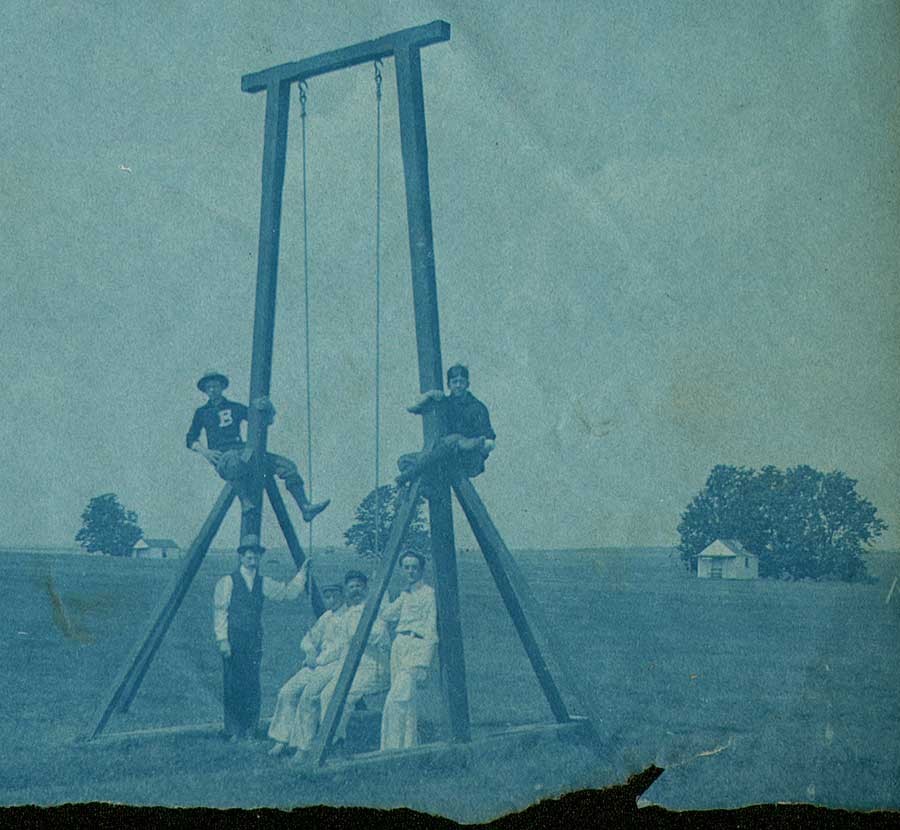 Detail: "Portrait Grouping with Tall Wooden Swing" : anonymous American photographer: cyanotype: 1895-1900: 8.5 x 11.5 cm: Most likely taken within the Plum Island area of Newburyport, Mass., (by the same photographer as it was included in small album of views as previous post photographs) this intriguing photograph shows an oversized wooden swing within a mowed field. One theory for the size of this swing would be because tidal changes could submerge the structure. Note lower margin of photograph where it was torn to fit a pre-cut window within a small album. From: PhotoSeed Archive
Detail: "Portrait Grouping with Tall Wooden Swing" : anonymous American photographer: cyanotype: 1895-1900: 8.5 x 11.5 cm: Most likely taken within the Plum Island area of Newburyport, Mass., (by the same photographer as it was included in small album of views as previous post photographs) this intriguing photograph shows an oversized wooden swing within a mowed field. One theory for the size of this swing would be because tidal changes could submerge the structure. Note lower margin of photograph where it was torn to fit a pre-cut window within a small album. From: PhotoSeed Archive
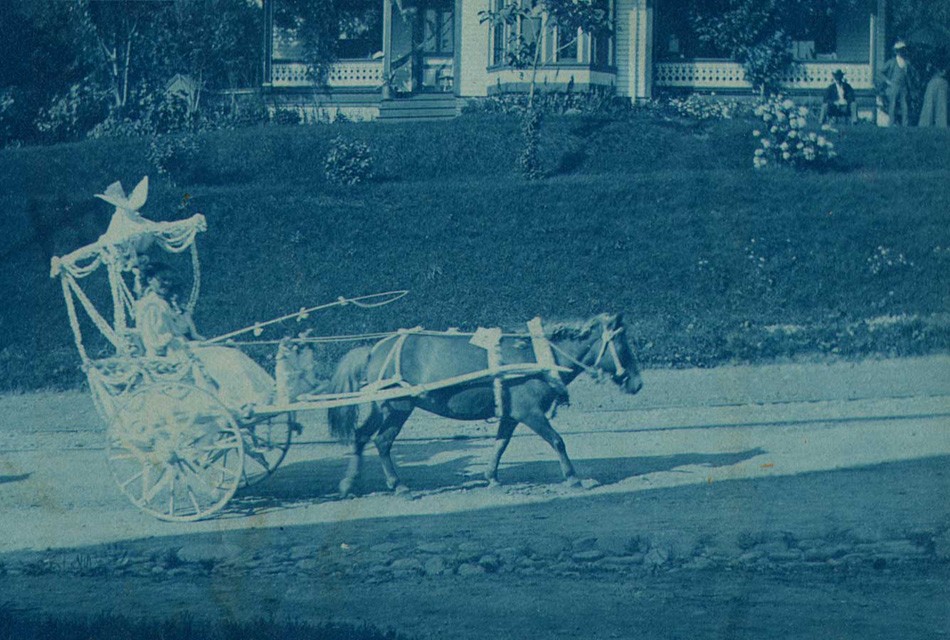 Detail: "Pony Cart in Parade" : anonymous American photographer: cyanotype: 1895-1900: 8.8 x 11.4 cm: Most likely taken in or near Newburyport, Mass., (by the same photographer as it was included in small album of views as previous post photographs) this slice of small-town American life shows a pony pulling a floral-decorated cart guided by a young lady traveling down a dirt road, perhaps on Memorial Day. Above can be seen a Victorian home with three parade watchers who stand at upper right. A set of trolley tracks can be seen in road beyond horse. From: PhotoSeed Archive
Detail: "Pony Cart in Parade" : anonymous American photographer: cyanotype: 1895-1900: 8.8 x 11.4 cm: Most likely taken in or near Newburyport, Mass., (by the same photographer as it was included in small album of views as previous post photographs) this slice of small-town American life shows a pony pulling a floral-decorated cart guided by a young lady traveling down a dirt road, perhaps on Memorial Day. Above can be seen a Victorian home with three parade watchers who stand at upper right. A set of trolley tracks can be seen in road beyond horse. From: PhotoSeed Archive
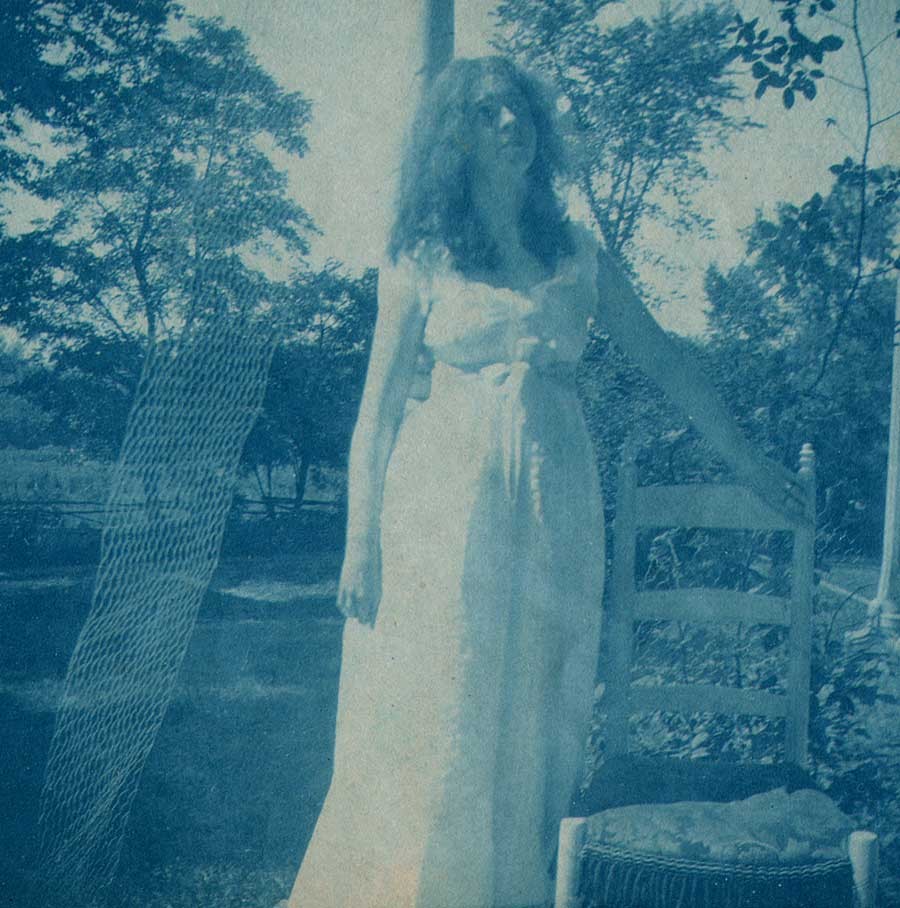 Detail: "Woman in White Dress Standing next to Chair" : anonymous American photographer: cyanotype: 1895-1900: 8.3 x 8.5 cm: Her name perhaps lost to history, a young woman wearing a white dress stands on a porch and looks away from the camera: a most unusual genre pose indicating she may have been playing a role of some type: for a play? or as an honored guest who had taken part in the parade depicted in the previous photograph? This view also likely taken in or near Newburyport, Mass. (and was included in the same small album of views as previous post photographs) From: PhotoSeed Archive
Detail: "Woman in White Dress Standing next to Chair" : anonymous American photographer: cyanotype: 1895-1900: 8.3 x 8.5 cm: Her name perhaps lost to history, a young woman wearing a white dress stands on a porch and looks away from the camera: a most unusual genre pose indicating she may have been playing a role of some type: for a play? or as an honored guest who had taken part in the parade depicted in the previous photograph? This view also likely taken in or near Newburyport, Mass. (and was included in the same small album of views as previous post photographs) From: PhotoSeed Archive
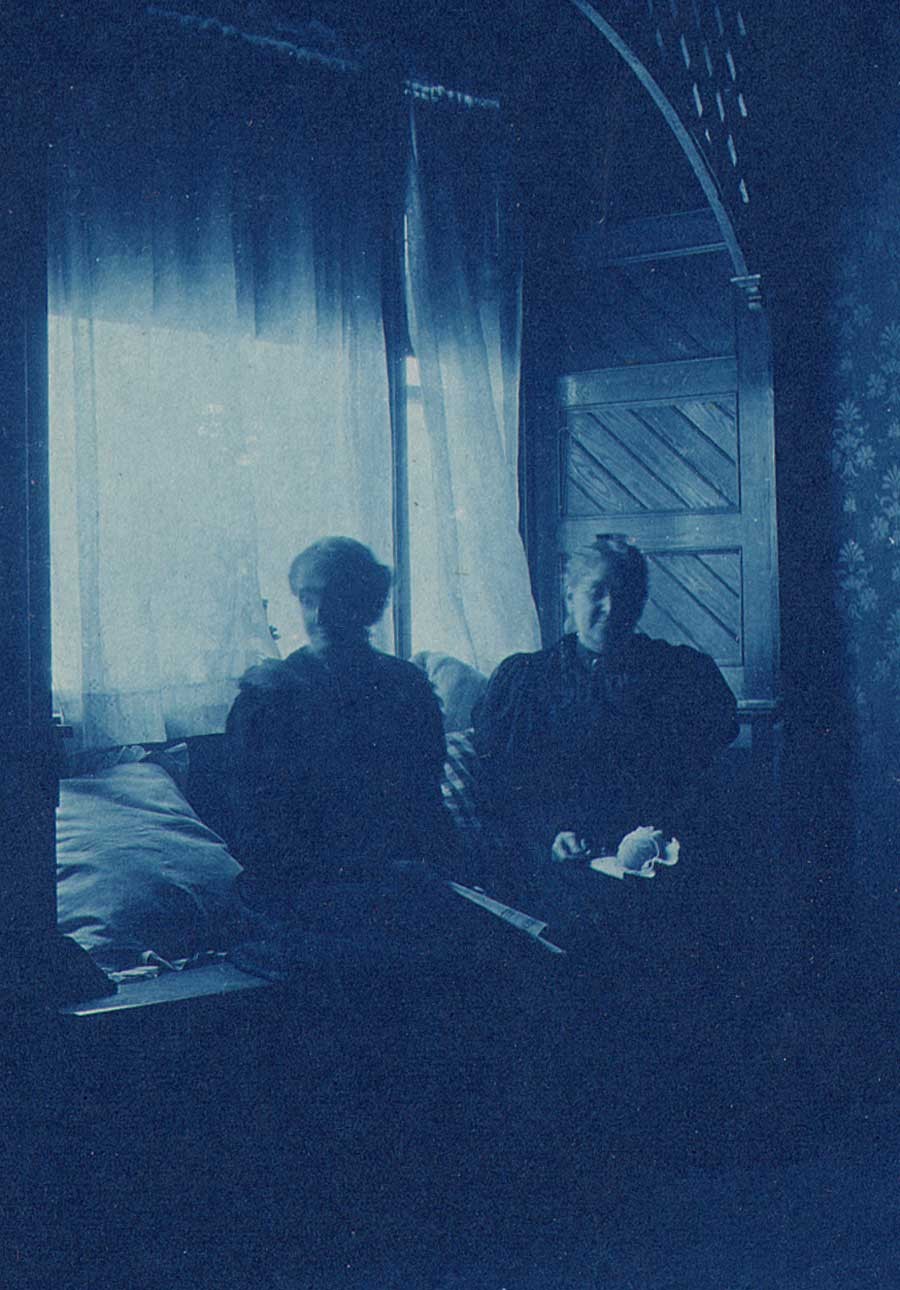 Detail: "Portrait Study near Window" : anonymous American photographer: cyanotype: 1899: 9.7 x 6.3 cm: Most likely sisters, this moody interior portrait is unusual for amateur work of the period because the photographer instructed his subjects to avert their gaze to the camera. The woman at left holds what is believed to be a folded fan while her companion holds a ball of yarn in her lap. Photograph may have been additionally printed on commercially available presensitized Venus paper manufactured by the Peerless Blue Print Co., as it was included in a cardboard box of this brand with an expiration date of 1899. Location for this image may have been the midwestern United States, as it was included in this Peerless box of loose cyanotypes purchased from an Indiana seller. From: PhotoSeed Archive
Detail: "Portrait Study near Window" : anonymous American photographer: cyanotype: 1899: 9.7 x 6.3 cm: Most likely sisters, this moody interior portrait is unusual for amateur work of the period because the photographer instructed his subjects to avert their gaze to the camera. The woman at left holds what is believed to be a folded fan while her companion holds a ball of yarn in her lap. Photograph may have been additionally printed on commercially available presensitized Venus paper manufactured by the Peerless Blue Print Co., as it was included in a cardboard box of this brand with an expiration date of 1899. Location for this image may have been the midwestern United States, as it was included in this Peerless box of loose cyanotypes purchased from an Indiana seller. From: PhotoSeed Archive
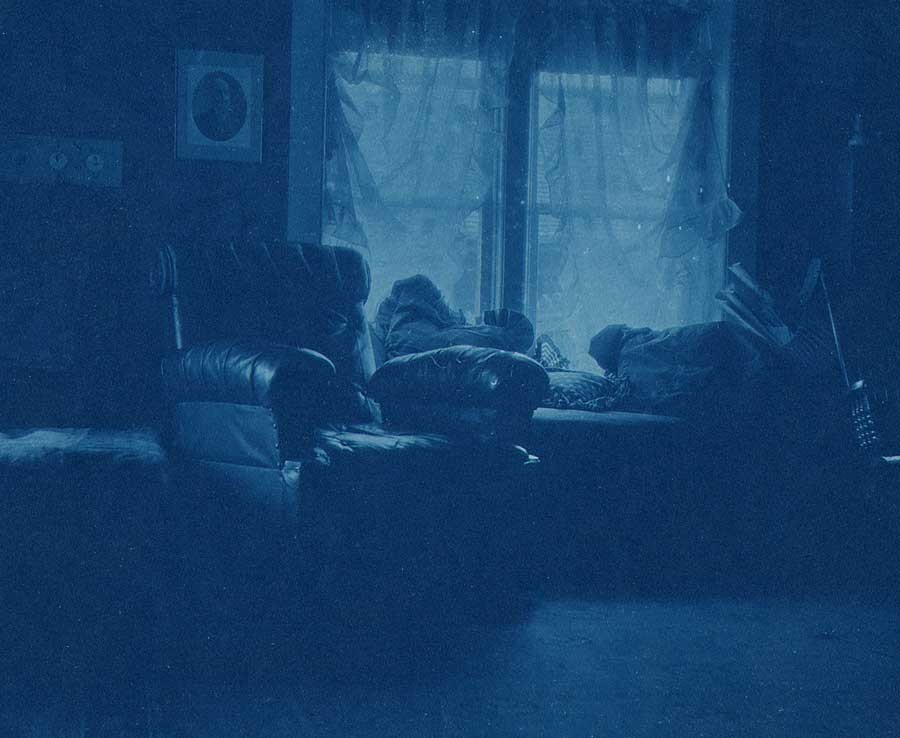 Detail: "Favorite Chair near Window" : anonymous American photographer: cyanotype: 1899: 9.4 x 12.0 cm: Another moody interior portrait, this time absent of any human subjects, is nonetheless interesting due to the feeling it evokes with the framed portrait of the bearded gentleman on the wall above what might be or was his favorite living room cushioned chair. Photograph may have been additionally printed on commercially available presensitized Venus paper manufactured by the Peerless Blue Print Co., as it was included in a cardboard box of this brand with an expiration date of 1899. Location for this image may have been the midwestern United States, as it was included in this Peerless box of loose cyanotypes purchased from an Indiana seller. From: PhotoSeed Archive
Detail: "Favorite Chair near Window" : anonymous American photographer: cyanotype: 1899: 9.4 x 12.0 cm: Another moody interior portrait, this time absent of any human subjects, is nonetheless interesting due to the feeling it evokes with the framed portrait of the bearded gentleman on the wall above what might be or was his favorite living room cushioned chair. Photograph may have been additionally printed on commercially available presensitized Venus paper manufactured by the Peerless Blue Print Co., as it was included in a cardboard box of this brand with an expiration date of 1899. Location for this image may have been the midwestern United States, as it was included in this Peerless box of loose cyanotypes purchased from an Indiana seller. From: PhotoSeed Archive
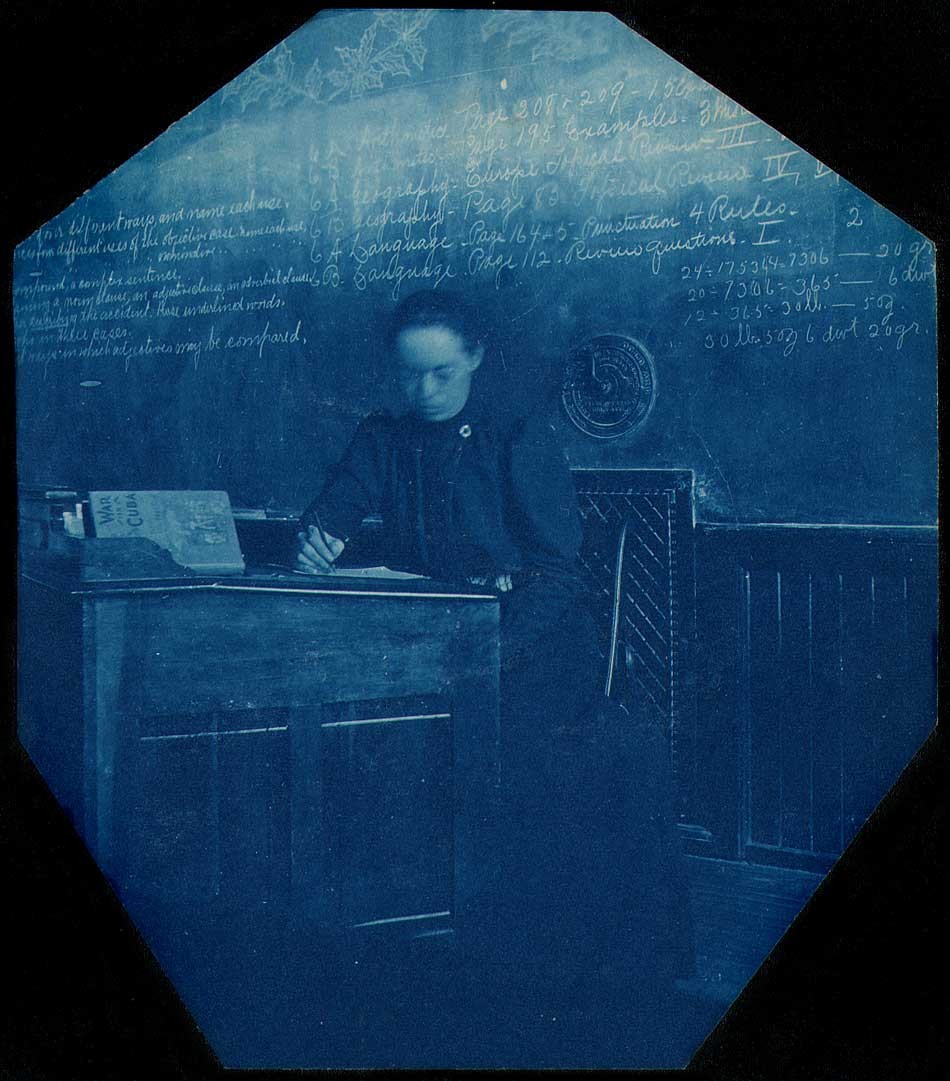 "Schoolteacher at Desk" : anonymous American photographer: cyanotype: 1899 or before: 10.5 x 9.1 cm: With slight motion blur seen in her face, a schoolteacher holding a pencil works on papers at her desk in front of a large blackboard listing student lesson plans including Arithmetic, Geography (Europe topical review) and Language, (Punctuation-4 rules) with additional lesson plans at left outlining sentence structures. The 1896 volume: The War in Cuba, Being a Full Account of Her Great Struggle for Freedom can be seen on the desk at left. A chalk drawing of holly leaves is at very top of blackboard, so view may date to the Christmas holiday of 1898. Photograph may have been additionally printed on commercially available presensitized Venus paper manufactured by the Peerless Blue Print Co., as it was included in a cardboard box of this brand with an expiration date of 1899. Location may have been the midwestern U.S., as it was purchased with other cyanotypes from an Indiana seller. From: PhotoSeed Archive
"Schoolteacher at Desk" : anonymous American photographer: cyanotype: 1899 or before: 10.5 x 9.1 cm: With slight motion blur seen in her face, a schoolteacher holding a pencil works on papers at her desk in front of a large blackboard listing student lesson plans including Arithmetic, Geography (Europe topical review) and Language, (Punctuation-4 rules) with additional lesson plans at left outlining sentence structures. The 1896 volume: The War in Cuba, Being a Full Account of Her Great Struggle for Freedom can be seen on the desk at left. A chalk drawing of holly leaves is at very top of blackboard, so view may date to the Christmas holiday of 1898. Photograph may have been additionally printed on commercially available presensitized Venus paper manufactured by the Peerless Blue Print Co., as it was included in a cardboard box of this brand with an expiration date of 1899. Location may have been the midwestern U.S., as it was purchased with other cyanotypes from an Indiana seller. From: PhotoSeed Archive
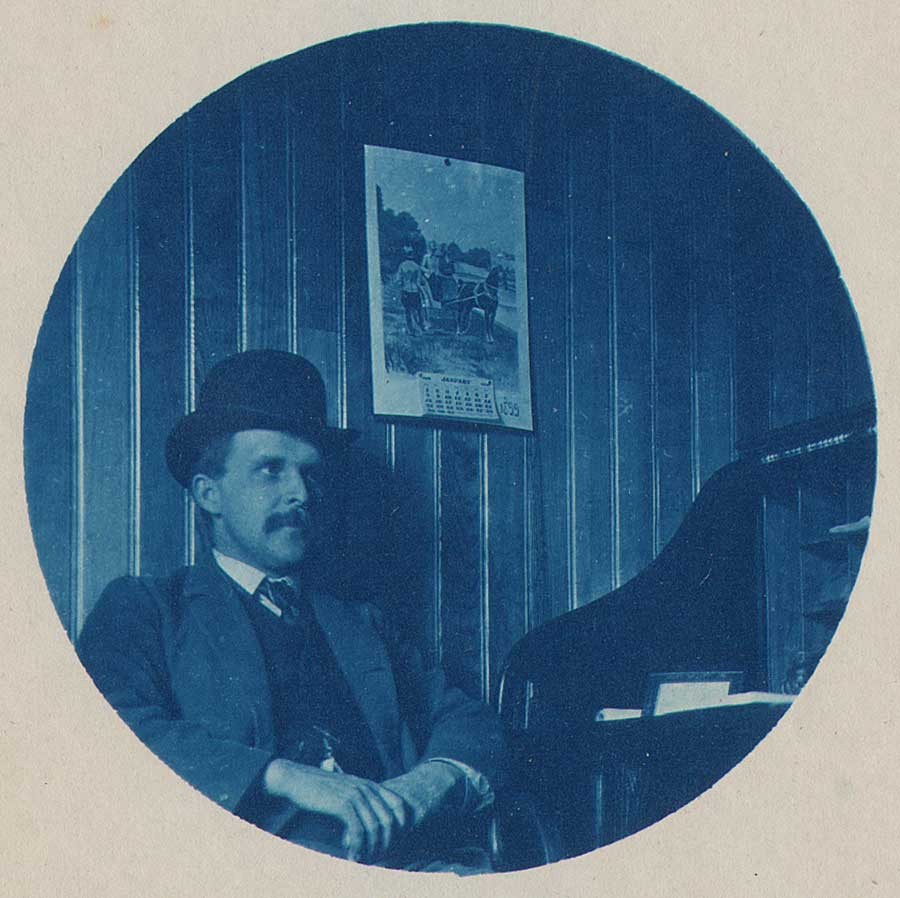 "Man with Bowler hat at Desk": : anonymous American photographer: cyanotype: 1899: 6.5 cm round | 11.3 x 8.8 cm: Possibly a self-portrait, a man wearing a bowler hat seated next to a desk stares away from the camera. A calendar featuring artwork of a horse preparing to pull a two-wheel cart dated January, 1899 hangs on the wall. Photograph may have been additionally printed on commercially available presensitized Venus paper manufactured by the Peerless Blue Print Co., as it was included in a cardboard box of this brand with an expiration date of 1899. Location may have been the midwestern U.S., as it was purchased with other cyanotypes from an Indiana seller. From: PhotoSeed Archive
"Man with Bowler hat at Desk": : anonymous American photographer: cyanotype: 1899: 6.5 cm round | 11.3 x 8.8 cm: Possibly a self-portrait, a man wearing a bowler hat seated next to a desk stares away from the camera. A calendar featuring artwork of a horse preparing to pull a two-wheel cart dated January, 1899 hangs on the wall. Photograph may have been additionally printed on commercially available presensitized Venus paper manufactured by the Peerless Blue Print Co., as it was included in a cardboard box of this brand with an expiration date of 1899. Location may have been the midwestern U.S., as it was purchased with other cyanotypes from an Indiana seller. From: PhotoSeed Archive
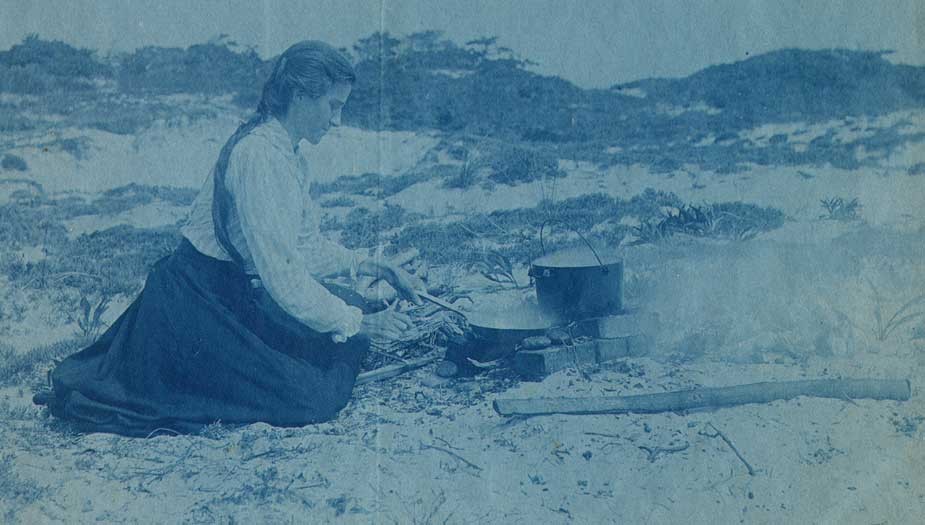 Detail: "Mother cooks at Point O' Woods LI": Charles Rollins Tucker: American: cyanotype: 1899: 12.5 x 17.3 cm: Mary (Carruthers) Tucker,(1870-1940) the spouse of amateur photographer C.R. Tucker, cooks on the beach at Point O'Woods. Wikipedia states this private retreat-even today- may have been the first settlement on Fire Island in Long Island Sound, and was originally organized in 1894 for religious retreats, some from the Chautauqua assemblies before ownership passed to the present-day Point O' Woods Association in 1898 after the first group went bankrupt. From: PhotoSeed Archive
Detail: "Mother cooks at Point O' Woods LI": Charles Rollins Tucker: American: cyanotype: 1899: 12.5 x 17.3 cm: Mary (Carruthers) Tucker,(1870-1940) the spouse of amateur photographer C.R. Tucker, cooks on the beach at Point O'Woods. Wikipedia states this private retreat-even today- may have been the first settlement on Fire Island in Long Island Sound, and was originally organized in 1894 for religious retreats, some from the Chautauqua assemblies before ownership passed to the present-day Point O' Woods Association in 1898 after the first group went bankrupt. From: PhotoSeed Archive
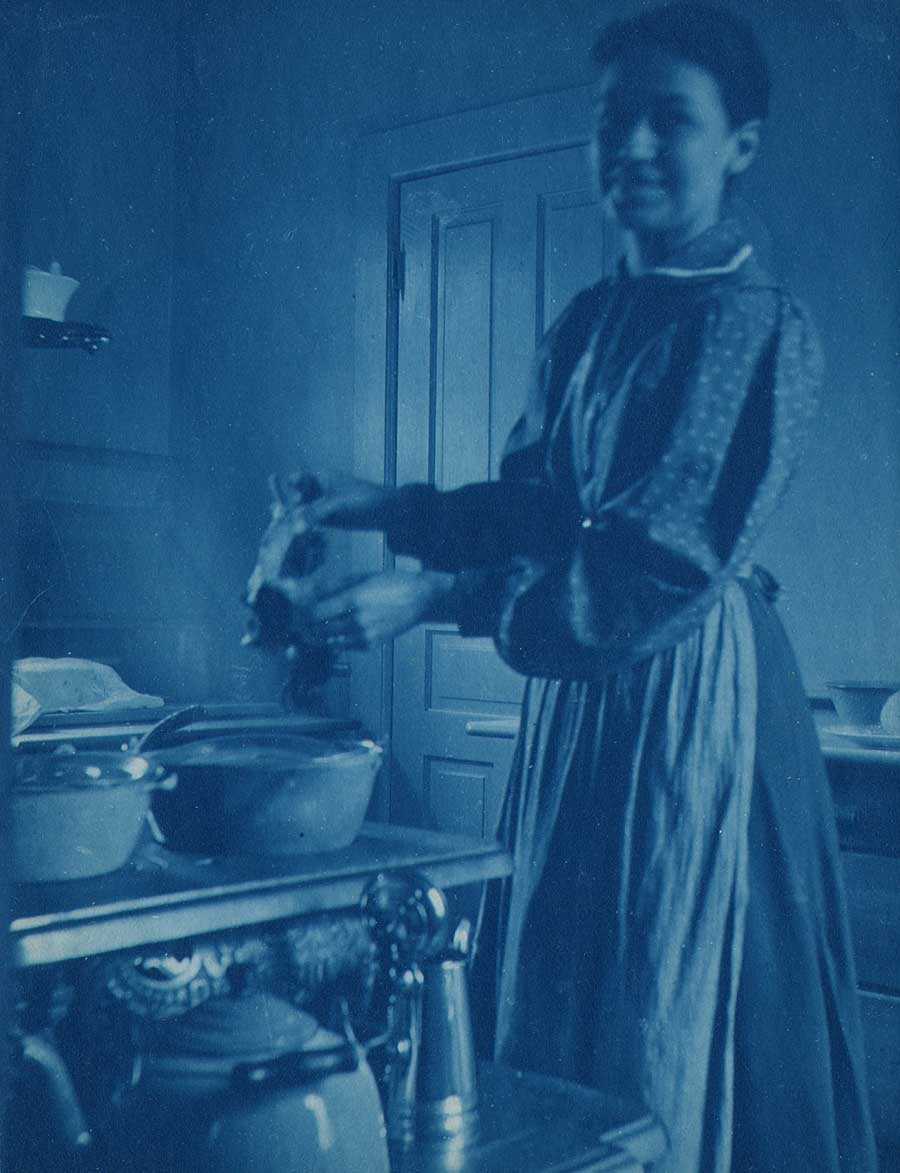 "Woman working in Kitchen" : anonymous American photographer: cyanotype: 1899: 11.9 x 9.2 cm: Wearing an apron and looking towards the camera, a woman prepares to place some type of food into a pot on a shelf above a stove while working in a home kitchen. Photograph may have been additionally printed on commercially available presensitized Venus paper manufactured by the Peerless Blue Print Co., as it was included in a cardboard box of this brand with an expiration date of 1899. Location may have been the midwestern U.S., as it was purchased with other cyanotypes from an Indiana seller. From: PhotoSeed Archive
"Woman working in Kitchen" : anonymous American photographer: cyanotype: 1899: 11.9 x 9.2 cm: Wearing an apron and looking towards the camera, a woman prepares to place some type of food into a pot on a shelf above a stove while working in a home kitchen. Photograph may have been additionally printed on commercially available presensitized Venus paper manufactured by the Peerless Blue Print Co., as it was included in a cardboard box of this brand with an expiration date of 1899. Location may have been the midwestern U.S., as it was purchased with other cyanotypes from an Indiana seller. From: PhotoSeed Archive
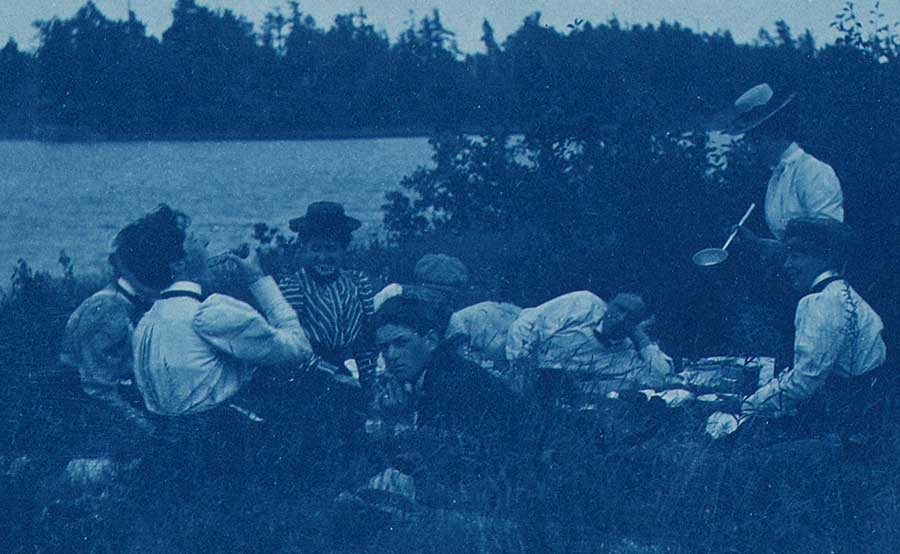 Detail: "Picnickers enjoy a Meal": anonymous American photographer: cyanotype: 1899: 8.0 x 10.6 | 9.9 x 12.5 cm: A party of seven fashionably-dressed men and women enjoy a picnic outing next to a lake. Photograph may have been additionally printed on commercially available presensitized Venus paper manufactured by the Peerless Blue Print Co., as it was included in a cardboard box of this brand with an expiration date of 1899. Location may have been the midwestern U.S., as it was purchased with other cyanotypes from an Indiana seller. From: PhotoSeed Archive
Detail: "Picnickers enjoy a Meal": anonymous American photographer: cyanotype: 1899: 8.0 x 10.6 | 9.9 x 12.5 cm: A party of seven fashionably-dressed men and women enjoy a picnic outing next to a lake. Photograph may have been additionally printed on commercially available presensitized Venus paper manufactured by the Peerless Blue Print Co., as it was included in a cardboard box of this brand with an expiration date of 1899. Location may have been the midwestern U.S., as it was purchased with other cyanotypes from an Indiana seller. From: PhotoSeed Archive
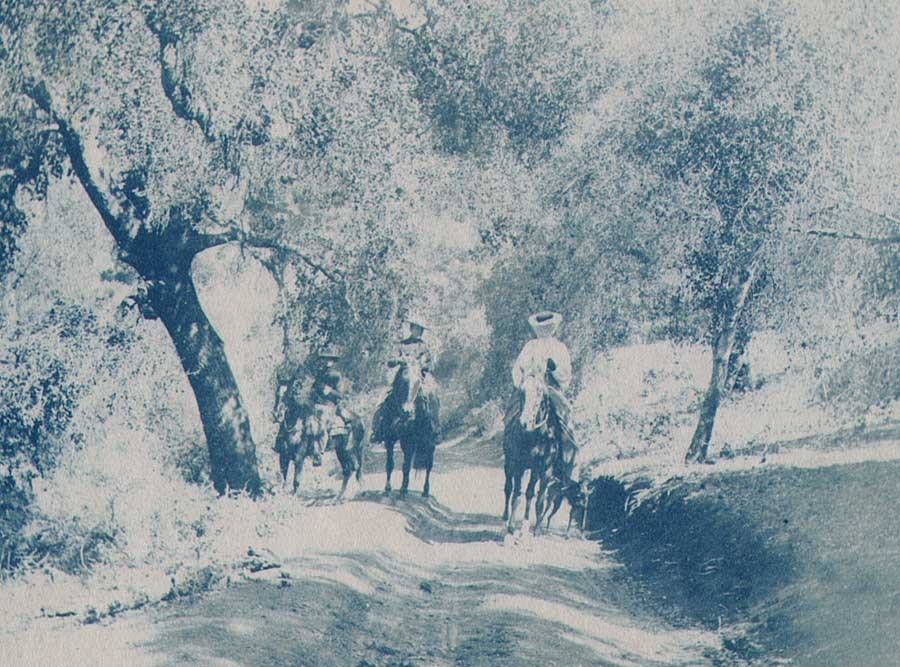 Detail: "Horseback Trail Ride": anonymous American photographer: cyanotype: 1899: 9.0 x 11.2 cm: Two men on horseback, who appear to be in military uniform at left, and a woman rider wearing mosquito netting over her hat and accompanied by a canine Whippet, stop for a moment in sunlight on a rural forest riding trail. Photograph may have been additionally printed on commercially available presensitized Venus paper manufactured by the Peerless Blue Print Co., as it was included in a cardboard box of this brand with an expiration date of 1899. Location may have been the midwestern U.S., as it was purchased with other cyanotypes from an Indiana seller. From: PhotoSeed Archive
Detail: "Horseback Trail Ride": anonymous American photographer: cyanotype: 1899: 9.0 x 11.2 cm: Two men on horseback, who appear to be in military uniform at left, and a woman rider wearing mosquito netting over her hat and accompanied by a canine Whippet, stop for a moment in sunlight on a rural forest riding trail. Photograph may have been additionally printed on commercially available presensitized Venus paper manufactured by the Peerless Blue Print Co., as it was included in a cardboard box of this brand with an expiration date of 1899. Location may have been the midwestern U.S., as it was purchased with other cyanotypes from an Indiana seller. From: PhotoSeed Archive
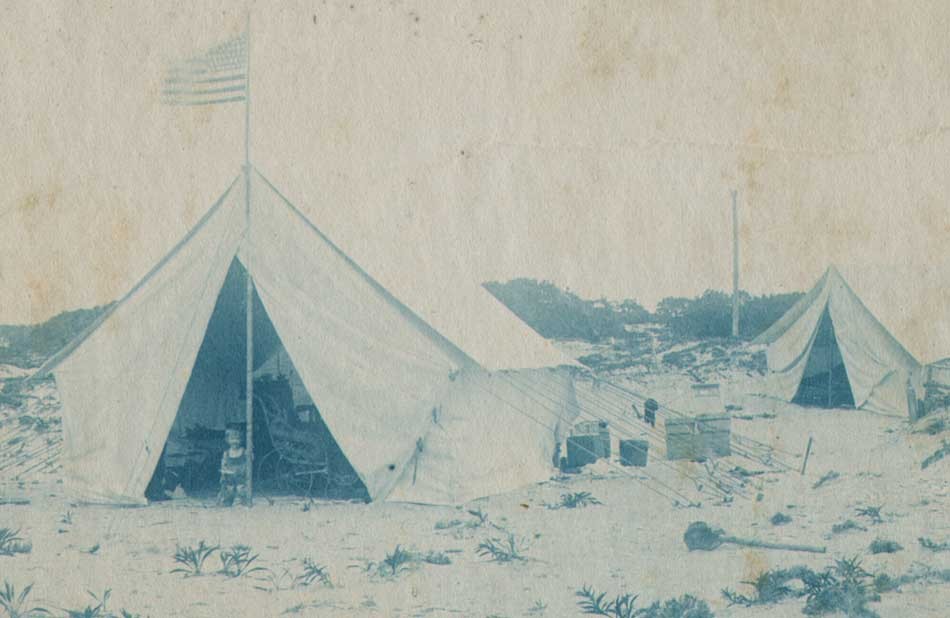 Detail: "Dorothy Tucker at Point O' Woods Beach Camp": Charles Rollins Tucker: American: cyanotype: 1901: 11.5 x 17.5 cm: Dorothy Tucker, (1899-1986) who appears to be no older than two years old, the young daughter of amateur photographer C.R. Tucker, stands at the entrance to a large canvas tent with American flag flying overhead on the beach at Point O' Woods. Wikipedia states this private retreat-even today- may have been the first settlement on Fire Island in Long Island Sound, and was originally organized in 1894 for religious retreats, some from the Chautauqua assemblies before ownership passed to the present-day Point O' Woods Association in 1898 after the first group went bankrupt. From: PhotoSeed Archive
Detail: "Dorothy Tucker at Point O' Woods Beach Camp": Charles Rollins Tucker: American: cyanotype: 1901: 11.5 x 17.5 cm: Dorothy Tucker, (1899-1986) who appears to be no older than two years old, the young daughter of amateur photographer C.R. Tucker, stands at the entrance to a large canvas tent with American flag flying overhead on the beach at Point O' Woods. Wikipedia states this private retreat-even today- may have been the first settlement on Fire Island in Long Island Sound, and was originally organized in 1894 for religious retreats, some from the Chautauqua assemblies before ownership passed to the present-day Point O' Woods Association in 1898 after the first group went bankrupt. From: PhotoSeed Archive
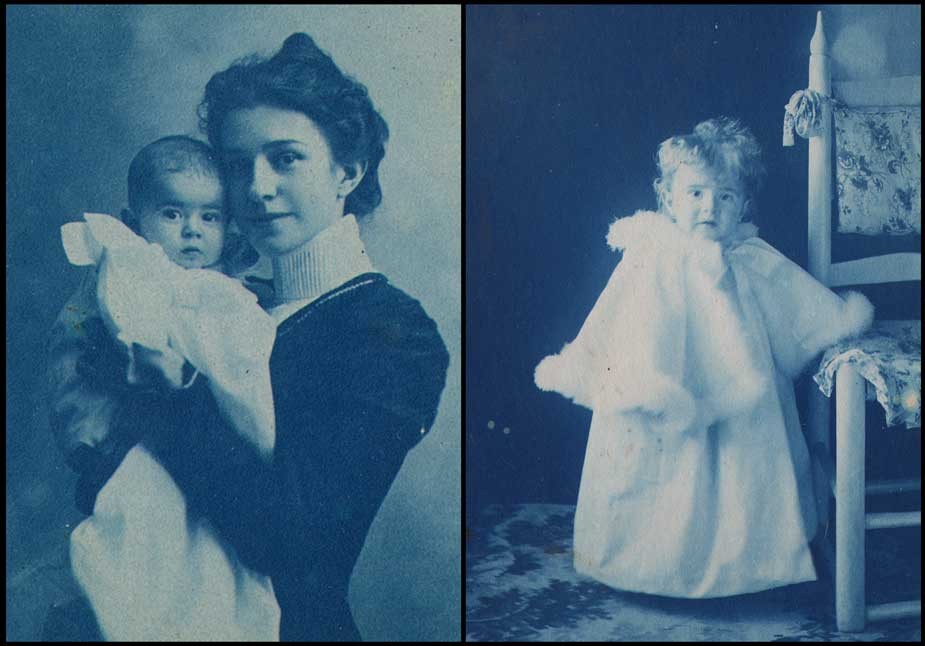 Left: Detail: "Baby Dorothy Tucker with Mother": Charles Rollins Tucker: American: cyanotype: 1899: 7.0 x 5.4 cm: Right: "Dorothy Tucker dressed in Fur-Trimmed Coat Next to Chair": Charles Rollins Tucker: American: cyanotype: 1900: 12.2 x 8.6 cm: Born in August of 1899 on New York's Staten Island, Dorothy Tucker was a constant subject for her father-a high school physics teacher at Curtis High School on the island-who trained his camera on her from birth to late teens. As a cyanotype, the photo showing Dorothy with her mother Mary Tucker (1870-1940) at left was thought well enough to frame behind glass as a family keepsake, lending credibility to the fact the process was not just considered a first way of proofing photos before a final selection was made. Instead, with the sequence shown in this post of four formal portraits of Dorothy as cyanotypes, the process was readily embraced by certain amateurs like Tucker. Both from: PhotoSeed Archive
Left: Detail: "Baby Dorothy Tucker with Mother": Charles Rollins Tucker: American: cyanotype: 1899: 7.0 x 5.4 cm: Right: "Dorothy Tucker dressed in Fur-Trimmed Coat Next to Chair": Charles Rollins Tucker: American: cyanotype: 1900: 12.2 x 8.6 cm: Born in August of 1899 on New York's Staten Island, Dorothy Tucker was a constant subject for her father-a high school physics teacher at Curtis High School on the island-who trained his camera on her from birth to late teens. As a cyanotype, the photo showing Dorothy with her mother Mary Tucker (1870-1940) at left was thought well enough to frame behind glass as a family keepsake, lending credibility to the fact the process was not just considered a first way of proofing photos before a final selection was made. Instead, with the sequence shown in this post of four formal portraits of Dorothy as cyanotypes, the process was readily embraced by certain amateurs like Tucker. Both from: PhotoSeed Archive
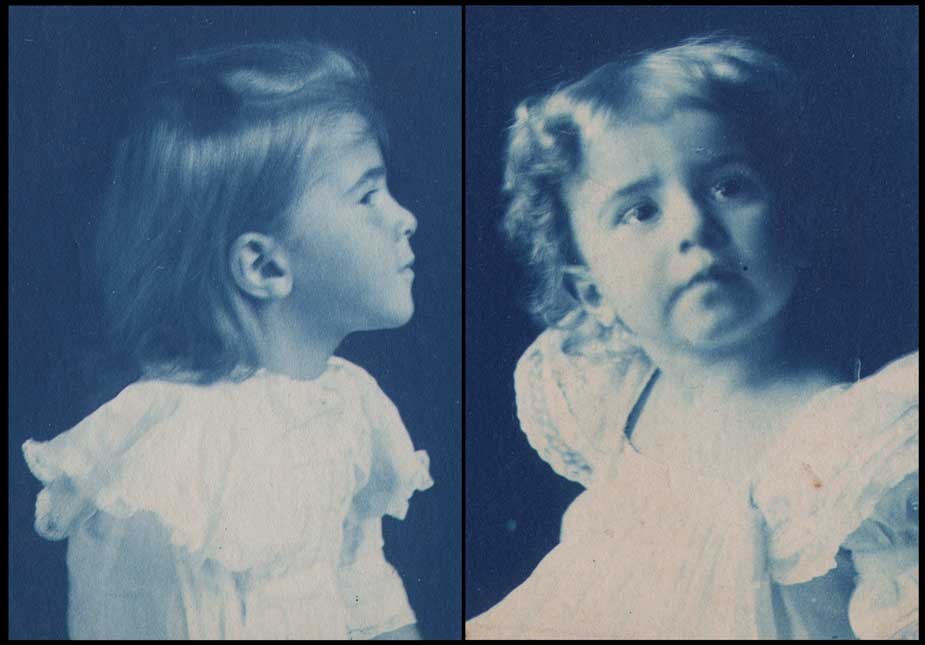 Left: "Dorothy Tucker Profile": Charles Rollins Tucker: American: cyanotype: ca. 1903: 9.9 x 7.2 cm: Right: "Portrait of Dorothy Tucker": Charles Rollins Tucker: American: cyanotype: ca. 1903: 9.3 x 6.9 | 17.8 x 12.8 cm. Born in August of 1899 on New York's Staten Island, Dorothy Tucker was a constant subject for her father-a high school physics teacher at Curtis High School on the island-who trained his camera on her from birth to late teens. Unlike many of the examples of Dorothy held by PhotoSeed that lack a mount, the cyanotype portrait of her at right was center-glued to a gray exhibition card, with another variant example printed in platinum showing evidence of being exhibited. Both from: PhotoSeed Archive
Left: "Dorothy Tucker Profile": Charles Rollins Tucker: American: cyanotype: ca. 1903: 9.9 x 7.2 cm: Right: "Portrait of Dorothy Tucker": Charles Rollins Tucker: American: cyanotype: ca. 1903: 9.3 x 6.9 | 17.8 x 12.8 cm. Born in August of 1899 on New York's Staten Island, Dorothy Tucker was a constant subject for her father-a high school physics teacher at Curtis High School on the island-who trained his camera on her from birth to late teens. Unlike many of the examples of Dorothy held by PhotoSeed that lack a mount, the cyanotype portrait of her at right was center-glued to a gray exhibition card, with another variant example printed in platinum showing evidence of being exhibited. Both from: PhotoSeed Archive
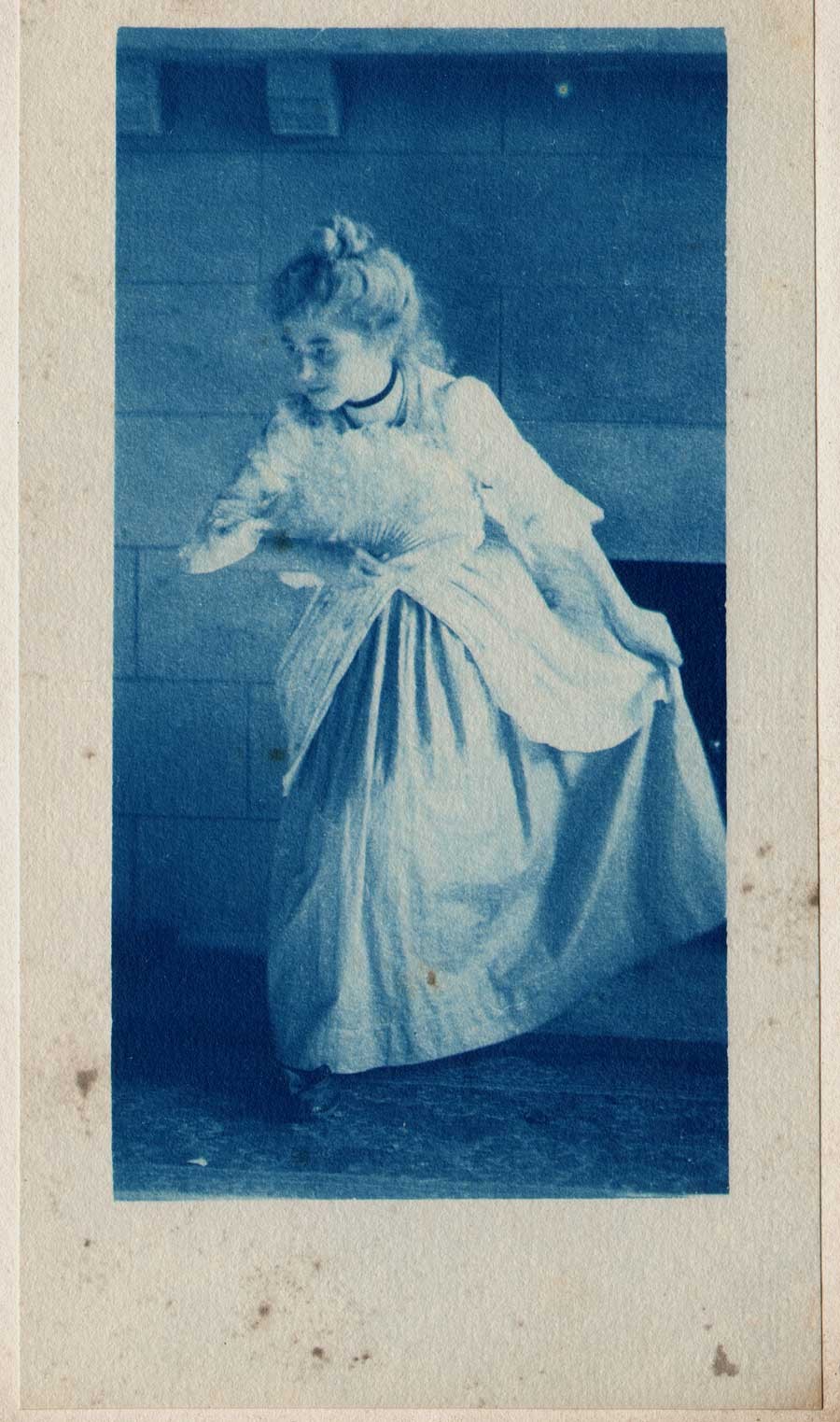 "Dorothy Tucker with Fan": presumed photographer: done in hand-inscribed, block letters: F.L.C.: American?: cyanotype: 1912: 16.5 x 8.6 | 22.0 x 11.3 cm: Shown presented within its tissue-guarded, ribbon tied folder, (22.6 x 12.3 cm) Dorothy Tucker, not quite 13 years old, strikes a pose with a fan inside her home on Staten Island, New York. She was most likely "performing" a part in a school play for "F.L.C.", presumed to be the photographer of this work who was certainly an acquaintance of Dorothy's amateur photographer father Charles Rollins Tucker. The presentation folder additionally dated in blue ink May 18, 1912 & annotated Dorothy Tucker in graphite along lower margin. From: PhotoSeed Archive
"Dorothy Tucker with Fan": presumed photographer: done in hand-inscribed, block letters: F.L.C.: American?: cyanotype: 1912: 16.5 x 8.6 | 22.0 x 11.3 cm: Shown presented within its tissue-guarded, ribbon tied folder, (22.6 x 12.3 cm) Dorothy Tucker, not quite 13 years old, strikes a pose with a fan inside her home on Staten Island, New York. She was most likely "performing" a part in a school play for "F.L.C.", presumed to be the photographer of this work who was certainly an acquaintance of Dorothy's amateur photographer father Charles Rollins Tucker. The presentation folder additionally dated in blue ink May 18, 1912 & annotated Dorothy Tucker in graphite along lower margin. From: PhotoSeed Archive
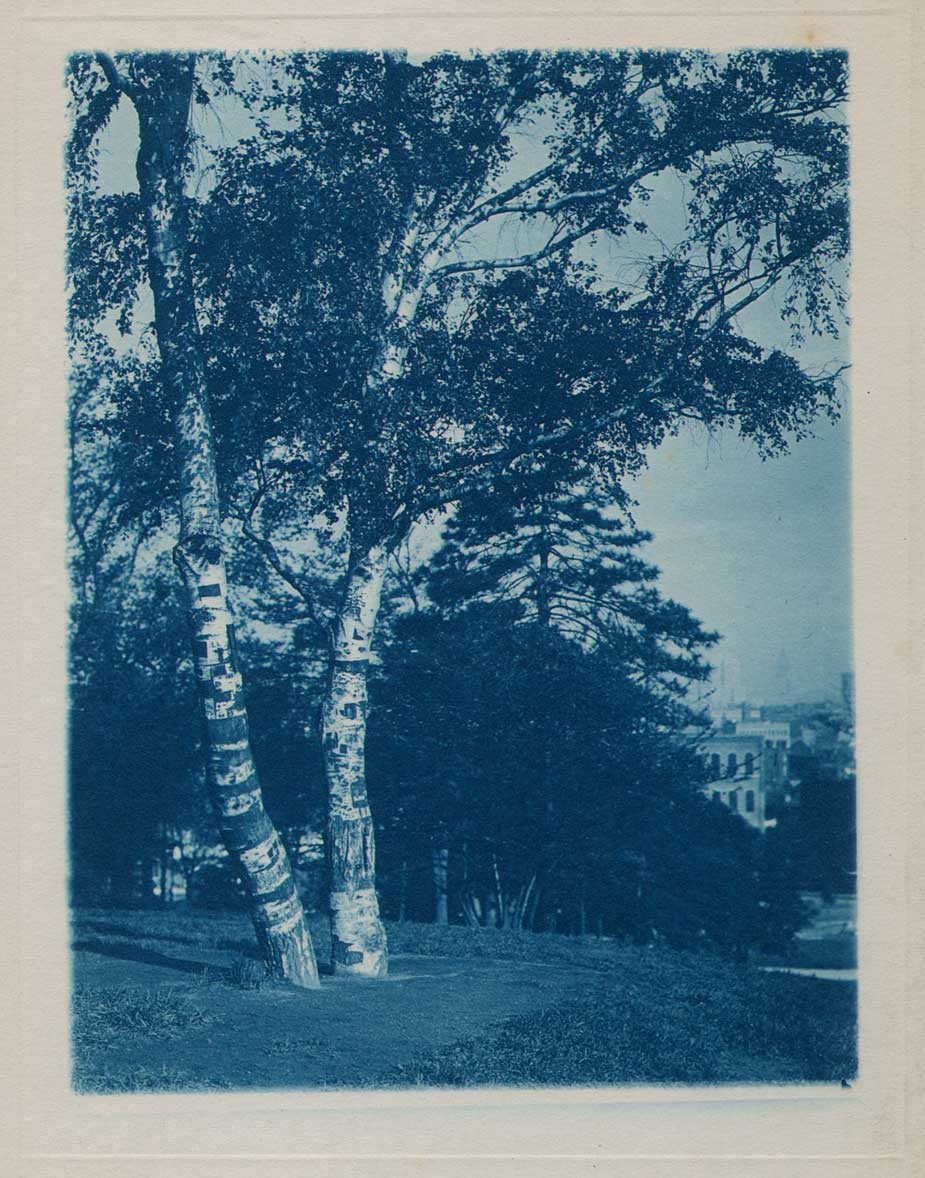 "White Birch Trees on Hill": by Unknown Brooklyn (photographer) : American: cyanotype: ca. 1905-10: 11.6 x 8.8 | 16.8 x 12.3 cm: A tantalizing backdrop of an unknown city can be seen in the distance at right of this cyanotype image featuring several sturdy white birch trees scarred in several places by penknives declaring true love. Possibly with a location of Prospect Park in Brooklyn, this photograph, with title supplied by this archive, is by an Unknown Brooklyn amateur photographer whose surviving work was discovered in a trunk in the American South. Background can be found by searching for this site's 2015 blog post: "No Junk in Trunk". From: PhotoSeed Archive
"White Birch Trees on Hill": by Unknown Brooklyn (photographer) : American: cyanotype: ca. 1905-10: 11.6 x 8.8 | 16.8 x 12.3 cm: A tantalizing backdrop of an unknown city can be seen in the distance at right of this cyanotype image featuring several sturdy white birch trees scarred in several places by penknives declaring true love. Possibly with a location of Prospect Park in Brooklyn, this photograph, with title supplied by this archive, is by an Unknown Brooklyn amateur photographer whose surviving work was discovered in a trunk in the American South. Background can be found by searching for this site's 2015 blog post: "No Junk in Trunk". From: PhotoSeed Archive
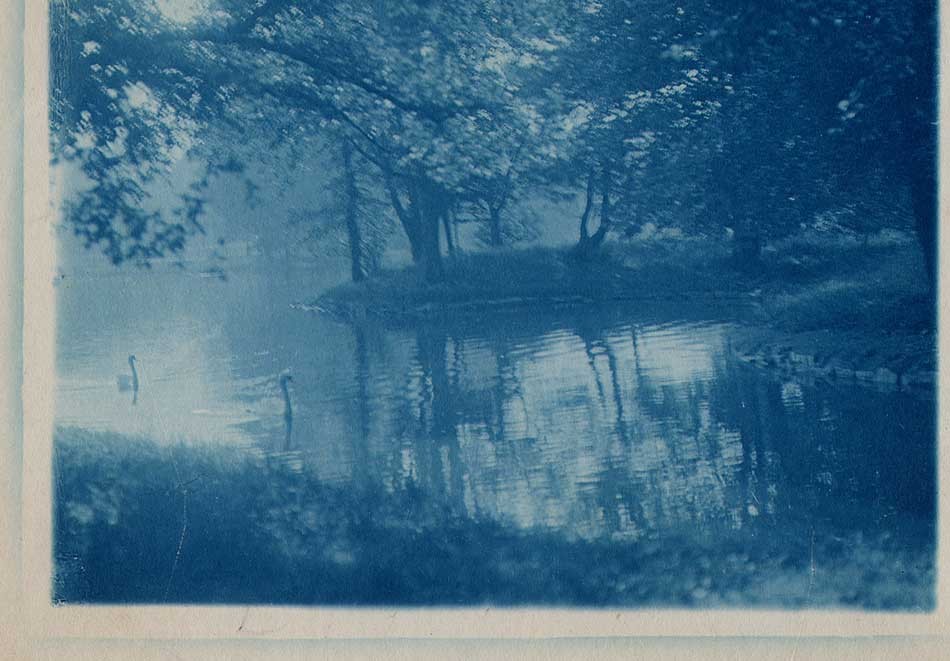 "Swans in Mist": by Unknown Brooklyn (photographer) : American: cyanotype: ca. 1905-10: 8.8 x 11.6 | 12.6 x 17.7 cm: Swans glide through mist on a lake in a park setting-possibly Brooklyn's Prospect Park as many known examples of this location were taken by this photographer. This photograph, with title supplied by this archive, is by an Unknown Brooklyn amateur photographer whose surviving work was discovered in a trunk in the American South. Background can be found by searching for this site's 2015 blog post: "No Junk in Trunk". From: PhotoSeed Archive
"Swans in Mist": by Unknown Brooklyn (photographer) : American: cyanotype: ca. 1905-10: 8.8 x 11.6 | 12.6 x 17.7 cm: Swans glide through mist on a lake in a park setting-possibly Brooklyn's Prospect Park as many known examples of this location were taken by this photographer. This photograph, with title supplied by this archive, is by an Unknown Brooklyn amateur photographer whose surviving work was discovered in a trunk in the American South. Background can be found by searching for this site's 2015 blog post: "No Junk in Trunk". From: PhotoSeed Archive
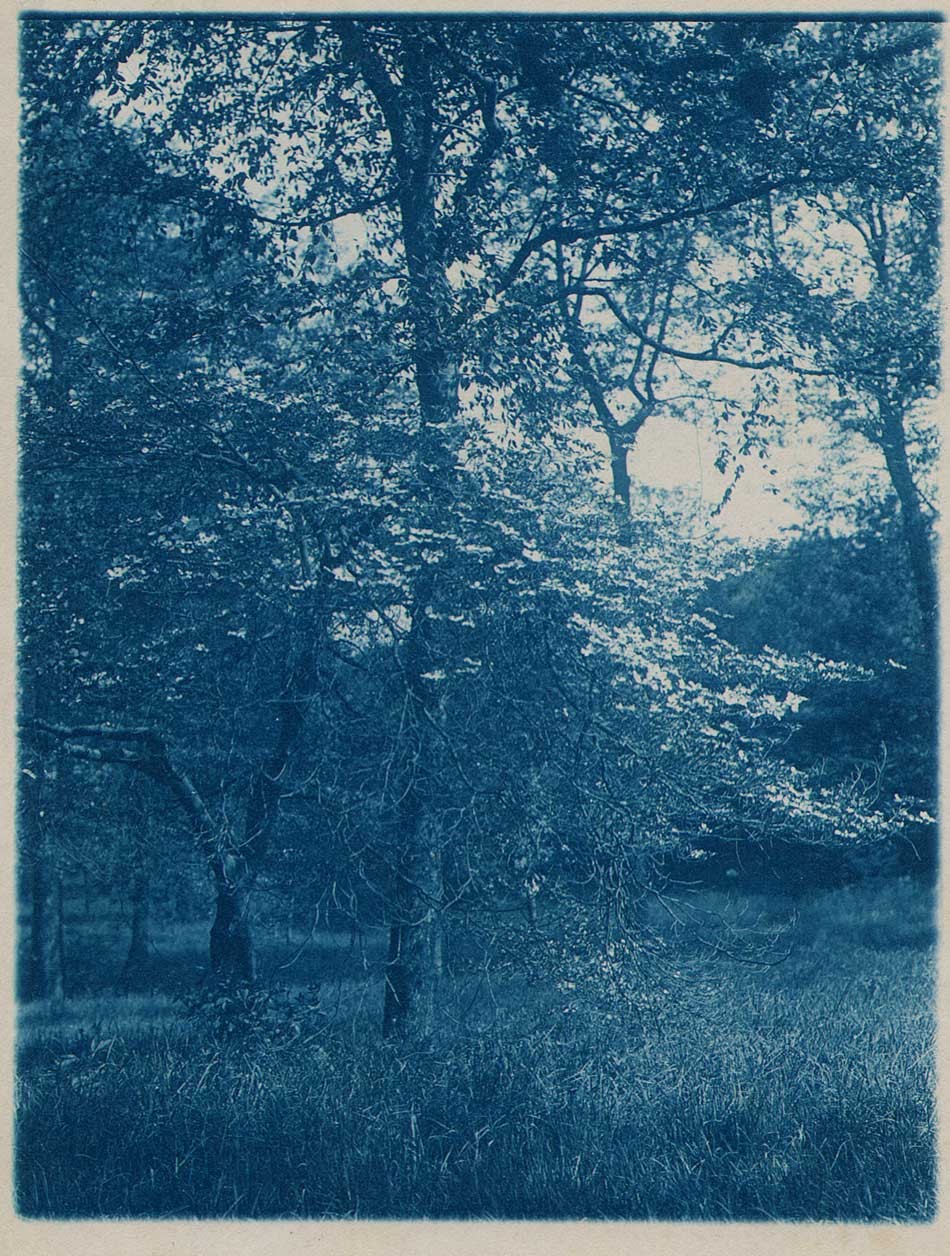 "Dogwood Tree in Bloom": by Unknown Brooklyn (photographer) : American: cyanotype: ca. 1905-10: 11.7 x 8.9 | 16.8 x 11.7 cm: A Dogwood tree blooms on the edge of a meadow in a park setting-possibly Brooklyn's Prospect Park as many known examples of this location were taken by this photographer. This photograph, with title supplied by this archive, is by an Unknown Brooklyn amateur photographer whose surviving work was discovered in a trunk in the American South. Background can be found by searching for this site's 2015 blog post: "No Junk in Trunk". From: private U.S. collection.
"Dogwood Tree in Bloom": by Unknown Brooklyn (photographer) : American: cyanotype: ca. 1905-10: 11.7 x 8.9 | 16.8 x 11.7 cm: A Dogwood tree blooms on the edge of a meadow in a park setting-possibly Brooklyn's Prospect Park as many known examples of this location were taken by this photographer. This photograph, with title supplied by this archive, is by an Unknown Brooklyn amateur photographer whose surviving work was discovered in a trunk in the American South. Background can be found by searching for this site's 2015 blog post: "No Junk in Trunk". From: private U.S. collection.
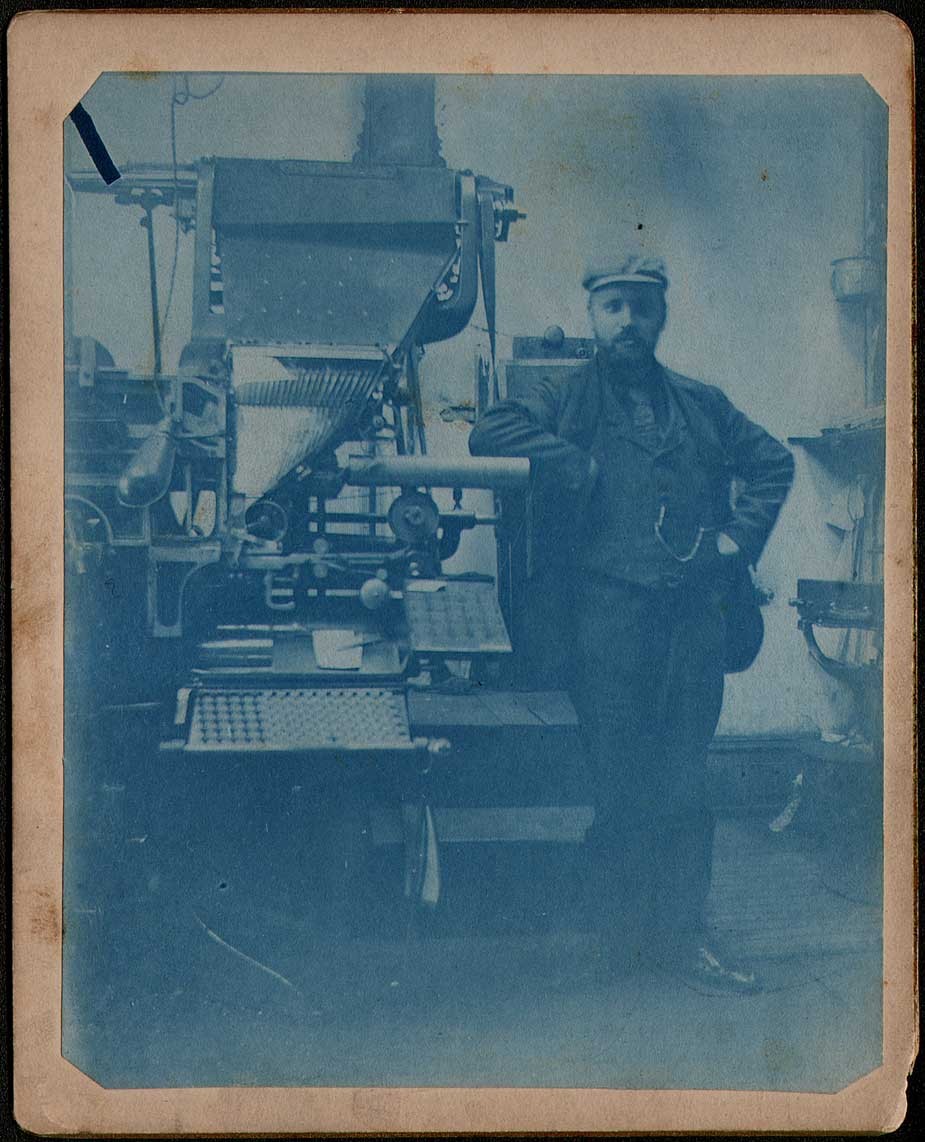 "Man Standing Next to Linotype Machine": unknown photographer: cyanotype: ca. 1895-1905: 11.9 x 9.6 | 13.2 x 10.6 cm: With the only annotation being the word Chicago written on the verso of this intriguing card-mounted cyanotype indicating origin, it's interesting to note that blueprinting, in addition to recording mechanical drawings, was also commonly used to make a record of large machinery like this early Linotype machine, an invention that revolutionized the speed of printing, particularly for newspapers and magazines. Invented by the German-born Ottmar Mergenthaler, (1854-1899) who has an uncanny surviving photographic likeness to the gentleman appearing in this cyanotype, the Linotype was first commercially used by the New York Tribune newspaper in 1886 and was in use into the 1970's, when it was largely replaced by offset lithography printing and computer typesetting. From: PhotoSeed Archive
"Man Standing Next to Linotype Machine": unknown photographer: cyanotype: ca. 1895-1905: 11.9 x 9.6 | 13.2 x 10.6 cm: With the only annotation being the word Chicago written on the verso of this intriguing card-mounted cyanotype indicating origin, it's interesting to note that blueprinting, in addition to recording mechanical drawings, was also commonly used to make a record of large machinery like this early Linotype machine, an invention that revolutionized the speed of printing, particularly for newspapers and magazines. Invented by the German-born Ottmar Mergenthaler, (1854-1899) who has an uncanny surviving photographic likeness to the gentleman appearing in this cyanotype, the Linotype was first commercially used by the New York Tribune newspaper in 1886 and was in use into the 1970's, when it was largely replaced by offset lithography printing and computer typesetting. From: PhotoSeed Archive
And now, examples of “blue prints” owing their roots to the beauty of the cyanotype reproduced using alternate photo-mechanical and photographic processes:
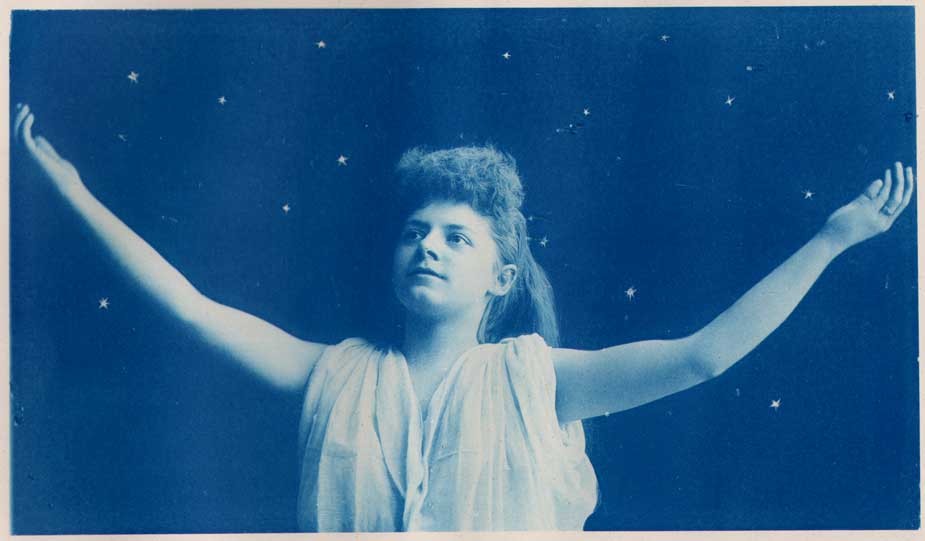 "Starlight": Charles Edward Doty: American 1862-1921: blue-toned collotype published in periodical "Sun & Shade: An Artistic Periodical": New York: January, 1890: whole #17: N.Y. Photo-Gravure Co.: 11.2 x 19.4 cm | 27.6 x 35.0 cm: The popularity of the cyanotype process gave reason for firms like the Photo Gravure Co. of New York to provide print runs for a larger audience of works like "Starlight" whose source imagery was originally a cyanotype. The model, said to be one Miss Emma McCormick, was photographed by Hamilton, Ohio portrait photographer Doty with outstretched arms against a backdrop of stars that were most likely added in the engraving process. Doty, according to the Smithsonian Institution in Washington, which owns hundreds of his original photographs, went on to become the "official photographer of the United States government in Havana," his duties included documenting the modernization of Cuba under American governorship. From: PhotoSeed Archive
"Starlight": Charles Edward Doty: American 1862-1921: blue-toned collotype published in periodical "Sun & Shade: An Artistic Periodical": New York: January, 1890: whole #17: N.Y. Photo-Gravure Co.: 11.2 x 19.4 cm | 27.6 x 35.0 cm: The popularity of the cyanotype process gave reason for firms like the Photo Gravure Co. of New York to provide print runs for a larger audience of works like "Starlight" whose source imagery was originally a cyanotype. The model, said to be one Miss Emma McCormick, was photographed by Hamilton, Ohio portrait photographer Doty with outstretched arms against a backdrop of stars that were most likely added in the engraving process. Doty, according to the Smithsonian Institution in Washington, which owns hundreds of his original photographs, went on to become the "official photographer of the United States government in Havana," his duties included documenting the modernization of Cuba under American governorship. From: PhotoSeed Archive
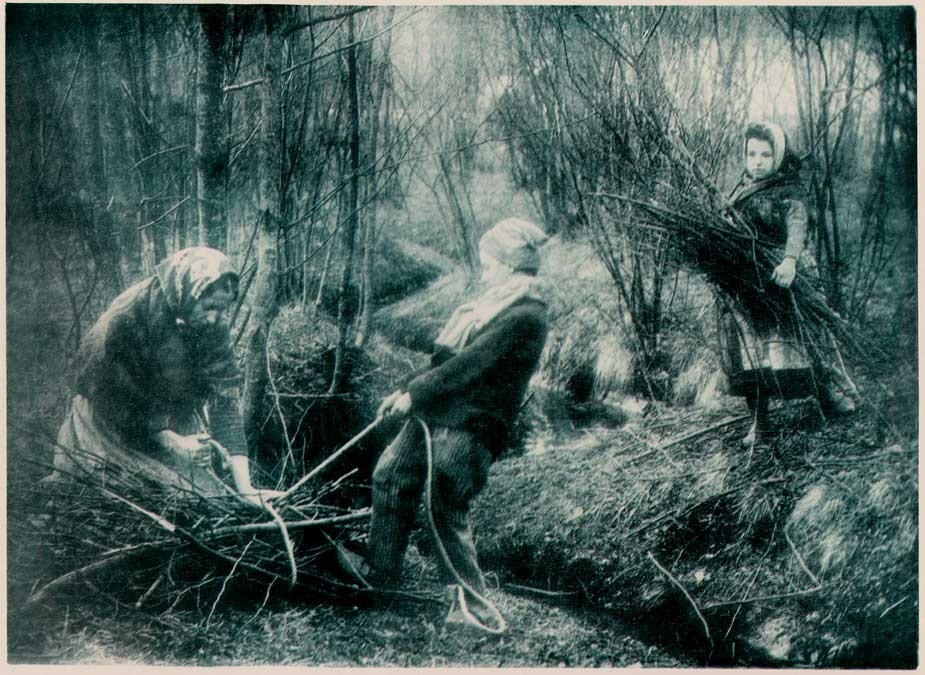 "Bundling and Gathering Faggots": Nestor Stekke: La Louvière, Belgium: blue-tinted collotype published in Sentiment d'Art en Photographie: Brussels,: Vol. II, No. 1, Planche 1: October, 1899: 16.1 x 22.3 | 26.5 x 37.2 cm: Featuring the work primarily of Belgian photographers but open to all, this folio-sized high-quality photographic plate publication, (The Feeling of Art in Photography) under the direction of Camille Smits with reproductions executed in collotype by Jules Liorel, featured the award winning work of pictorialists who entered monthly contests on a given theme judged by painter (M. Titz) and amateur photographer Van Gèle. Short-lived, Sentiment debuted in October, 1898 and ran until January, 1901 when it was renamed L'Art en Photographie . From: PhotoSeed Archive
"Bundling and Gathering Faggots": Nestor Stekke: La Louvière, Belgium: blue-tinted collotype published in Sentiment d'Art en Photographie: Brussels,: Vol. II, No. 1, Planche 1: October, 1899: 16.1 x 22.3 | 26.5 x 37.2 cm: Featuring the work primarily of Belgian photographers but open to all, this folio-sized high-quality photographic plate publication, (The Feeling of Art in Photography) under the direction of Camille Smits with reproductions executed in collotype by Jules Liorel, featured the award winning work of pictorialists who entered monthly contests on a given theme judged by painter (M. Titz) and amateur photographer Van Gèle. Short-lived, Sentiment debuted in October, 1898 and ran until January, 1901 when it was renamed L'Art en Photographie . From: PhotoSeed Archive
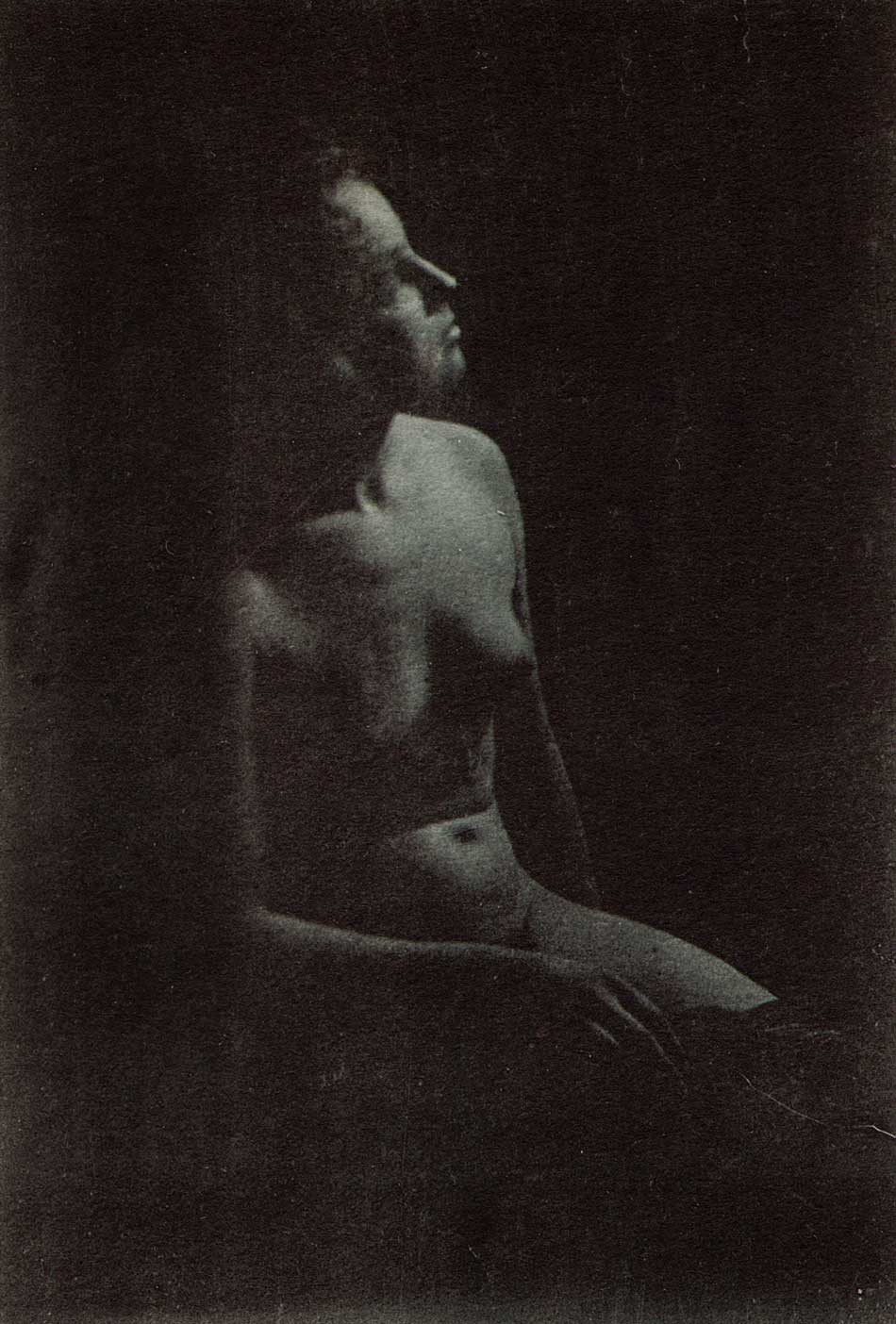 "Nude in Darkness": Léon Sneyers: Belgium:(1877-1949) collotype published in L'Art en Photographie: Brussels: No. 8: August, 1901: 12.4 x 8.3 | 37.0 x 25.5 cm: Translated to "Art in Photography", this folio-sized plate work was a continuation of "Le Sentiment d'Art en Photographie", with primarily Belgian pictorialists entering their work in contests on a given theme. Published by Jules Liorel, who also printed the plates in his Brussels atelier, a bibliography of this monthly work states it was "undoubtedly inspired by "Die Kunst in der Photographie", a German publication, and by "L'Art Photographique" published in Paris". This observation was made in reference to the fine-quality plates issued with it, as in this female nude study by Sneyers taken in the shadows and printed effectively by Liorel in collotype using an ink color combining deep black and violet to compliment the closed eyes of Sneyer's model. From: PhotoSeed Archive
"Nude in Darkness": Léon Sneyers: Belgium:(1877-1949) collotype published in L'Art en Photographie: Brussels: No. 8: August, 1901: 12.4 x 8.3 | 37.0 x 25.5 cm: Translated to "Art in Photography", this folio-sized plate work was a continuation of "Le Sentiment d'Art en Photographie", with primarily Belgian pictorialists entering their work in contests on a given theme. Published by Jules Liorel, who also printed the plates in his Brussels atelier, a bibliography of this monthly work states it was "undoubtedly inspired by "Die Kunst in der Photographie", a German publication, and by "L'Art Photographique" published in Paris". This observation was made in reference to the fine-quality plates issued with it, as in this female nude study by Sneyers taken in the shadows and printed effectively by Liorel in collotype using an ink color combining deep black and violet to compliment the closed eyes of Sneyer's model. From: PhotoSeed Archive
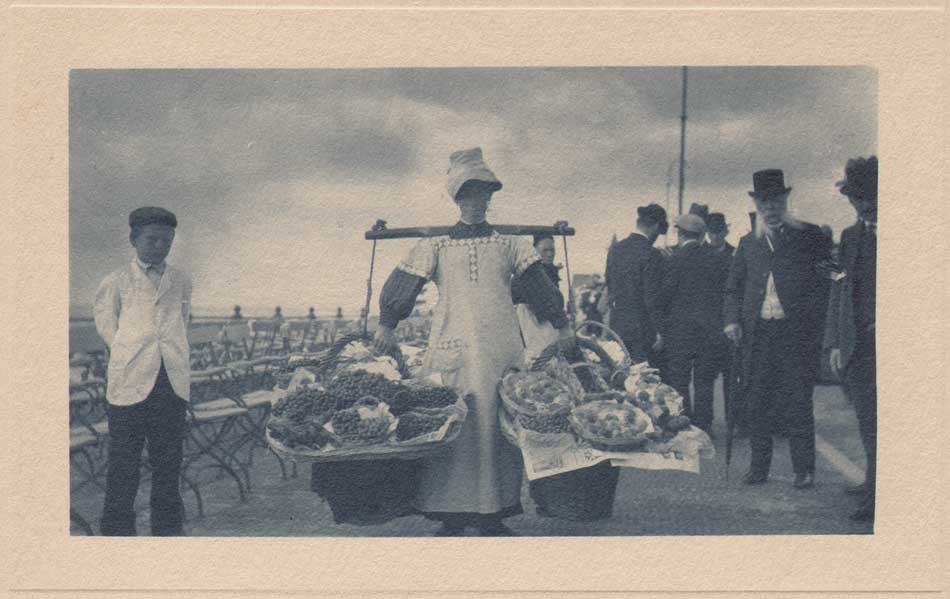 "Fruit Seller on Scheveningen Pier": Frank G.(eorge) Ensenberger, American: 1879-1966: blue-toned bromoil transfer print: 1910: 7.6 x 13.1 | 27.0 x 22.3 cm: A young woman balancing her load of grapes and other fruits for sale with a yoke stands on the Scheveningen Pier at the popular seaside resort located in The Hague in the Netherlands. In May, 1910, amateur photographer Frank Ensenberger of Bloomington, Ill sailed from Boston to Europe with his family, where he spent four months touring Great Britain, the Continent and other countries all while documenting the trip with his camera. On his return, approximately 900 selects were made by him and printed in various tints as bromoil transfer prints by an unknown professional photographer. They were gathered by country in leather-bound volumes, of which PhotoSeed owns nine. A prosperous business merchant and president of Ensenberger's home furnishings store in Bloomington, the Bloomington Pantagraph newspaper wrote of his photographic efforts during the trip in September, 1910, commenting: "The proofs show Mr. Ensenberger possesses the rare instinct of recognizing the setting for a good picture when he sees it, many of the views being truly artistic." Truthfully, his work was competent overall, with many of the plates being more "snapshot" in nature although documentary images scattered throughout the volumes show better than average compositional qualities. From: PhotoSeed Archive
"Fruit Seller on Scheveningen Pier": Frank G.(eorge) Ensenberger, American: 1879-1966: blue-toned bromoil transfer print: 1910: 7.6 x 13.1 | 27.0 x 22.3 cm: A young woman balancing her load of grapes and other fruits for sale with a yoke stands on the Scheveningen Pier at the popular seaside resort located in The Hague in the Netherlands. In May, 1910, amateur photographer Frank Ensenberger of Bloomington, Ill sailed from Boston to Europe with his family, where he spent four months touring Great Britain, the Continent and other countries all while documenting the trip with his camera. On his return, approximately 900 selects were made by him and printed in various tints as bromoil transfer prints by an unknown professional photographer. They were gathered by country in leather-bound volumes, of which PhotoSeed owns nine. A prosperous business merchant and president of Ensenberger's home furnishings store in Bloomington, the Bloomington Pantagraph newspaper wrote of his photographic efforts during the trip in September, 1910, commenting: "The proofs show Mr. Ensenberger possesses the rare instinct of recognizing the setting for a good picture when he sees it, many of the views being truly artistic." Truthfully, his work was competent overall, with many of the plates being more "snapshot" in nature although documentary images scattered throughout the volumes show better than average compositional qualities. From: PhotoSeed Archive
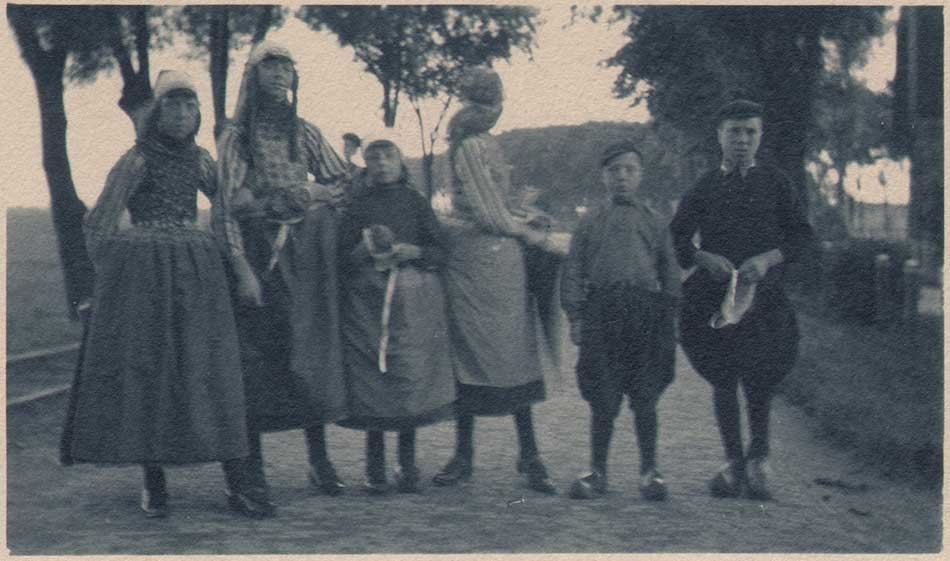 "Children Portrait Group in Holland": Frank G.(eorge) Ensenberger, American: 1879-1966: blue-toned bromoil transfer print: 1910: 7.6 x 13.1 | 27.0 x 22.3 cm: Standing in the middle of a roadway in Holland, a group of six children in their native dress stand for a portrait, the boys at right wearing traditional wooden shoes. In May, 1910, amateur photographer Frank Ensenberger of Bloomington, Ill sailed from Boston to Europe with his family, where he spent four months touring Great Britain, the Continent and other countries all while documenting the trip with his camera. On his return, approximately 900 selects were made by him and printed in various tints as bromoil transfer prints by an unknown professional photographer. They were gathered by country in leather-bound volumes, of which PhotoSeed owns nine. A prosperous business merchant and president of Ensenberger's home furnishings store in Bloomington, the Bloomington Pantagraph newspaper wrote of his photographic efforts during the trip in September, 1910, commenting: "The proofs show Mr. Ensenberger possesses the rare instinct of recognizing the setting for a good picture when he sees it, many of the views being truly artistic." Truthfully, his work was competent overall, with many of the plates being more "snapshot" in nature although documentary images scattered throughout the volumes show better than average compositional qualities. From: PhotoSeed Archive
"Children Portrait Group in Holland": Frank G.(eorge) Ensenberger, American: 1879-1966: blue-toned bromoil transfer print: 1910: 7.6 x 13.1 | 27.0 x 22.3 cm: Standing in the middle of a roadway in Holland, a group of six children in their native dress stand for a portrait, the boys at right wearing traditional wooden shoes. In May, 1910, amateur photographer Frank Ensenberger of Bloomington, Ill sailed from Boston to Europe with his family, where he spent four months touring Great Britain, the Continent and other countries all while documenting the trip with his camera. On his return, approximately 900 selects were made by him and printed in various tints as bromoil transfer prints by an unknown professional photographer. They were gathered by country in leather-bound volumes, of which PhotoSeed owns nine. A prosperous business merchant and president of Ensenberger's home furnishings store in Bloomington, the Bloomington Pantagraph newspaper wrote of his photographic efforts during the trip in September, 1910, commenting: "The proofs show Mr. Ensenberger possesses the rare instinct of recognizing the setting for a good picture when he sees it, many of the views being truly artistic." Truthfully, his work was competent overall, with many of the plates being more "snapshot" in nature although documentary images scattered throughout the volumes show better than average compositional qualities. From: PhotoSeed Archive
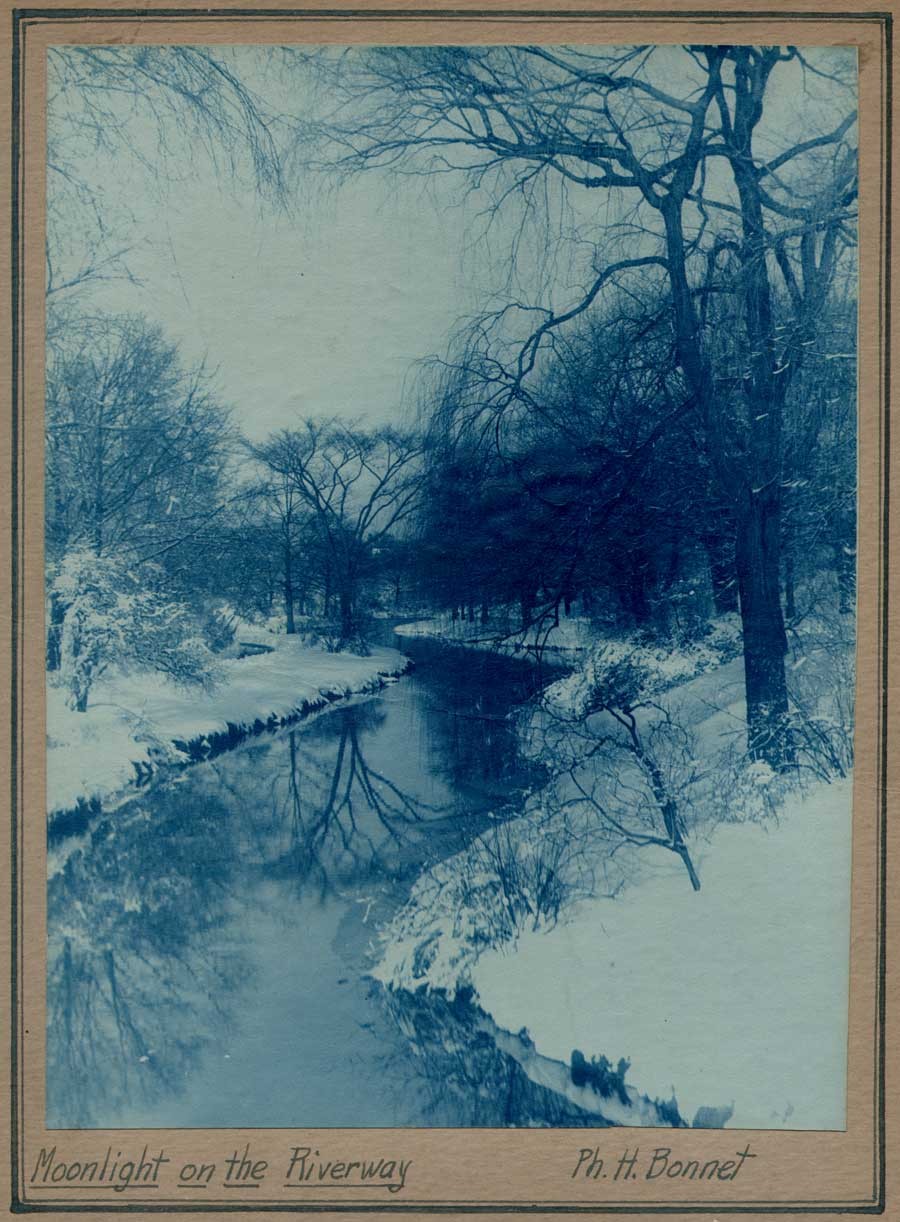 "Moonlight on the Riverway": Ph.(ilippe) H. Bonnet: 1904-1977: American: born France: blue-toned silver bromide print? ca. 1930-40: 24.8 x 18.6 | 38.6 x 26.3 cm: As a younger man, Philippe H. Bonnet was a staff photographer for The Tech, the Massachusetts Institute of Technology's undergraduate student newspaper. He is believed to have graduated from MIT in 1931 as listed in the Tech. In the early 1960's, a newspaper said he was a well known Boston architect. He also later made a name for himself as a railroad photographer-especially of trolley cars- and made his own real photo post cards and stamped them individually as a "Ferroviagraph". This scenic view of a river in Winter is from a series of landscape photographs believed to have been taken by him in the Middlesex Fells Reservation, a 2500 acre natural area located just north of Boston. A double-lined, hand-ruled frame in blue ink compliments the deep-blue effect achieved through the action of blue-toning. From: PhotoSeed Archive
"Moonlight on the Riverway": Ph.(ilippe) H. Bonnet: 1904-1977: American: born France: blue-toned silver bromide print? ca. 1930-40: 24.8 x 18.6 | 38.6 x 26.3 cm: As a younger man, Philippe H. Bonnet was a staff photographer for The Tech, the Massachusetts Institute of Technology's undergraduate student newspaper. He is believed to have graduated from MIT in 1931 as listed in the Tech. In the early 1960's, a newspaper said he was a well known Boston architect. He also later made a name for himself as a railroad photographer-especially of trolley cars- and made his own real photo post cards and stamped them individually as a "Ferroviagraph". This scenic view of a river in Winter is from a series of landscape photographs believed to have been taken by him in the Middlesex Fells Reservation, a 2500 acre natural area located just north of Boston. A double-lined, hand-ruled frame in blue ink compliments the deep-blue effect achieved through the action of blue-toning. From: PhotoSeed Archive
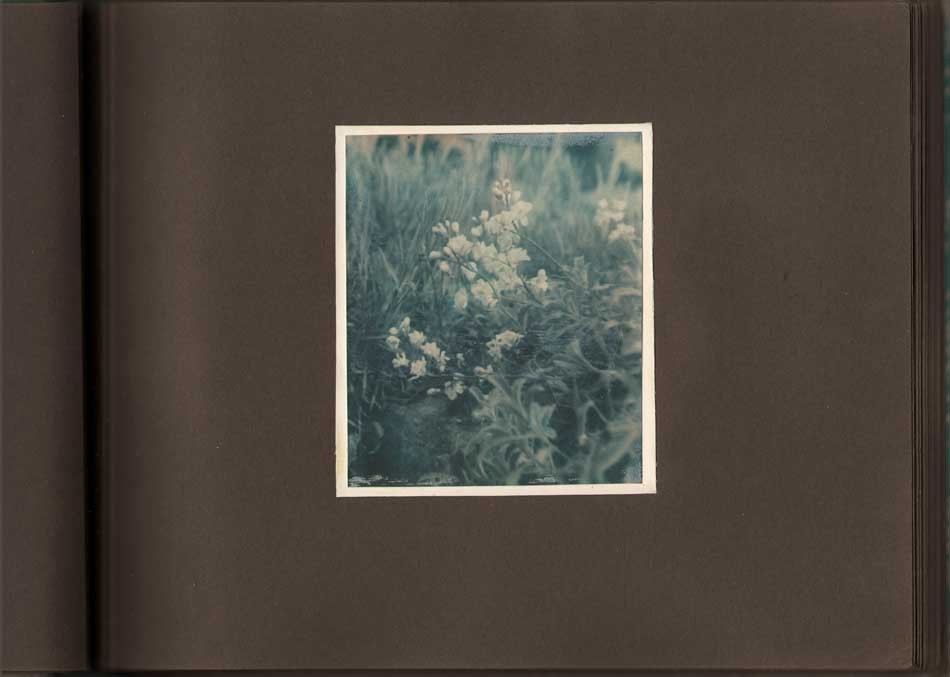 "Baby's Breath Growing in Wild": unknown photographer: blue-toned gelatin silver print: ca. 1930-40: 12.5 x 10.5 | 13.2 x 11.4 | 23.8 x 31.9 cm: This delicate study of what are believed to be Baby's Breath flowers (Gypsophilia, or Das Schleierkraut) is presented here in an album by an anonymous photographer (purchased from a seller in Greece) including a selection of pictorialist works featuring nicely mounted cityscape, mountain, and marine views, several of which show Frankfurt, Germany. From: PhotoSeed Archive
"Baby's Breath Growing in Wild": unknown photographer: blue-toned gelatin silver print: ca. 1930-40: 12.5 x 10.5 | 13.2 x 11.4 | 23.8 x 31.9 cm: This delicate study of what are believed to be Baby's Breath flowers (Gypsophilia, or Das Schleierkraut) is presented here in an album by an anonymous photographer (purchased from a seller in Greece) including a selection of pictorialist works featuring nicely mounted cityscape, mountain, and marine views, several of which show Frankfurt, Germany. From: PhotoSeed Archive
And in conclusion, a final cyanotype:
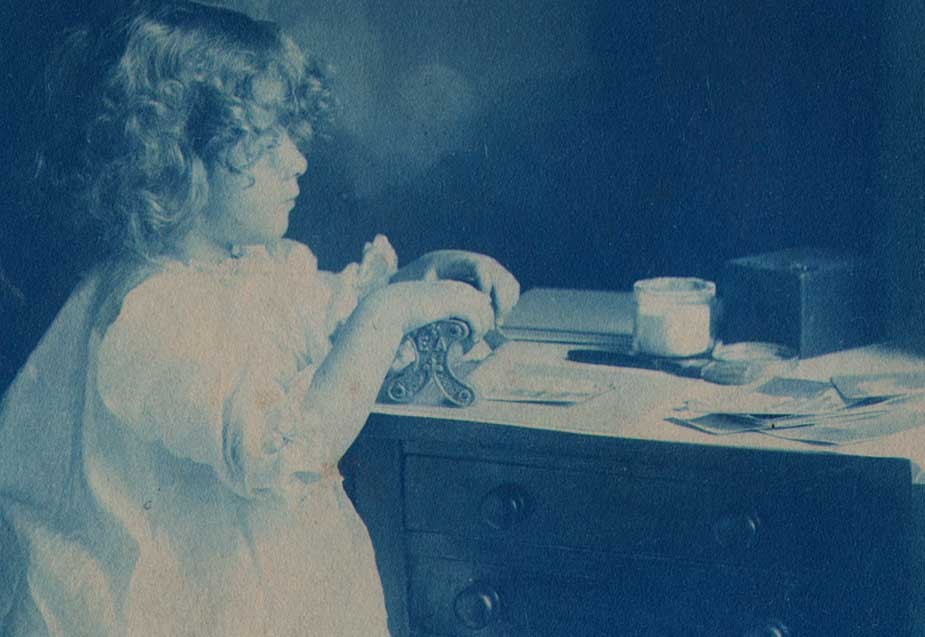 Detail: "Dorothy Tucker Mounting Photographs": Charles Rollins Tucker: American: cyanotype: ca. 1903: 11.3 x 8.6 | 15.0 x 12.6 cm: Seated on a stool, Dorothy Tucker, (1899-1986) the young daughter of amateur photographer Charles Rollins Tucker, is shown using an E. & H.T. Anthony brand Print Mounter to mount a photograph on a work table. Possibly taken for one of the yearly amateur Kodak advertising contests, the work space shows a Kodak Brownie camera at right rear, loose photographs, an album and a jar of what is most likely "Daisy" mounting paste with a brush next to it. Gripping the top of the mounter, young Dorothy prepares to slide the mounter with its two rollers over a print seen just to the right of it. The initials "EA" for Edward Anthony, are engraved on the side of roller. The E. & H.T. Anthony firm was considered the largest manufacturer and distributor of photographic supplies in the United States during the 19th century. From: PhotoSeed Archive
Detail: "Dorothy Tucker Mounting Photographs": Charles Rollins Tucker: American: cyanotype: ca. 1903: 11.3 x 8.6 | 15.0 x 12.6 cm: Seated on a stool, Dorothy Tucker, (1899-1986) the young daughter of amateur photographer Charles Rollins Tucker, is shown using an E. & H.T. Anthony brand Print Mounter to mount a photograph on a work table. Possibly taken for one of the yearly amateur Kodak advertising contests, the work space shows a Kodak Brownie camera at right rear, loose photographs, an album and a jar of what is most likely "Daisy" mounting paste with a brush next to it. Gripping the top of the mounter, young Dorothy prepares to slide the mounter with its two rollers over a print seen just to the right of it. The initials "EA" for Edward Anthony, are engraved on the side of roller. The E. & H.T. Anthony firm was considered the largest manufacturer and distributor of photographic supplies in the United States during the 19th century. From: PhotoSeed Archive
California Pipe Dreamer
Posted January 2016 in Alternate Processes, History of Photography, Journals, New Additions, Publishing, Texts
Sigismund Blumann, (1872-1956) an American who became an important editor and photographer after moving to San Francisco, California from New York City in the early 1880’s is our subject for this post, along with his involvement with and history of Camera Craft magazine. Never heard of him? A few relevant but by no means comprehensive list of details about this gentleman whose friends addressed him as “Sig” for short:
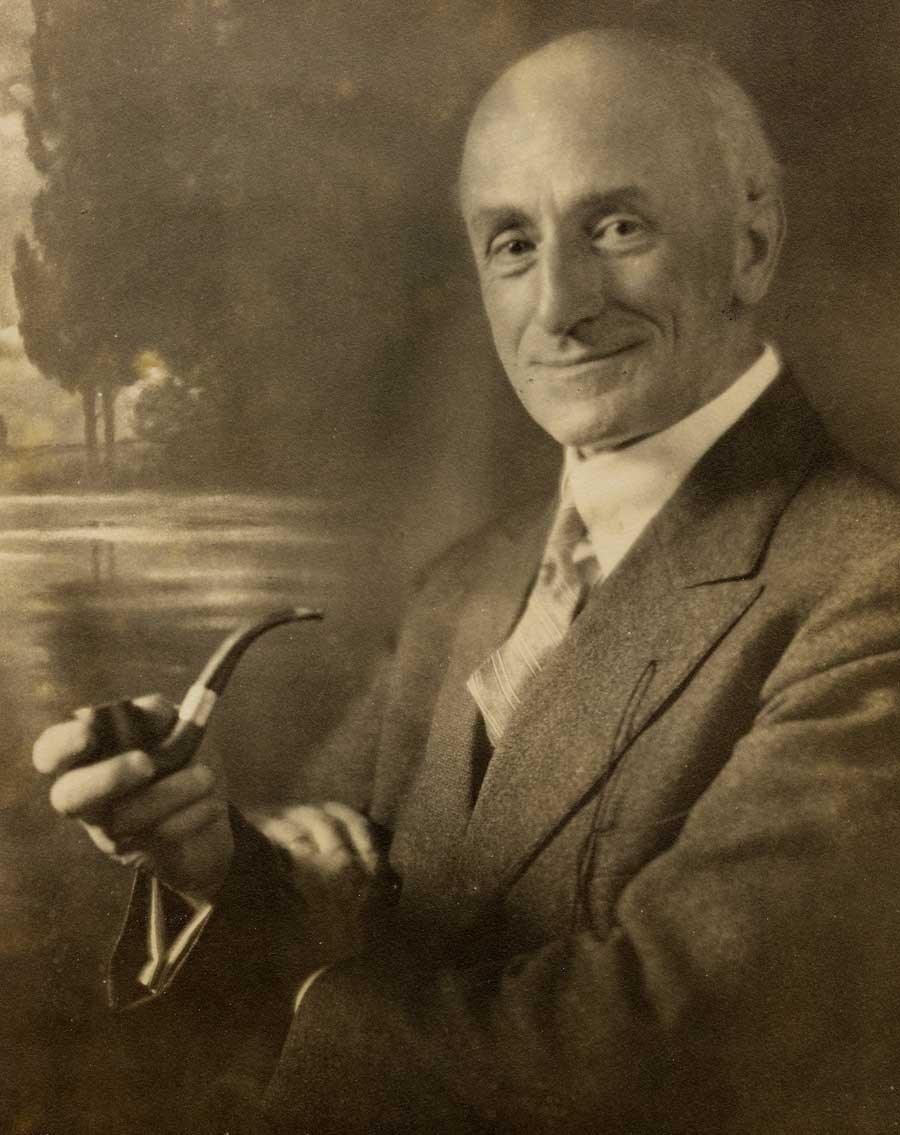 Detail: "Self-Portrait of Sigismund Blumann" (1872-1956) : American: gelatin silver print ca. 1930: Blumann was editor-in-chief of San Francisco-based Camera Craft magazine from 1924-1933: Photograph courtesy Thomas High
Detail: "Self-Portrait of Sigismund Blumann" (1872-1956) : American: gelatin silver print ca. 1930: Blumann was editor-in-chief of San Francisco-based Camera Craft magazine from 1924-1933: Photograph courtesy Thomas High
⌘ West Coast champion for photography in his role as Editor-in-Chief of Camera Craft magazine from 1924-1933. Prolific writer for said journal whose love of language sometimes lead to his mangling of it, but only with the best of intentions.
⌘ Significant pictorialist photographer from the same period and earlier whose darkroom work was equally inventive and important.
⌘ Poet.
⌘ So gregarious in affect, photographic historian Christian A. Peterson duly notes, (1.) that as editor, he personally answered all correspondence sent to him by his 8000 monthly Camera Craft readers in addition to his regular duties of penning multiple articles for each issue.
⌘ Possession of a sly sense of humor: look no further than a ca. 1930 self-portrait in which his suit lapel sprouts a long cable release rather than a floral boutonnière.
⌘ Conservative writer in print who often took a while to accept new ideas: as one example, Peterson notes his use of the made-up word “Sewereelism” included in a 1938 editorial written by him on his feelings towards the failings of the art movements Surrealism and Dada for the magazine Photo Art Monthly, a publication he owned himself. (2.)
⌘ Pipe smoker extraordinaire. Featured not only in the above referenced self-portrait but immortalized by artist W.R. Potter in print every month as artistic caricature shown smoking and reading a book used for his Under the Editor’s Lamp column in Camera Craft beginning in April 1926.
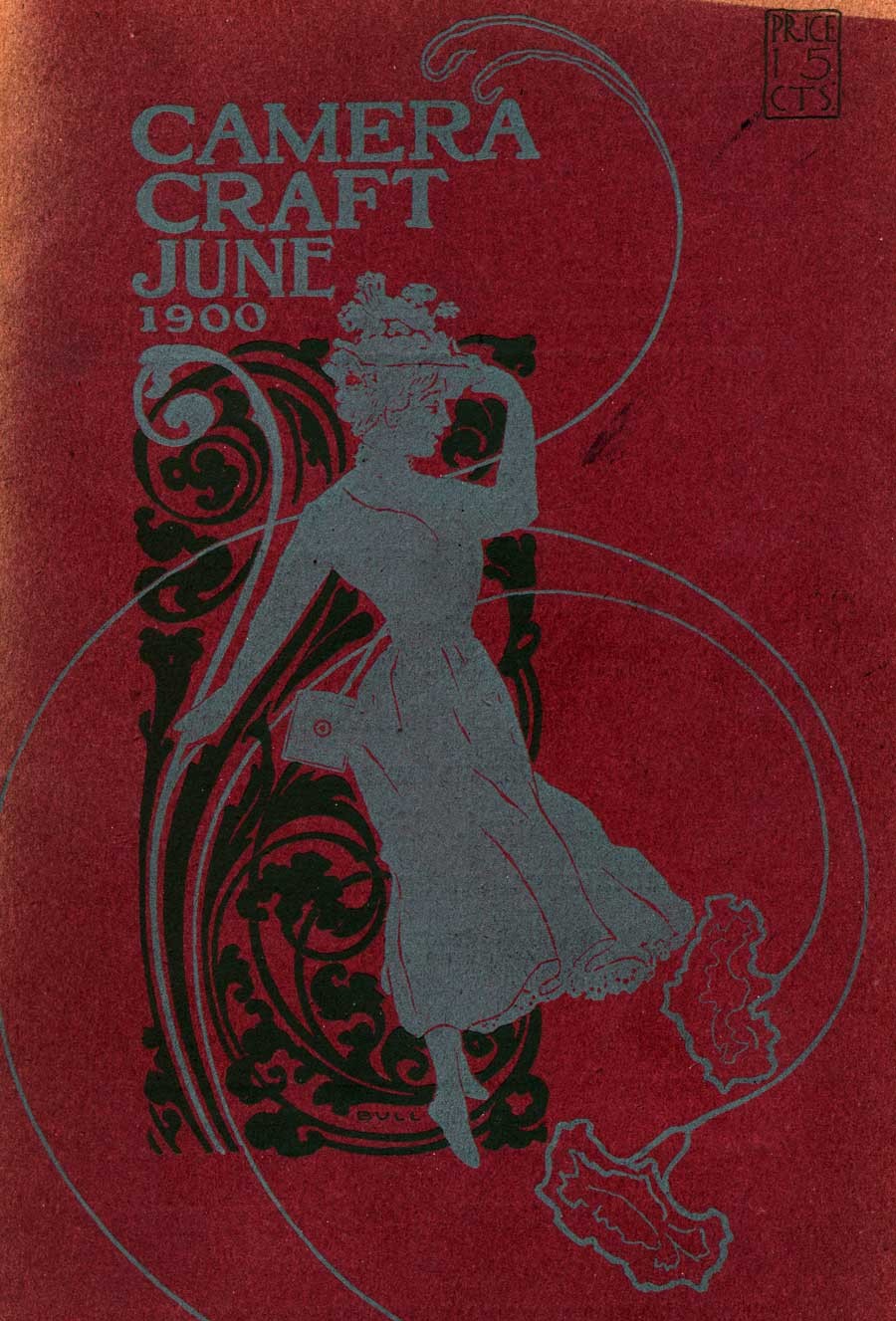 Detail: Cover Design: Camera Craft magazine: June, 1900: William Howell Bull: 1851-1940: American-California: 26.0 x 17.5 cm: two-color wood engraving : Sunset Press & Photo Engraving Company - San Francisco: cover price at upper right corner 15¢. Although this was the second issue of the magazine to appear, the first issue for May used the same cover design showing this stylish woman done in the Art-Nouveau style with small box camera slung on her side. From: PhotoSeed Archive
Detail: Cover Design: Camera Craft magazine: June, 1900: William Howell Bull: 1851-1940: American-California: 26.0 x 17.5 cm: two-color wood engraving : Sunset Press & Photo Engraving Company - San Francisco: cover price at upper right corner 15¢. Although this was the second issue of the magazine to appear, the first issue for May used the same cover design showing this stylish woman done in the Art-Nouveau style with small box camera slung on her side. From: PhotoSeed Archive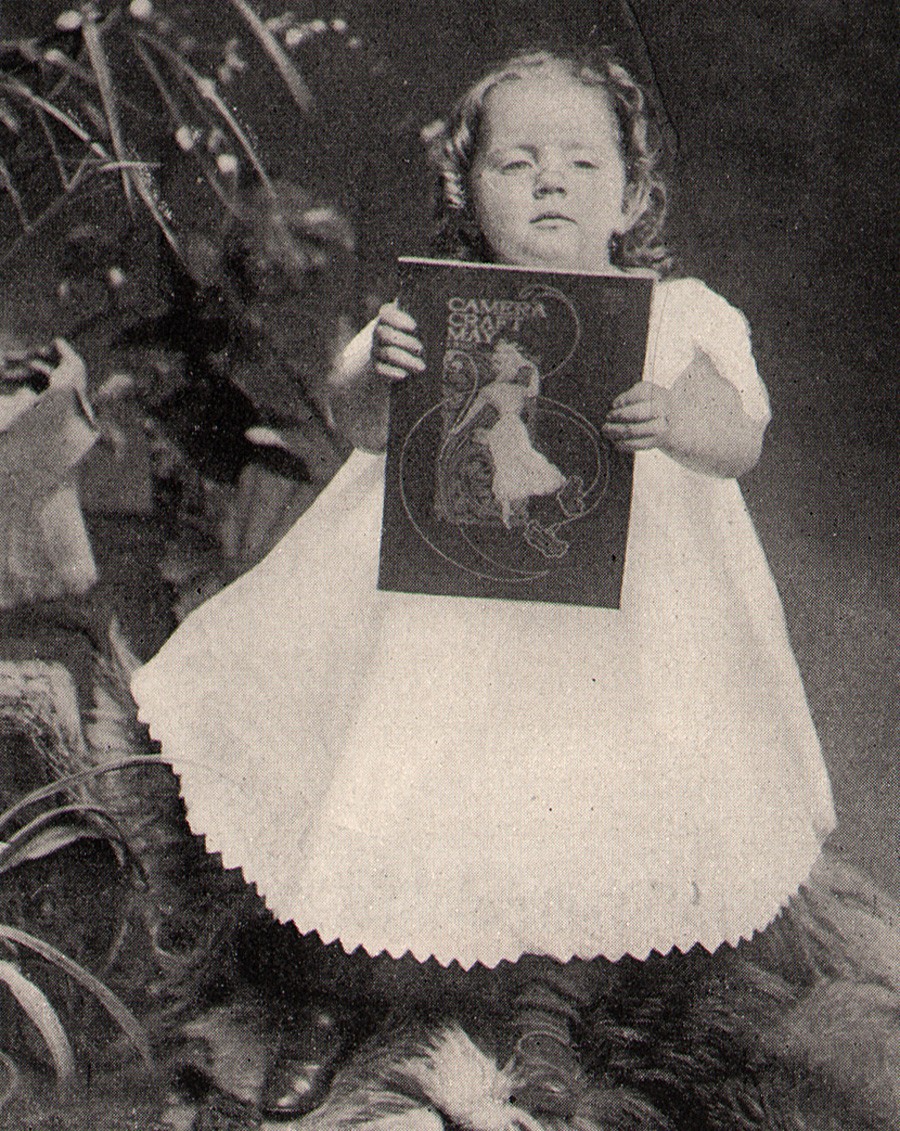 Detail: "Everyone Reads It": Mrs. C.S. Smith, American: Marysville (CA): halftone from June, 1900 Camera Craft magazine p. 57: 10.6 x 8.1 cm: A young girl holds up the very first issue of Camera Craft dated May, 1900. The design by California artist W.H. Bull was also used as the cover for June, 1900. From: PhotoSeed Archive
Detail: "Everyone Reads It": Mrs. C.S. Smith, American: Marysville (CA): halftone from June, 1900 Camera Craft magazine p. 57: 10.6 x 8.1 cm: A young girl holds up the very first issue of Camera Craft dated May, 1900. The design by California artist W.H. Bull was also used as the cover for June, 1900. From: PhotoSeed Archive
Sigismund Blumann: Short Biography
For the past three years, I’ve had the distinct pleasure of corresponding with Thomas High, Sigismund Blumann’s grandson, and been equally fortunate in acquiring a small archive of Sig’s vintage work for PhotoSeed previously kept in the family. Unlike Sig’s friends, Tom tells me, as a boy of perhaps five or six, he would of course address him as Grampa Blumann. Tom goes on to say:
”I only wish I had known him better – he died when I was a child, and my only real memories of him were playing rummy and whist with him.”
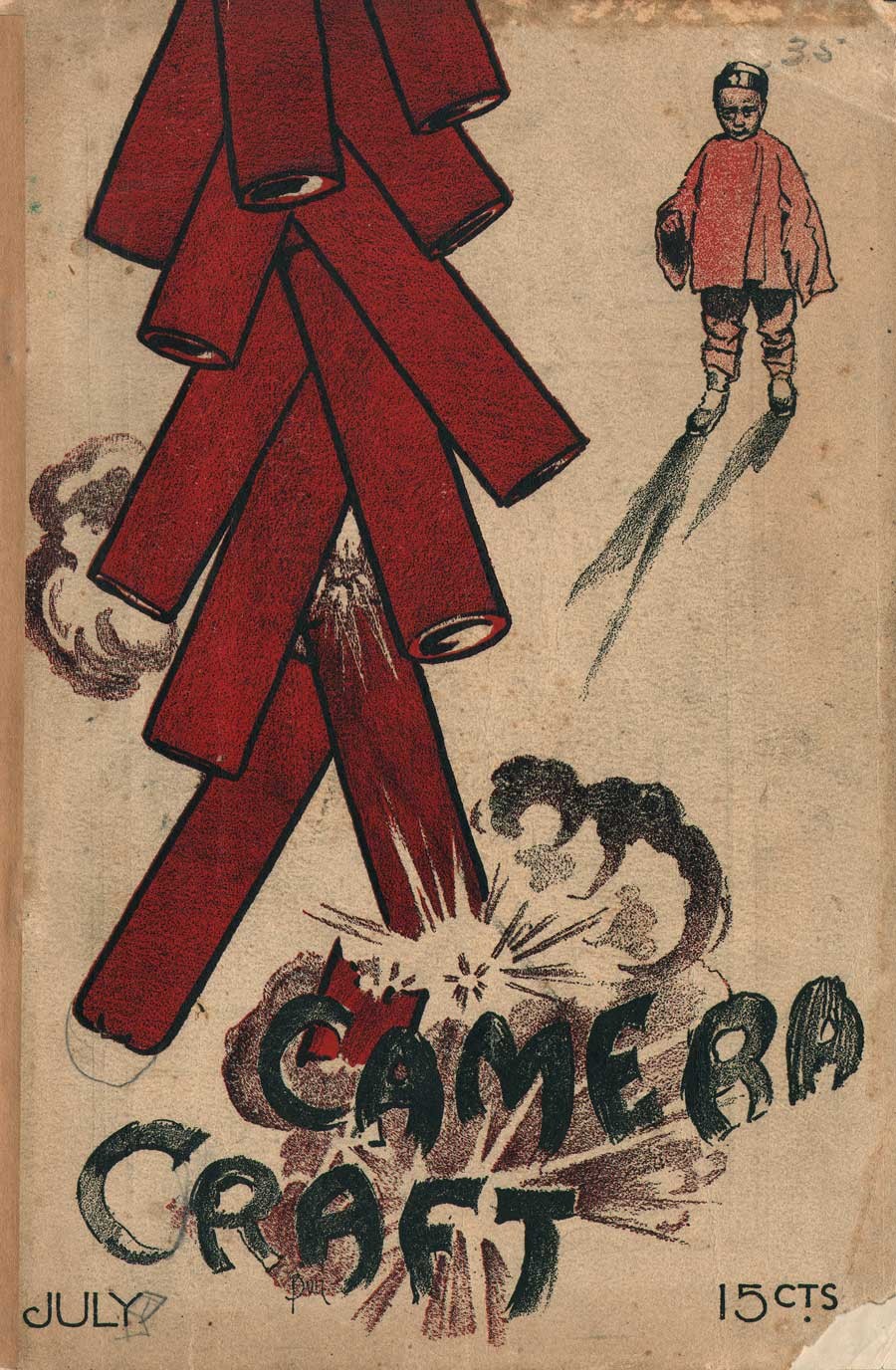 Cover Design: Chinese Firecrackers: Camera Craft magazine: July, 1900: William Howell Bull: 1851-1940: American-California: 26.0 x 17.5 cm: two-color wood engraving : Sunset Press & Photo Engraving Company - San Francisco: cover price at lower right corner 15¢. From: PhotoSeed Archive
Cover Design: Chinese Firecrackers: Camera Craft magazine: July, 1900: William Howell Bull: 1851-1940: American-California: 26.0 x 17.5 cm: two-color wood engraving : Sunset Press & Photo Engraving Company - San Francisco: cover price at lower right corner 15¢. From: PhotoSeed ArchiveTom has also agreed to let me reprint for purposes of introduction the following short biography of his grandfather written in October, 2009, for which I’m very grateful.
Sigismund Blumann (1872-1956) by Thomas High
Sigismund Blumann was born on September 13, 1872, in New York City, the son of Alexander Blumann and Rosalie (Price) Blumann. He came to San Francisco with his parents in late 1881 or 1882, and subsequently became a professional pianist and music teacher.
Sigismund Blumann married first on August 30, 1894, to Adele Morgenstern. They divorced in May of 1895. He married second on June 4, 1901, to Hilda Axelina Johansson and they subsequently had four daughters, Ethel, Amy, Lorna, and Vera.
In the 1890s, Sigismund Blumann became interested in photography and had begun taking photos seriously by 1900 while living in San Francisco. At the time of the San Francisco earthquake on April 9, 1906, he and his wife were still living with his parents on Army Street. He volunteered to help the recovery and, with his official permits, got through the lines and took a number of photographs.
Mr. Blumann was also a prolific writer and he authored numerous articles, commentaries, and poems.
After the 1906 earthquake, the Blumanns moved to Davis Street in Fruitvale (later part of Oakland). From that time, all of his photographic work was done in his darkroom at the Davis Street home.
Photography increased in importance in his life, and at the 1915 Panama-Pacific International Exposition he combined all of his talents: he played in an orchestra, photographed the Fair, and worked as a correspondent for the New York Tribune and other newspapers.
In the early 1920s, Sigismund retired from an active career in music and entered the profession of efficiency engineering, with offices in the Monadnock Building in San Francisco. His principal client was the Forster Music Publishing Company.
He continued his interest in photography and in 1924 he became editor of Camera Craft magazine. In addition to editing the publication and writing numerous articles for it, he also wrote the Photographic Workroom Handbook, published by Camera Craft in 1927.
Mr. Blumann’s last issue as editor of Camera Craft was in August of 1933. Several months later, he launched his own magazine, Photo Art Monthly, which he edited and published until 1940. During this period, he also produced several more manuals for amateur photographers, including the Photographic Handbook, Photographic Greetings - How to Make Them, Enlarging Manual, and Toning Processes.
In 1940, he sold the Photo Art Monthly to his assistant, Franke Unger (who married photographer Adolf Fassbender about the same time). She soon closed the magazine.
The Blumanns continued to live at their Davis Street home for the rest of their lives, joined by their unmarried daughters, Ethel and Lorna Blumann, both librarians. He produced little photographic work in the 1940s and 1950s, contenting himself to dabble in photography and discuss it with his new son-in-law, William A. High, who married his daughter, Vera, in February of 1943. Bill High was a commercial photographer before World War II, a combat photographer for the US Army during the war, and the founder of the photography department at Oakland’s Laney Trade School (later Peralta Junior College) thereafter.
Sigismund Blumann died in Oakland on July 9, 1956, and Hilda Blumann died on February 1, 1958, also in Oakland.
Sigismund Blumann’s photos are in the Oakland Museum, Minneapolis Institute of Art, High Museum in Atlanta, and elsewhere.
For further information, see “Sigismund Blumann, California Editor and Photographer,” by Christian A. Peterson, in History of Photography, vol. 26, no. 1. (Spring 2002).
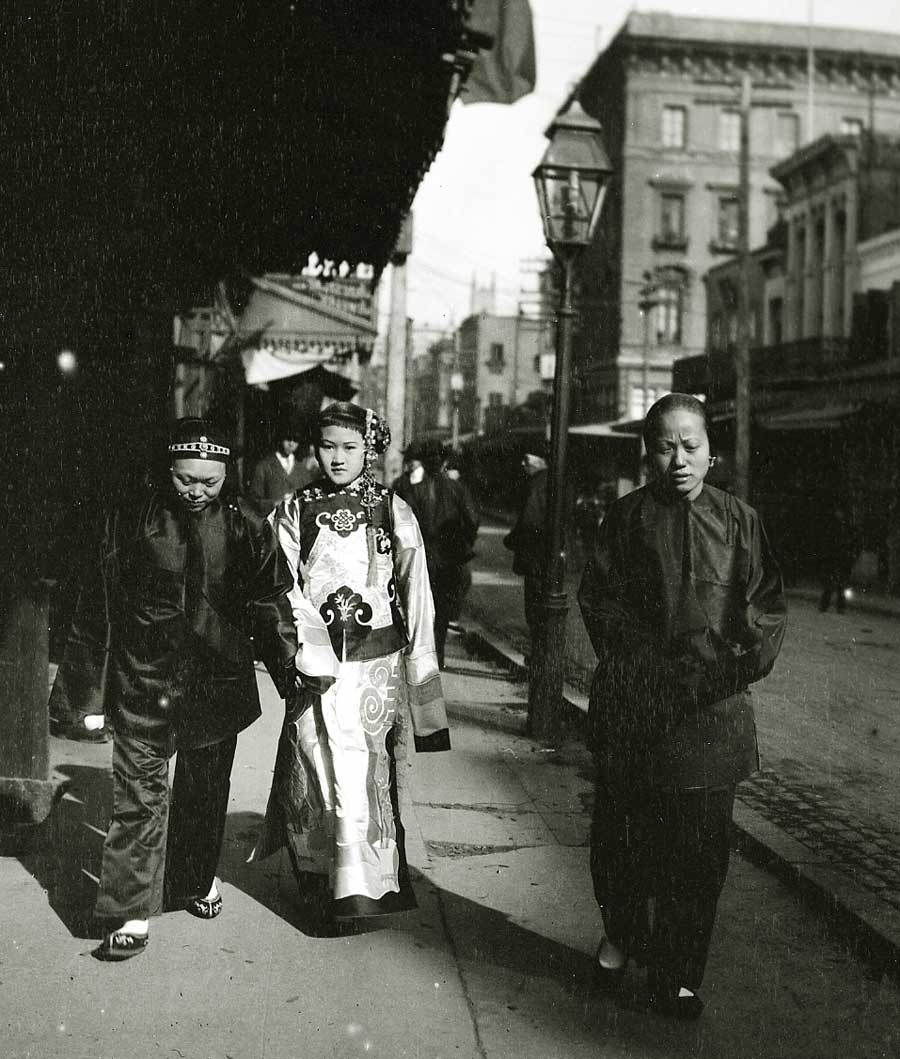 Detail: "Highborn Lady With Duenna": Sigismund Blumann: American: ca. 1901: This view is from a collection of at least 43 documentary photographs, with several corresponding paper negative envelopes dated 1901 by Blumann donated by his family to the California Historical Society. They can be viewed there as part of the collection “The Chinese in California: 1850-1925.” Photograph courtesy Thomas High
Detail: "Highborn Lady With Duenna": Sigismund Blumann: American: ca. 1901: This view is from a collection of at least 43 documentary photographs, with several corresponding paper negative envelopes dated 1901 by Blumann donated by his family to the California Historical Society. They can be viewed there as part of the collection “The Chinese in California: 1850-1925.” Photograph courtesy Thomas High
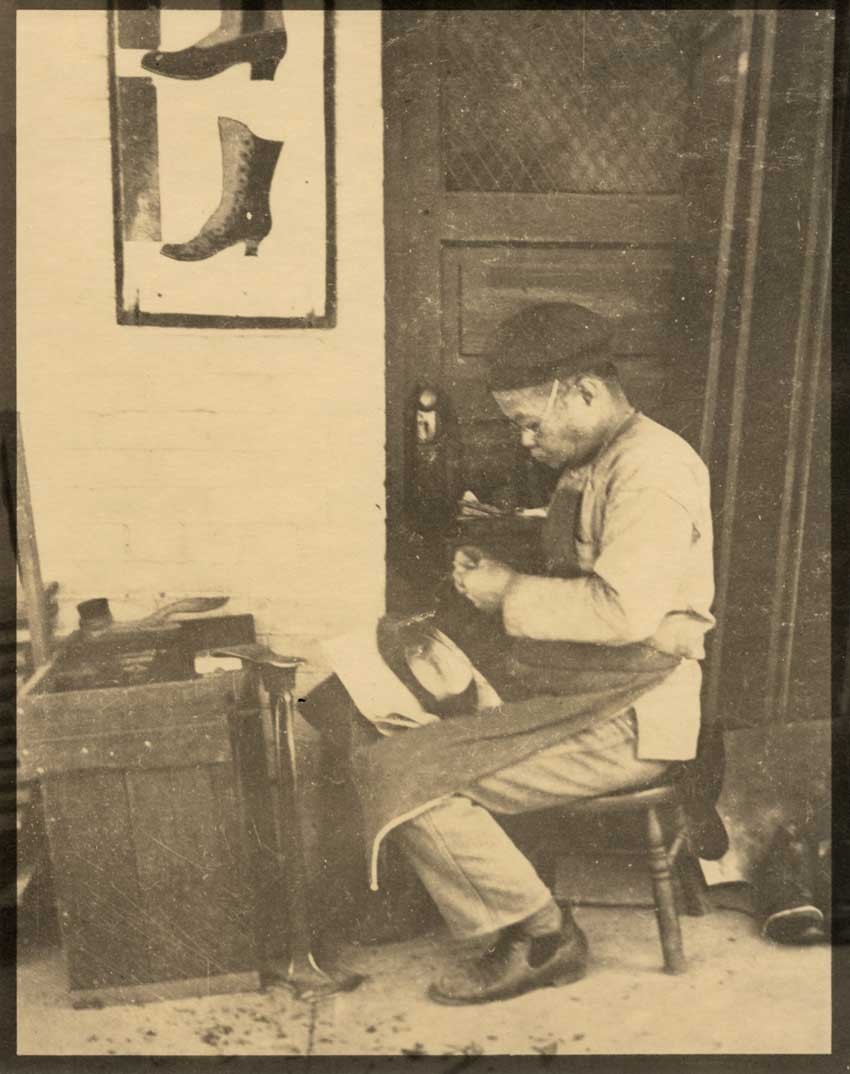 "Chinese Cobbler": San Francisco Chinatown: Sigismund Blumann: American: ca. 1901, printed early 1920s: gelatin silver print- app. 8 7/8 x 7.0": variant: "Shoe Mender": from California Historical Society collection: FN-34374: Photograph courtesy Thomas High
"Chinese Cobbler": San Francisco Chinatown: Sigismund Blumann: American: ca. 1901, printed early 1920s: gelatin silver print- app. 8 7/8 x 7.0": variant: "Shoe Mender": from California Historical Society collection: FN-34374: Photograph courtesy Thomas High
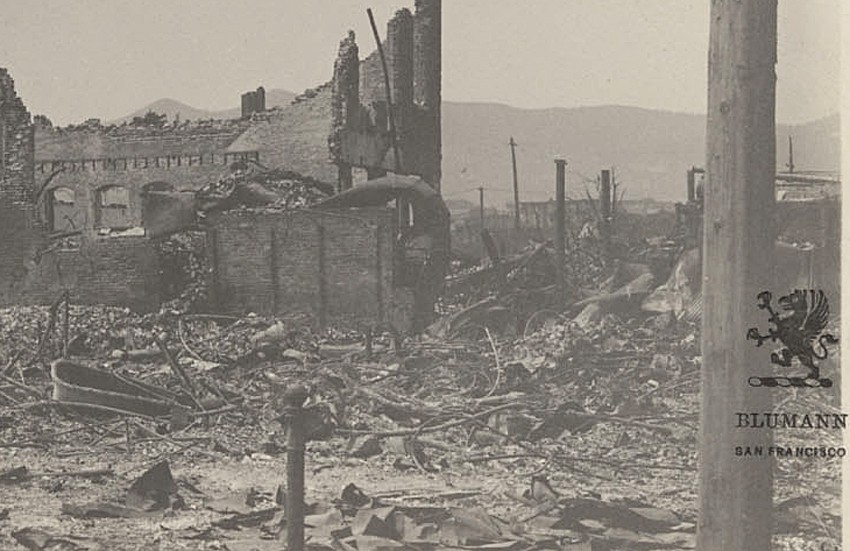 Detail: "Ruins" (San Francisco Earthquake): Sigismund Blumann: American: ca. 1906: gelatin silver print: 13.0 x 18.0 cm: overprinted with Blumann's winged griffin monogram at lower right: Photograph courtesy: California Historical Society: The 1906 San Francisco Earthquake and Fire Digital Collection: Local Call # FN-33293
Detail: "Ruins" (San Francisco Earthquake): Sigismund Blumann: American: ca. 1906: gelatin silver print: 13.0 x 18.0 cm: overprinted with Blumann's winged griffin monogram at lower right: Photograph courtesy: California Historical Society: The 1906 San Francisco Earthquake and Fire Digital Collection: Local Call # FN-33293
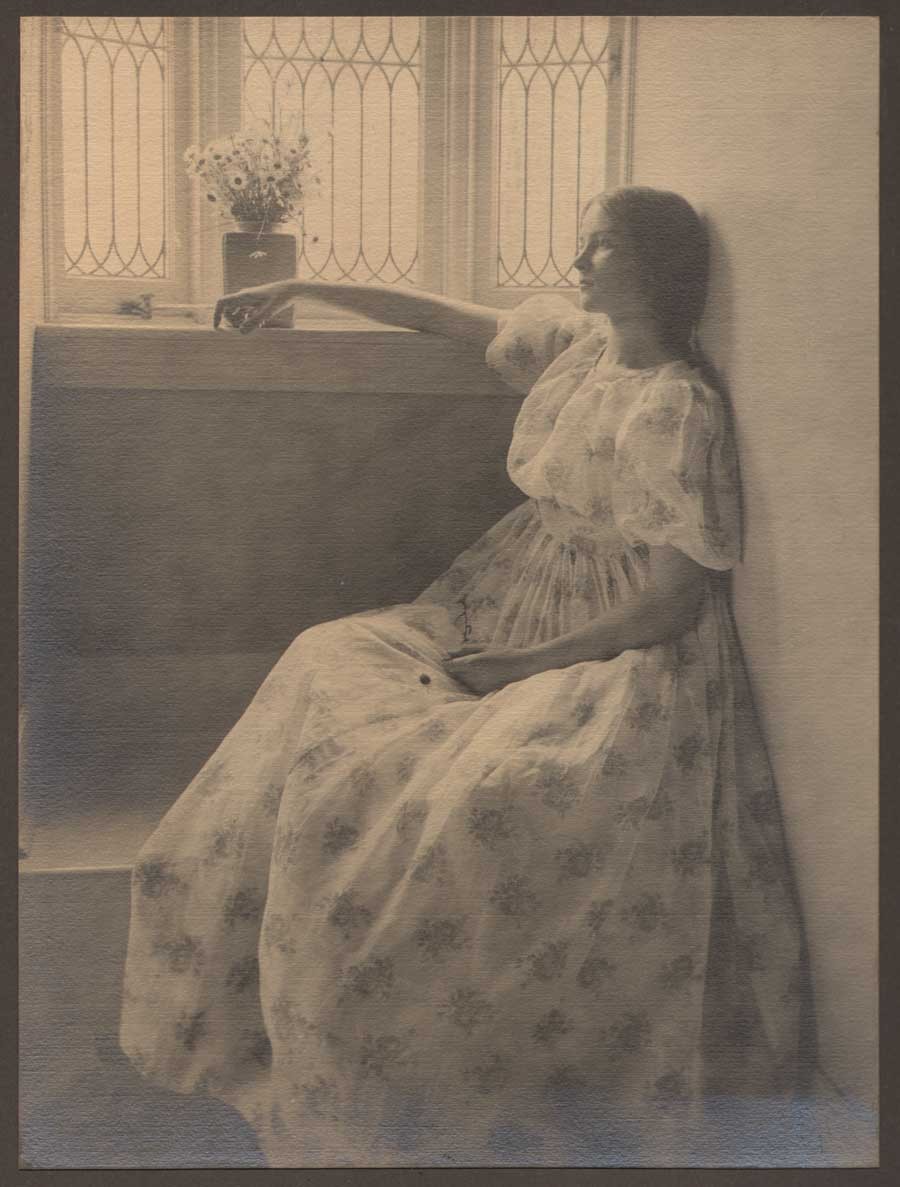 "Day Dreams" : Charles Rollins Tucker 1868-1956: American: gelatin silver print: June, 1906 printed 1915: 27.3 x 20.4 | 43.2 x 35.5 cm : First titled "Study in Home Portraiture" and published full page in the Oct. 1906 Photographic Times, this interior study later appeared as a full-page halftone in the July, 1907 Camera Craft magazine, and is a representative example of the pictorialist work that regularly appeared in its pages. Coincidentally, imagery like this was also gaining popularity during this time among amateur and professional photographers, and Sigismund Blumann was no exception, teaming up with fellow photographer Jacques Tillmany in 1907 on a part-time basis offering in-home photographic portraiture. From: PhotoSeed Archive
"Day Dreams" : Charles Rollins Tucker 1868-1956: American: gelatin silver print: June, 1906 printed 1915: 27.3 x 20.4 | 43.2 x 35.5 cm : First titled "Study in Home Portraiture" and published full page in the Oct. 1906 Photographic Times, this interior study later appeared as a full-page halftone in the July, 1907 Camera Craft magazine, and is a representative example of the pictorialist work that regularly appeared in its pages. Coincidentally, imagery like this was also gaining popularity during this time among amateur and professional photographers, and Sigismund Blumann was no exception, teaming up with fellow photographer Jacques Tillmany in 1907 on a part-time basis offering in-home photographic portraiture. From: PhotoSeed Archive
Beginnings in Word and Photography
Writing under his infrequent pen name Charles H. Fitzpatrick in Camera Craft in 1925, (3.) Sig most likely gives us a small hint of his own beginnings in photography, a passion that would soon evolve into his extensive documentation of life of San Francisco’s bustling Chinatown neighborhood in 1901. (4.) Later in this capacity as street shooter, he played the role of documentarian in the aftermath of the destruction of San Francisco in the 1906 earthquake and subsequent job as part-time portrait photographer after relocating to neighboring Oakland in 1907 due to the destruction. (5.) all while making his living as musical performer and teacher) :
Having become interested in Photography back in 1900 as an amateur with an old style Adlake plate camera, and two years later as a professional with a studio— and almost continuously since in Commercial Photography the author has had a wonderful opportunity to study composition both by experience and observation of the work of others. (6.)
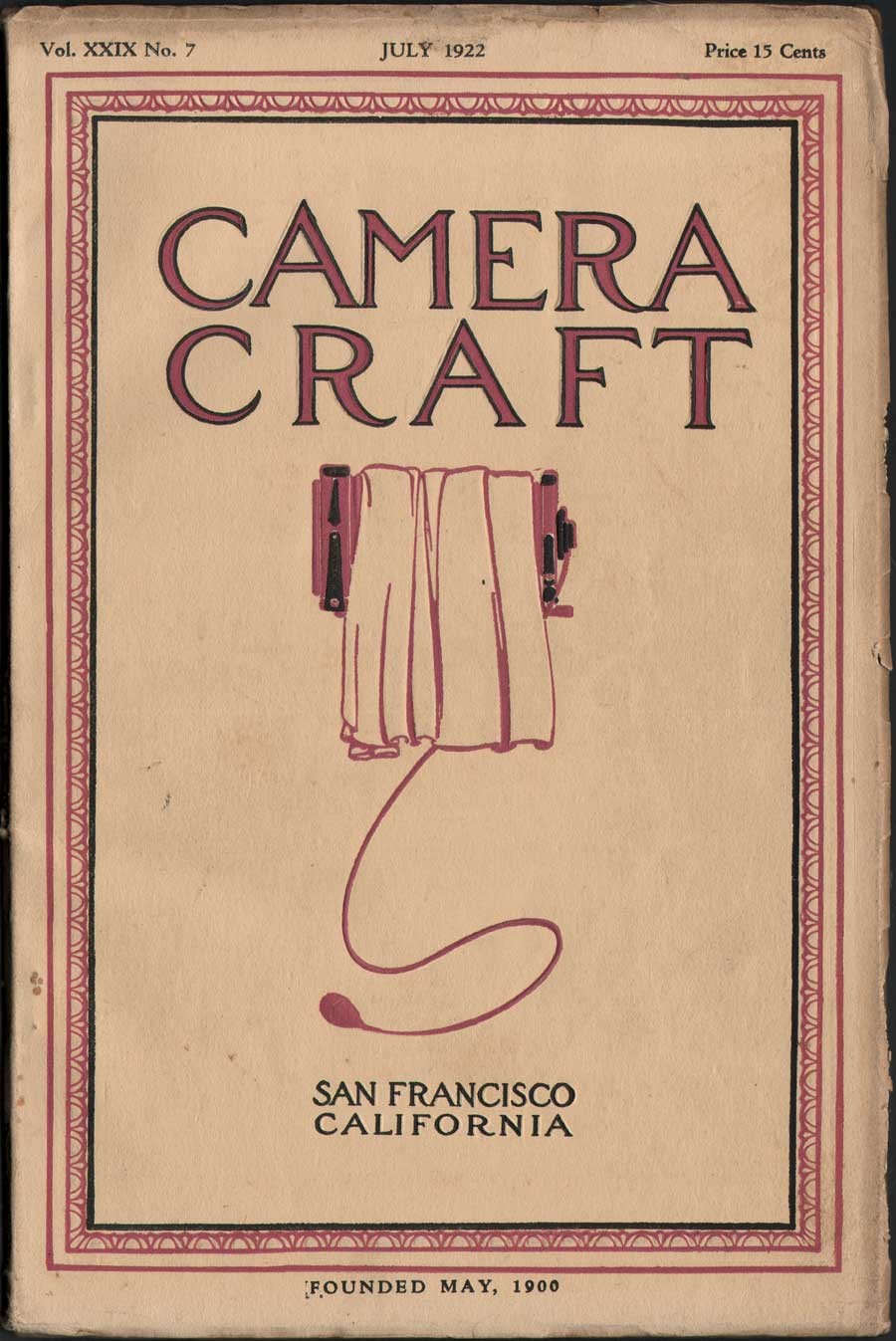 Cover Design: Camera Craft magazine: San Francisco, CA: July, 1922: 26.5 x 17.5 cm: two-color wood engraving : unknown artist and printer: cover price at upper right corner 15¢. This uncredited Camera Craft cover design first debuted with the January 1913 issue and featured a simple design of a plate camera shown in profile(lens board on right side) with dark cloth draped at center and bulb shutter release cable hanging down. This design lasted through the June, 1923 issue and was replaced with illustrations of architectural landmarks, notable western scenery and other thematic drawings done by San Francisco artist W.R. Potter through the September, 1924 issue. From: PhotoSeed Archive
Cover Design: Camera Craft magazine: San Francisco, CA: July, 1922: 26.5 x 17.5 cm: two-color wood engraving : unknown artist and printer: cover price at upper right corner 15¢. This uncredited Camera Craft cover design first debuted with the January 1913 issue and featured a simple design of a plate camera shown in profile(lens board on right side) with dark cloth draped at center and bulb shutter release cable hanging down. This design lasted through the June, 1923 issue and was replaced with illustrations of architectural landmarks, notable western scenery and other thematic drawings done by San Francisco artist W.R. Potter through the September, 1924 issue. From: PhotoSeed Archive
It was sometime in the 1890s, photographic historian Christian A. Peterson notes, that he “first used his wife’s Kodak camera to make snapshots and soon began searching the photographic periodicals for information and advice.” (7.) His editorship of Camera Craft as momentous professional occasion aside, Sig’s immersion in all things Photographic may very well have reached a high-point by 1933, the year he became a charter member of the Photographic Society of America as well as being honored a Fellow of the Royal Photographic Society.
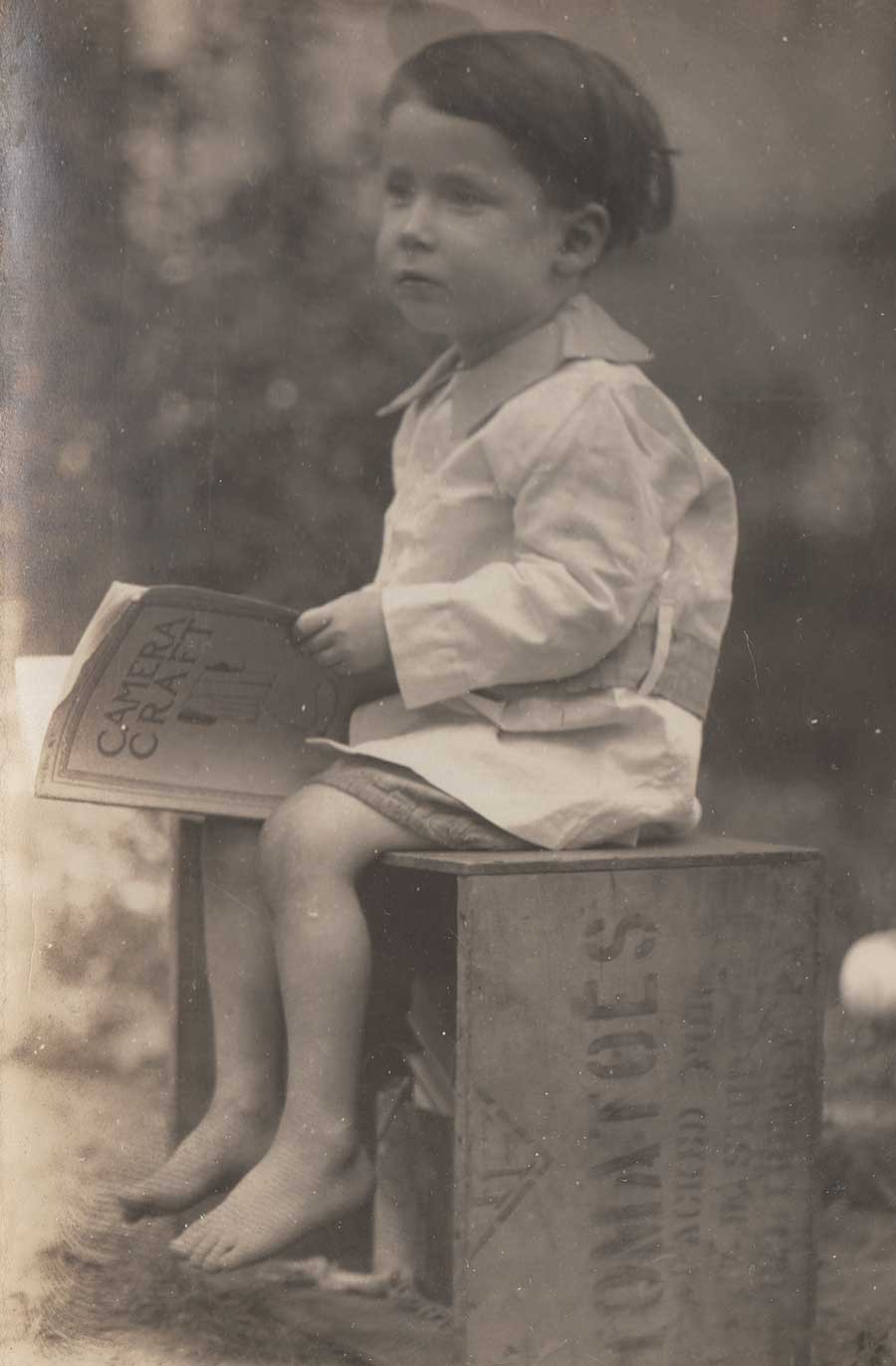 Detail: "Child Sitting on Tomato Crate Holding Camera Craft Magazine": by anonymous American photographer printed as unmailed postcard: gelatin silver print ca. 1920-25: 11.6 x 8.8 | 13.8 x 8.8 cm: written in graphite on verso: "with Love. Ellsworth" with the name "Walter" opposite address field. Child sits on crate stenciled on side as being from Pennsylvania-indicated "Packed For….PA " on side, with photo purchased from Parma, MI collector. From: PhotoSeed Archive
Detail: "Child Sitting on Tomato Crate Holding Camera Craft Magazine": by anonymous American photographer printed as unmailed postcard: gelatin silver print ca. 1920-25: 11.6 x 8.8 | 13.8 x 8.8 cm: written in graphite on verso: "with Love. Ellsworth" with the name "Walter" opposite address field. Child sits on crate stenciled on side as being from Pennsylvania-indicated "Packed For….PA " on side, with photo purchased from Parma, MI collector. From: PhotoSeed Archive
Photography in itself however was not his only reason for being during his professional career as editor, and even earlier as a musician. This was because Sig was a romantic at heart, a dreamer who had a great fondness for language, and the will to commit it to paper. Starting out for example, only in his early 20’s, he composed the following poem for the April, 1895 issue of the California-based magazine Overland Monthly:
PLEASURE.
PLEASURE is like perfect liquor,
Sweet to taste and after taste,
And like, too, in that when gotten
We imbibe too much, then waste,
And we find when pleasure passes
Life is empty as the glasses.
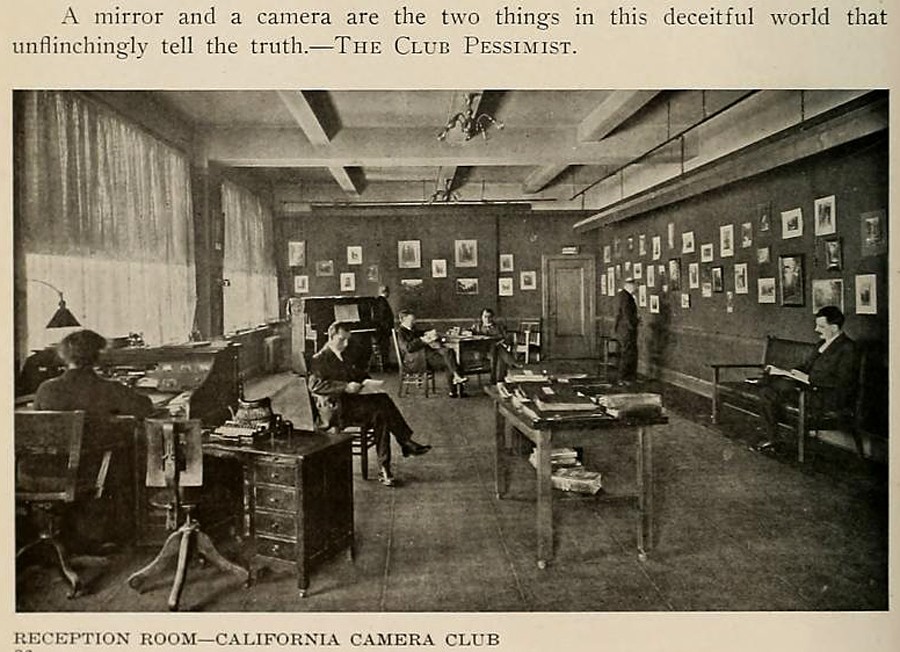 "Reception Room— California Camera Club": 1914: taken by an unknown photographer, this image appeared as a halftone illustration in the February, 1914 issue of Camera Craft for a story on the club, founded in 1890. At the time this appeared the club was located at 833 Market Street in San Francisco. The scene shows members seated with an exhibit of photographs on display at rear and on wall at right. Camera Craft regularly featured news of this important club, and future editor of the magazine Sigismund Blumann, although not a member, attended and was an occasional speaker. Photographic historian Christian A. Peterson notes Blumann spoke at this club in 1916 and much later, between 1934-40 attended gatherings here as well as at the Leica Club of Oakland, East Bay Camera Club, Golden Gate Miniature Camera Club, Photographic Society of San Francisco, San Jose Camera Club, and Western Amateur Camera Conclave. From: California State Library: Archive.org
"Reception Room— California Camera Club": 1914: taken by an unknown photographer, this image appeared as a halftone illustration in the February, 1914 issue of Camera Craft for a story on the club, founded in 1890. At the time this appeared the club was located at 833 Market Street in San Francisco. The scene shows members seated with an exhibit of photographs on display at rear and on wall at right. Camera Craft regularly featured news of this important club, and future editor of the magazine Sigismund Blumann, although not a member, attended and was an occasional speaker. Photographic historian Christian A. Peterson notes Blumann spoke at this club in 1916 and much later, between 1934-40 attended gatherings here as well as at the Leica Club of Oakland, East Bay Camera Club, Golden Gate Miniature Camera Club, Photographic Society of San Francisco, San Jose Camera Club, and Western Amateur Camera Conclave. From: California State Library: Archive.org
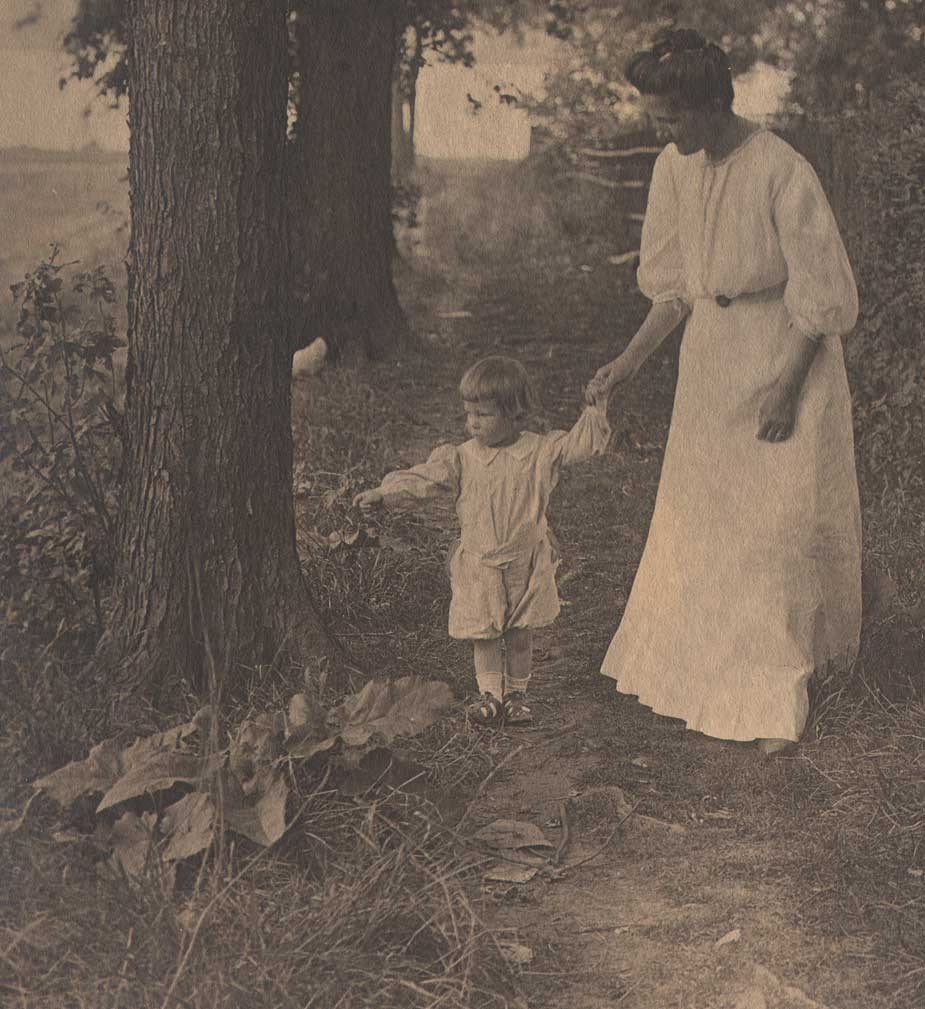 Detail: "Up the Path": Chester Moulton Whitney: American, b. 1873: 1914 or earlier: gelatin silver print: 24.8 x 19.3 cm: This photograph was illustrated as a full-page halftone with printed ornamental Art-Nouveau frame border in the August, 1914 Camera Craft, p. 422, and is a representative example of the pictorialist work that regularly appeared in its pages. From: PhotoSeed Archive
Detail: "Up the Path": Chester Moulton Whitney: American, b. 1873: 1914 or earlier: gelatin silver print: 24.8 x 19.3 cm: This photograph was illustrated as a full-page halftone with printed ornamental Art-Nouveau frame border in the August, 1914 Camera Craft, p. 422, and is a representative example of the pictorialist work that regularly appeared in its pages. From: PhotoSeed Archive
Wearing the hat of Poet-in-Residence at Camera Craft, Sig never neglected this early love of poetry for the publication, often combining his own photographic efforts alongside original compositions. One example, which he titled Lugubrio, though technically not even a real word, appeared in April, 1927, and was his way of simply assigning a mournful, or lugubrious meaning to his own photograph depicting jagged rocks and crashing waves-seen in his dramatic coastal landscape most likely taken on the Pacific coast:
LUGUBRIO
By Sigismund Blumann
The drowned and dead, now turned to stone,
Stand watching by the shore
And you may hear them through the night,
From set of sun to morning light,
As they shall do for evermore,
Weep as they watch, and moan. (p. 177)
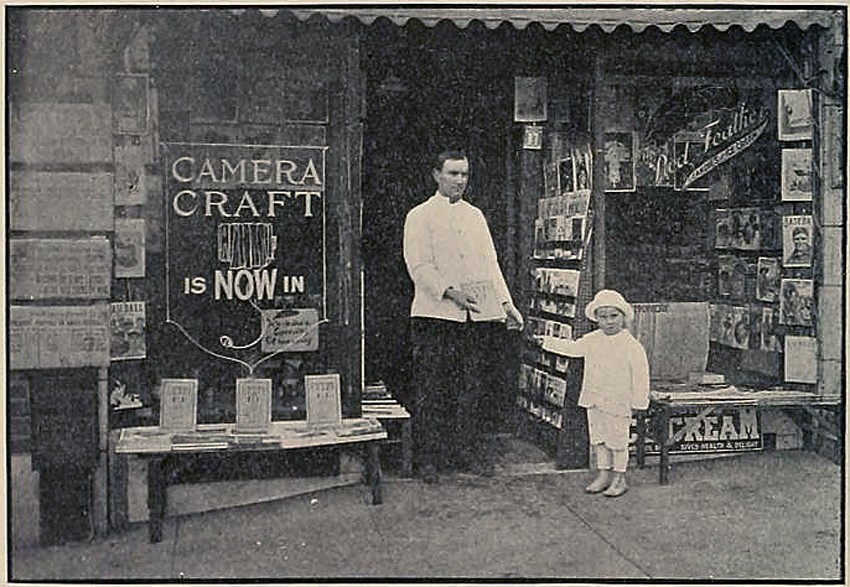 "Camera Craft is Now In": 1914: taken by an unknown photographer and used as a form of soft advertising, this image appeared as a halftone illustration in the June, 1917 issue of Camera Craft. It shows San Francisco business owner J.F. Brandert, owner of the Red Feather Store at 435 Jones Street, handing off a copy of the journal to a young visitor, with a display of three issues propped up on a bench at left in front of a window lettered with a graphic of the journal's cover: "CAMERA CRAFT IS NOW IN". From: California State Library: Archive.org
"Camera Craft is Now In": 1914: taken by an unknown photographer and used as a form of soft advertising, this image appeared as a halftone illustration in the June, 1917 issue of Camera Craft. It shows San Francisco business owner J.F. Brandert, owner of the Red Feather Store at 435 Jones Street, handing off a copy of the journal to a young visitor, with a display of three issues propped up on a bench at left in front of a window lettered with a graphic of the journal's cover: "CAMERA CRAFT IS NOW IN". From: California State Library: Archive.org
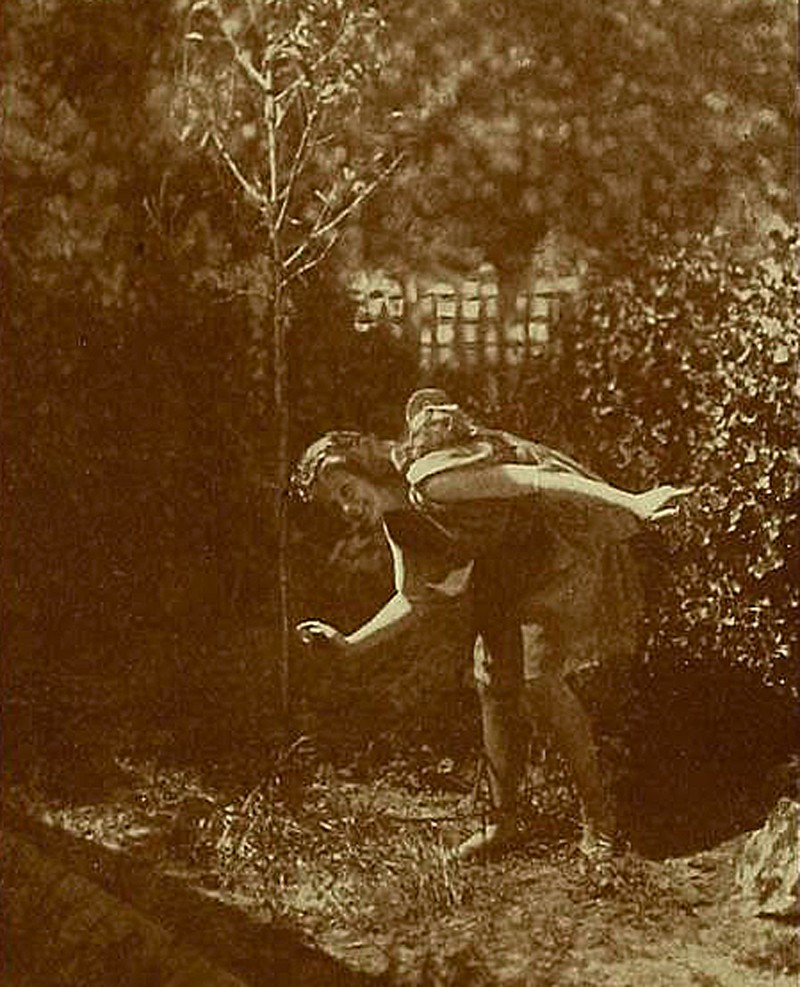 "When From Behind the Moondipt Bush Titania Floated in a Silver Haze": 1917 or before: Sigismund Blumann, American: This photograph was used as the frontis halftone for the July, 1917 issue of Camera Craft helping to illustrate the article "Poetry and Photography" written by Blumann. The photo shows Vera Hahn, a childhood friend of his eldest daughter Ethel Blumann. (b. 1902) He said of the photo: "She was costumed for a pageant and we all wanted a memento of the charming vision she made in our garden, among the green plants." This early example of Blumann's work also included one of his original poems titled "To Childhood": the first stanza: "Oh blessed youth! When from the enchanted page | Fancy stepped forth and made the unreal real, | When from behind the moondipt bush | Titania floated in a silver haze and greeted me! From: California State Library: Archive.org
"When From Behind the Moondipt Bush Titania Floated in a Silver Haze": 1917 or before: Sigismund Blumann, American: This photograph was used as the frontis halftone for the July, 1917 issue of Camera Craft helping to illustrate the article "Poetry and Photography" written by Blumann. The photo shows Vera Hahn, a childhood friend of his eldest daughter Ethel Blumann. (b. 1902) He said of the photo: "She was costumed for a pageant and we all wanted a memento of the charming vision she made in our garden, among the green plants." This early example of Blumann's work also included one of his original poems titled "To Childhood": the first stanza: "Oh blessed youth! When from the enchanted page | Fancy stepped forth and made the unreal real, | When from behind the moondipt bush | Titania floated in a silver haze and greeted me! From: California State Library: Archive.org
Camera Craft: Western Photographic Journal
Although he’d been a contributor to its’ pages in words and photos after the first decade of being founded, it would be 24 years from the journal’s 1900 founding until Sig would begin to establish an enduring legacy in the history of photography via his role as Editor-in-Chief of Camera Craft. Some historical background on the intents and purposes for this ground-breaking publication are in order.
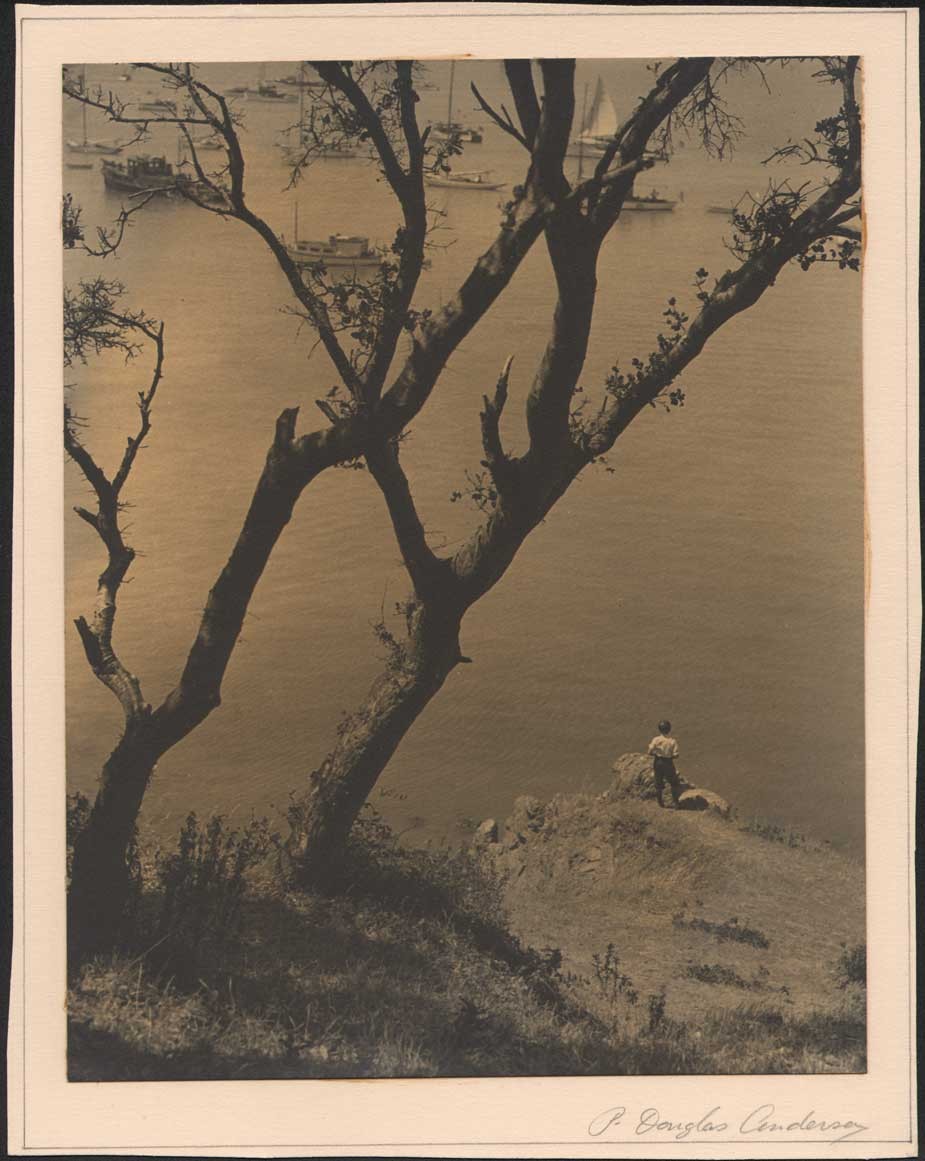 "Boy Looking out onto Bay" (San Francisco?-title supplied by this archive): ca. 1920-25: Paul Douglas Anderson, American 1887-1964: toned bromide or gelatin silver print: 24.2 x 19.0 | 27.5 x 21.6 cm: P. Douglas Anderson was an associate editor of Camera Craft beginning in May, 1923 & became editor-in-chief by January, 1924, continuing through the July issue. He was replaced by Sigismund Blumann the following month. Active in photography between 1910-1940's, Anderson was a member of the Camera Pictorialists of Los Angeles and Pictorial Photographers of America. From: PhotoSeed Archive
"Boy Looking out onto Bay" (San Francisco?-title supplied by this archive): ca. 1920-25: Paul Douglas Anderson, American 1887-1964: toned bromide or gelatin silver print: 24.2 x 19.0 | 27.5 x 21.6 cm: P. Douglas Anderson was an associate editor of Camera Craft beginning in May, 1923 & became editor-in-chief by January, 1924, continuing through the July issue. He was replaced by Sigismund Blumann the following month. Active in photography between 1910-1940's, Anderson was a member of the Camera Pictorialists of Los Angeles and Pictorial Photographers of America. From: PhotoSeed Archive
First based in San Francisco at 120 Sutter Street and issued monthly by the Camera Craft Publishing Company under the direction of editor W.G. Woods, the photographic journal Camera Craft was founded on the principles the West Coast of the United States should have an equal geographical mouthpiece of influence to counter that of the East Coast in promoting photography-for both professional and amateur workers. (to this end a separate page was devoted monthly to the happenings of many California amateur clubs) For the first issue of May, 1900, the following observations and arguments were made by the journal in support of these ideals:
The growth of photography, the introduction of simplifying methods in scientific picture-making, during the past twenty-five years is one of the wonders of the century. The phenomenal strides made by the photographic inventors of the world, resulting in the production of simple devices and convenient appliances, have made photography in all of its branches an almost universal fad. The Pacific Coast, ever ready to appreciate the merits of an innovation, has kept well abreast in the steady march of progress.
The wonderful climate of California lends itself enthusiastically to the wants of the photographer. The hand of Nature has reared, in eternal beauty, scenic effects unequaled elsewhere on earth. The very atmosphere of the Far West encourages the artistic impulse of its people. With such great natural advantages it is small wonder that when the western photographer has seen fit to cross the continent to compete with the eastern brotherhood he returns with laurels upon his brow. Not less wonderful is the existence of the largest Camera Club in the world in the city of the Golden Gate.
Yet, strange as it may seem, this great class of enthusiasts, this immense body of earnest workers has never been represented by a publication worthy of its trust. The photographers of the West have for years depended upon the journals of the East for enlightenment, but have looked in vain for recognition in their columns. It is to remedy this condition that Camera Craft now makes its bow to the public.
As to the scope of Camera Craft nothing can be said; it will have to speak for itself. The only promise made is the sincere intent on the part of the publishers to improve with each succeeding issue. The one hope of the magazine is that it may be so conducted as to meet the approbation of its readers and lend its aid to the material welfare of all interested in photography, whether for pleasure or for profit. (p. 26)
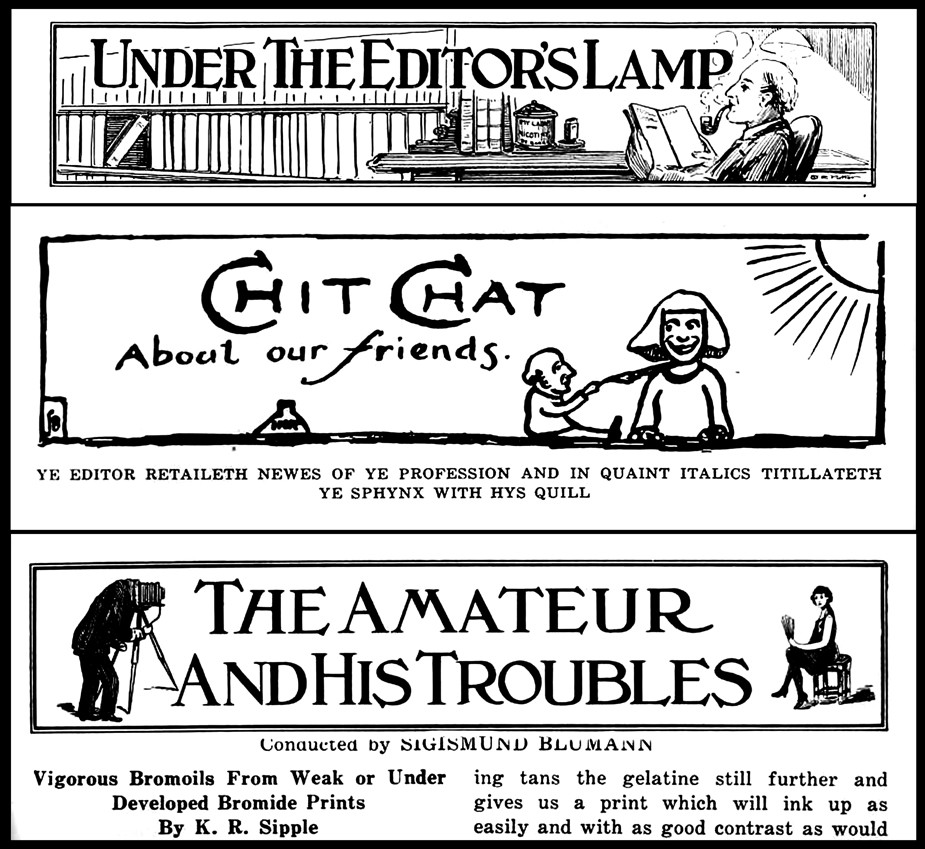 This triptych shows the three different Camera Craft magazine columns editor-in-chief Sigismund Blumann was involved with during his tenure at the journal from 1924-1933. "Under The Editor's Lamp" at top featured a caricature of the editor puffing a way on his trusty pipe while "Chit Chat About our Friends" at middle is comically subtitled "Ye Editor Retaileth Newes of Ye Profession And In Quaint Italics Titillateth Ye Sphynx With Hys Quill". "The Amateur And His Troubles", "conducted", appropriately enough by the man who had once made his living as a musician and orchestra leader, who already a feature of the publication when Blumann took over. From: PhotoSeed Archive
This triptych shows the three different Camera Craft magazine columns editor-in-chief Sigismund Blumann was involved with during his tenure at the journal from 1924-1933. "Under The Editor's Lamp" at top featured a caricature of the editor puffing a way on his trusty pipe while "Chit Chat About our Friends" at middle is comically subtitled "Ye Editor Retaileth Newes of Ye Profession And In Quaint Italics Titillateth Ye Sphynx With Hys Quill". "The Amateur And His Troubles", "conducted", appropriately enough by the man who had once made his living as a musician and orchestra leader, who already a feature of the publication when Blumann took over. From: PhotoSeed Archive
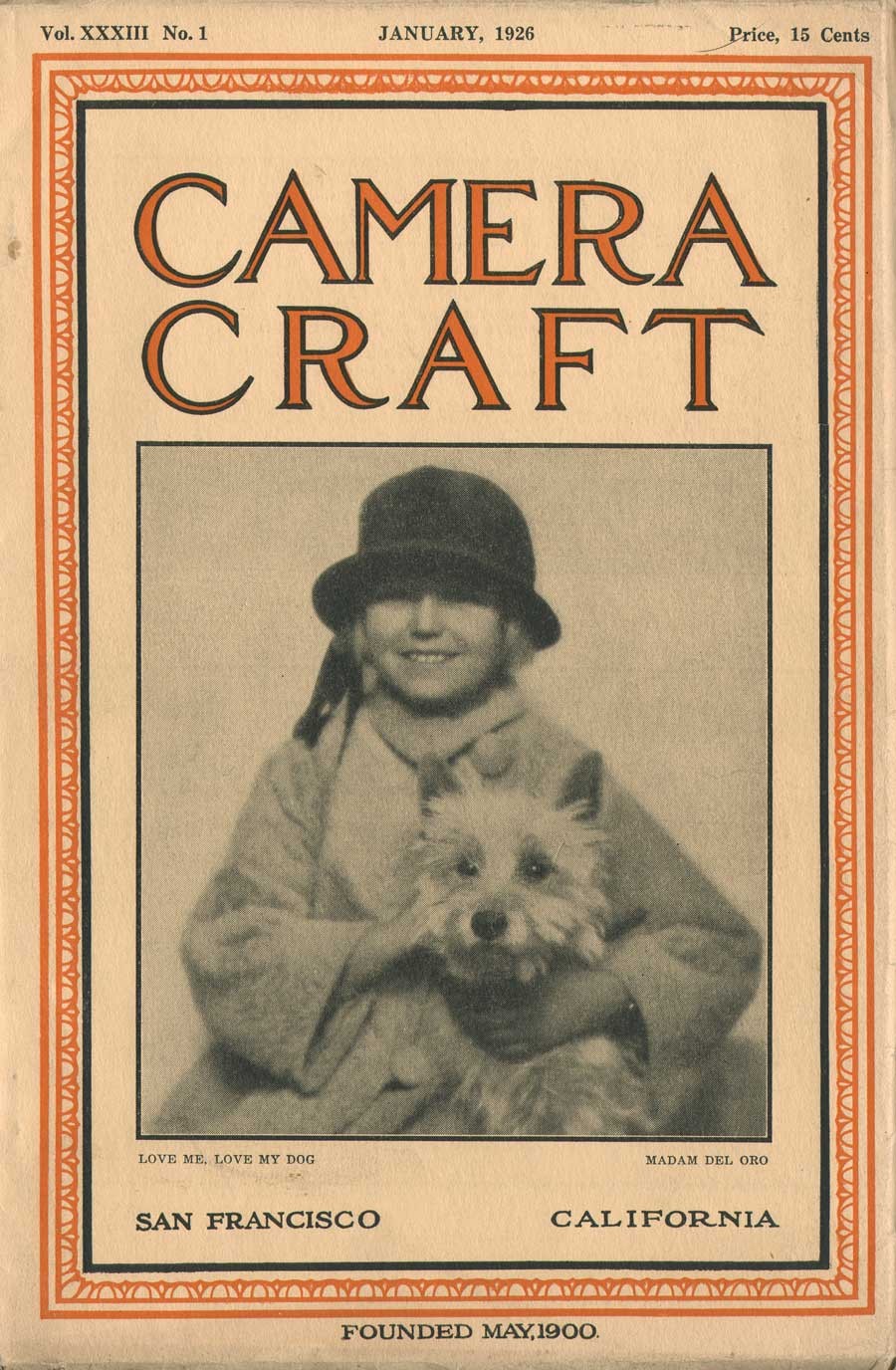 Cover Design: Camera Craft magazine: San Francisco, CA: January, 1926: Press of the Hansen Company, San Francisco: 26.5 x 17.5 cm: two-color wood engraved border design with inset halftone photograph: "Love Me, Love My Dog" by Madam Del Oro: American? 13.3 x 12.1 cm : cover price at upper right corner 15¢. One of the journal's seemingly obvious decisions, at least for the time, was to feature an actual photograph as a cover illustration for Camera Craft. Editor Blumann made this decision beginning with the October, 1924 issue. From: PhotoSeed Archive
Cover Design: Camera Craft magazine: San Francisco, CA: January, 1926: Press of the Hansen Company, San Francisco: 26.5 x 17.5 cm: two-color wood engraved border design with inset halftone photograph: "Love Me, Love My Dog" by Madam Del Oro: American? 13.3 x 12.1 cm : cover price at upper right corner 15¢. One of the journal's seemingly obvious decisions, at least for the time, was to feature an actual photograph as a cover illustration for Camera Craft. Editor Blumann made this decision beginning with the October, 1924 issue. From: PhotoSeed Archive
With its second issue for June, ambitions quickly shifted in support of the establishment of a West-Coast professional organization:
“Camera Craft intends to agitate the question of a Pacific Coast Convention of photographers. General inquiry throughout the state has led to the belief that such a convention is not only desirable but an actual need to those who make their living through the lens and shutter.” …We recall instances where photographers of this coast have attended conventions in the East and have returned with easy honors. Camera Craft would be pleased to learn of a serious consideration of the idea. A convention held in San Francisco with a first-class salon as an adjunct would undoubtedly lead to a permanent organization, and result in the advancement of the craft in a manner hitherto untried.” (p. 68)
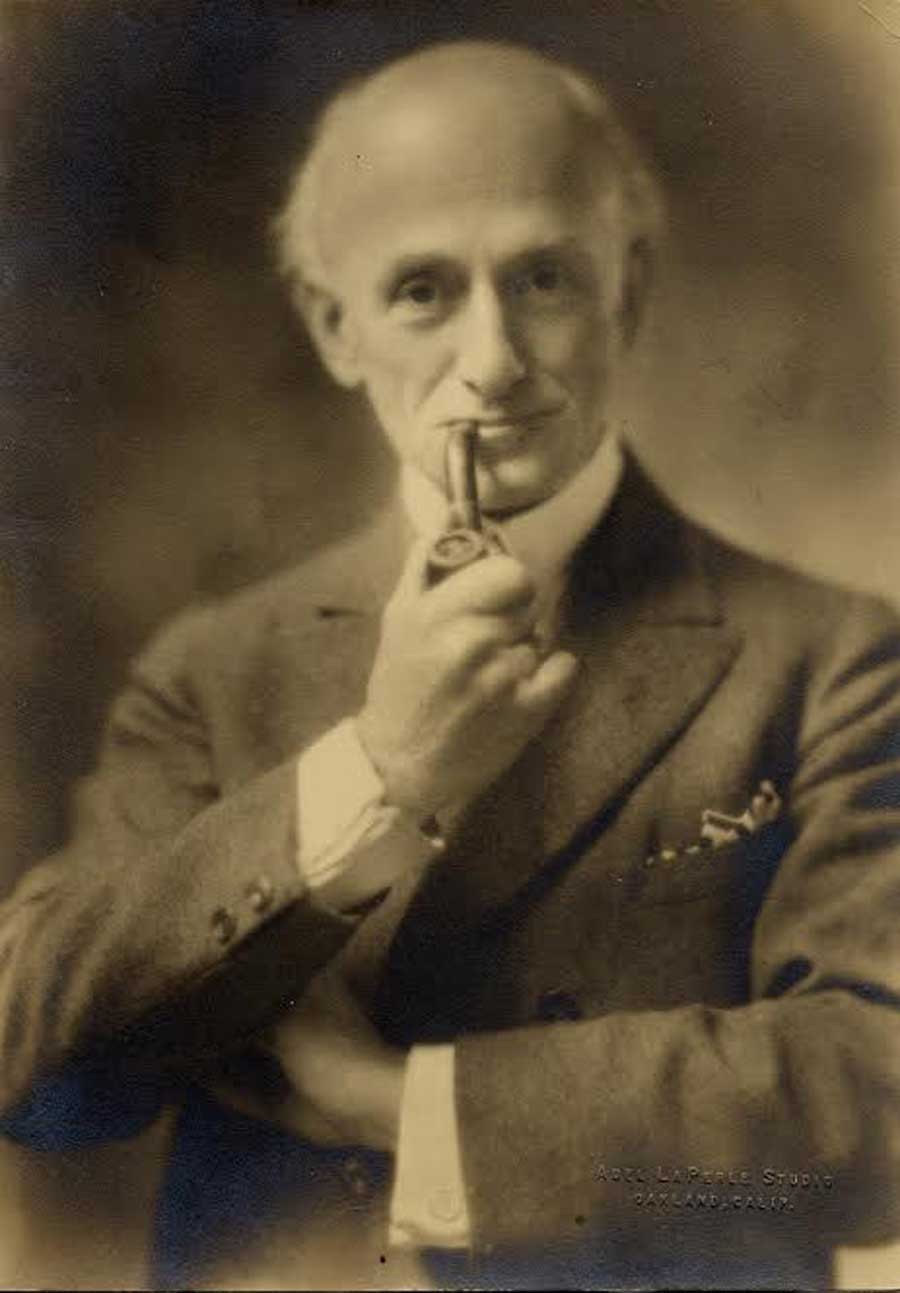 "Portrait of Sigismund Blumann": ca. 1928: Adel LaPerle Studio, Oakland, CA: gelatin silver print: Blumann was editor-in-chief of San Francisco-based Camera Craft magazine from 1924-1933: Photograph courtesy Thomas High
"Portrait of Sigismund Blumann": ca. 1928: Adel LaPerle Studio, Oakland, CA: gelatin silver print: Blumann was editor-in-chief of San Francisco-based Camera Craft magazine from 1924-1933: Photograph courtesy Thomas High
Although preceded geographically and in scope by the Pacific Coast Photographer, a short-lived monthly established in 1892 and believed to have ceased publication several years later, Camera Craft thrived as a robust Western photographic journal for the next 41 years. It first accomplished this under the capable tenure of editor Fayette J. Clute in the early decades of the publication before Sig took over in 1924, and was carried forward by him and others until the economic and human realities of World War II forced it’s hand. This occurred after the March, 1942 issue, when Camera Craft ironically headed back East so to speak, when it was absorbed by the Boston-based American Photography magazine. An editorial appearing in the final issue stated the decision to cease publishing was made because editor George Allen Young was taking his place in the armed services among other realities.
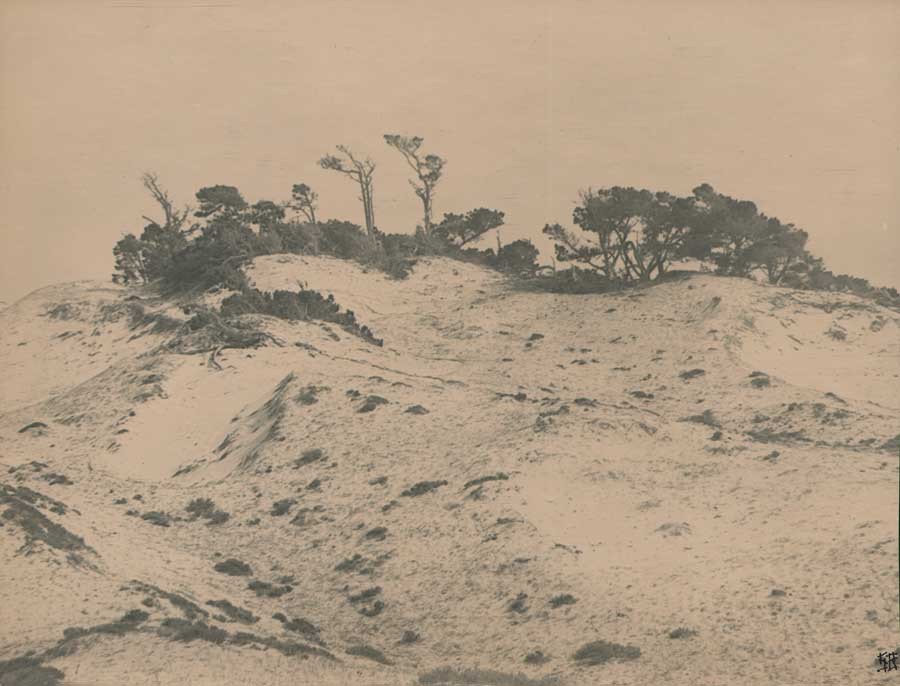 "Japonica" : Sigismund Blumann, American: ca 1920-40. gelatin silver print: 17.2 x 22.3 cm : This is a fine example of Blumann's pictorialist landscape work showing sand dunes and scrub trees, and was most likely taken on the West coast of the United States. Variants of this photograph have been similarly titled by the artist "Dune Pattern" and "Japanesque". This example signed in stylized Japanese initials at lower right corner: "SB". Three variants held by Minneapolis Institute of Arts: Accession #s: 99.230. (13-15) : From: PhotoSeed Archive
"Japonica" : Sigismund Blumann, American: ca 1920-40. gelatin silver print: 17.2 x 22.3 cm : This is a fine example of Blumann's pictorialist landscape work showing sand dunes and scrub trees, and was most likely taken on the West coast of the United States. Variants of this photograph have been similarly titled by the artist "Dune Pattern" and "Japanesque". This example signed in stylized Japanese initials at lower right corner: "SB". Three variants held by Minneapolis Institute of Arts: Accession #s: 99.230. (13-15) : From: PhotoSeed Archive
Sig As Camera Craft Editor: 1924-33
Photographic historian Christian A. Peterson, who called Camera Craft “the leading West Coast photographic monthly” and whose in-depth reassessment of Sigismund Blumann’s life and career was cited at the conclusion of Tom High’s short biography of his grandfather, called Sigismund Blumann:
”a prominent tastemaker in Californian photography during the 1920s and 1930s”. (8.)
Having an audience of 8000 monthly Camera Craft readers after coming aboard as chief editor in 1924 was surely a great start to becoming a tastemaker, but Sig proved his worth during the following nine years for his ability to impart to readers the essential knowledge of the ever-changing progress of photography. This took place in conjunction with his maintaining the vision of remaining true to himself-no matter how quirky some of his readers undoubtedly perceived him- while unashamedly promoting photographic talent in the pages of the magazine where he saw fit.
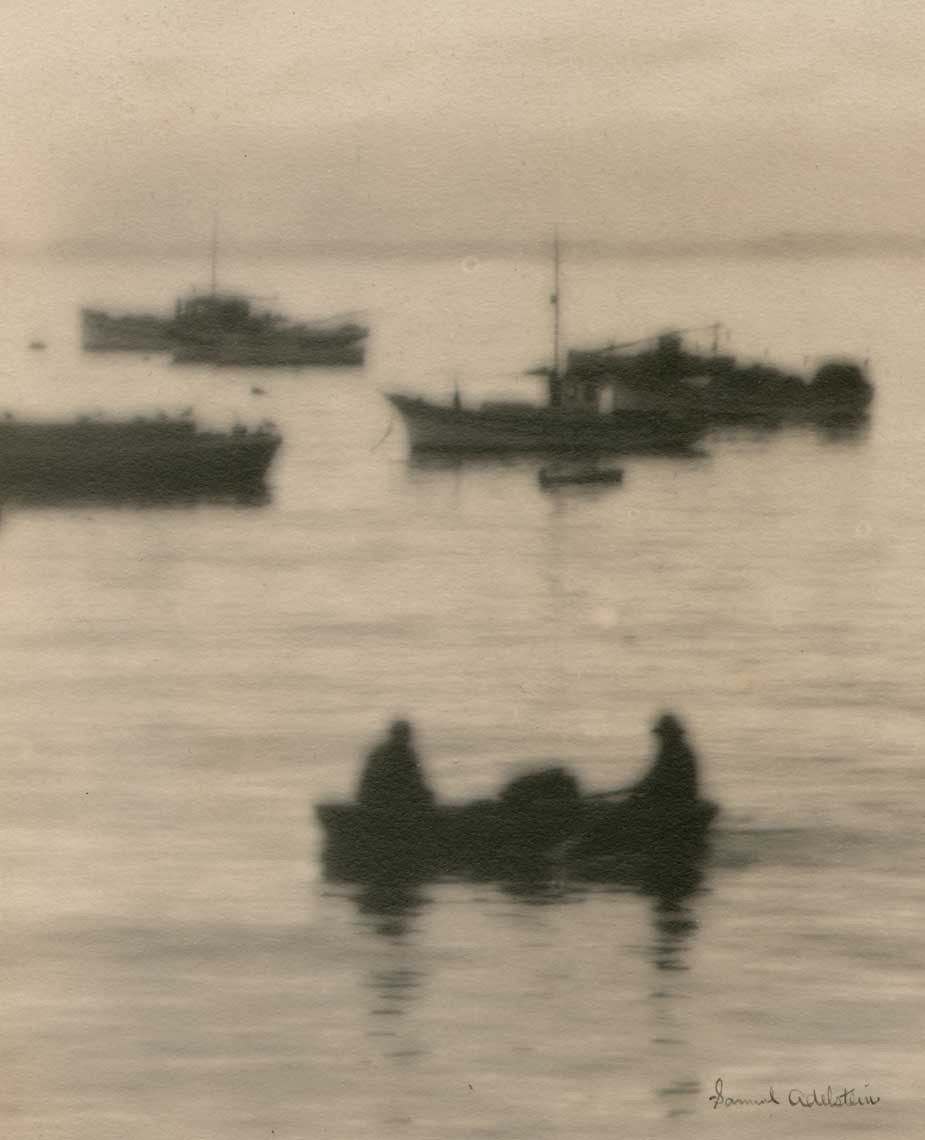 Detail: "Fishing Boats at Anchor" (probably Monterey Bay, CA) Samuel Adelstein, American, California: b. 1866?-d. 1934: silver bromide print ca. 1920-25: 18.5 x 13.6 | 40.6 x 25.4 cm: Adelstein was an active member of the California Camera Club whose pictorial works including a series of nude studies were published in Camera Craft in January, 1918 as part of the article: "An Enthusiast's Experience". The year before, the journal stated he was "an enthusiastic amateur photographer, a native son, a Director of the California Camera Club, and one of the Board of Governors of the Civic League of Improvement Clubs and Associations": Immersing himself in the art of photography around 1916, he specialized in making enlargements (from sharp negatives) with a soft-focus Verito lens. From: PhotoSeed Archive
Detail: "Fishing Boats at Anchor" (probably Monterey Bay, CA) Samuel Adelstein, American, California: b. 1866?-d. 1934: silver bromide print ca. 1920-25: 18.5 x 13.6 | 40.6 x 25.4 cm: Adelstein was an active member of the California Camera Club whose pictorial works including a series of nude studies were published in Camera Craft in January, 1918 as part of the article: "An Enthusiast's Experience". The year before, the journal stated he was "an enthusiastic amateur photographer, a native son, a Director of the California Camera Club, and one of the Board of Governors of the Civic League of Improvement Clubs and Associations": Immersing himself in the art of photography around 1916, he specialized in making enlargements (from sharp negatives) with a soft-focus Verito lens. From: PhotoSeed Archive
But some things remained the same after he took over. One, perhaps appropriate considering his musical background, was his retention of the subhead: “Conducted by Sigismund Blumann” for the journal’s long-established editorial column The Amateur And His Troubles previously edited by Paul Douglas Anderson. This time, an actual orchestra conductor was indeed stepping in to conduct editorial affairs! Keeping this personal touch intact-especially to those who knew him as someone passionate of music his entire life, was just one way of his remaining connected with readers as well as professional and social acquaintances in the Bay Area. Under Sig’s moderation, the column continued to offer advice dispensed by any number of well regarded authors who broke down and offered solutions to problems encountered by amateurs in the field relating to anything from photographic equipment to darkroom dilemmas.
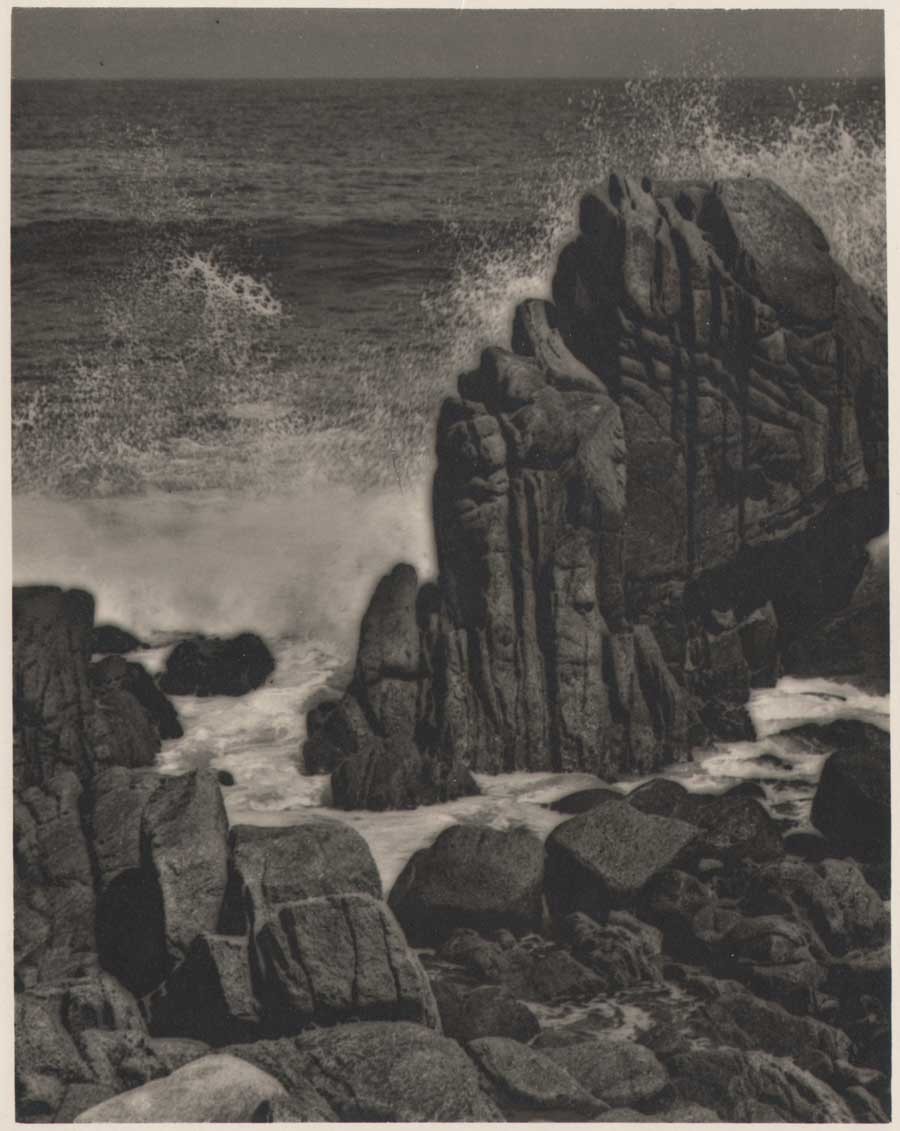 "Lugubrio": Sigismund Blumann, American: 1927 or before: gelatin silver print: 20.8 x 16.4 | 25.3 x 20.1 cm: This image, reproduced as a large halftone, was published on the same page as an accompanying poem of the same title for the April, 1927 issue of Camera Craft. The scene was most likely taken along the Pacific coastline. From: PhotoSeed Archive
"Lugubrio": Sigismund Blumann, American: 1927 or before: gelatin silver print: 20.8 x 16.4 | 25.3 x 20.1 cm: This image, reproduced as a large halftone, was published on the same page as an accompanying poem of the same title for the April, 1927 issue of Camera Craft. The scene was most likely taken along the Pacific coastline. From: PhotoSeed Archive
His second column, a new feature which debuted with the November, 1924 issue, was called CHIT CHAT About our friends. A vehicle for Sig’s effusive boosterism of photography in general, both professional and amateur, it was written in a style that might best be described, amusingly, as slightly syrupy in tone but delivered with erudition. Profiles on photographers he found interesting, and news of California camera clubs were a constant monthly feature of the column in addition to news of major upcoming exhibitions as well as critiques and results from those salons happening not only on the West Coast but throughout the United States and beyond. Comically subtitled: “Ye Editor Retaileth Newes of Ye Profession And In Quaint Italics Titillateth Ye Sphynx With Hys Quill”, the column’s “titillations” were often just longish aphorisms managing implied or direct associations to something photographic. Appearing rather infrequently at the column’s outset and disappearing altogether by August, 1931 when this inventive take on the English language was eliminated, they appeared from time to time, with several reprinted below for his January, 1926 column:
“Every time you get the best of a customer you have cheated yourself.”
“The most expensive lens may not be the best but the cheapest is pretty sure to be the worst.”
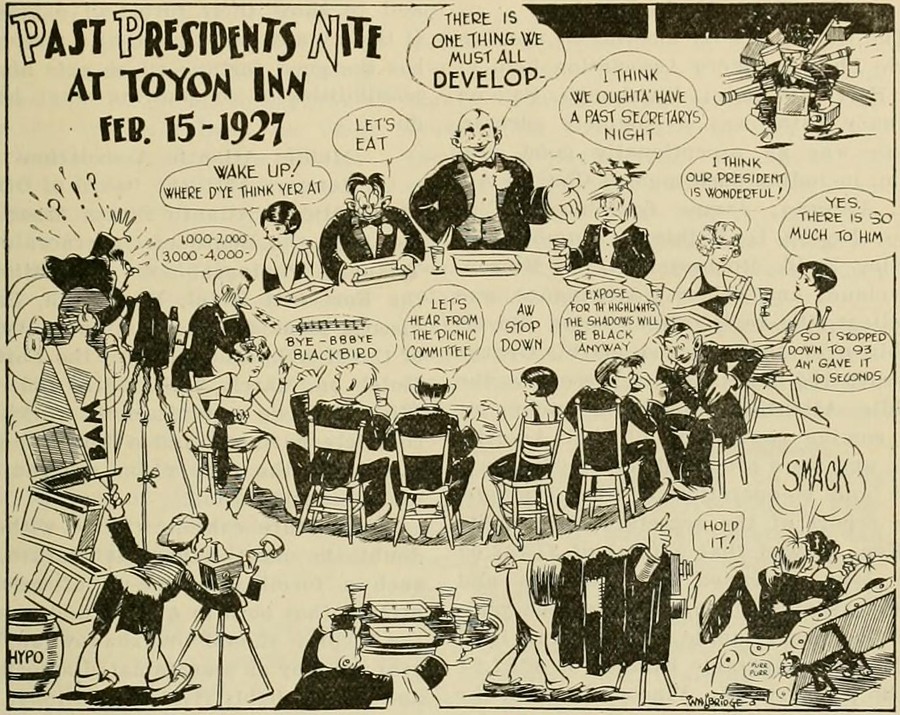 "Past Presidents Nite At Toyon Inn Feb. 15- 1927" : by artist W.A. Bridge, American -California? : Used as a halftone in the March, 1927 issue of Camera Craft, this humorous cartoon illustrated a dinner dance commemorating a gathering of past presidents of the Pacific International Photographers' Association which took place at San Leandro's Toyon Inn on Feb. 15, 1927. Sigismund Blumann, who served as host of the event, made sure to comment in the pages of Camera Craft magazine that "refreshments" of a most unusual kind: ie: inebriating, were served at the event during the era of American Prohibition. From: California State Library: Archive.org
"Past Presidents Nite At Toyon Inn Feb. 15- 1927" : by artist W.A. Bridge, American -California? : Used as a halftone in the March, 1927 issue of Camera Craft, this humorous cartoon illustrated a dinner dance commemorating a gathering of past presidents of the Pacific International Photographers' Association which took place at San Leandro's Toyon Inn on Feb. 15, 1927. Sigismund Blumann, who served as host of the event, made sure to comment in the pages of Camera Craft magazine that "refreshments" of a most unusual kind: ie: inebriating, were served at the event during the era of American Prohibition. From: California State Library: Archive.org
Lastly, and most importantly, one of the most personal reasons for Camera Craft’s success under Sig was his entirely self-written Under the Editor’s Lamp column, debuting with the April, 1926 issue. Already a fixture by means of the pen to his many readers-in prose as well as poetry- the column gave a final say so to speak to his personal views-conservative to be sure-on just about anything going on regarding photography and musings on current events. With accompanying column artwork by California artist W.R. Potter portraying Sig kicking back while puffing his pipe and seated at a library desk, the column became an effective way for this journal’s Editor-in-Chief to assume the role of oracle and brand ambassador. Sig’s short forward for his first Under the Editor’s Lamp :
When the desk is cleared of paste-pot and shears and the lamp is lit, it is good to put a match to the freshly loaded, old pipe and take a puff or two, letting the mind’s mind relax into mere dreams. The lamp is a sentimental fiction, of course, being a standardized glass bowl with a bulb glowing through, but the pipe is real, the mood is sincere, and we hope the mind exists, more or less.
Out go our thoughts to readers unseen, perhaps never to be met except as a large, critical, voracious body of men and women who consume the forty-eight pages of pictures and text and off-hand decide the fare has been very good, fair, or rotten. Little do they care what labor, what hopes, what ambitions went into every line and every illustration. Why should they. The best is no better than their due. (p.180)
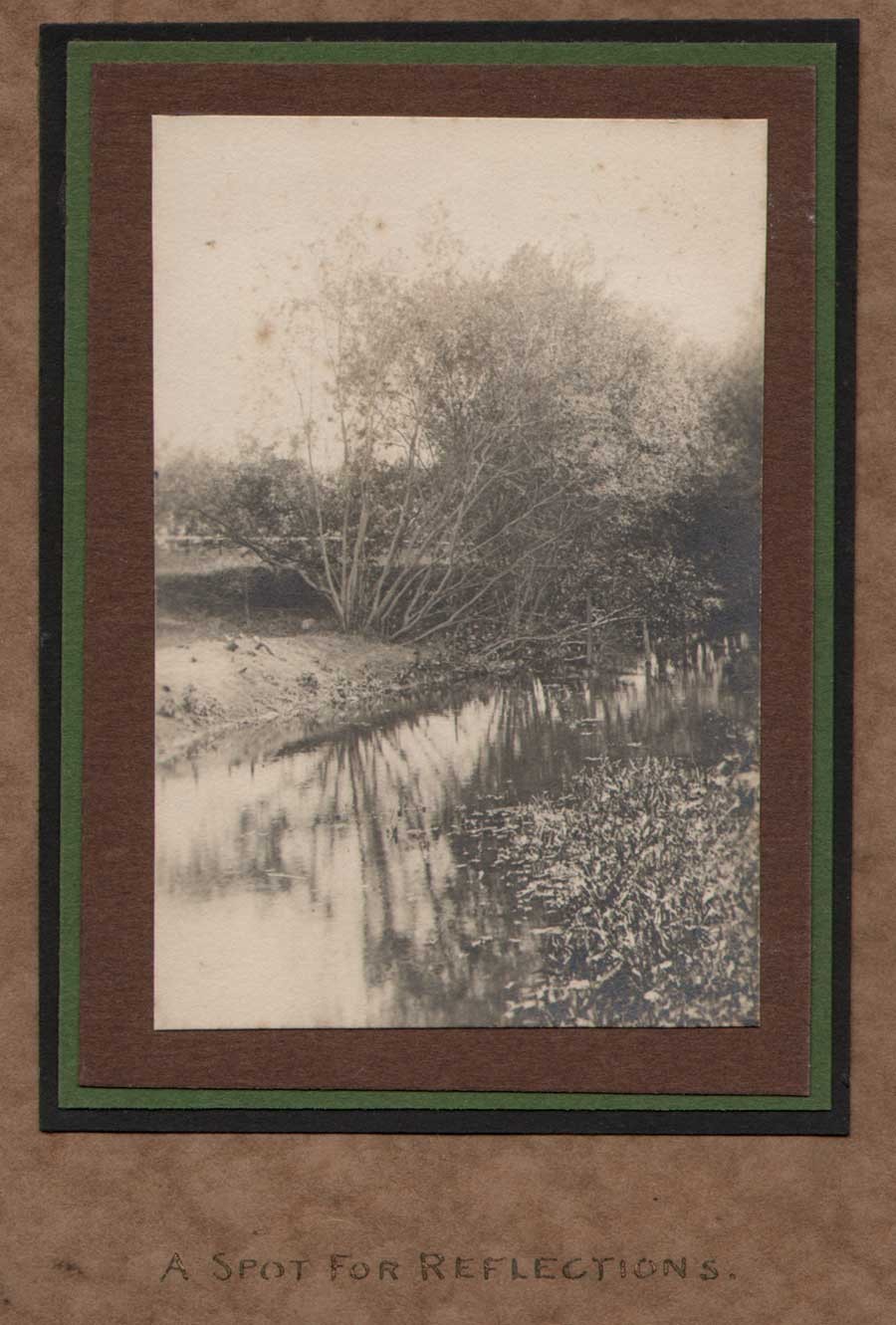 "A Spot for Reflections": Sigismund Blumann, American: ca. 1925-30: gelatin silver print : 9.8 x 6.5 | 18.2 x 14.5 cm : perhaps taken in Oakland or the Inverness area of Marin County, CA, this is a fine example of Blumann's pictorialist work in which he has titled the composition in gold lettering and triple-mounted the image onto fine art paper supports. From: PhotoSeed Archive
"A Spot for Reflections": Sigismund Blumann, American: ca. 1925-30: gelatin silver print : 9.8 x 6.5 | 18.2 x 14.5 cm : perhaps taken in Oakland or the Inverness area of Marin County, CA, this is a fine example of Blumann's pictorialist work in which he has titled the composition in gold lettering and triple-mounted the image onto fine art paper supports. From: PhotoSeed Archive
M.Q. Developer to Develop Good Feeling
Because Camera Craft billed itself the official organ of the Pacific International Photographers’ Association, (PIPA) with owner Ida M. Reed acting as Secretary and headquartered in the same San Francisco offices as the journal, (703 Market in Claus Spreckles Building) news of the Association-which covered a wide western geographic area including membership from Alaska, Alberta, Arizona, British Columbia, California, the Hawaiian Islands, Idaho, Montana, Nevada, Oregon, Utah and Washington states- became a regular monthly feature of the previously discussed Chit-Chat column. By 1927, Sig was hitting full-stride at Camera Craft, his writing skills undoubtedly honed through his reminisces featured in the Editor’s Lamp column.
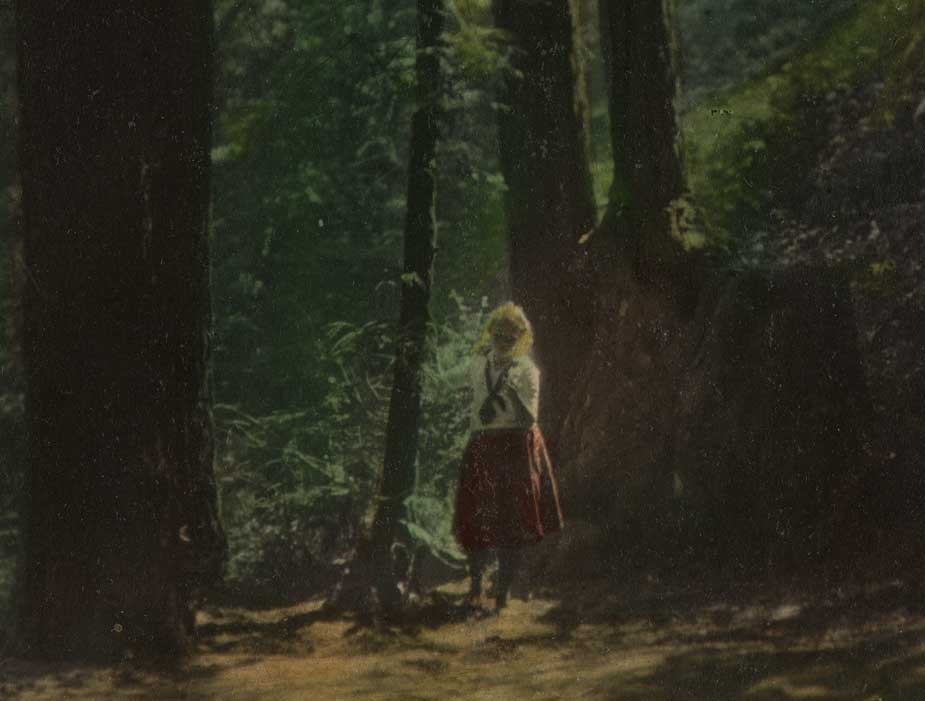 Detail: "Vera in the Woods": Sigismund Blumann, American: 1920-25: hand-colored gelatin silver print: 24.2 x 18.6 cm: Taken among a stand of Redwood trees, perhaps in the present-day Muir Woods National Monument in Marin County, CA, the subject of this photograph is believed to show the photographer's youngest daughter Vera Blumann, b. 1911. Blumann was in love with the outdoors, and frequently took part in extended camping trips with family members to hike and photograph areas of beauty in California and the Pacific Northwest-trips he wrote about in the pages of Camera Craft. See variant: Minneapolis Institute of Arts: Accession #99.231.15. From: PhotoSeed Archive
Detail: "Vera in the Woods": Sigismund Blumann, American: 1920-25: hand-colored gelatin silver print: 24.2 x 18.6 cm: Taken among a stand of Redwood trees, perhaps in the present-day Muir Woods National Monument in Marin County, CA, the subject of this photograph is believed to show the photographer's youngest daughter Vera Blumann, b. 1911. Blumann was in love with the outdoors, and frequently took part in extended camping trips with family members to hike and photograph areas of beauty in California and the Pacific Northwest-trips he wrote about in the pages of Camera Craft. See variant: Minneapolis Institute of Arts: Accession #99.231.15. From: PhotoSeed Archive
The following account is a result of this, of Sig’s prodigious social engagement with members active in the Bay-area camera club scene. In a humorous yet telling example of his own admission to preserve the rightful history of one particular PIPA (often referred to as a club) meeting for Chit-Chat, the March, 1927 issue duly reported on the Past Presidents Night dinner dance at San Leandro’s Toyon Inn on Feb. 15, 1927. Taking place when Prohibition was still the law of the land in America, (9.) Sig’s account made sure to include the lengths employed at the soirée in order for those attending to enjoy the social, and inebriating benefits of some “liquid cheer”:
But hold, before we close it must be chronicled as it shall be inscribed in the archives of the club that each guest found a developing tray and two glass graduates before him. It was a paper tray, so that when dropped the falling tray might not raise the deuce. In one of the two ounce graduates water was served and in the other M.Q. developer to develop good feeling. A bucket of Hypo was kept in the ante-room to fix the police, and everything was provided to make a perfect picture except bromide. If any was needed it was the next morning. (p. 145: M.Q. was an alkaline developer for gelatine emulsions combining Metol and hydroquinone)
 "Yosemite Falls | Yosemite Valley": Sigismund Blumann, American: dated 1926 & signed: "Dry Point Etching" ie: most likely a Kallitype or bleached and toned print on Vitava E (tching) chlorobromide paper: 13.1 x 9.0 | 23.7 x 16.5 cm: A specialist in alternative darkroom processes, particularly Kallitype, Blumann perfected his "Dry Point Etching" process and described it in lengthy articles in Camera Craft in 1925 and later in July, 1934 for his own Photo Art monthly using the pen name "Charles H. Fitzpatrick." This finished etching showing Yosemite Falls was originally taken as a photograph by Blumann in the Spring of 1925. Both photo and etching were illustrated side-by-side as halftones in the October, 1925 Camera Craft article titled "Making Photographs Into Dry Point Etchings". See the following citation at end of this caption in Notes field for a working description of the "Dry Point Etching" process. (11.) From: PhotoSeed Archive
"Yosemite Falls | Yosemite Valley": Sigismund Blumann, American: dated 1926 & signed: "Dry Point Etching" ie: most likely a Kallitype or bleached and toned print on Vitava E (tching) chlorobromide paper: 13.1 x 9.0 | 23.7 x 16.5 cm: A specialist in alternative darkroom processes, particularly Kallitype, Blumann perfected his "Dry Point Etching" process and described it in lengthy articles in Camera Craft in 1925 and later in July, 1934 for his own Photo Art monthly using the pen name "Charles H. Fitzpatrick." This finished etching showing Yosemite Falls was originally taken as a photograph by Blumann in the Spring of 1925. Both photo and etching were illustrated side-by-side as halftones in the October, 1925 Camera Craft article titled "Making Photographs Into Dry Point Etchings". See the following citation at end of this caption in Notes field for a working description of the "Dry Point Etching" process. (11.) From: PhotoSeed Archive
Camera Nut to the End
Considering he was having an awfully good time in his position as Editor-in Chief, an observation certainly not witnessed by this writer but most obvious by the written evidence left for posterity, Sig’s resignation at the end of July, 1933 does seem a bit abrupt. Historian Christian A. Peterson speculates he and owner Ida M. Reed “parted ways over deep differences.” (10.) But with the installation of Camera Craft veteran George Allen Young to replace him, Sig was none the less given deserved praise by owner Ida Reed the following month:
Since 1924 we, and the readers of this magazine, have enjoyed his contagious enthusiasm, and his wide technical knowledge of photography,. He leaves with our best wishes for success and happiness. (p. 387)
Earlier, for his final Under the Editor’s Lamp column written in July, 1933 and published the next month, his nine-year run at the journal concludes with a perhaps knowing, but certainly wistful remembrance of his good times spent there. Recounting adventures in photography that summer while traveling the California High Sierra, Sig first gives accolades to the efforts U.S. President Theodore Roosevelt was giving to get American industry moving again during the ongoing Great Depression before concluding by stating his own continued love affair with photography:
Does thinking of Yosemite and speaking of photography seem like reductum ad absurdum to you? It should not for I can allow myself so very short a time in that garden of The God and I can so effectively carry some of its glory and inspiration over the rest of the year with what my camera has enabled me to bring home, that it is natural to raise the picture, as near as imagination makes possible, to the original.
As I look at the screen and project the pictures, studying how to express my reactions when on the spot, I once again smell the pines and hear the rush of the Merced as it boils over the Happy Isles. In the quiet and the benignancy of the red light fancy builds Half Dome, El Capitan, and the Domes anew.
The old rags that made us free. The open spaces that made us immortal in spiritual disembodiment. The camera that vitalized every hour of the day with its assurance of creative picture making. Friends, I am glad, very glad, to be a camera Nut. (p. 343)
With that, a poem by Sig somehow seems a good fit in ending this remembrance about the young boy who moved to California and proceeded through hard work and perseverance to embrace the Golden State as his own. Along with possessing the gift of innumerable talents and more than a few dreams, he managed to share them with many others.
THE QUIET CORNER by Sigismund Blumann
A PIPE, some books, a flower or two,
The picture of one gone before
Who stands without the open door
And shall not die.
When work is through
Some day, some day, when rest is won
And the long, long duty-season done,
I’ll sit me down to taste the best
Of books, tobacco, men and things:
To listen when the spring-bird sings—
Looking in peace toward the West.
Against that day, and I am spared,
My quiet corner stands prepared.
To see all work by Sigismund Blumann in the PhotoSeed Archive please go here.
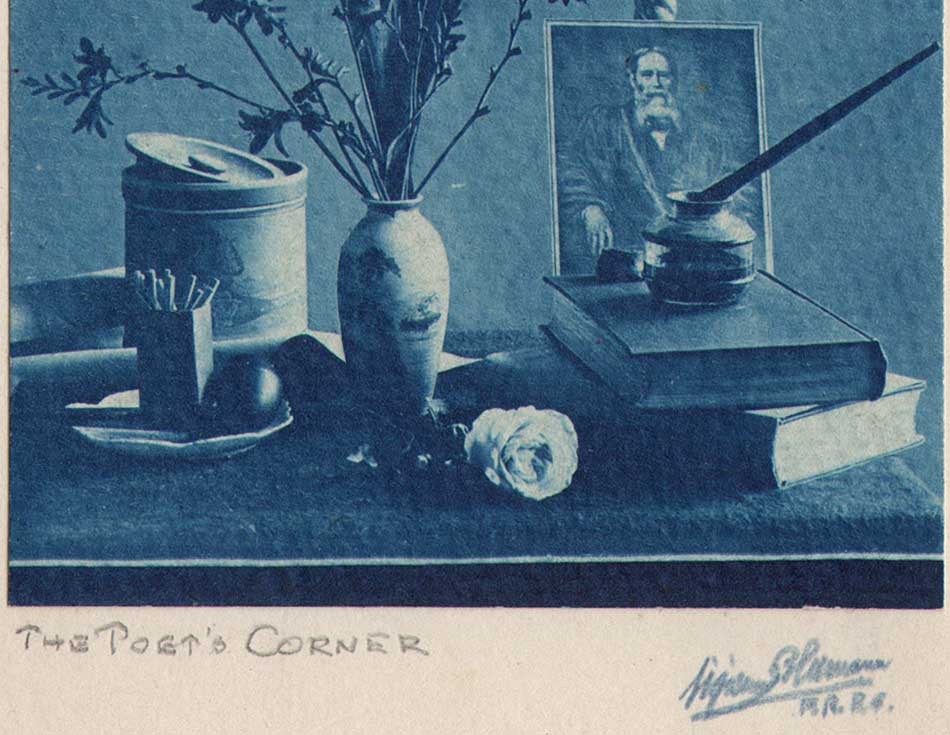 Detail: "The Poet's Corner" or "The Quiet Corner": Sigismund Blumann, American: 1933 or later: toned pigment print: 10.6 x 7.5 | 16.9 x 11.6 cm: The author's trusty pipe can be seen at left in this still-life table top study reproduced as the frontis halftone illustration for the August, 1927 issue of Camera Craft. From: PhotoSeed Archive
Detail: "The Poet's Corner" or "The Quiet Corner": Sigismund Blumann, American: 1933 or later: toned pigment print: 10.6 x 7.5 | 16.9 x 11.6 cm: The author's trusty pipe can be seen at left in this still-life table top study reproduced as the frontis halftone illustration for the August, 1927 issue of Camera Craft. From: PhotoSeed Archive
NOTES:
1. see: Early Years in Photography: “Sigismund Blumann, California Editor and Photographer”, by Christian A. Peterson in History of Photography, vol. 26, no. 1. (Spring 2002) p. 59.
2. Ibid: in: Photo Art Monthly, 1933-40: p. 73
3. It would not be until July, 1934, in an updated version of this 1925 Camera Craft article on describing the process of turning photographs into dry point etchings in Photo-Art Monthly, that evidence of Fitzpatrick and Blumann being the same person would seem to be confirmed. In it, the illustrated example of Blumann’s credited photograph titled “Land’s End” is also shown reproduced into the converted dry point etching with credit given to Fitzpatrick. Editorially, it might seem odd to continue this pen-name fiction with Blumann even going to lengths to construct a suspect history in 1925 of “Fitzpatrick’s” own beginnings although the reason was most likely intended as another way of imparting education on a topic deemed worthy and educational enough in the eyes and mind of the editor himself.
4. Copies of at least 43 documentary photographs, with several corresponding paper negative envelopes dated 1901 by Sigismund Bluman, were donated by his family to the California Historical Society where they can be viewed as part of the collection “The Chinese in California: 1850-1925.” The following link includes a smaller sampling of later printed examples, (some hand-colored) along with a rare surviving example titled “Ruin” (a detail included with this post) from 1906 of earthquake damage taken by the photographer as well as several portraits of Sig taken by others.
5. see: citation #1: p. 54.
6. excerpt: introduction: Making Photographs Into Dry Point Etchings: by Charles H. Fitzpatrick Illustrated by the Author: in: Camera Craft: October, 1925: San Francisco: p. 485.
7. see: citation #1 p. 54
8. Ibid: introduction: p. 53
9. American Prohibition was a nationwide constitutional ban on the sale, production, importation, and transportation of alcoholic beverages.
10. see: citation #1 p. 65
11. In order to make one of these etchings, the article instructs that after first selecting a printed photograph with little detail, the next step is to: “draw as much as he can on the photograph, using Higgins’ Water Proof India Ink. When this is absolutely dry the silver is completely bleached out with Bichloride of Mercury or Iodine-Iodide bleachers. The pen shading and finishing is then done with care, when the bleached and washed print has been dried.” From here, the article states a copy negative must then be made which is used to make the final second-generation finished (and reduced for effect) “etchings” using various grades of photographic paper: “The method of reproducing drawings is very simple. Place drawing on wall or easel and camera on firm support exactly centering lens on drawing, making exposure on a slow copy plate by diffused daylight or electric light, and develop for contrast. In copying it is advisable to reduce the image one-third smaller than the original as a finer line is thus secured which improves the finished print. The writer prefers a buff stock, matt paper of medium grade and heavy; and has found Vitava E just right: This is a matter of choice, however, as good prints may be secured on Azo, Velox, Cyco, Kruxo, Defender, Haloid, Barston, Charcoal Black or other matt papers. Proceed as in ordinary photographic printing then tone by re-development, using whatever process you prefer. I use Royal-Re-developer with pleasing results.” In the later 1934 article: “Etchings From and With Photographs”, “Fitzpatrick”goes further in depth on this etching process, adding that after the second-generation reduced copy print is made, the print could be “treated through all the usual solutions in the usual way and may be developed in any of the prescribed formulae for blue-black, jet-black, warm-black, or dark brown tones. Or it may be subsequently toned by the bleach and redevelop methods. The particular brown of an etching is easily gotten on Vitava Athena with a developer containing Athenon. Azo P-2 or 3, Vitava Athena E, Novira in the matt smooth or rough are all fine for the purpose. Gevalux gives a wonderful image in a true carbon black color and velvet crayon patine.” Continuing, the article offers a summary of the entire process: “That is all there is to the whole thing. You could not complicate it if you tried. Just make an enlargement, work on it with pen and ink, bleach out the silver leaving the ink image, photograph the line drawing, make as many etching-prints from the copy negative as you wish. Where can you go wrong? How can you fail?” He concludes by saying the maker of these etchings could also go “one step further by using hand-sensitized photographic papers for this final second-generation completed “etching”: “Furthermore, should you desire to print on colored papers or card- board of such surface as cannot be bought ready sensitized it will be a simple matter to sensitize any stock with the well known Blue Print solutions, or if the various shades of brown and black are wanted to resort to Kallitype. These processes are as cheap as they are easy to compound and use; they work on any paper not too saturated with chlorides or unfixed dyes. Kallitype is moreover a beautiful process in itself and prints endure according to the care in making them.”
Nature's Camera
Posted May 2015 in Alternate Processes, History of Photography, Scientific Photography
Spring, that time of rebirth for the temperate regions of the world, is thankfully showing itself off again. With new growth on trees, flowers showing off and the lingering sweet smells of airborne pollen, these are but a few signs of the season.
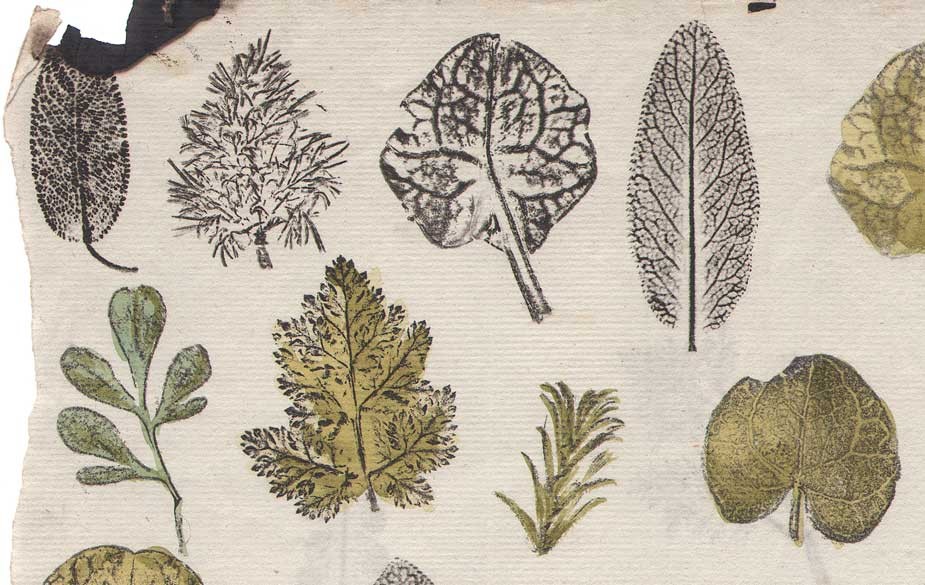 Detail: Nature prints: English: unknown maker: (recto) leaf specimens with selective hand-coloring: ca. 1775-1825: 30.5 x 38.3 cm: laid paper leaf (separated) with Britannia shield and C&S watermarks. from: PhotoSeed Archive
Detail: Nature prints: English: unknown maker: (recto) leaf specimens with selective hand-coloring: ca. 1775-1825: 30.5 x 38.3 cm: laid paper leaf (separated) with Britannia shield and C&S watermarks. from: PhotoSeed Archive
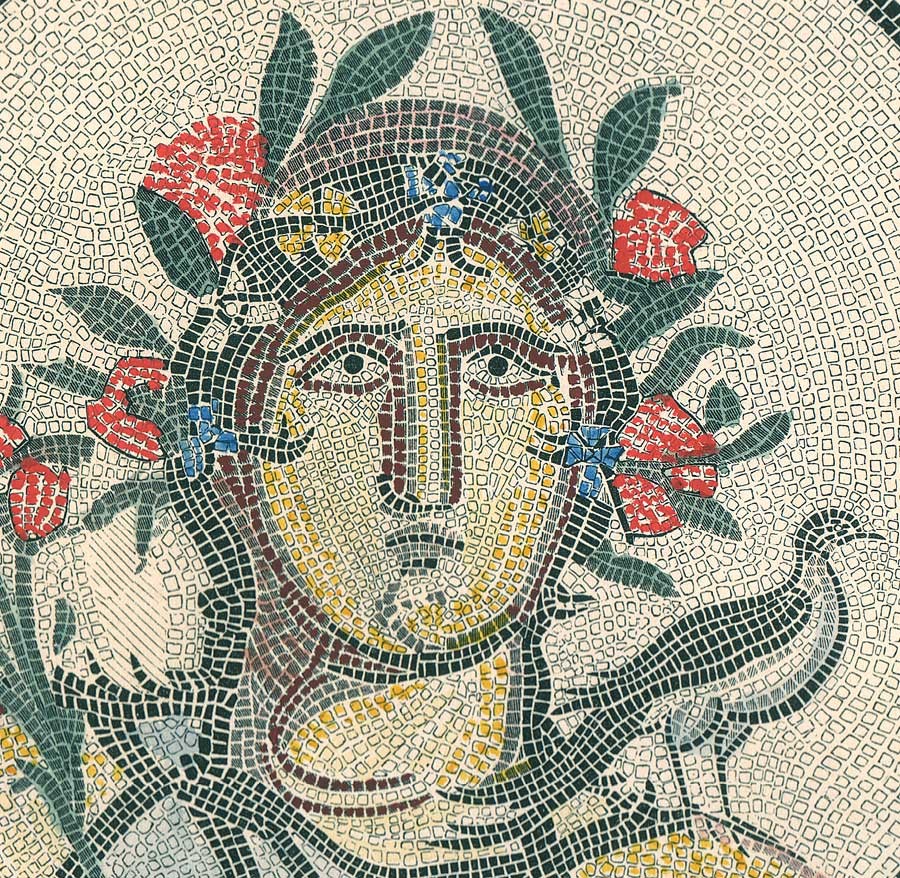 Detail: "Flora", the Roman goddess of Spring and flowers: 1850: hand-colored lithograph from Talbotype by Philip Henry Delamotte (1821-1889) of hand-drawn and colored tracing of Roman mosaic (mid 2nd Century A.D.) at Cirencester, England. 14.5 x 10.2 cm: reproduced as plate V in: "Illustrations of the Remains of Roman Art, in Cirencester, The Site of Antient Corinium": London. This floor mosaic of Flora was one of three seasonal mosaics excavated at Cirencester in 1849. From: PhotoSeed Archive
Detail: "Flora", the Roman goddess of Spring and flowers: 1850: hand-colored lithograph from Talbotype by Philip Henry Delamotte (1821-1889) of hand-drawn and colored tracing of Roman mosaic (mid 2nd Century A.D.) at Cirencester, England. 14.5 x 10.2 cm: reproduced as plate V in: "Illustrations of the Remains of Roman Art, in Cirencester, The Site of Antient Corinium": London. This floor mosaic of Flora was one of three seasonal mosaics excavated at Cirencester in 1849. From: PhotoSeed Archive
As children, our very first “photographs” joyously executed in winter climes would have taken the form of angelic impressions left in the newly fallen snow, or tropical: designs left on sandy seashores.
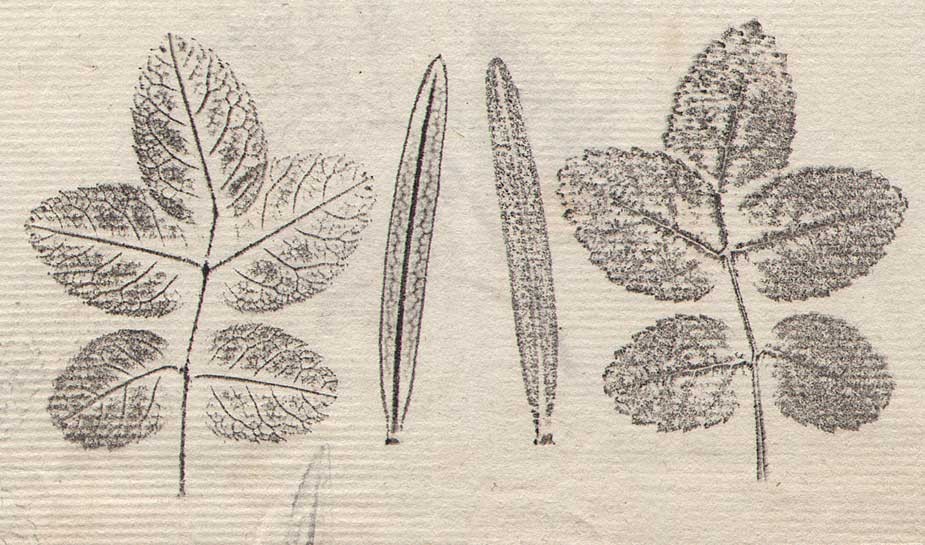 Detail: Nature prints: English: unknown maker: mirror impression of unknown grass and leaf cluster specimens: ca. 1775-1825: 30.5 x 38.3 cm: laid paper leaf (separated) with Britannia shield and C&S watermarks. from: PhotoSeed Archive
Detail: Nature prints: English: unknown maker: mirror impression of unknown grass and leaf cluster specimens: ca. 1775-1825: 30.5 x 38.3 cm: laid paper leaf (separated) with Britannia shield and C&S watermarks. from: PhotoSeed Archive
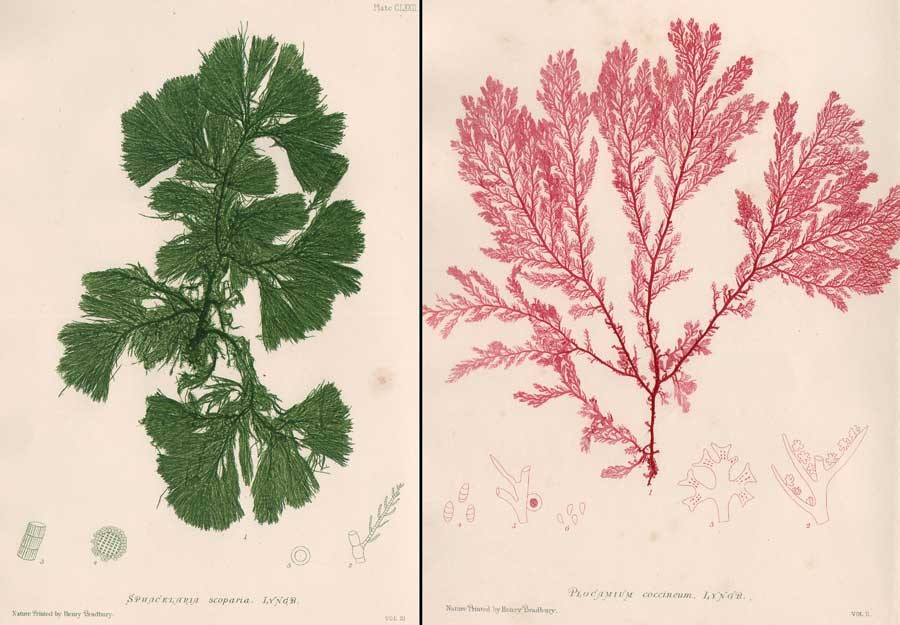 Examples of nature-printed British Seaweeds printed in intaglio by Henry Bradbury, English. (1831-1860) Left: Sphacelaria Scoparia Lyngb.: 1860; 23.9 x 15.5 cm: plate CLXXII from vol. III: "The Nature-Printed British Sea-Weeds: A History, Accompanied by figures and dissections, of the algae of the British Isles" : London: Bradbury and Evans. Right: Plocamium Coccineum, Lyngb.: 1859; 23.9 x 15.5 cm: plate LXVIII from vol. II: "The Nature-Printed British Sea-Weeds": Bradbury's technique commercialized nature printing for the masses-he adapted an 1852 process invented by Viennese engravers Alois Auer and Andreas Worring creating a matrix by placing botanical specimens between a sheet of soft lead and steel which were then electroplated, inked and printed. from: PhotoSeed Archive
Examples of nature-printed British Seaweeds printed in intaglio by Henry Bradbury, English. (1831-1860) Left: Sphacelaria Scoparia Lyngb.: 1860; 23.9 x 15.5 cm: plate CLXXII from vol. III: "The Nature-Printed British Sea-Weeds: A History, Accompanied by figures and dissections, of the algae of the British Isles" : London: Bradbury and Evans. Right: Plocamium Coccineum, Lyngb.: 1859; 23.9 x 15.5 cm: plate LXVIII from vol. II: "The Nature-Printed British Sea-Weeds": Bradbury's technique commercialized nature printing for the masses-he adapted an 1852 process invented by Viennese engravers Alois Auer and Andreas Worring creating a matrix by placing botanical specimens between a sheet of soft lead and steel which were then electroplated, inked and printed. from: PhotoSeed Archive
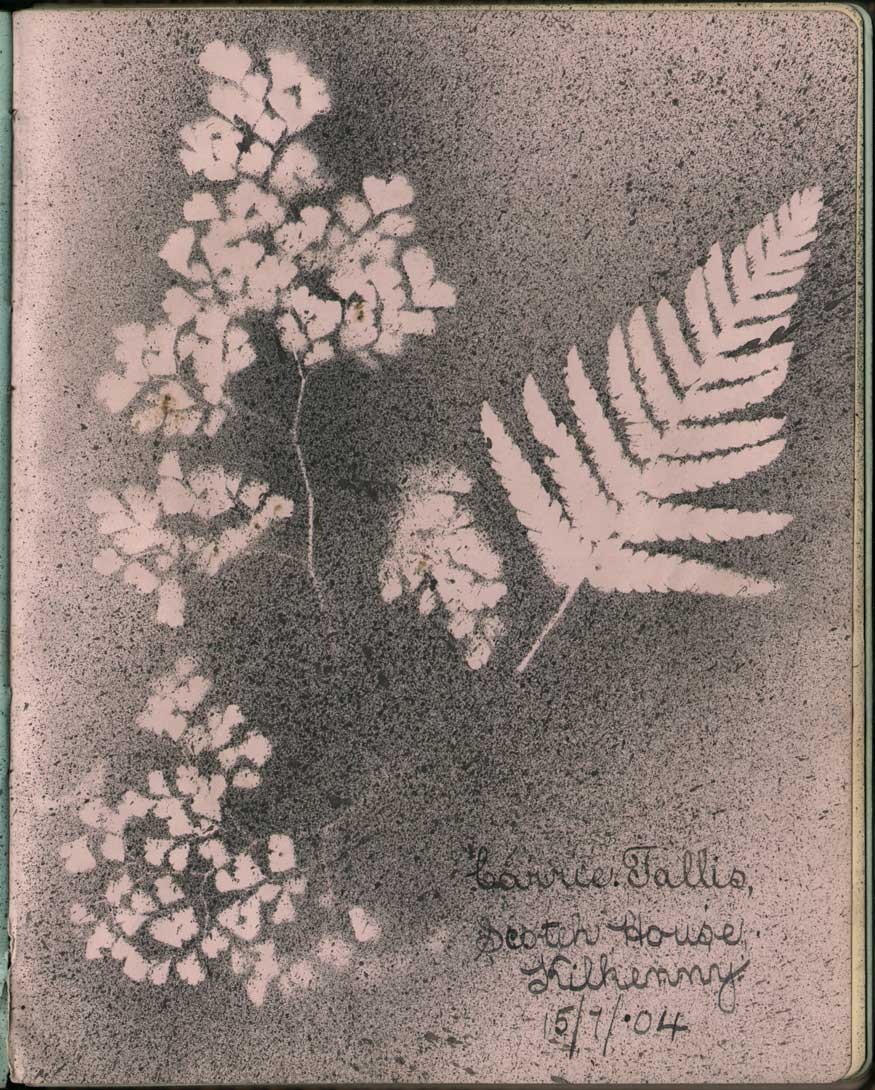 "Ink Splatter Photogram of Fern and Flowers on Paper", 1904: by amateur Irish artist Caroline Emily Tallis, (1889-1972) (21.9 x 17.2 cm): single page from English or Irish compiled Edwardian album signed lower right: "Carrie Tallis, Scotch House Kilkenny 15/7/04": from: PhotoSeed Archive
"Ink Splatter Photogram of Fern and Flowers on Paper", 1904: by amateur Irish artist Caroline Emily Tallis, (1889-1972) (21.9 x 17.2 cm): single page from English or Irish compiled Edwardian album signed lower right: "Carrie Tallis, Scotch House Kilkenny 15/7/04": from: PhotoSeed ArchiveOur very own Pencils of Nature.
An impression of ourselves for sure, but also quickly obliterated-or not, like nature herself. Photography in this form has in a way been part of Earth’s plant and animal fossil record stretching back millions of years, with Mankind’s permanent efforts barely stretching back to the early 19th Century.
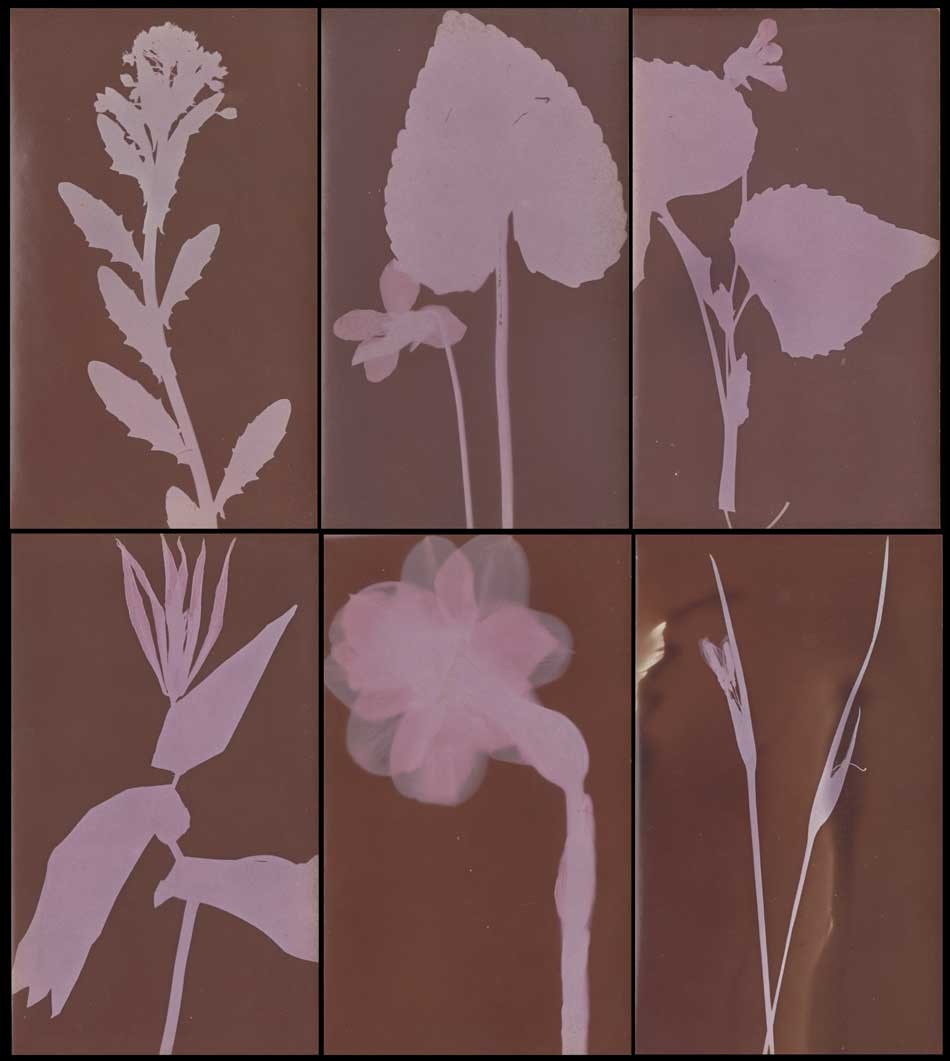 (6) individual Photograms, ca. 1925, by unknown American photographer on Kodak Self-Toning, single-weight glossy paper. (gelatin-silver developing out paper) each: 10.8 x 6.4 cm. Even before he discovered how to permanently "fix" what eventually became known as paper photographs in order to prevent their fading, Englishman William Henry Fox Talbot (1800-1877) first used his Photogenic Drawing method in 1834 to produce photograms. To do this he first placed a botanical specimen on a sheet of salt and silver nitrate-coated sheet of writing paper which produced a temporary, exact image of it when exposed to the Sun. Soon after, the lustrous blue Cyanotype process, perhaps best known today by the artistic plant studies perfected by Englishwoman Anna Atkins (1799-1871) made between 1843-53, gave way to even cheaper commercial methods for the photogram. Using store-bought, pre-sensitized photographic paper which home darkroom hobbyists readily exploited-similar to these examples- the art form was popularized even more in the early 20th Century. Specimens: top row, left to right: Shepherd's Purse, Purple Violet, Yellow Violet; Bottom row, left to right: Bell Wort, Narcissus, Blue-Eyed Grass. all from: PhotoSeed Archive
(6) individual Photograms, ca. 1925, by unknown American photographer on Kodak Self-Toning, single-weight glossy paper. (gelatin-silver developing out paper) each: 10.8 x 6.4 cm. Even before he discovered how to permanently "fix" what eventually became known as paper photographs in order to prevent their fading, Englishman William Henry Fox Talbot (1800-1877) first used his Photogenic Drawing method in 1834 to produce photograms. To do this he first placed a botanical specimen on a sheet of salt and silver nitrate-coated sheet of writing paper which produced a temporary, exact image of it when exposed to the Sun. Soon after, the lustrous blue Cyanotype process, perhaps best known today by the artistic plant studies perfected by Englishwoman Anna Atkins (1799-1871) made between 1843-53, gave way to even cheaper commercial methods for the photogram. Using store-bought, pre-sensitized photographic paper which home darkroom hobbyists readily exploited-similar to these examples- the art form was popularized even more in the early 20th Century. Specimens: top row, left to right: Shepherd's Purse, Purple Violet, Yellow Violet; Bottom row, left to right: Bell Wort, Narcissus, Blue-Eyed Grass. all from: PhotoSeed Archive
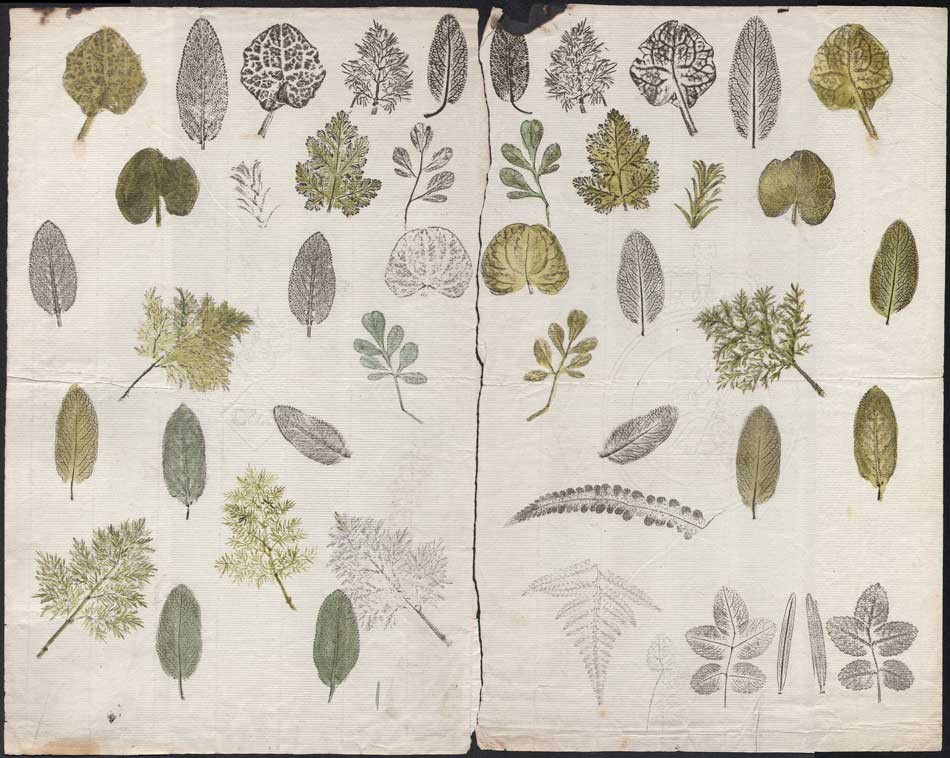 Nature prints: English: unknown maker: ca. 1775-1825: multiple, mirror impressions of unknown grass and leaf cluster specimens done with black printers ink & selective hand-coloring on laid paper leaf. (separated at middle) Britannia shield and C&S watermarks: 30.5 x 38.3 cm. Addressing an 1857 meeting of the Royal Society of the Arts, English Aesthetic Movement designer Christopher Dresser (1834-1904) gave the following historical account of the art of nature printing, of which this sheet is a rare surviving example, although ink rather than carbon black was used: "The earliest mode with which we are acquainted of producing impressions of plants was this:—The plant, after being dried, was held over the smoke of a candle or oil lamp, when it became blackened by a deposit of soot, after which it was placed between two sheets of paper and rubbed with a smoothing-bone, which caused the soot to leave the prominences of the leaf and adhere to the paper. In this way an impression of the plant was produced. This method of procuring impressions was employed as early as the year A.D. 1650." from: PhotoSeed Archive
Nature prints: English: unknown maker: ca. 1775-1825: multiple, mirror impressions of unknown grass and leaf cluster specimens done with black printers ink & selective hand-coloring on laid paper leaf. (separated at middle) Britannia shield and C&S watermarks: 30.5 x 38.3 cm. Addressing an 1857 meeting of the Royal Society of the Arts, English Aesthetic Movement designer Christopher Dresser (1834-1904) gave the following historical account of the art of nature printing, of which this sheet is a rare surviving example, although ink rather than carbon black was used: "The earliest mode with which we are acquainted of producing impressions of plants was this:—The plant, after being dried, was held over the smoke of a candle or oil lamp, when it became blackened by a deposit of soot, after which it was placed between two sheets of paper and rubbed with a smoothing-bone, which caused the soot to leave the prominences of the leaf and adhere to the paper. In this way an impression of the plant was produced. This method of procuring impressions was employed as early as the year A.D. 1650." from: PhotoSeed Archive
Enjoy this gallery of images celebrating the beauty of flora. From original Nature Prints ca. 1775-1825: inked leaves placed between a sheet of paper and pulled through a printing press; to mosaic red flowers adorning the head of a Roman goddess imagined by an artist around 250 A.D. transcribed and copied by the radical Talbotype process and published in 1850; to delicate British seaweeds copied into lead and printed 1859-60 to modern examples still nearly a century old: six silhouetted jewels ca. 1925 from the time photographic hobbyists gazed in wonderment at their first efforts emerging from developer trays in home darkrooms.
The Idea of Hawaii
Posted April 2015 in History of Photography, New Additions, Typography
In the public consciousness at least, Hawaii has probably not changed too much in the past 100 years. By this I mean an island chain of magnificent tropical beauty, mystery, and earthly delights with a strong emphasis on the natural world being the preferred vision for this place for many of us; with the realities of crime, squalor and all the other maladies undoubtedly present on some scale cast aside for the sake of bliss. You see, in this chaotic world, people need and want to believe utopia by the name Hawaii must exist.
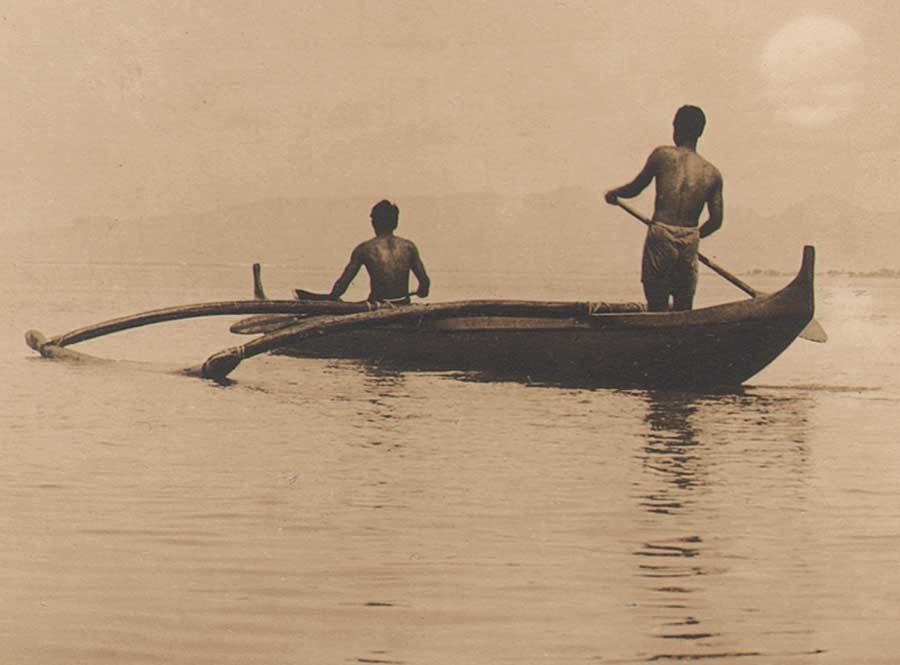 Detail: A.R. Gurrey Jr., American: "In measured tones subdued and low…" ca. 1910-20: vintage gelatin silver print from leaf included in volume "Idyls of Hawaii" (10.2 x 11.6 | 25.0 x 19.8 cm) Native Hawaiians are seen steering an outrigger canoe, possibly on Kaneohe Bay off the coast of Oʻahu. : From: PhotoSeed Archive
Detail: A.R. Gurrey Jr., American: "In measured tones subdued and low…" ca. 1910-20: vintage gelatin silver print from leaf included in volume "Idyls of Hawaii" (10.2 x 11.6 | 25.0 x 19.8 cm) Native Hawaiians are seen steering an outrigger canoe, possibly on Kaneohe Bay off the coast of Oʻahu. : From: PhotoSeed Archive
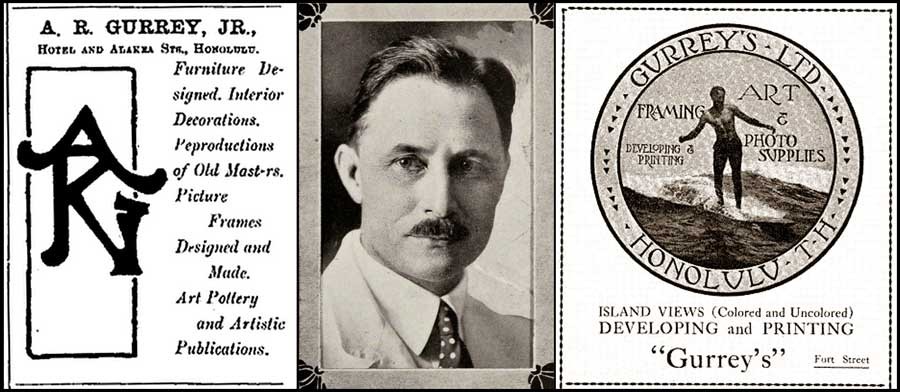 Left: first published version of A.R. Gurrey Jr. monogram from 1902 advertisement for his Honolulu store from "The Friend" magazine of that city. Middle: portrait of Gurrey Jr. published in "Men of Hawaii" from 1917. His WWI draft registration from 1918 listed his occupation as art dealer with his physical features being short, of medium build with gray eyes and brown hair. He lived with wife Caroline Haskins Gurrey, an accomplished portrait photographer, at 2512 Upper Manoa in Honolulu. Right: this circular logo for Gurrey's Ltd. located at 1066 Fort St. in Honolulu featured Duke Paoa Kahanamoku riding a surfboard. Open from late 1909 to 1923, the shop in a 1912 mention in Mid-Pacific magazine stated: "This Art and Photo Shop is the home of the Hawaiian Roycroftes, where you can see the work of the leading artists of the Islands, small views, native types and surfriders and other objects of art. Besides being the leading art shop, they are agents for the Ansco Cameras and Cyko Paper, with a developing and printing department that cannot be excelled." all images from: Hathi Trust.
Left: first published version of A.R. Gurrey Jr. monogram from 1902 advertisement for his Honolulu store from "The Friend" magazine of that city. Middle: portrait of Gurrey Jr. published in "Men of Hawaii" from 1917. His WWI draft registration from 1918 listed his occupation as art dealer with his physical features being short, of medium build with gray eyes and brown hair. He lived with wife Caroline Haskins Gurrey, an accomplished portrait photographer, at 2512 Upper Manoa in Honolulu. Right: this circular logo for Gurrey's Ltd. located at 1066 Fort St. in Honolulu featured Duke Paoa Kahanamoku riding a surfboard. Open from late 1909 to 1923, the shop in a 1912 mention in Mid-Pacific magazine stated: "This Art and Photo Shop is the home of the Hawaiian Roycroftes, where you can see the work of the leading artists of the Islands, small views, native types and surfriders and other objects of art. Besides being the leading art shop, they are agents for the Ansco Cameras and Cyko Paper, with a developing and printing department that cannot be excelled." all images from: Hathi Trust.
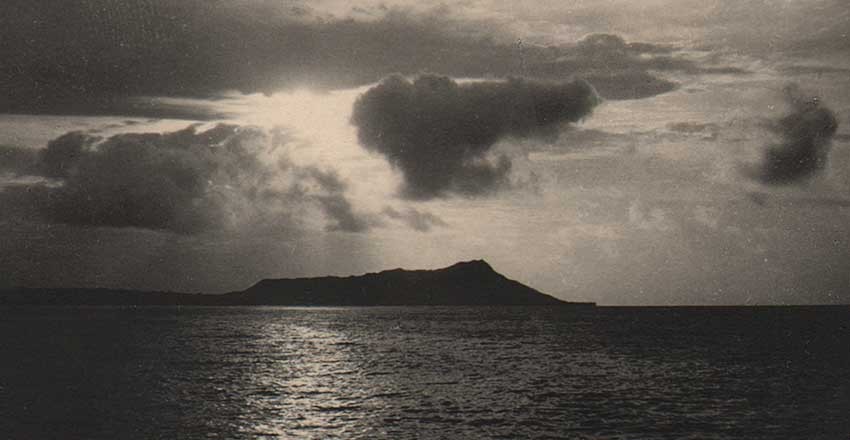 Detail: A.R. Gurrey Jr., American: "Old ocean singing a psalm of delight…" (ocean view of Diamond Head in silhouette) ca. 1910-20: vintage gelatin silver print from leaf included in volume "Idyls of Hawaii" (7.8 x 11.5 | 25.0 x 19.8 cm) : From: PhotoSeed Archive
Detail: A.R. Gurrey Jr., American: "Old ocean singing a psalm of delight…" (ocean view of Diamond Head in silhouette) ca. 1910-20: vintage gelatin silver print from leaf included in volume "Idyls of Hawaii" (7.8 x 11.5 | 25.0 x 19.8 cm) : From: PhotoSeed Archive
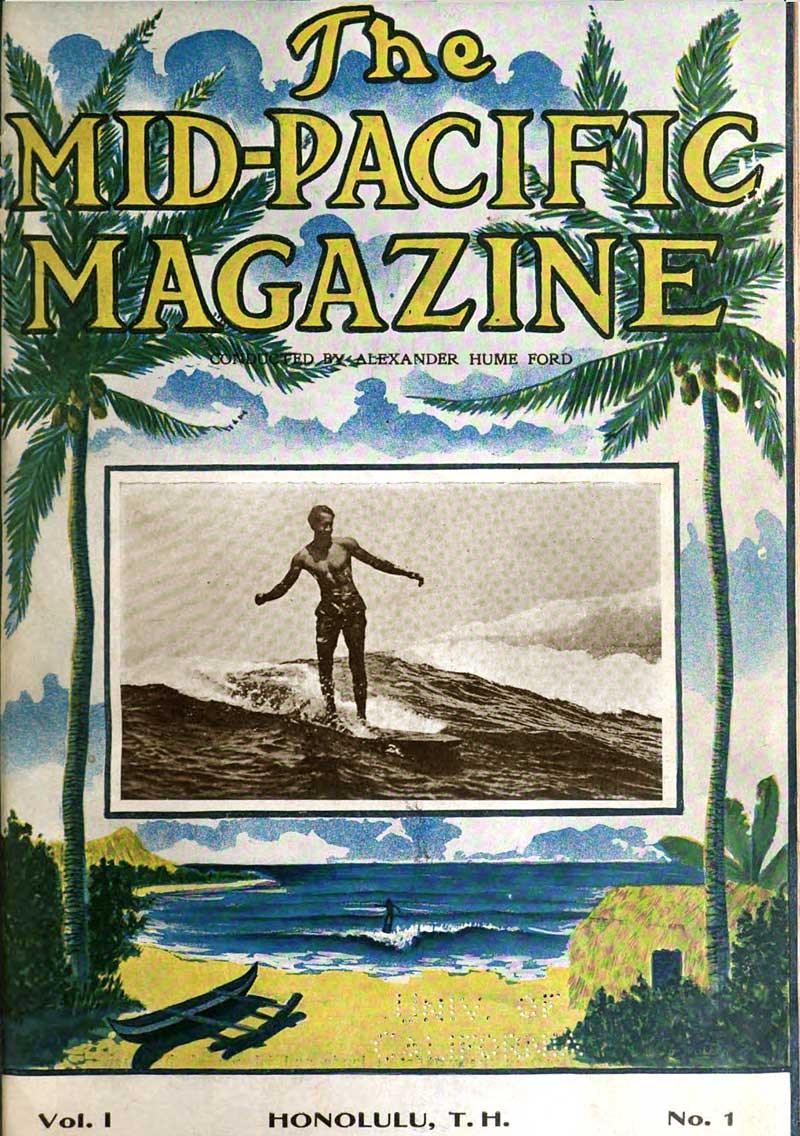 For the first issue of The Mid-Pacific Magazine in Jan., 1911, A.R.Gurrey Jr.'s photo from 1910 of Duke Kahanamoku riding a surfboard in Waikiki was published as part of the front color cover designed by artist Stuart S. Tabor. Acknowledged today as the father of surfing photography, Gurrey Jr.'s working methods in a 1912 article stated: "It necessitated going right out against the incoming surf, right at its height and meant invariably a swamping of the canoe and soaking for all in it. Mr. Gurrey felt amply repaid for his day's outing if at the end of the day he returned with his camera and one unspoiled negative out of twelve." from: Hathi Trust
For the first issue of The Mid-Pacific Magazine in Jan., 1911, A.R.Gurrey Jr.'s photo from 1910 of Duke Kahanamoku riding a surfboard in Waikiki was published as part of the front color cover designed by artist Stuart S. Tabor. Acknowledged today as the father of surfing photography, Gurrey Jr.'s working methods in a 1912 article stated: "It necessitated going right out against the incoming surf, right at its height and meant invariably a swamping of the canoe and soaking for all in it. Mr. Gurrey felt amply repaid for his day's outing if at the end of the day he returned with his camera and one unspoiled negative out of twelve." from: Hathi Trust
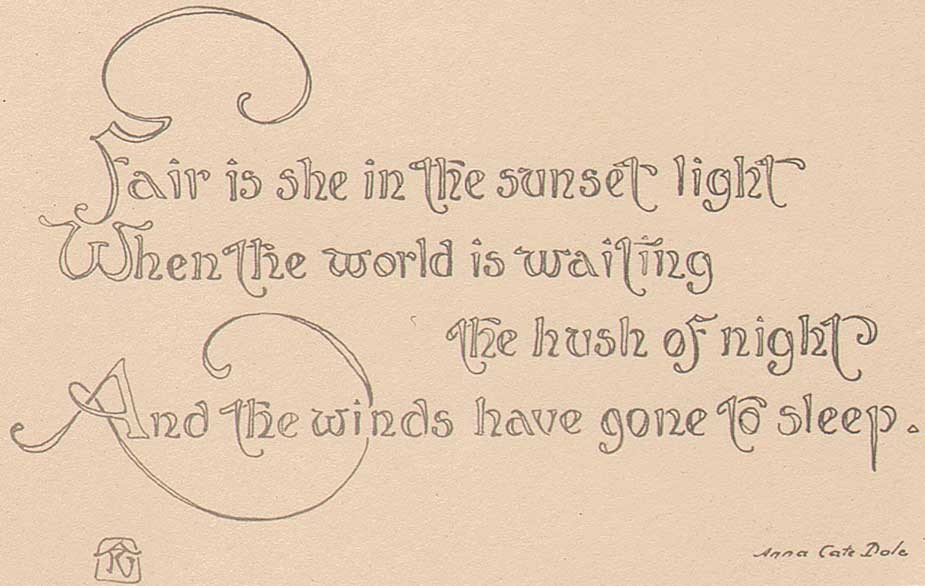 Detail: A.R. Gurrey Jr., American: photo-transfer of calligraphic text from poem "A Psalm for Hawaii" by Anna Cate Dole published in "Idyls of Hawaii" ca. 1910-20. Calligraphy was an important art-form practiced by Gurrey; so much so he often signed this work in "Idyls" using his stylized monogram seen above at lower left corner. from: PhotoSeed Archive
Detail: A.R. Gurrey Jr., American: photo-transfer of calligraphic text from poem "A Psalm for Hawaii" by Anna Cate Dole published in "Idyls of Hawaii" ca. 1910-20. Calligraphy was an important art-form practiced by Gurrey; so much so he often signed this work in "Idyls" using his stylized monogram seen above at lower left corner. from: PhotoSeed Archive
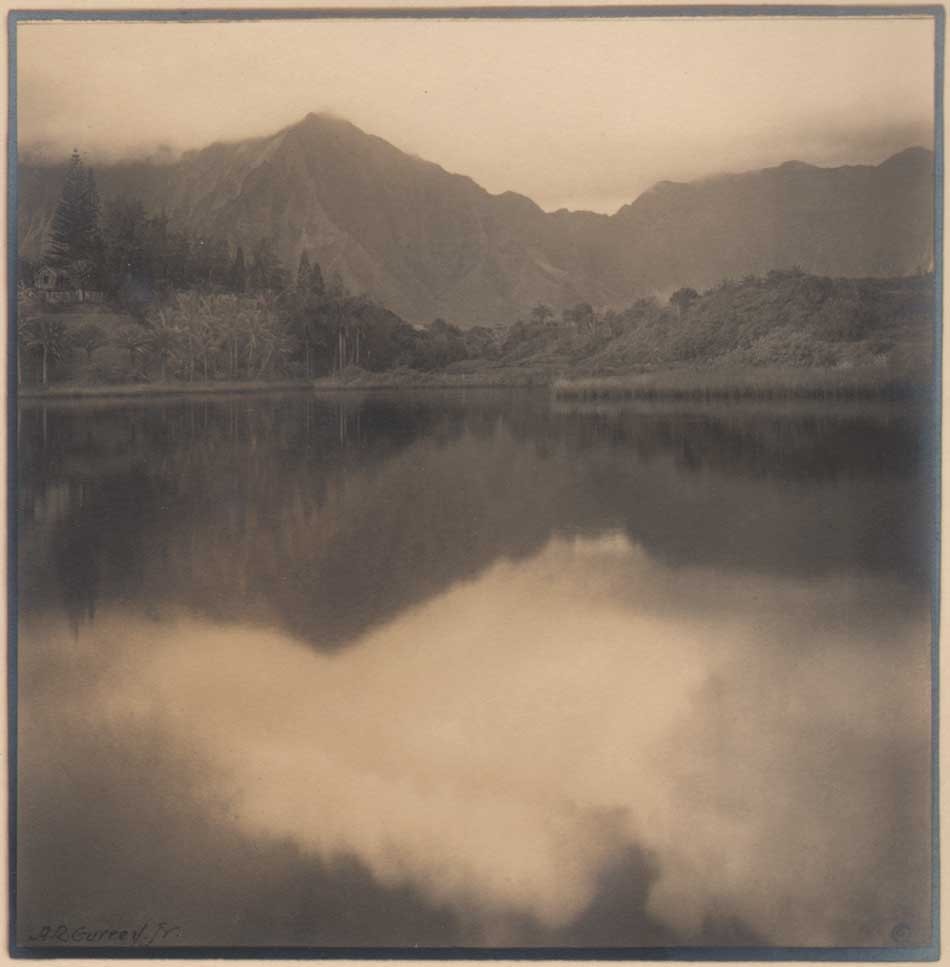 A.R. Gurrey Jr., American: "Fair is she in the morning light…" ca. 1910-20: vintage gelatin silver print used as frontis leaf included in volume "Idyls of Hawaii" (11.5 x 11.2 | 25.0 x 19.8 cm) Illustrating lines from the Anna Cate Dole poem "A Psalm for Hawaii" written ca. 1909, Gurrey's photograph of a mountainous Hawaiian landscape with her peaks and lake reflection shrouded in clouds confirms this place as idyllic. From: PhotoSeed Archive
A.R. Gurrey Jr., American: "Fair is she in the morning light…" ca. 1910-20: vintage gelatin silver print used as frontis leaf included in volume "Idyls of Hawaii" (11.5 x 11.2 | 25.0 x 19.8 cm) Illustrating lines from the Anna Cate Dole poem "A Psalm for Hawaii" written ca. 1909, Gurrey's photograph of a mountainous Hawaiian landscape with her peaks and lake reflection shrouded in clouds confirms this place as idyllic. From: PhotoSeed Archive
Photographer Alfred Richard Gurrey Jr. believed in that place. A Hawaiian transplant from San Francisco at the turn of the 20th Century, his beautiful photographs of the islands included in the self-published book Idyls of Hawaii ca. 1910-1920 now on this website is aptly titled, even if idyll is now spelled with two ls in the 21st. A truly renaissance man of the arts, his vision of beauty for a place we may never visit but hope to someday cannot help but give us all the hope we need in this hectic and often indifferent world- one where the idea of Hawaii can always be within reach. -David Spencer
Want to see more of this special place from long ago? click here
Beauty, Underwater
Posted October 2014 in History of Photography, New Additions, Scientific Photography, Significant Photographs
With Autumn upon us in the more seasonal regions of the United States, a remembrance, particularly if we are young, of the joys of cooling off in the lakes, ponds, and rivers of our youth.
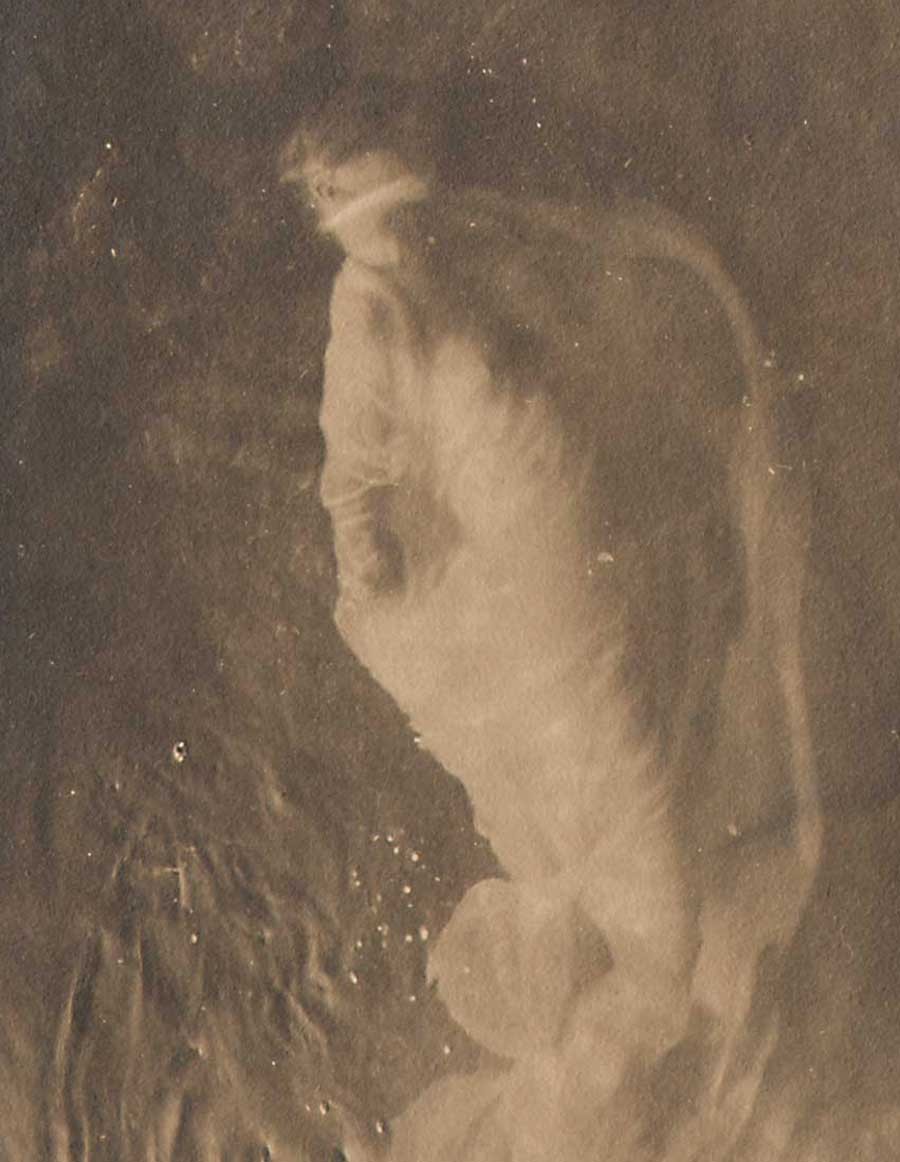 Detail: Gelatin silver print: "Mermaid Study : Ki-lo-des-ka": ca. 1914 or before: by Charlotte Vetter Gulick: image: 7.1 x 9.2 cm: mount: 16.7 x 22.7 cm. Subject shows Katharine "Kitty" Gulick swimming underwater at Camp Wohelo in Maine. from: PhotoSeed Archive
Detail: Gelatin silver print: "Mermaid Study : Ki-lo-des-ka": ca. 1914 or before: by Charlotte Vetter Gulick: image: 7.1 x 9.2 cm: mount: 16.7 x 22.7 cm. Subject shows Katharine "Kitty" Gulick swimming underwater at Camp Wohelo in Maine. from: PhotoSeed Archive
Memories made all the more indelible if we ever had the opportunity to attend summer camp.
So lets go further and think about taking a photograph of someone underwater. Not a photo taken with a camera underwater, a remarkable feat in itself accomplished beginning in 1893 by the Frenchman Louis Boutan, (1.) but from the outside looking in.
Before researching a series of photographs recently acquired for this archive showing a young woman swimming underwater, I would have thought no big deal- perhaps they were rare but could the subject matter actually be unique? After all, they were first published for a mass audience in Everybody’s Magazine in the U.S. in August of 1914, with the author exclaiming them to be “remarkable photographs…taken under conditions not easily duplicated, and have aroused great interest among artists and others who have seen the originals.” (2.)
No doubt other examples of this activity exist in the form of vintage photographs. Snapshots perhaps-but ones where actual intent existed in order to show the beauty of the human figure swimming underwater? Before or perhaps a decade or two after 1914? Somehow I doubt it. ✻
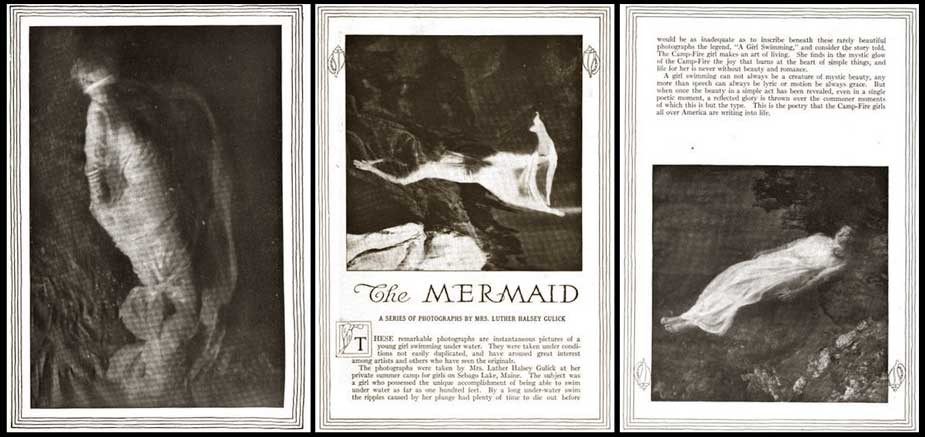 Three individual halftone and letterpress page spreads showing mermaid "Ki-lo-des-ka" (Katharine "Kitty" Gulick) swimming and lying submerged underwater: from: Everybody’s Magazine: New York: August, 1914: pp. 225-232
Three individual halftone and letterpress page spreads showing mermaid "Ki-lo-des-ka" (Katharine "Kitty" Gulick) swimming and lying submerged underwater: from: Everybody’s Magazine: New York: August, 1914: pp. 225-232
With a bit of research, I not only discovered the subject of the “mermaid” doing the swimming in the photos: Katharine “Kitty” Gulick, (1895-1968) but the remarkable story behind the amateur photographer who took them: her mother Charlotte Vetter Gulick. (1865-1928) Taken at Wohelo girls summer camp on the shore of Sebago Lake in Raymond, Maine, a camp founded in 1907 by Gulick and husband Luther Halsey Gulick (1865-1918) that is still going strong today, the following article from Everybody’s explains how these remarkable photos were taken and provides guiding principals behind the Camp Fire Girl movement founded by the photographer herself.
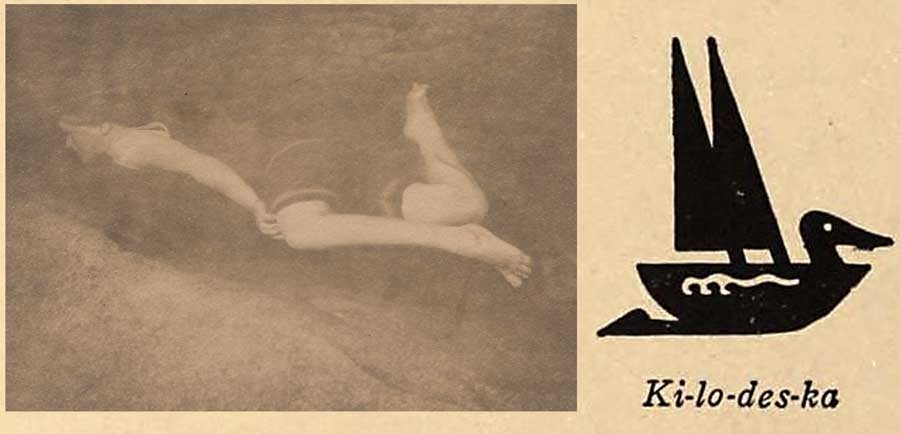 inset: detail: Gelatin silver print: "Mermaid Study : Ki-lo-des-ka" ca. 1914 or before: by Charlotte Vetter Gulick: image: 8.1 x 10.5 cm: mount: 16.8 x 23.2 cm: This was an early effort showing "Kitty" wearing a dark-colored bathing-suit "which was too nearly the tone of the rocks to give definition" before the garment was substituted for "a flowing garment of cheese-cloth" which showed up much better against the darkness of the water.: from: PhotoSeed Archive. Background: Camp Wohelo Indian symbol for "Ki-lo-des-ka" aka: "Water-bird": from 1915 volume by Ethel Rogers: "Sebago-Wohelo Camp Fire Girls"
inset: detail: Gelatin silver print: "Mermaid Study : Ki-lo-des-ka" ca. 1914 or before: by Charlotte Vetter Gulick: image: 8.1 x 10.5 cm: mount: 16.8 x 23.2 cm: This was an early effort showing "Kitty" wearing a dark-colored bathing-suit "which was too nearly the tone of the rocks to give definition" before the garment was substituted for "a flowing garment of cheese-cloth" which showed up much better against the darkness of the water.: from: PhotoSeed Archive. Background: Camp Wohelo Indian symbol for "Ki-lo-des-ka" aka: "Water-bird": from 1915 volume by Ethel Rogers: "Sebago-Wohelo Camp Fire Girls"
Illustrating the article were eight photographs of Wohelo camper “Ki-lo-des-ka”, or “Water-bird”, the aforementioned “Kitty” Gulick, with several of the originals formerly owned by her appearing with this post:
The Mermaid
A SERIES OF PHOTOGRAPHS BY MRS. LUTHER HALSEY GULICK
THESE remarkable photographs are instantaneous pictures of a young girl swimming under water. They were taken under conditions not easily duplicated, and have aroused great interest among artists and others who have seen the originals. The photographs were taken by Mrs. Luther Halsey Gulick at her private summer camp for girls on Sebago Lake, Maine. The subject was a girl who possessed the unique accomplishment of being able to swim under water as far as one hundred feet. By a long under-water swim the ripples caused by her plunge had plenty of time to die out before she passed the rock on which Mrs. Gulick stood with the camera.
The experiments were made on a brilliantly clear day. The water also was extraordinarily clear and the swimmer passed the camera’s field two or three feet below the surface. The final clue to success was found when a flowing garment of cheese-cloth was substituted for the dark-colored bathing-suit, which was too nearly the tone of the rocks to give definition. Both the figure and the draperies, under the equalizing buoyancy of the water, give a rare representation of poise, as they are entirely unaffected by the force of gravity.
How far short this description fails of conveying the art value of the photographs, their rhythm of line and beauty of form and tone, is significantly obvious; for in this margin of appeal to the imagination lies the motive that produced the pictures. They were taken at the birthplace of the Camp-Fire idea of which Mrs. Gulick is one of the chief sponsors.
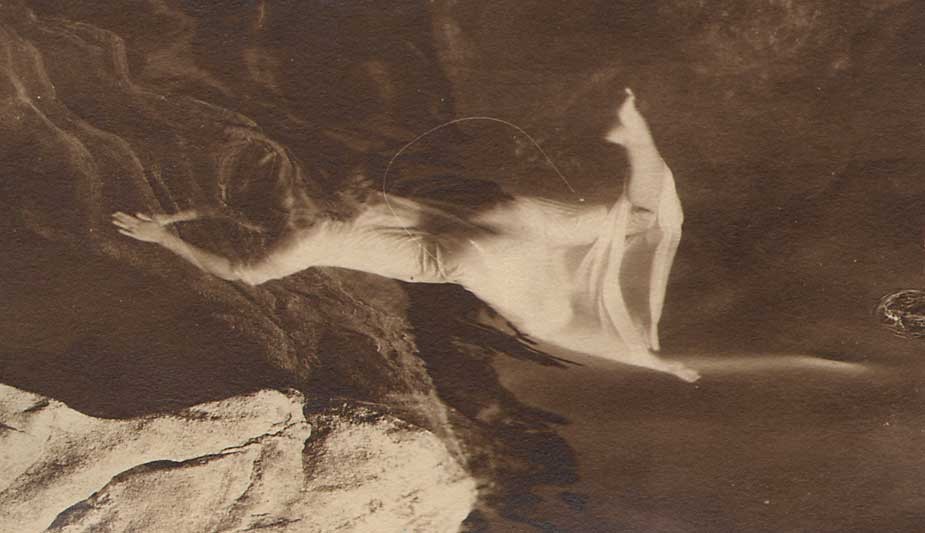 Detail: Gelatin silver or Bromide print: "Mermaid Swimming" ("Ki-lo-des-ka") ca. 1914 or before: by Charlotte Vetter Gulick: image: 8.7 x 11.2 cm: mount: 16.5 x 22.9 cm: reproduced as opening photo for article "The Mermaid" A SERIES OF PHOTOGRAPHS BY MRS. LUTHER HALSEY GULICK: in Everybody’s Magazine: New York: August, 1914: p. 225: note: hair at center of frame result of negligence from contact-printing from original negative. from: PhotoSeed Archive
Detail: Gelatin silver or Bromide print: "Mermaid Swimming" ("Ki-lo-des-ka") ca. 1914 or before: by Charlotte Vetter Gulick: image: 8.7 x 11.2 cm: mount: 16.5 x 22.9 cm: reproduced as opening photo for article "The Mermaid" A SERIES OF PHOTOGRAPHS BY MRS. LUTHER HALSEY GULICK: in Everybody’s Magazine: New York: August, 1914: p. 225: note: hair at center of frame result of negligence from contact-printing from original negative. from: PhotoSeed Archive
The photographs are a suggestive interpretation of the first law of the Camp-Fire, “Seek beauty;” a revelation of the poetic side of one of the simple, wholesome, normal acts of life. This is the principle, full of possibilities yet undeveloped, upon which the Camp-Fire ceremonial and symbolism are based.
The first ideal of the Camp-Fire girl is the development of a well proportioned physique; a body under perfect control and responsive to every call of the spirit within. Her other ideals include an all-around training in the art of home-keeping in the modern sense, which involves a knowledge of community conditions as well as of the simple processes of home activity. This points to the further ideal of patriotism in the sense of loyalty to country, to church, to humanity, and of service in its broadest meaning.
But to hold forth these aims and say “These are the Camp-Fire” would be as inadequate as to inscribe beneath these rarely beautiful photographs the legend, “A Girl Swimming,” and consider the story told. The Camp-Fire girl makes an art of living. She finds in the mystic glow of the Camp-Fire the joy that burns at the heart of simple things, and life for her is never without beauty and romance.
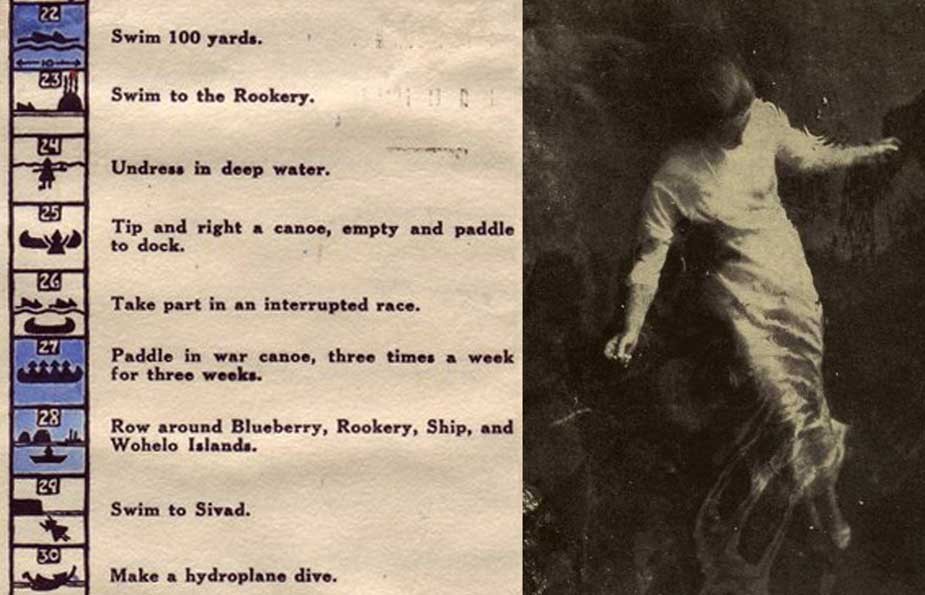 Left: example of Camp Wohelo water-related challenge symbol badges from 1920 Wohelo camp yearbook: courtesy: Gulick Family. Right: detail: full-page halftone: "Ki-lo-des-ka swimming under water" : from 1915 volume by Ethel Rogers: "Sebago-Wohelo Camp Fire Girls"
Left: example of Camp Wohelo water-related challenge symbol badges from 1920 Wohelo camp yearbook: courtesy: Gulick Family. Right: detail: full-page halftone: "Ki-lo-des-ka swimming under water" : from 1915 volume by Ethel Rogers: "Sebago-Wohelo Camp Fire Girls"
A girl swimming can not always be a creature of mystic beauty, any more than speech can always be lyric or motion be always grace. But when once the beauty in a simple act has been revealed, even in a single poetic moment, a reflected glory is thrown over the commoner moments of which this is but the type. This is the poetry that the Camp-Fire girls all over America are writing into life. (3.)
Camp Fire Girls, Basket Ball and More
Born Emma L. Vetter on Dec. 12, 1865 in Oberlin, Ohio to missionary parents, (4.) Charlotte “Lottie” Gulick was educated in Kansas public schools and undertook her secondary education at Washburn College (now Washburn University) in Topeka, Kansas doing college preparatory work. She then matriculated and earned a bachelor of arts degree from Drury College in Springfield, MO. (5.) It was at Drury that she met Luther Halsey Gulick , (1865-1918) whom she married in 1887.
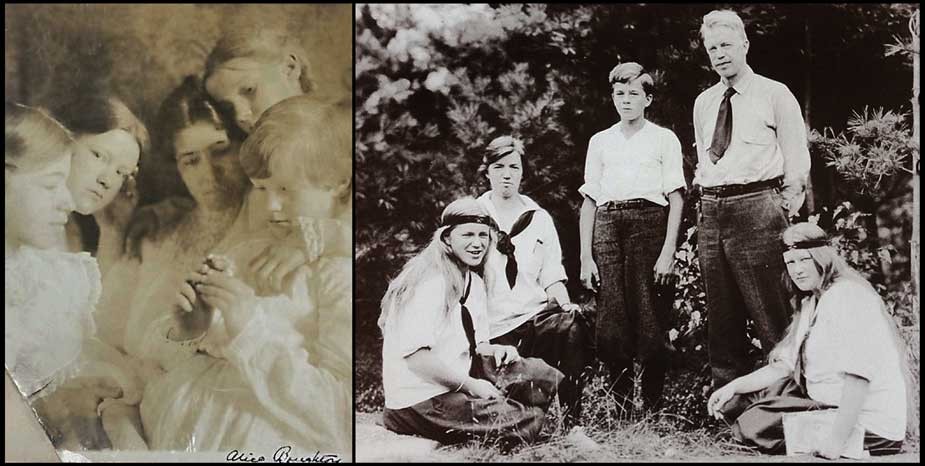 Left: photographer Charlotte Vetter Gulick is at center surrounded by her four daughters. Photograph by Alice Boughton ca. 1900. Katharine (Ki-lo-des-ka) is believed to be at right holding a flower. Reproduced later as an engraving in a New York Times article profiling the new Campfire Girls of America organization: "Girls take up the Boy Scout Idea and Band Together" (March 17, 1912) (private collection) Right: detail: members of the Gulick family from a photograph most likely taken by Charlotte Gulick around 1911. From left to right: Katharine "Kitty" Gulick (Curtis) (1895-1968); Frances "Franta" Gulick(1891-1936); Halsey Gulick; Dr. Luther Halsey Gulick (Timanous-1865-1918); Louise Gulick. (1888-1941): courtesy: Gulick Family
Left: photographer Charlotte Vetter Gulick is at center surrounded by her four daughters. Photograph by Alice Boughton ca. 1900. Katharine (Ki-lo-des-ka) is believed to be at right holding a flower. Reproduced later as an engraving in a New York Times article profiling the new Campfire Girls of America organization: "Girls take up the Boy Scout Idea and Band Together" (March 17, 1912) (private collection) Right: detail: members of the Gulick family from a photograph most likely taken by Charlotte Gulick around 1911. From left to right: Katharine "Kitty" Gulick (Curtis) (1895-1968); Frances "Franta" Gulick(1891-1936); Halsey Gulick; Dr. Luther Halsey Gulick (Timanous-1865-1918); Louise Gulick. (1888-1941): courtesy: Gulick Family
A strong advocate in the promotion of physical eduction as well as an organizer and author in his professional life, Dr. Luther Halsey Gulick also came from a missionary family, his father being missionary physician Luther Halsey Gulick Sr. (1828–1891) Receiving his medical degree from New York University in 1889, Dr. Gulick is perhaps best remembered today for his role in the development of the game of basketball, although this is but an interesting side story of a remarkable life. In 1891, while superintendent of the physical education department at the International YMCA Training School in Springfield, MA., (now Springfield College) he became the catalyst and inspiration for colleague James Naismith to first draw up rules for the new game of “Basket Ball”, with a peach basket nailed above the inside of a gymnasium playing court serving as the goal. His beliefs, as embodied in a poster issued after his death, were in the
”unity of body, mind and spirit, and in an education which includes all three. He devoted his life to establishing this ideal, by emphasizing the social and ethical values of physical exercise, especially through play and recreation.”
While at the YMCA, he was also responsible for designing the triangular logo which represented the YMCA philosophy of Mind, Body and Spirit. (6.)
Summer camp was an activity the Gulicks thrived on and made a lifestyle out of. Beginning in 1887, a year before their first child Louise was born, they established a camp on the shores of the Thames River in Gales Ferry CT. Co-educational, with the couples friends as well as extended Gulick family members acting as counselors to their own children and others, (7.) it operated for 20 years. In order to share what was learned to a larger audience of girls, the couple then established Camp Wohelo on Sebago Lake in 1907. An acronym comprised of the three virtues of work, health, and love, Wohelo was embodied from the start as outlined in 1915 by Charlotte Vetter Gulick:
I believe deeply and earnestly that spiritual health and development is a direct corollary of bodily vigor and control; that the joy that comes from the exercise of efficient muscles has its counterpart in the soul; that to exercise the one is to exercise the other.
Upon that rock has Wohelo been built, and its use of symbols is, perhaps, more than anything else, a working and ever-present declaration of the spiritual values inherent in all the humblest phases of our everyday life in the world. (8.)
 Detail: "Mermaid Study : Submerged": Gelatin silver print: ca. 1914 or before: by Charlotte Vetter Gulick: image: 8.4 x 10.8 cm: mount: 16.7 x 22.7 cm. : reproduced as final photo for article "The Mermaid" A SERIES OF PHOTOGRAPHS BY MRS. LUTHER HALSEY GULICK: in Everybody’s Magazine: New York: August, 1914: p. 232: from: PhotoSeed Archive
Detail: "Mermaid Study : Submerged": Gelatin silver print: ca. 1914 or before: by Charlotte Vetter Gulick: image: 8.4 x 10.8 cm: mount: 16.7 x 22.7 cm. : reproduced as final photo for article "The Mermaid" A SERIES OF PHOTOGRAPHS BY MRS. LUTHER HALSEY GULICK: in Everybody’s Magazine: New York: August, 1914: p. 232: from: PhotoSeed Archive
Five years before this philosophy was written, in 1910, Charlotte Gulick, known by her symbolic Indian name at the Wohelo camp as Hiiteni, which translated to “Life, more life”, came up with the idea for the Camp Fire Girls movement. An organization for girls much as the Boy Scouts of America was structured for boys, and coincidentally founded the same year, Camp Fire Girls promoted all the values she and her husband had already been teaching at their earlier camp at Gales Ferry and at Wohelo:
”The idea originated in the mind of Mrs. Gulick, and was at once indorsed by Dr. Gulick, who believes it to be logical and necessary to proper development of girls amid the changing conditions of our National life.” (9.)
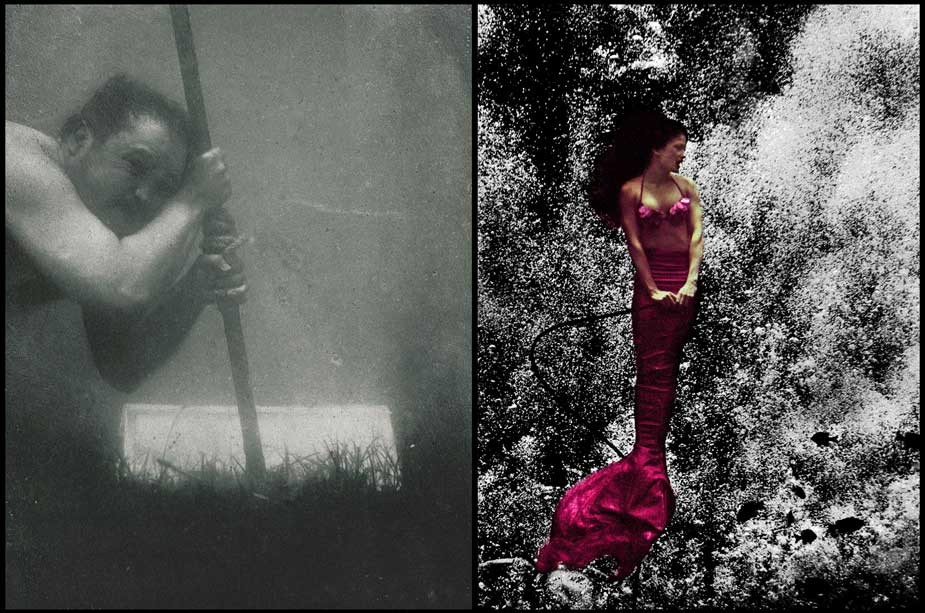 Left: detail: photo by "David": title: "Portrait Instantané D'un Plongeur" ("Instant Portrait of a Diver") : photogravure plate XI by Paul Dujardin showing French underwater photography pioneer Louis Marie-Auguste Boutan (1859-1934) holding himself steady underwater: from: 1900 volume "La Photographie Sous-Marine et Les Progres de La Photographie" (The Progress of Underwater Photography) (between pp. 210-211) : Gallica: National Library of France online resource. Right: a modern-day mermaid: Nicole Marino plays the starring role in "The Little Mermaid" at Florida's Weeki Wachee Springs Waterpark. In 1947, former Navy frogman Newton Perry conceived of the idea of using an air hose and perfected "hose breathing" here. Culturally, mermaids are a tourist attraction, and have entered the popular imagination through films like "The Incredible Mr. Limpet" starring Don Knotts. (1964): 1999 photo by David Spencer/The Palm Beach Post
Left: detail: photo by "David": title: "Portrait Instantané D'un Plongeur" ("Instant Portrait of a Diver") : photogravure plate XI by Paul Dujardin showing French underwater photography pioneer Louis Marie-Auguste Boutan (1859-1934) holding himself steady underwater: from: 1900 volume "La Photographie Sous-Marine et Les Progres de La Photographie" (The Progress of Underwater Photography) (between pp. 210-211) : Gallica: National Library of France online resource. Right: a modern-day mermaid: Nicole Marino plays the starring role in "The Little Mermaid" at Florida's Weeki Wachee Springs Waterpark. In 1947, former Navy frogman Newton Perry conceived of the idea of using an air hose and perfected "hose breathing" here. Culturally, mermaids are a tourist attraction, and have entered the popular imagination through films like "The Incredible Mr. Limpet" starring Don Knotts. (1964): 1999 photo by David Spencer/The Palm Beach Post
Today, the history of the Gulick’s shared virtues of work, health and love continue on in the summer operation of their Maine camps. In a promotional 1919 silent film on Wohelo released a year before women in the United States had the Constitutional protection of the right to vote, these changing conditions of America’s National life for young women were on display. Seated in teams of coordinated paddlers in three large over-sized canoes on Lake Sebago, the ideals of resourcefulness in working together shown in the film remains an ideal for young women still valued today.
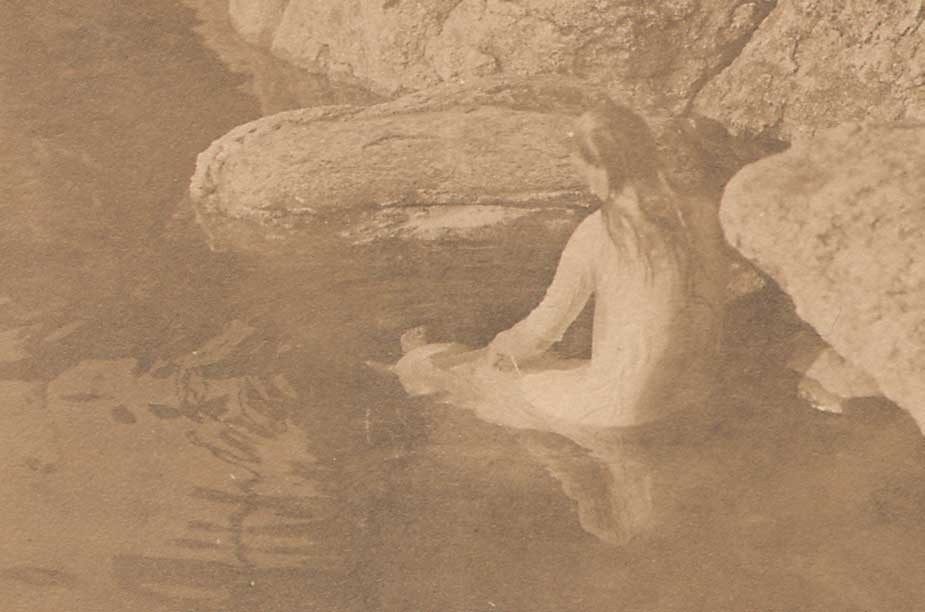 Detail: "Mermaid Sunbathing " ("Kitty" Gulick) : Gelatin silver print: ca. 1914 or before: by Charlotte Vetter Gulick: image: 7.3 x 10.8 cm: mount: 17.0 x 22.5 cm. : In this photo, a figure study of Katharine "Kitty" Gulick by her mother, "Ki-lo-des-ka" sunbathes next to granite boulders on the Sebago Lake shoreline in Maine.: from: PhotoSeed Archive
Detail: "Mermaid Sunbathing " ("Kitty" Gulick) : Gelatin silver print: ca. 1914 or before: by Charlotte Vetter Gulick: image: 7.3 x 10.8 cm: mount: 17.0 x 22.5 cm. : In this photo, a figure study of Katharine "Kitty" Gulick by her mother, "Ki-lo-des-ka" sunbathes next to granite boulders on the Sebago Lake shoreline in Maine.: from: PhotoSeed Archive
Much like these photos of Ki-lo-des-ka the mermaid, “her yellow hair glinting golden in the sunshine” (10.) reveal beauty to us in the physical form, lines from a poem by Ralph Waldo Emerson cited by the amateur photographer Charlotte Gulick after she mastered the art of water diving at the age of 35 brings forth a desire in the human spirit to symbolically enter the depths as well:
”To vision profounder
Man’s spirit must dive.“ (11.)
Notes:
1. Louis Marie-Auguste Boutan. (1859-1934) Boutan used specially-designed underwater camera housings, publishing his research conducted from 1892-1900 for a large audience in the 1900 volume “La Photographie Sous-Marine et Les Progres de La Photographie”. (The Progress of Underwater Photography)
2. from: The Mermaid: in: Everybody’s Magazine: New York: The Ridgway Company Publishers: August, 1914: p. 225
3. Ibid: pp. 225-232
4. 1870 U.S. Census. Gulick changed her name to Charlotte sometime after 1900 but was known as “Lottie”
5. Gulick background: Margaret R. and Dennis S. O’Leary: Adventures at Wohelo Camp - Summer of 1928: 2011: iUniverse: p. 24
6. 1921 poster of Luther Halsey Gulick: Makers of American Ideals poster issued by the National Child Welfare Association: Springfield College Digital online resource accessed Oct., 2014
7. background: Camp Timanous website accessed Oct., 2014. Owned by the Suitor family since the 1930’s, the camp was originally founded by Luther Halsey Gulick in 1917, whose symbolic Indian name Timanous- was “Guiding Spirit”. In the introduction to the 1915 Sebago-Wohelo Camp Fire Girls volume, Charlotte Gulick states as many as 75 people camped together at Gales Ferry before Wohelo was established.
8. excerpt: Introduction: Mrs. Luther Halsey Gulick: Ethel Rogers: Sebago-Wohelo Camp Fire Girls: Battle Creek, MI: Good Health Publishing Company: 1915: pp. 22-23
9. excerpt: Girls Take up the Boy Scout Idea and Band Together: Edward Marshall: in: The New York Times: March 17, 1912
10. Sebago-Wohelo Camp Fire Girls: p. 94
11. Ibid: p. 22
✻ : and of course I’m happy to be corrected
The Permanence of Disruption
Posted August 2014 in History of Photography, Painters|Photographers, Photography, Publishing, Significant Photographers
By all accounts, Scotsman David Octavius Hill, (1802-1870) Secretary of the Royal Scottish Academy of Fine Arts in Edinburgh, was an accomplished landscape painter. Thankfully, for the nascent medium of photography beginning around 1843, he is not remembered for that. Blame the Disruption, if you will.
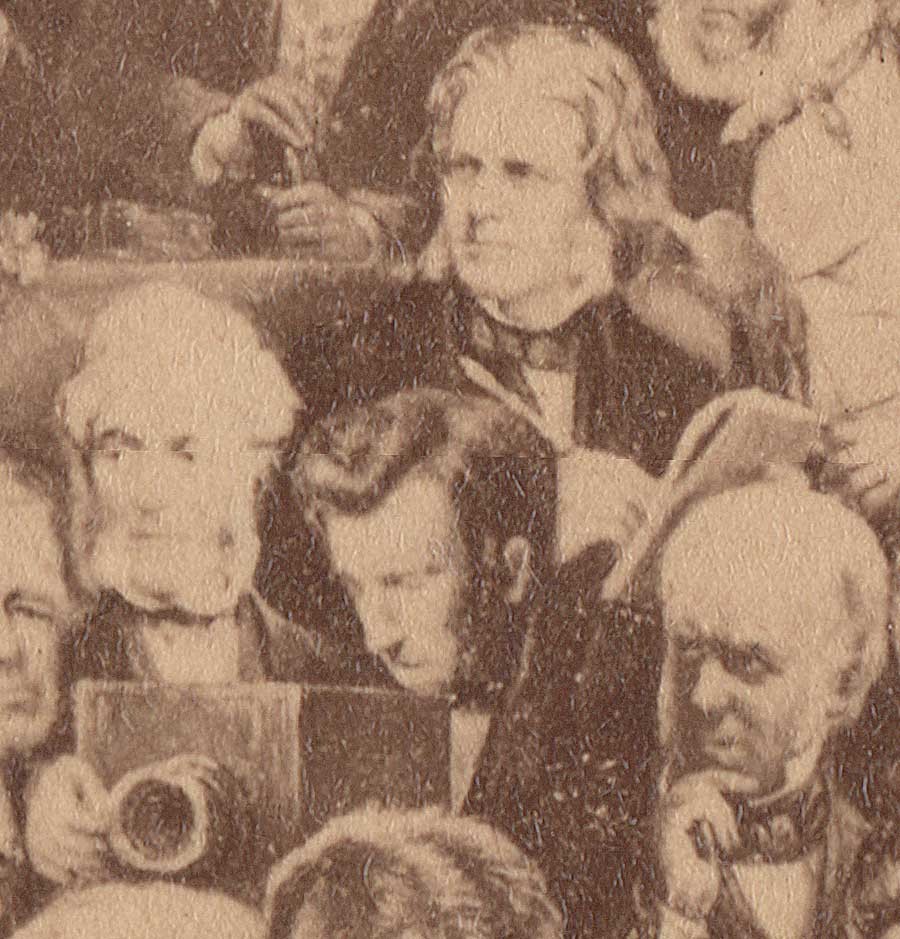 Detail: 1868: Artist David Octavius Hill with sketchpad at top; Photographer Robert Adamson behind wooden box camera at bottom. : Thomas Annan: vintage carbon copy photograph after D.O. Hill painting: "The Disruption of the Church of Scotland"completed 1866: original: (13.5 x 31.4 cm | 34.4 x 41.4 cm ) : from: PhotoSeed Archive
Detail: 1868: Artist David Octavius Hill with sketchpad at top; Photographer Robert Adamson behind wooden box camera at bottom. : Thomas Annan: vintage carbon copy photograph after D.O. Hill painting: "The Disruption of the Church of Scotland"completed 1866: original: (13.5 x 31.4 cm | 34.4 x 41.4 cm ) : from: PhotoSeed Archive
Disruption with a capitol D? He didn’t know it at the time, but when the freethinking Hill, a devout churchman seen above in detail in his own painting, sketchpad in hand, attended what became known as the Disruption: or, the historical occasion of Scottish religious free will known as the First General Assembly of the Free Church of Scotland signing the Act of Separation and Deed of Demission at Edinburgh’s Tanfield Hall, the artistic potential of photography would soon stake its’ own claim among the arts.
The Scots are Coming
Admittedly, the focus of this website doesn’t claim any great insights into the evolution of early photography, with the exception that certain photographers, those being the team of Hill and fellow Scotsman Robert Adamson, (1821-1848) popularly known as “Hill & Adamson”, are profoundly important to our understanding of artistic developments in relation to photography that came later in the 19th Century. Similar to the concept of how precedent by itself can build a case in the courtroom or in the more democratic court of public opinion, the reach of Hill & Adamson through their artistic achievement, especially in portraiture, impacted greatly the later working methods of many photographers and in particular, the eventual achievement of two fellow Scots who came into their orbit: Thomas Annan and his son James Craig Annan beginning around 1865 and in the early 1890’s.
As for that “Disruption” in relation to Hill’s completion 23 years later of an over-sized painting commemorating the event, the decision to separate from the accepted order gave former Church of Scotland congregations the freedom from central Church control to choose their own ministers, among other religious freedoms. For this alone, photography’s potential was nicely summed up in the London Art-Union journal in late 1869:
To photography Mr. Hill, soon after its discovery, about the year 1843, gave much attention, and we shall not be wrong in assigning him the credit of giving to the process its first artistic impetus; and, in conjunction with his friend, Mr. R. Adamson, of having produced many specimens of the Talbotype as yet unsurpassed for high artistic qualities. (1.)
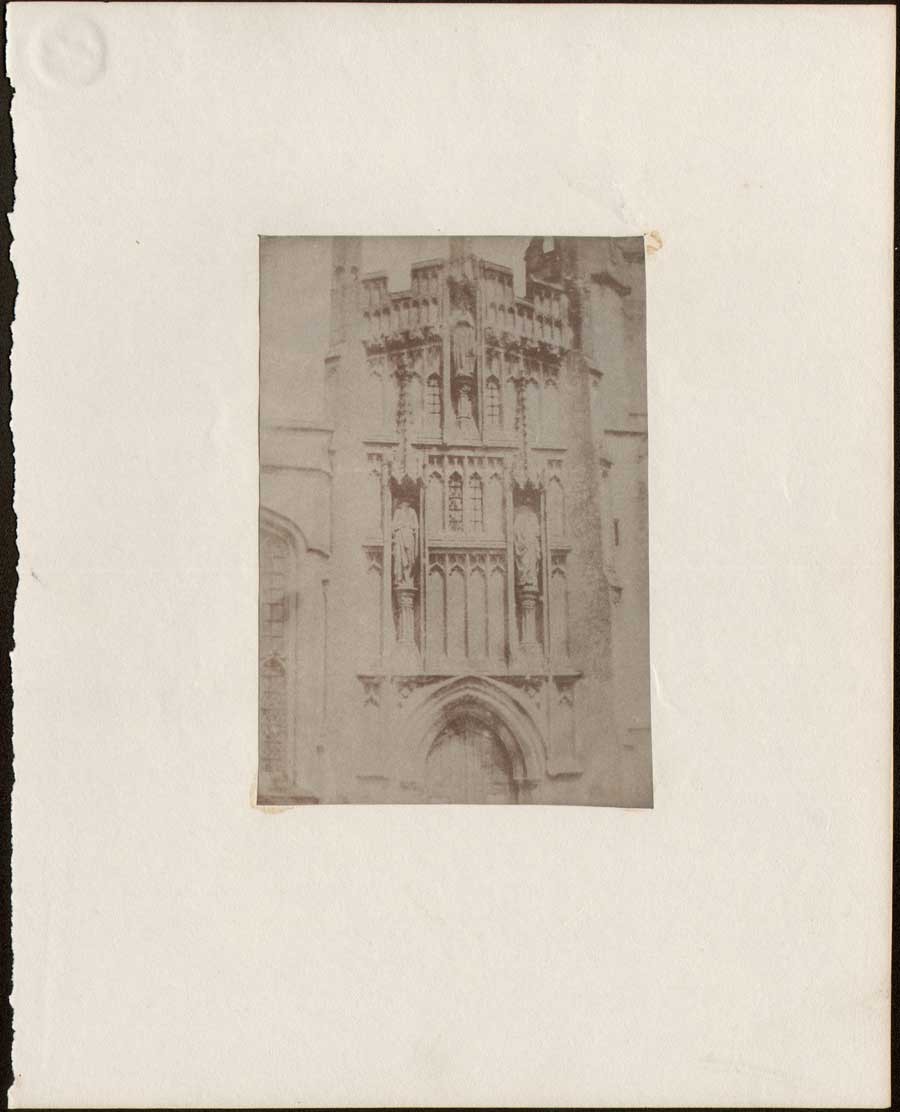 Example of vintage mounted salt print from calotype negative:(trimmed) : ca. 1845-1855: unknown photographer and location: detail from facade of English or Continental church building: ca. 1845-55: 12.8 x 8.8 | 24.9 x 19.9 cm: from PhotoSeed Archive
Example of vintage mounted salt print from calotype negative:(trimmed) : ca. 1845-1855: unknown photographer and location: detail from facade of English or Continental church building: ca. 1845-55: 12.8 x 8.8 | 24.9 x 19.9 cm: from PhotoSeed Archive
Thank the Calotype
Because the patent restricting Englishman William Henry Fox-Talbot’s 1841 invention of the Calotype process did not apply in Scotland, Hill & Adamson were able to exploit it to full potential. I’ve uploaded an example above, which in viewable form is technically known as a salted paper print from a calotype negative, for comparison. A survivor showing a bit of Gothic architectural detail, it was most likely done between 1845-1855 and found tucked between the pages of this archive’s copy of the aforementioned monthly Art-Union from 1846: the first magazine in history to publish (6000 copies) an example of a Talbotype “Sun Pictures” process calotype.
For a relatively clear understanding of what this early, yet cumbersome two-step process was, former George Eastman House Senior Curator of Photography William R. Stapp wrote in the pages of Image magazine from 1993 on the occasion of a seminal show of original Hill & Adamson calotypes held by the institution:
Calotypes are made on paper. The process requires the photographer to sensitize a sheet of good quality writing paper by brushing it with successive solutions of silver nitrate, potassium iodide, gallic acid, and silver nitrate. After being dried in the dark, the sensitized paper is loaded in the camera; after an exposure of several minutes, the negative is developed by brushing the paper with a solution of gallic acid and silver nitrate, fixed in a bath of sodium thiosulfate (“hypo”) to remove unexposed silver salts, and washed. When dried, this typically dense and contrasty negative is used to make a positive print on so called “salted paper,” which the photographer also has to prepare. This time a sheet of the same good quality writing paper is soaked first in a solution of sodium chloride (ordinary table salt, hence the term “salted paper”), then in a solution of silver nitrate, to produce the halide silver chloride. After it has been dried in the dark, the now light-sensitive salted paper is exposed to the negative in strong sunlight until the image is printed-out on it in deep orange hues. The resulting positive print is fixed in hypo, toned with gold chloride to a rich reddish-brown color, and washed to remove the residual chemistry. In all modern photographic materials, a transparent gelatin emulsion coated on the film or paper support contains the silver particles that form the image. Neither the calotype negative nor the calotype positive has an emulsion of any kind. The image resides literally within the fibers of the paper because the paper itself has been permeated with the photosensitive chemicals. A calotype print consequently incorporates the “tooth” (texture) of both the negative paper and the positive paper in its image. The print has a texture that is both visual and physical, which softens the image and mutes the rendition of detail. (2.)
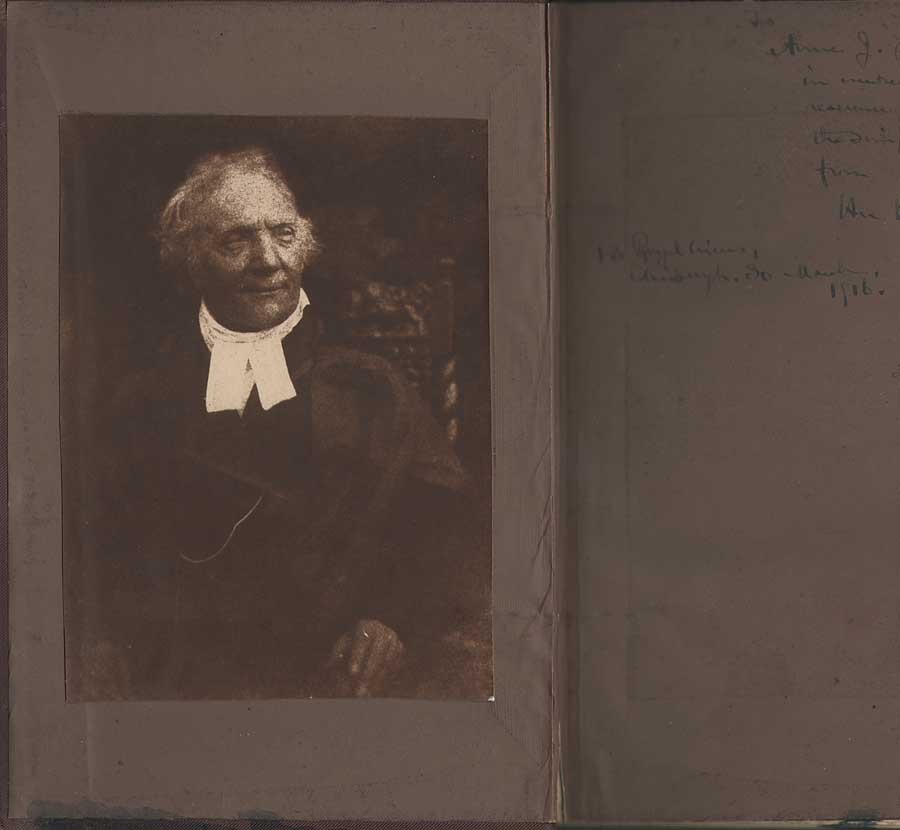 Pasted carbon print: ca. 1916: The Rev. Dr. Thomas Chalmers: (1780-1847) minister, social reformer, leader & first Moderator of the Free Church of Scotland Assembly, Principal of New College, Edinburgh.:15.2 x 11.1 cm: Jesse Bertram: after original ca. 1843 calotype by Hill & Adamson.: shown on opened, inside board cover to volume: "A Selection from the Correspondence of the late Thomas Chalmers, D.D. LL.D." : Edinburgh: Thomas Constable and Co. : 1853: from PhotoSeed Archive
Pasted carbon print: ca. 1916: The Rev. Dr. Thomas Chalmers: (1780-1847) minister, social reformer, leader & first Moderator of the Free Church of Scotland Assembly, Principal of New College, Edinburgh.:15.2 x 11.1 cm: Jesse Bertram: after original ca. 1843 calotype by Hill & Adamson.: shown on opened, inside board cover to volume: "A Selection from the Correspondence of the late Thomas Chalmers, D.D. LL.D." : Edinburgh: Thomas Constable and Co. : 1853: from PhotoSeed Archive
Activism, and a bit of Fate
As fate would have it, one of those involved with the Scottish Free Church movement was Fox-Talbot correspondent Sir David Brewster. A friend of “Disruption” general assembly moderator, the Rev. Dr. Thomas Chalmers, (1780-1847) who was a minister, social reformer and evangelical orator of high renown chiefly responsible for the secession from the established Church, Brewster early on had learned the Calotype process from his friend Talbot. Teaming with Saint Andrews University chemistry professor John Adamson, they in turn taught it to Adamson’s younger brother Robert Adamson in 1842 after he had moved to Edinburgh.
And the rest they say is history. With Brewster also present at the assembly signing with Hill, he in turn suggested the new process to the painter as a way to solve the dilemma of accurately portraying the hundreds of clergy and others present at the “Disruption” for posterity.
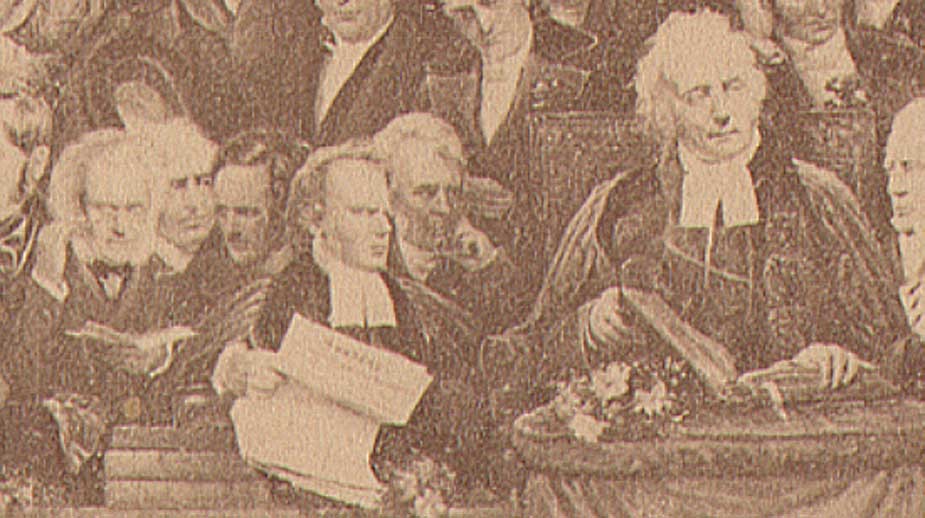 Detail: 1868: far right: Rev. Dr. Thomas Chalmers: Free Church of Scotland moderator along with major figures left to right: Scottish photography pioneer Sir David Brewster, (wearing spectacles looking down at book) Rev. Robert Lorimer, Rev. John Forbes, Dr. David Welsh: undivided Church of Scotland moderator holding a copy of May 18, 1843 church protest that was never answered, Dr. John Fleming, Chalmers. : Thomas Annan: vintage carbon copy photograph after D.O. Hill painting: "The Disruption of the Church of Scotland"completed 1866: original: (13.5 x 31.4 | 34.4 x 41.4 cm ) : from PhotoSeed Archive
Detail: 1868: far right: Rev. Dr. Thomas Chalmers: Free Church of Scotland moderator along with major figures left to right: Scottish photography pioneer Sir David Brewster, (wearing spectacles looking down at book) Rev. Robert Lorimer, Rev. John Forbes, Dr. David Welsh: undivided Church of Scotland moderator holding a copy of May 18, 1843 church protest that was never answered, Dr. John Fleming, Chalmers. : Thomas Annan: vintage carbon copy photograph after D.O. Hill painting: "The Disruption of the Church of Scotland"completed 1866: original: (13.5 x 31.4 | 34.4 x 41.4 cm ) : from PhotoSeed Archive
Twenty-three years later, most likely with the help of Hill’s second wife Amelia Paton, (1820-1904) a sculptress, the Disruption painting, measuring in finished at over 11 feet by 5 feet, was ready for public display. And this is where it gets interesting for the career of Thomas Annan (1829–1887) and much later, his son James Craig Annan. (1864-1946) The decision to copy the painting for a mass audience was never in doubt for Hill, a man well-connected with the Scottish publishing trade who was born into it; his father being a bookseller and publisher. Hill had even learned the art of lithography from an early age, using it in the reproduction of his own work as a landscape painter for 20 years.
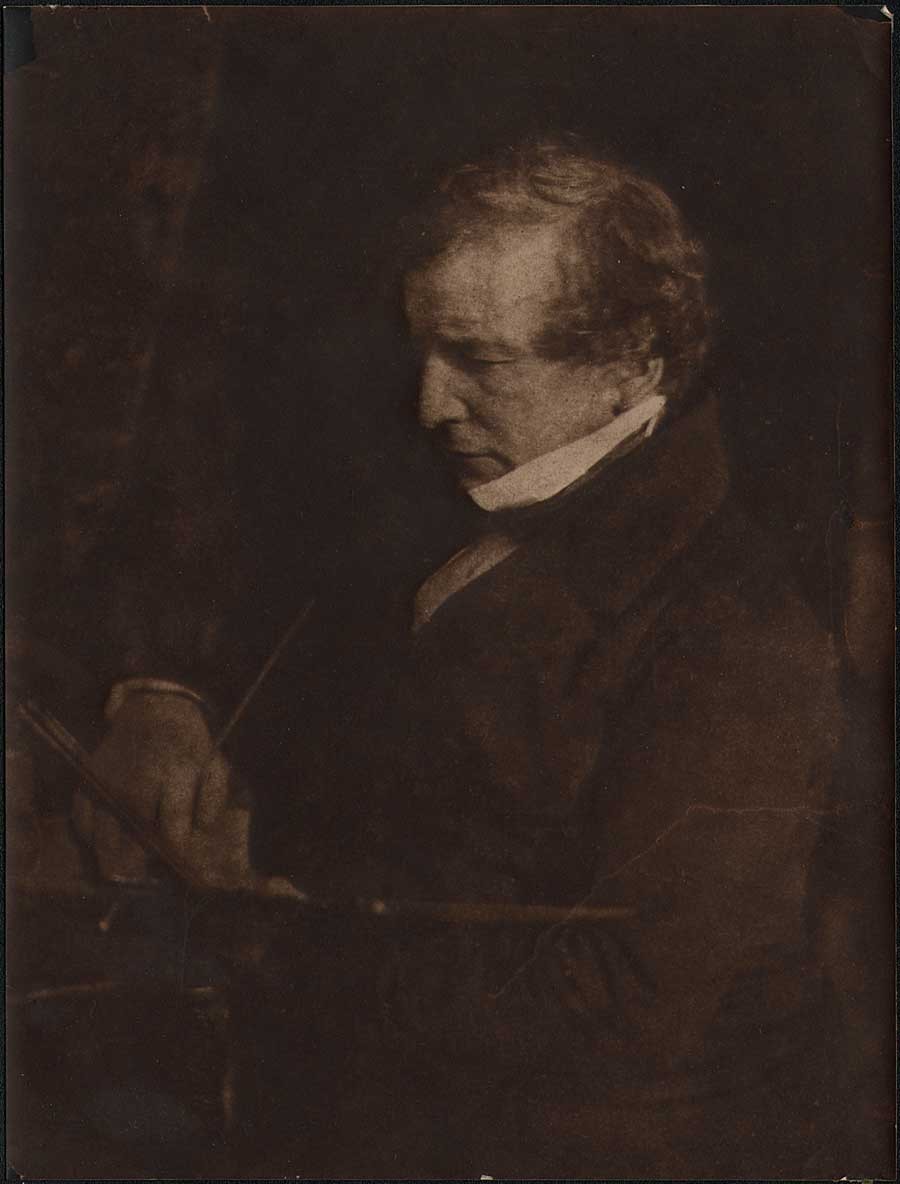 Carbon print: ca. 1879 - 1881 : William Etty, R.A. (English painter: 1787-1849) : Thomas Annan or James Craig Annan: after original 1844 calotype paper negative by Hill & Adamson: 18.5 x 14.0 cm: former collection: Exeter Camera Club: from PhotoSeed Archive
Carbon print: ca. 1879 - 1881 : William Etty, R.A. (English painter: 1787-1849) : Thomas Annan or James Craig Annan: after original 1844 calotype paper negative by Hill & Adamson: 18.5 x 14.0 cm: former collection: Exeter Camera Club: from PhotoSeed Archive
In 1865, shortly before his masterwork was finished, Hill made the acquaintance of Annan by reputation through his brother Alexander’s art gallery in Edinburgh. Annan’s copy paintings had been displayed there, for he had already made a name for himself in this line of work as early as 1862, producing fine copies of artwork for the Glasgow Art Union. These Art Unions “were lotteries connected with the major art exhibitions; the successful subscribers won paintings, and every subscriber received an engraving.” (3)
A commission resulted between Hill and Annan to copy Hill’s Disruption masterwork, a canvas that unfortunately- as opposed to the hundreds of Hill & Adamson calotypes used for reference works in its’ creation and now considered masterpieces of the photographic art-did not equate it to a masterpiece itself. Annan employed for this task an improved permanent carbon photographic process, using Joseph Wilson Swan’s 1864 patent carbon tissue to reproduce copies of the “Disruption” after purchasing the Scottish rights from him in 1866. (4.)
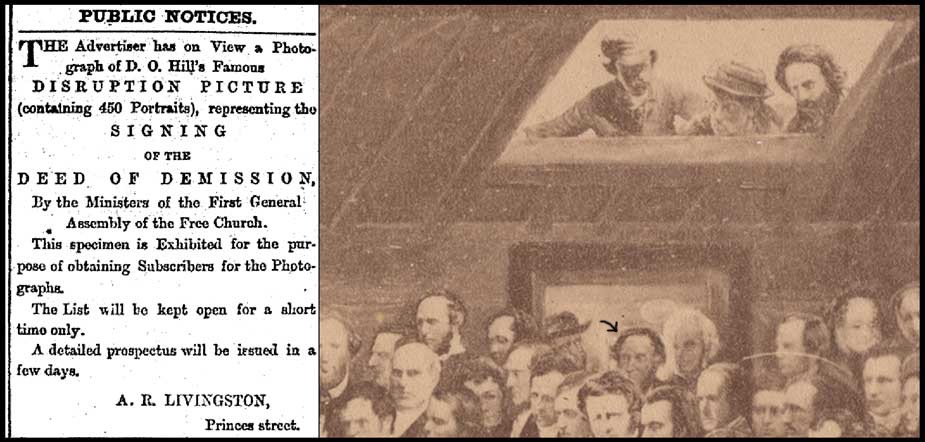 Left: 1868: advertisement: New Zealand bookseller A.R. Livingston's solicitation for Thomas Annan carbon photo of "Disruption Picture" completed 1866 by D.O. Hill: published in Otago Daily Times. Right: 1868: Detail: black arrow pointing to Thomas Annan standing in doorway painted as part of "Disruption" painting (another account states Annan is at left of this figure wearing hat) : Thomas Annan: vintage carbon copy photograph after D.O. Hill painting: "The Disruption of the Church of Scotland"completed 1866: original: (13.5 x 31.4 | 34.4 x 41.4 cm ) : from PhotoSeed Archive
Left: 1868: advertisement: New Zealand bookseller A.R. Livingston's solicitation for Thomas Annan carbon photo of "Disruption Picture" completed 1866 by D.O. Hill: published in Otago Daily Times. Right: 1868: Detail: black arrow pointing to Thomas Annan standing in doorway painted as part of "Disruption" painting (another account states Annan is at left of this figure wearing hat) : Thomas Annan: vintage carbon copy photograph after D.O. Hill painting: "The Disruption of the Church of Scotland"completed 1866: original: (13.5 x 31.4 | 34.4 x 41.4 cm ) : from PhotoSeed Archive
In addition to several detail photos of the painting included with this post, a mounted carbon copy photograph by Annan published in 1868 for the 25th anniversary of the signing of the Act of Separation and Deed of Demission can be seen in our archive here. For those adventurous enough to decipher names and titles of some of those making up the sea of faces in the painting, partly seen below, a fascinating, yet tricky key to some of the major figures can be found here. This was published as part of the 1943 centenary volume The Disruption Picture: A Memorial of the First General Assembly of the Free Church of Scotland by Donald MacKinnon. (5.)
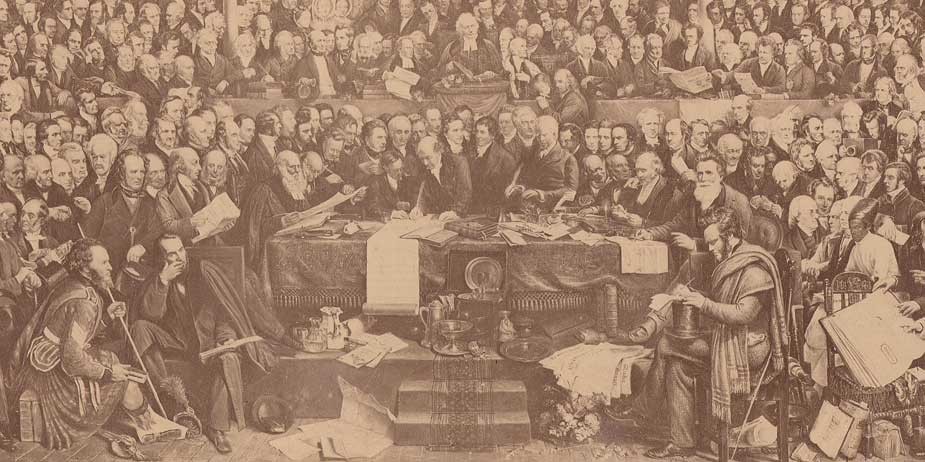 Detail: 1868: At center of table, the Rev. Dr. Patrick MacFarlan (1781-1849) of Greenock is first to sign the "Deed of Demission", "resigning the highest living in the Church of Scotland at the time", said to be £ 1000.00 annually, which commemorated the establishment of the Free Church of Scotland: Thomas Annan: vintage carbon copy photograph after D.O. Hill painting: "The Disruption of the Church of Scotland"completed 1866: original: (13.5 x 31.4 cm | 34.4 x 41.4 cm ) : from PhotoSeed Archive
Detail: 1868: At center of table, the Rev. Dr. Patrick MacFarlan (1781-1849) of Greenock is first to sign the "Deed of Demission", "resigning the highest living in the Church of Scotland at the time", said to be £ 1000.00 annually, which commemorated the establishment of the Free Church of Scotland: Thomas Annan: vintage carbon copy photograph after D.O. Hill painting: "The Disruption of the Church of Scotland"completed 1866: original: (13.5 x 31.4 cm | 34.4 x 41.4 cm ) : from PhotoSeed Archive
Thomas Annan, Documentarian
With Hill’s work complete, Thomas Annan’s professional career was starting to hit full stride, especially after his success with the Disruption commission. In 1868, the same year a version of this carbon photo was published, (6.) Annan undertook a new commission from the City of Glasgow Improvements Trust that when first published as a series of around 35 albumen prints in 1872, became known as The Old Closes & Streets of Glasgow. As previously outlined in my essay written in 2006 for the Luminous Lint website, Annan’s photographs taken between 1868-1871 are among the earliest done specifically for a record of slum housing conditions prior to urban renewal and as such are an important milestone in the history of documentary photography. (7)
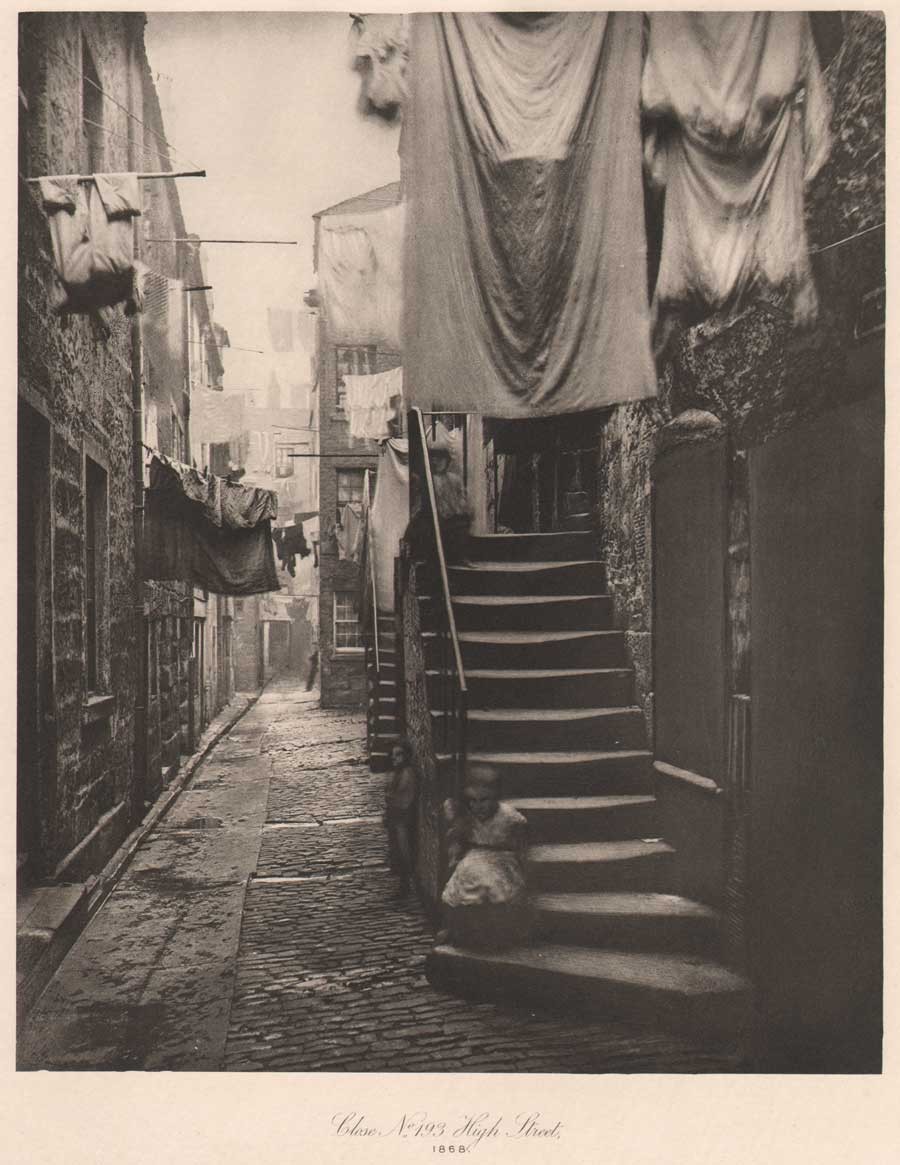 1868: vintage hand-pulled photogravure: "Close No. 193 High Street": Thomas Annan: from: "The Old Closes & Streets of Glasgow" - photographs taken for the City of Glasgow Improvements Trust : 22.2 x 18.1 | 38.0 x 28.5 cm: 1900: gravure from original collodion glass plate by James Craig Annan: Glasgow: plate #9 from James MacLehose & Sons limited edition of 100: from PhotoSeed Archive
1868: vintage hand-pulled photogravure: "Close No. 193 High Street": Thomas Annan: from: "The Old Closes & Streets of Glasgow" - photographs taken for the City of Glasgow Improvements Trust : 22.2 x 18.1 | 38.0 x 28.5 cm: 1900: gravure from original collodion glass plate by James Craig Annan: Glasgow: plate #9 from James MacLehose & Sons limited edition of 100: from PhotoSeed Archive
Perhaps knowing her husband’s photographic legacy might be carried on, Amelia Paton bequeathed to Annan “a large collection of calotypes and the portrait lens used by Hill and Adamson” after Hill’s death in 1870. (8.) Speculation he used this very lens for portraits taken soon after for his illustrated volume the Memorials of the Old College of Glasgow, (1871) with examples seen in this post, are an intriguing insight raised by Sara Stevenson in her biography of Annan. (9.) Proportionally, individual portraits taken by Hill & Adamson in the 1840’s compared with those by Annan of the professors from the Glasgow volume and are very similar. However, Annan had the advantage of using the collodion process as opposed to calotype, with the increase of sensitivity of these plates lending a sharpness to his work not possible as movement was often the inevitable result of the slower 2-3 minute exposures required for the older process.
A comparison showing the softness, beauty and masterful composition of a later generation carbon print portrait of English painter William Etty (1787-1849) done ca. 1843 by Hill and Adamson can be seen with this post along with portraits by Annan taken around 1870. These include the striking portrait of professor and theologian John Caird (1820-1898) that reveal compositional similarities between the photographers nearly 30 years apart. With the archival benefit of Annan printing his efforts in permanent carbon, it’s also amusing to see exposure times, although shorter than calotype, did not prevent him in at least one case from seizing the moment in order to permanently memorialize his subject and another unwitting one: a rather large housefly clinging to academic robes worn by University of Glasgow English Language and Literature Professor John Nichol.
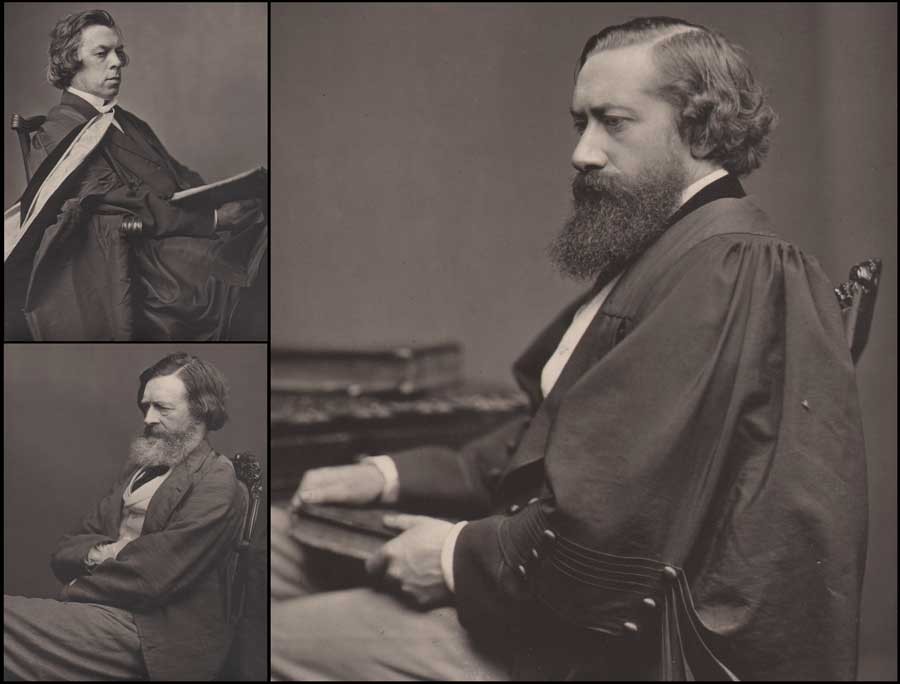 1871: Thomas Annan: mounted carbon portraits from"Memorials of the Old College of Glasgow"(each cropped) : all portraits 21.5 x 16.4 | 36.5 26.0 : upper left: Professor of Divinity John Caird (1820-1898) : lower left: Professor of Greek Edmund Law Lushington (1811-1893) : right: Regius Professor of English Language and Literature John Nichol (1833-1894) (note housefly on academic robe at right below chair back) : from PhotoSeed Archive
1871: Thomas Annan: mounted carbon portraits from"Memorials of the Old College of Glasgow"(each cropped) : all portraits 21.5 x 16.4 | 36.5 26.0 : upper left: Professor of Divinity John Caird (1820-1898) : lower left: Professor of Greek Edmund Law Lushington (1811-1893) : right: Regius Professor of English Language and Literature John Nichol (1833-1894) (note housefly on academic robe at right below chair back) : from PhotoSeed Archive
Besides University professors, Annan did many fine portraits of Free Church of Scotland ministers in addition to ministers, elders and missionaries affiliated with the United Presbyterian Church. A unique album of these portraits, reproduced in Woodburytype, is held by this archive, with several appearing in the 1875 Annan published volume Historical Notices of the United Presbyterian Congregations in Glasgow. As a businessman running a commercial studio, Annan marketed many of these images, often as variants, in the carte de visite format. The following is a listing of Annan’s Scotland studios with dates supplied by Peter Stubbs of the EdinPhoto web site:
202 Hope Street, Glasgow: 1862-72
77 Sauchiehall St. Glasgow: 1873-74
153 Sauchiehall St. Glasgow: 1875-91
75 Princes St. Edinburgh: 1876-82
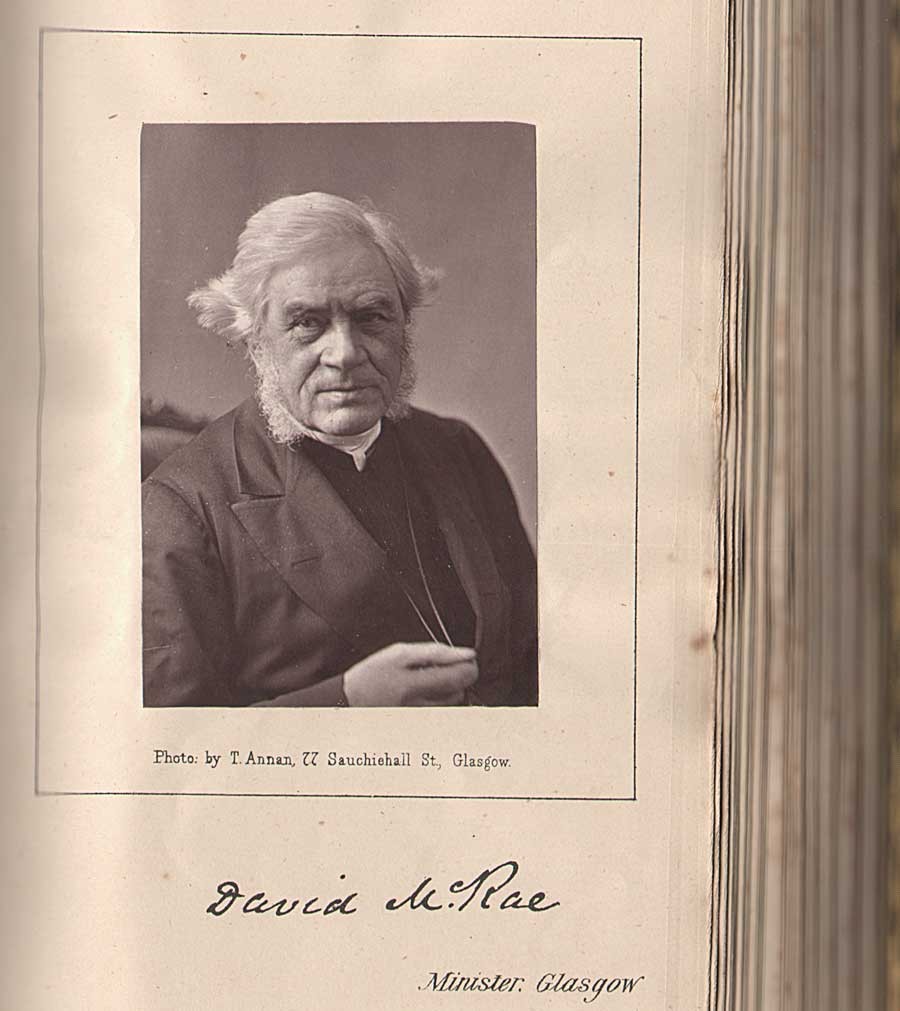 1873-74: Rev. David McRae of Glasgow: (a leading temperance movement leader from the 1850-70's) mounted Woodburytype portrait with facsimile autograph: Thomas Annan: 8.3 x 5.6 | 19.4 x 10.5 cm : from unique folio album of nearly 60 Woodburytype photographs taken ca. 1862-1882 by Thomas Annan and most likely John Annan of ministers, elders and missionaries affiliated with the United Presbyterian Church: from PhotoSeed Archive
1873-74: Rev. David McRae of Glasgow: (a leading temperance movement leader from the 1850-70's) mounted Woodburytype portrait with facsimile autograph: Thomas Annan: 8.3 x 5.6 | 19.4 x 10.5 cm : from unique folio album of nearly 60 Woodburytype photographs taken ca. 1862-1882 by Thomas Annan and most likely John Annan of ministers, elders and missionaries affiliated with the United Presbyterian Church: from PhotoSeed Archive
Coming full-circle: Learning Photogravure
In 1883, after purchasing the British rights to a new process of Photogravure invented by Czech artist Karl Klíc, (1841-1926) Thomas Annan and son James Craig Annan traveled to Vienna in order to personally learn its intricacies. As defined by our good friends over at Photogravure.com, Klíc’s 1879 refined process of “reproducing a photograph by printing on paper from an inked and etched copper plate” was a vast improvement over that of William Henry Fox Talbot’s 1858 patented Photoglyphic Engraving process. Thomas Annan was so smitten he wrote Klíc the following appreciation:
“I beg to express my entire satisfaction with your gravure process… The process itself is very valuable to a fine art publisher because of the beauty of the work and the crafted manner in which the plates are executed. With many thanks to me and my son I remain, Dear Sir, yours very truly” - Thomas Annan March 11, 1883 (10.)
Fittingly renamed the Talbot-Klíc Dust Grain Photogravure by Klíc, the process was soon fully embraced by Annan’s publishing concerns, T. & R. Annan and Sons of Glasgow, Hamilton and Edinburgh, who utilized photogravure for high-quality, fade-resistant and archival plates, mostly copies of original works of art, an established specialty. Soon, the new process, which involved the individual hand-pulling of plates from a copper-plate press, was further exploited and refined by the budding photographer James Craig Annan in the early 1890’s, whose original photographic negatives “from nature” during his travels to the Continent, particularly North Holland and Italy, were directly reproduced in gravure after an ongoing period of great experimentation and refinement.
Like his father Thomas, who reproduced and exhibited some of the Hill & Adamson calotypes in carbon during the 1870’s and early 80’s using his own refinements of Swan’s process, (11.) James Craig Annan fully embraced Talbot-Klíc gravure printing to reinterpret their landmark achievements in early pictorial portraiture as well as other studies including the fisherfolk of Newhaven near Edinburgh. In this regard, beginning as early as 1890, Annan produced a series of hand-pulled gravures re-photographed from the original Hill & Adamson paper calotype “negatives in the possession of Andrew Elliott.” (12.) Later in 1905, working as part of the T & R Annan firm of Glasgow, he produced a further series of 20 plates printed on Japan tissue. (13.) These copper plates were then re-used for a series of gravures published in Alfred Stieglitz’s Camera Work XI, (1905) XXVIII, (1909) and XXXVII, (1912) thereby introducing new generations to the masterful legacy left by Hill & Adamson.
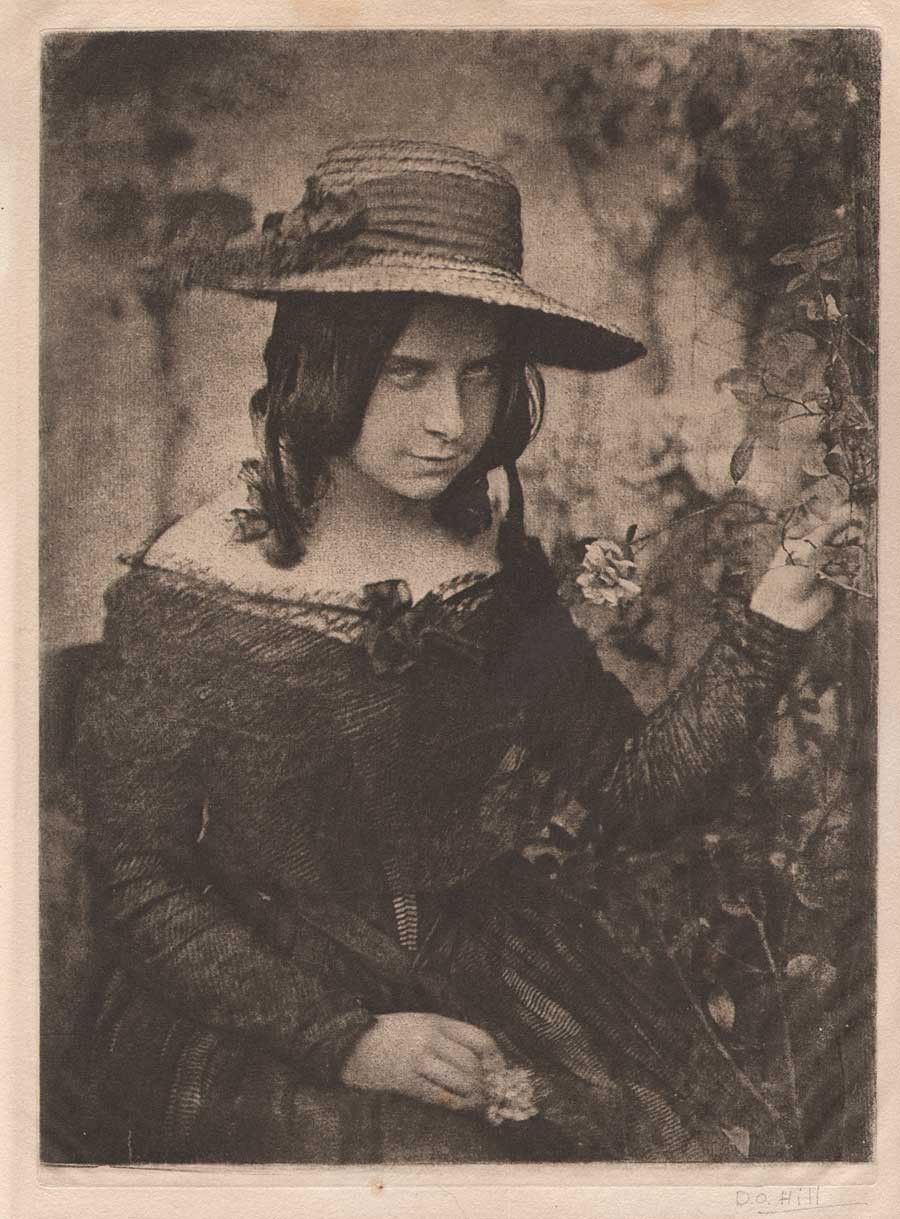 1890-1912: "Girl in Straw Hat" (Miss Mary McCandlish) : vintage hand-pulled photogravure trimmed and mounted within cream paper folder: possibly a 1912 Camera Work proof: 21.5 x 15.9 |25.5 x 19.0 cm: James Craig Annan after original paper calotype ca. 1843-47 by Hill & Adamson: reproduced in CW XXXVII: originally in Margaret Harker Collection: from PhotoSeed Archive
1890-1912: "Girl in Straw Hat" (Miss Mary McCandlish) : vintage hand-pulled photogravure trimmed and mounted within cream paper folder: possibly a 1912 Camera Work proof: 21.5 x 15.9 |25.5 x 19.0 cm: James Craig Annan after original paper calotype ca. 1843-47 by Hill & Adamson: reproduced in CW XXXVII: originally in Margaret Harker Collection: from PhotoSeed Archive
I’ll end this lengthy post with an excerpt from an appreciation of D.O. Hill by James Craig Annan, who was fortunate to have met and been inspired by the artist when he was only six years old- the result of his father being an intimate friend of Hill. This was included as part of a larger essay he wrote on the Scottish pioneer for Camera Work XI, and he makes the strong case their achievement was a direct result of their portrait collaborations for the Disruption painting:
“Thus the partnership began which was to produce the noble and extensive series of portraits which for powerful characterization and artistic quality of uniformly high excellence have certainly never been surpassed and possibly not even rivaled by any other photographer. This may seem an extravagant appreciation of Hill’s work, but it has been arrived at after mature deliberation.” (14.)
-David Spencer
Notes:
1. British Artists: Their Style and Character: With Engraved Illustrations. : David Octavius Hill, R.S.A.: in: The Art-Journal: London: October 1, 1869: p. 317
2. William F. Stapp.: Hill and Adamson: Artists of the Calotype: from: Image: George Eastman House: Spring/Summer: Vol. 36: No. 1-2: 1993: p. 55
3. Sara Stevenson: Scottish Masters 12: Thomas Annan: National Galleries of Scotland: 1990: p. 5
4. After discussions with Hill, the copy photograph of the “Disruption“canvas was taken by Thomas Annan after he had ordered “a large Photographic Camera of the latest and most perfect construction” from Dallmeyer: in: 1866 Disruption prospectus by Hill: published in: Scottish Masters 12: p. 7
5. Alan Newble has thoughtfully, and no doubt, painstakingly, compiled the key as part of his website, with further insights on the historical importance of the Rev. Dr. Thomas Chalmers.
6. In correspondence between Annan and Hill in late December, 1865, Hill stated he wanted the Disruption painting reproduced in thousands of photographs in 3 separate sizes. “He (Hill) was hoping for prints half the size of the painting, and suggested that Annan make them in three parts, joining them together around the figures rather than in an arbitrary straight line.” : from: Hill & Annan letters: quoted in: Scottish Masters 12: pp. 6-7. Alas, Hill’s desires were trumped by technical limitation, with carbon prints supplied by Annan printed in 1866 in 3 sizes, as stated in the Photographic News of London: “Photographs of the picture will be issued in three sizes, ranging from 24 inches by 9 inches to 48 inches by 21 1/4 inches, at prices ranging from a guinea and a half to twelve guineas.”
7. The carbon print edition of Old Closes first appeared in 1877, with two later photogravure editions featuring 50 plates each printed by James Craig Annan published in 1900. Fine examples of the albumen prints from Old Closes can be found along with superb background on their making at the University of Glasgow Library special collections department online resource found here.
8. cited in Scottish Masters 12: p. 8
9. Ibid: p. 13
10. from: Photogravure.com online resource accessed August, 2014. While in Vienna under Klíc’s watchful eye, the Annans had produced a photogravure of Noel Paton’s painting of The Fairy Raid.
11. Scottish Masters 12: p. 8
12. David Octavius Hill & Robert Adamson: in: The Collection of Alfred Stieglitz: Weston Naef: New York: The Metropolitan Museum of Art: p. 378. Elliott, (1830-1922) was a nephew of D.O. Hill
13. Ibid, p. 378
14. excerpt: David Octavius Hill, R.S.A. ⎯1802-1870.: J. Craig Annan: in: Camera Work XI: New York: edited and published by Alfred Stieglitz:1905: p. 18
Oh Say Can you See?
Posted July 2014 in History of Photography, Scientific Photography, Significant Photographs
Walt Whitman certainly did. Just check out his eyeballs on this photograph taken in 1887 by George C. Cox for confirmation. Especially on this most personal of American holidays, the Fourth of July, the continuing birthday idea of our messy, evolving experiment of a democratic republic called the United States can never be said to be boring.
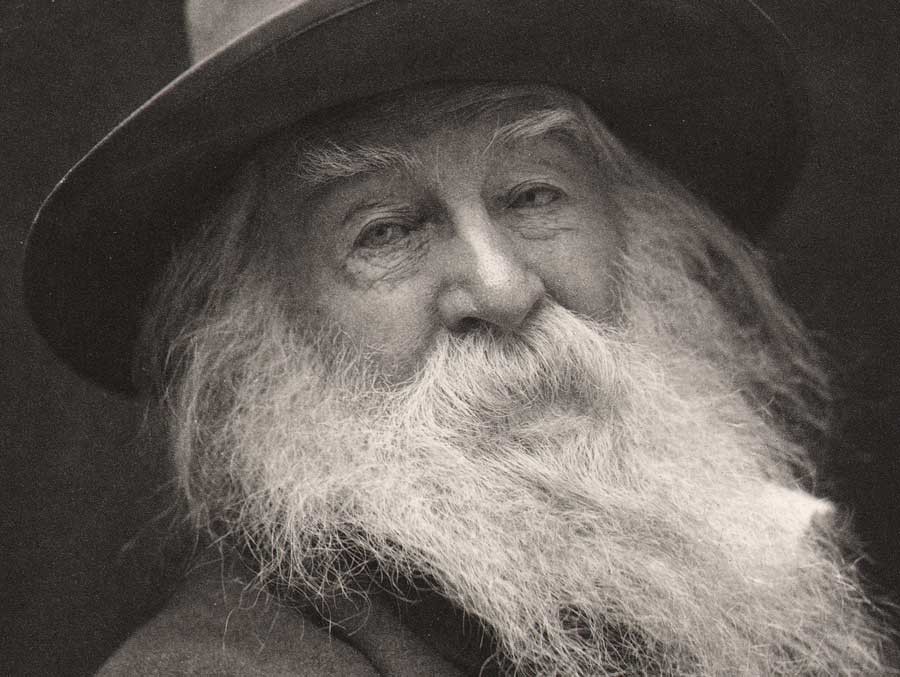 Detail: 1887: Walt Whitman-1819-1892 by George C. Cox: (portrait known as the "Laughing Philosopher") 23.9 x 18.8 cm | 45.2 x 33.3 cm: vintage large format, hand-pulled photogravure printed circa 1905-10 by the Photographische Gesellschaft in Berlin on Van Gelder Zonen plate paper. From: PhotoSeed Archive
Detail: 1887: Walt Whitman-1819-1892 by George C. Cox: (portrait known as the "Laughing Philosopher") 23.9 x 18.8 cm | 45.2 x 33.3 cm: vintage large format, hand-pulled photogravure printed circa 1905-10 by the Photographische Gesellschaft in Berlin on Van Gelder Zonen plate paper. From: PhotoSeed Archive
Need proof of his vision? - Whitman’s metaphorical call in this famous quote: “What is that you express in your eyes?” ; and response: “It seems to me more than all the print I have read in my life.”
You could say America’s poet (1819-1892) of the everyman didn’t need a camera, he was one. His genius of observation, something all great photographers possess, gave him the power to indelibly express his convictions. So when words flowed from his pen, they possessed the power of photographs, especially on the very idea of America in the aftermath of the Civil War:
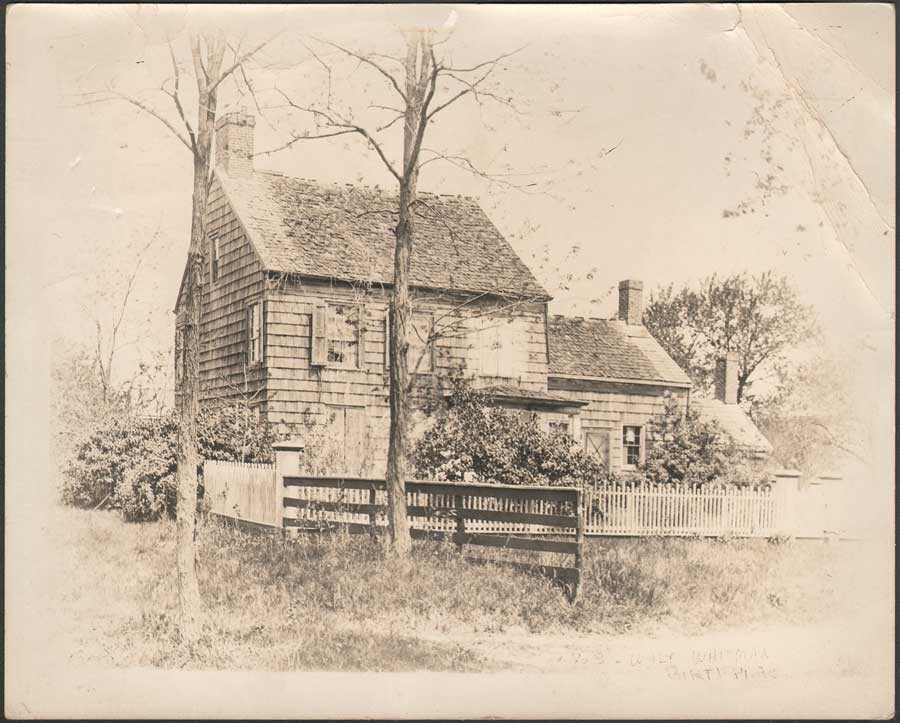 "Walt Whitman Birthplace in 1903" (South Huntington, New York): by Ben Conklin: 1903: vintage albumen print: 20.3 x 25.2 cm from: PhotoSeed Archive: (Benjamin Sargent Conklin: 1873-1964)
"Walt Whitman Birthplace in 1903" (South Huntington, New York): by Ben Conklin: 1903: vintage albumen print: 20.3 x 25.2 cm from: PhotoSeed Archive: (Benjamin Sargent Conklin: 1873-1964)
from Leaves of Grass: intro to “Thoughts”:
Of these years I sing,
How they pass and have pass’d through convuls’d pains, as
through parturitions,
How America illustrates birth, muscular youth, the promise, the
sure fulfilment, the absolute success, despite of people-
illustrates evil as well as good,
The vehement struggle so fierce for unity in one’s-self;
How many hold despairingly yet to the models departed, caste,
myths obedience, compulsion, and to infidelity, … (1.)
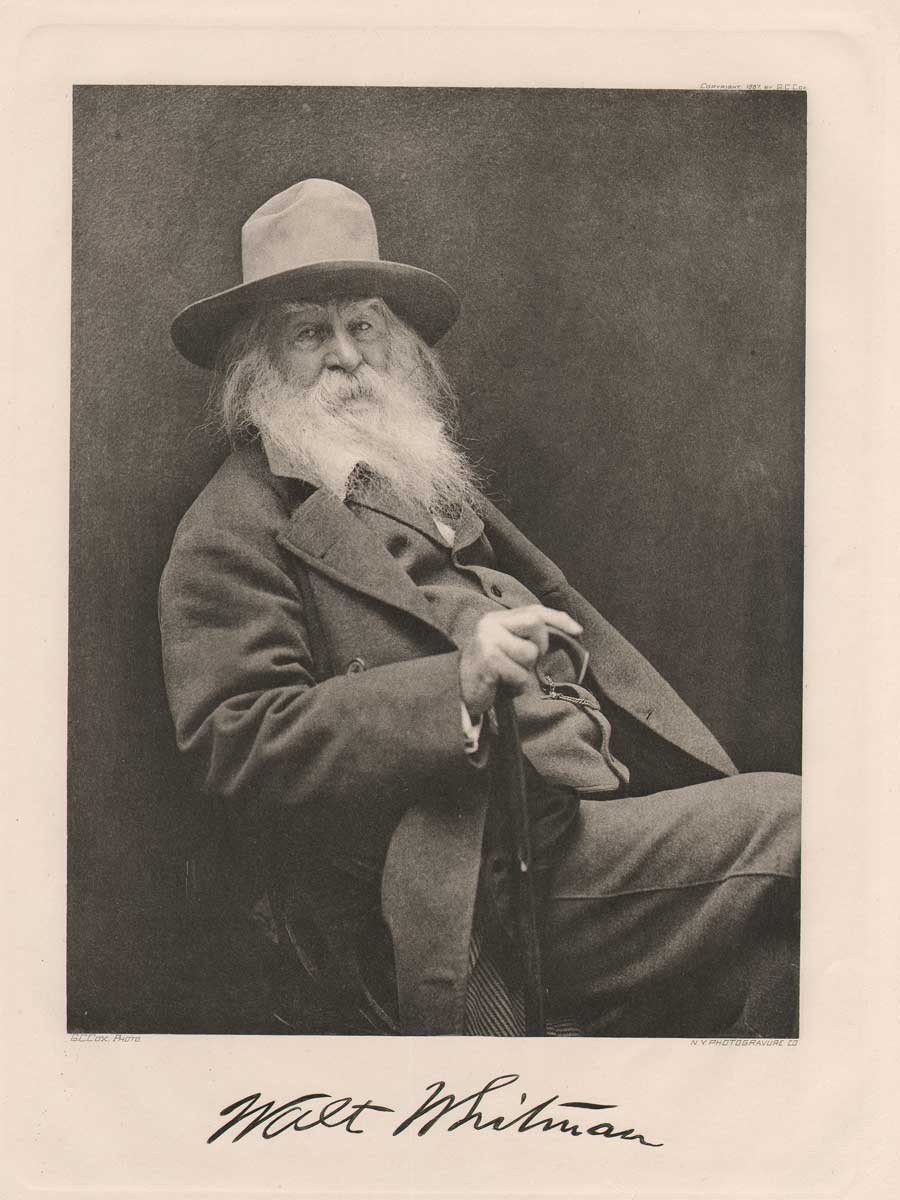 "Walt Whitman" by George C. Cox: 1887. Hand-pulled photogravure published in periodical "Sun & Shade" New York: March, 1892: whole #43: N.Y. Photogravure Co.: 21.5 x 16.7 cm | 34.7 x 27.4 cm: from: PhotoSeed Archive
"Walt Whitman" by George C. Cox: 1887. Hand-pulled photogravure published in periodical "Sun & Shade" New York: March, 1892: whole #43: N.Y. Photogravure Co.: 21.5 x 16.7 cm | 34.7 x 27.4 cm: from: PhotoSeed Archive
But enough of the history lesson. Since most of us will never rise to the level of a Whitman in prose, photography as an art form is a comparably easy stretch. Speaking for myself as a young newspaper photographer in the mid 1980’s hunched over a light table editing film, an early mentor told me as long as a person’s eyes in the negative were tack sharp through the loupe, it was a “keeper”, and worthy of publication.
And so it was for my colleagues a century before my own light table revelation, but with the slow, fragile dry plates in use at the time a much greater technical challenge. In 1887, New York portrait photographer George Collins Cox (1851-1902) had the sitting of a lifetime in none other than Whitman. Strolling into his New York studio with oversized fedora, it was 22 years to the day no less on April 15th when American president Abraham Lincoln finally succumbed to an assassin’s bullet in 1865.
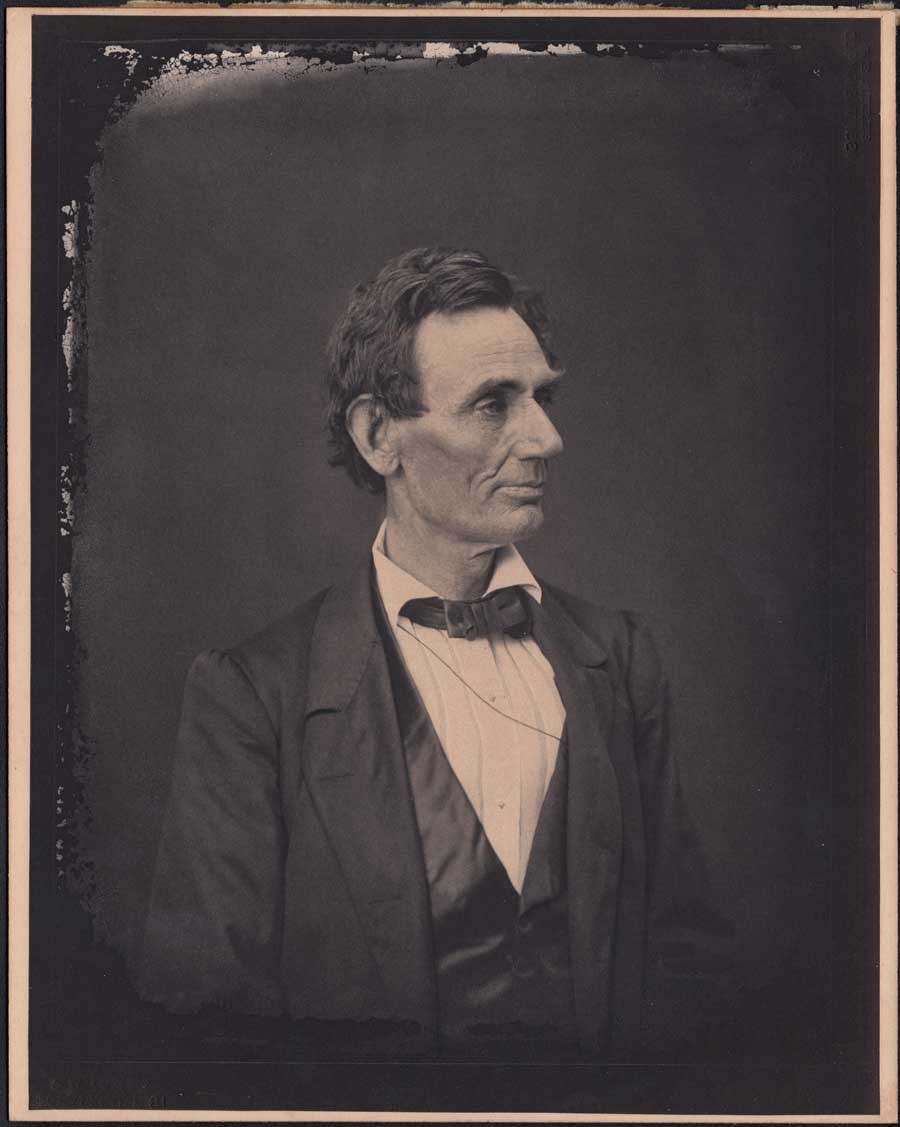 Abraham Lincoln by Alexander Hesler (1823-July 4th, 1895):taken in Springfield, Illinois on June 3, 1860: vintage platinum print © 1881 by George Bucher Ayres: print from late 1890's: Meserve #26|Ostendorf #26" One of the most famous Walt Whitman poems, "O Captain! My Captain!", eulogizing the death of this American president, was written by Whitman in 1865: from: PhotoSeed Archive
Abraham Lincoln by Alexander Hesler (1823-July 4th, 1895):taken in Springfield, Illinois on June 3, 1860: vintage platinum print © 1881 by George Bucher Ayres: print from late 1890's: Meserve #26|Ostendorf #26" One of the most famous Walt Whitman poems, "O Captain! My Captain!", eulogizing the death of this American president, was written by Whitman in 1865: from: PhotoSeed Archive
And he nailed it, as they say in America. Eyes tack sharp. The following historical account of the Whitman portrait sitting from the Charles E. Feinberg Collection at the Library of Congress gives a nice working account of Cox the photographer in action. A result of that session: the “Laughing Philosopher”, was the title Whitman declared as his favorite:
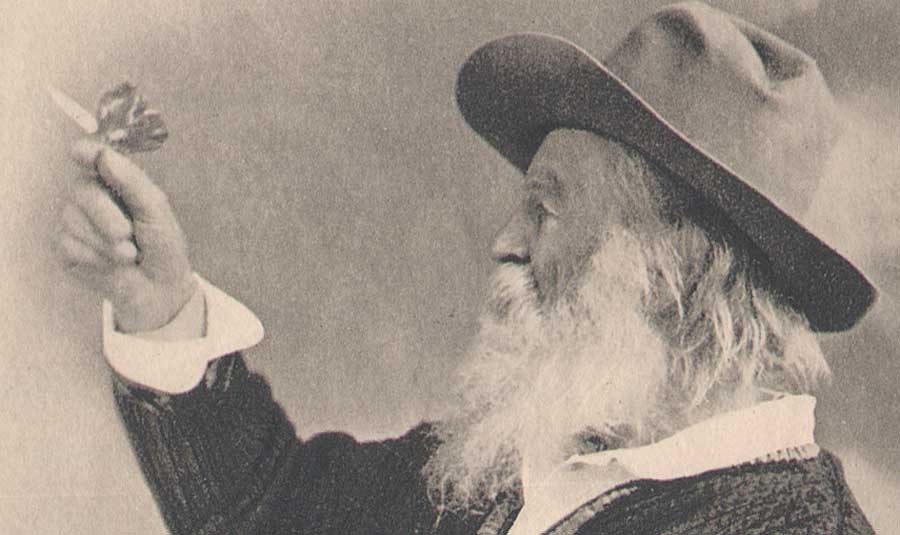 Detail: "Walt Whitman and the Butterfly" :1877(?):by W. Curtis Taylor of Broadbent & Taylor (Philadelphia): vintage hand-pulled vellum photogravure: 13.8 x 9.8 cm | 22.6 x 15.0 cm: from: Leaves of Grass II: The Complete Writings of Walt Whitman: New York:1902: Henry W. Knight:National Edition limited to 500 copies:"In fact, the "butterfly" was clearly a photographic prop now in the collections of the Library of Congress. The die-cut cardboard butterfly is imprinted with the lyrics to a John Mason Neale hymn and the word "Easter" in large capital letters."… What is not often noted is that the photo simply enacts one of the recurrent visual emblems in the 1860 edition of Leaves: a hand with a butterfly perched on a finger. …"The butterfly … represents, of course, Psyche, his soul, his fixed contemplation of which accords with his declaration: 'I need no assurances; I am a man who is preoccupied of his own soul.'"- The Walt Whitman Archive online resource- from: PhotoSeed Archive
Detail: "Walt Whitman and the Butterfly" :1877(?):by W. Curtis Taylor of Broadbent & Taylor (Philadelphia): vintage hand-pulled vellum photogravure: 13.8 x 9.8 cm | 22.6 x 15.0 cm: from: Leaves of Grass II: The Complete Writings of Walt Whitman: New York:1902: Henry W. Knight:National Edition limited to 500 copies:"In fact, the "butterfly" was clearly a photographic prop now in the collections of the Library of Congress. The die-cut cardboard butterfly is imprinted with the lyrics to a John Mason Neale hymn and the word "Easter" in large capital letters."… What is not often noted is that the photo simply enacts one of the recurrent visual emblems in the 1860 edition of Leaves: a hand with a butterfly perched on a finger. …"The butterfly … represents, of course, Psyche, his soul, his fixed contemplation of which accords with his declaration: 'I need no assurances; I am a man who is preoccupied of his own soul.'"- The Walt Whitman Archive online resource- from: PhotoSeed Archive
”On the morning of April 15th, 1887, George Cox took several photographs of Whitman, who was celebrating the success of his New York lecture on Lincoln, delivered the day before. Whitman recalls that “six or seven” photos were made during the session, but Whitman’s friend Jeannette Gilder, an observer of the session, said there were many more than that: ‘He must have had twenty pictures taken, yet he never posed for a moment. He simply sat in the big revolving chair and swung himself to the right or to the left, as Mr. Cox directed, or took his hat off or put it on again, his expression and attitude remaining so natural that no one would have supposed he was sitting for a photograph.“ (2.)
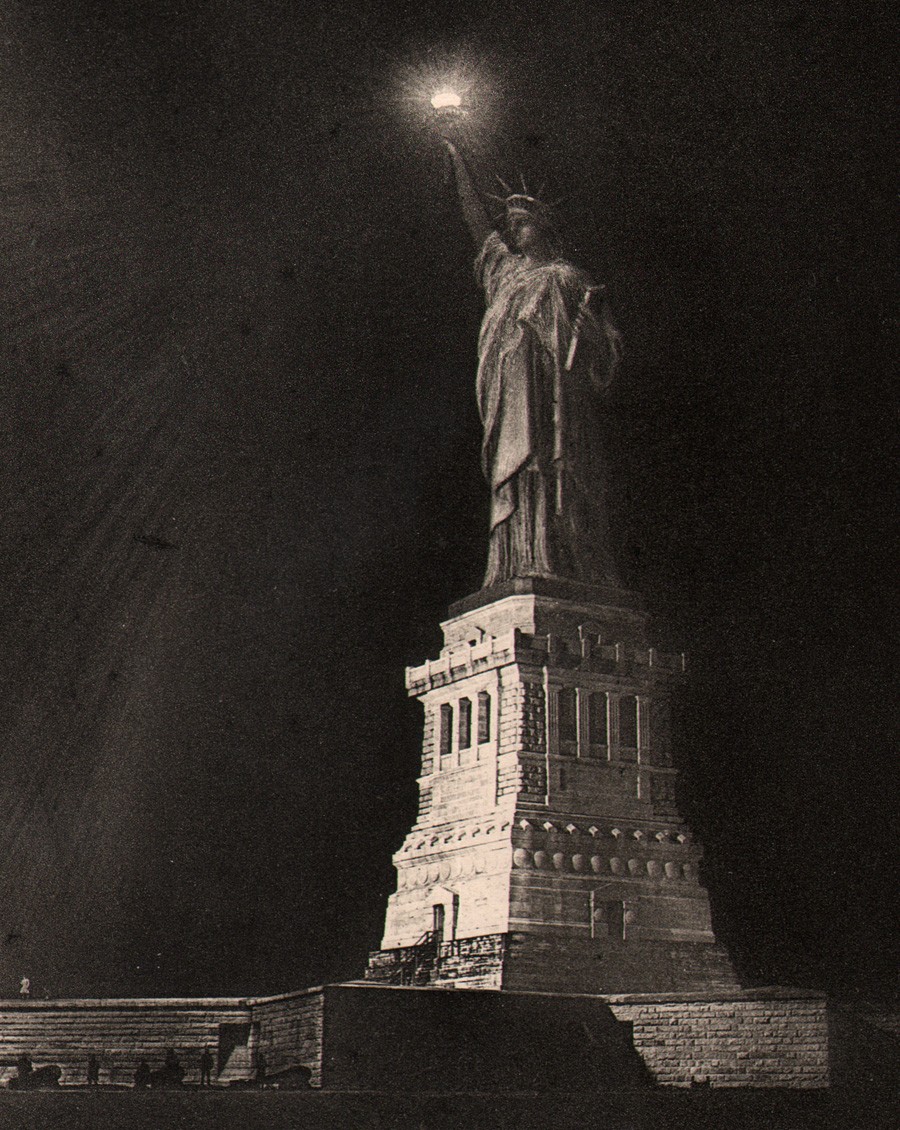 Detail: "Statue of Liberty at Night": Seneca Ray Stoddard: Hand-pulled photogravure published in periodical "Sun & Shade" New York: September, 1890: whole #25: N.Y. Photogravure Co.: 18.5 x 12.0 cm 35.2 cm x 27.6 cm: For many, the dream of America still holds true in the light, or darkness, of Lady Liberty's torch-even when viewed against the backdrop of the messy, evolving experiment of a democratic republic called the United States- one fully embraced in the writings of Walt Whitman. A technical description of this photograph copyrighted in 1889 by Stoddard: "Mr. Stoddard employed five cameras on this occasion, stationing them on the Steamboat Pier. A wire was stretched from the torch of the Statue to the mast of a vessel a considerable distance away. Placed on this wire, controlled by a pulley, was a cup containing one and one-half pounds of flash powder; an electric wire was connected with it, and at a given signal the current turned on, by the electrician in charge of the torch, the flash exploded and the exposure made." from: PhotoSeed Archive
Detail: "Statue of Liberty at Night": Seneca Ray Stoddard: Hand-pulled photogravure published in periodical "Sun & Shade" New York: September, 1890: whole #25: N.Y. Photogravure Co.: 18.5 x 12.0 cm 35.2 cm x 27.6 cm: For many, the dream of America still holds true in the light, or darkness, of Lady Liberty's torch-even when viewed against the backdrop of the messy, evolving experiment of a democratic republic called the United States- one fully embraced in the writings of Walt Whitman. A technical description of this photograph copyrighted in 1889 by Stoddard: "Mr. Stoddard employed five cameras on this occasion, stationing them on the Steamboat Pier. A wire was stretched from the torch of the Statue to the mast of a vessel a considerable distance away. Placed on this wire, controlled by a pulley, was a cup containing one and one-half pounds of flash powder; an electric wire was connected with it, and at a given signal the current turned on, by the electrician in charge of the torch, the flash exploded and the exposure made." from: PhotoSeed Archive
1. from “Thoughts” Leaves of Grass II: The Complete Writings of Walt Whitman: New York:1902: Henry W. Knight, publisher: National (limited) Edition: p. 275
2. excerpt: Walt Whitman Archive online resource accessed July, 2014
Modernism: meet Pictorialism
Posted March 2014 in Composition, History of Photography, Significant Photographs
When evaluating the chiaroscuro masterpiece Campo San Margherita by James Craig Annan, a striking vertical composition taken in 1894 during his visit to the Campo San Margherita piazza in Venice-an outdoor market and tourist destination still popular today- the idea of Modernism, a decidedly 20th Century school as applied to the photographic arts, should be taken seriously considering the intent and evidence posed by this finished work.
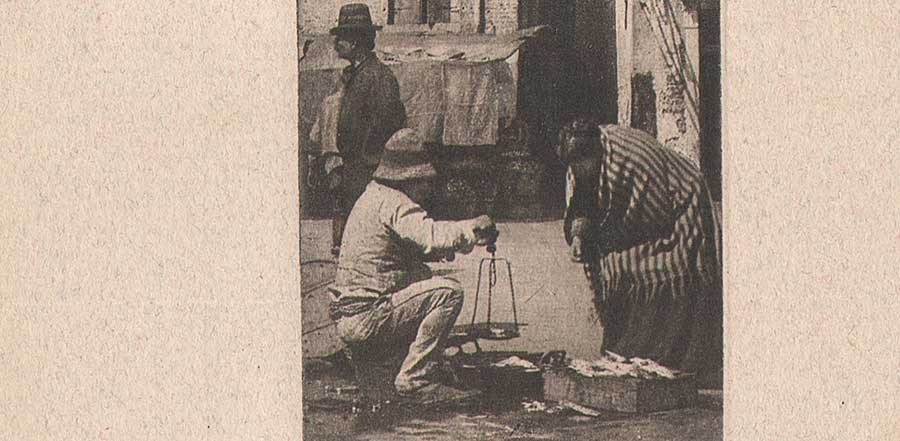 Detail: "Campo San Margherita": vintage hand-pulled photogravure by James Craig Annan published in Bulletin de l'Association Belge de Photographie: June, 1897: image: 15.0 x 5.1 cm: laid paper support: 22.6 x 15.0 cm: from PhotoSeed Archive
Detail: "Campo San Margherita": vintage hand-pulled photogravure by James Craig Annan published in Bulletin de l'Association Belge de Photographie: June, 1897: image: 15.0 x 5.1 cm: laid paper support: 22.6 x 15.0 cm: from PhotoSeed Archive
Documentary, cubist in form and radically pictorial for its time, this slice of life study showing the interaction of a market vendor and customer can be dissected for compositional posterity with the intent a post-mortem of sorts by this reviewer is reason enough when re-considering the historical record of early photographic aesthetics.
First off, Scotsman Annan was a master engraver and pioneer of the hand-pulled photogravure, an intaglio process similar to etching, but with the matrix of a photographic negative “from life” doing the stand-in for the artists brush or pencil. With this control afforded, the photographic results transferred to a copper plate could be altered at will depending on artistic intent, giving Annan the ability to subtly control and change aspects of his composition after he took the initial exposure by camera.
Arbitrarily beginning at the bottom of the frame, a subtle flow begins to develop reaching near the top of this composition. Here we see the Campo San Margherita title, with letters spanning the entire width of the vertical composition placed in its own compartmentalized box serving as anchor to the entire work.
 Detail: title: "Campo San Margherita": vintage hand-pulled photogravure by James Craig Annan published in Bulletin de l'Association Belge de Photographie: June, 1897: image: 15.0 x 5.1 cm: laid paper support: 22.6 x 15.0 cm: from PhotoSeed Archive
Detail: title: "Campo San Margherita": vintage hand-pulled photogravure by James Craig Annan published in Bulletin de l'Association Belge de Photographie: June, 1897: image: 15.0 x 5.1 cm: laid paper support: 22.6 x 15.0 cm: from PhotoSeed Archive
From here, the eye travels upwards. With an engraver’s burin, Annan deliberately alters a portion of highlighted marketplace cobblestones to a shaded version- the result being complimentary, contrasting diagonals now taking residence within the dead-zone of space created by his decision to present the work as an extreme vertical composition from the outset.
This in turn brings us to the very center of the frame. Without reading too much into it, the scale itself is the perfect symbol for what Annan achieves in this area we are most interested in visually. Holding it out while weighing a marketplace purchase for his customer opposite, the vendor’s action gives credibility to the idea a kind of balance has been created and achieved at the very center of the frame, especially after she conveniently stoops to his same level while contemplating the purchase.
The rest of the frame serving as backdrop to this drama in the middle compliments everything else within in, but with a twist. Instead of a purely static presentation of a lone moment occurring in the marketplace, the hat-wearing gentleman walking directly behind the vendor preparing to bust out of the frame gives a refreshing jolt to the work. Annan’s inclusion of this other action reminds us the marketplace bustles with life.
Finally, the central part of the background: a large shaded alleyway dividing two separate buildings anchoring the entire left and right margins of the frame, neatly compliments the balance of the two windows seen behind the man wearing the hat. Here, the area of the arched window frame in the top left of the composition reaches upwards to its natural conclusion: another area of naturally shaded discoloration similar in tone and effect Annan manipulated for the bottom third of the frame.
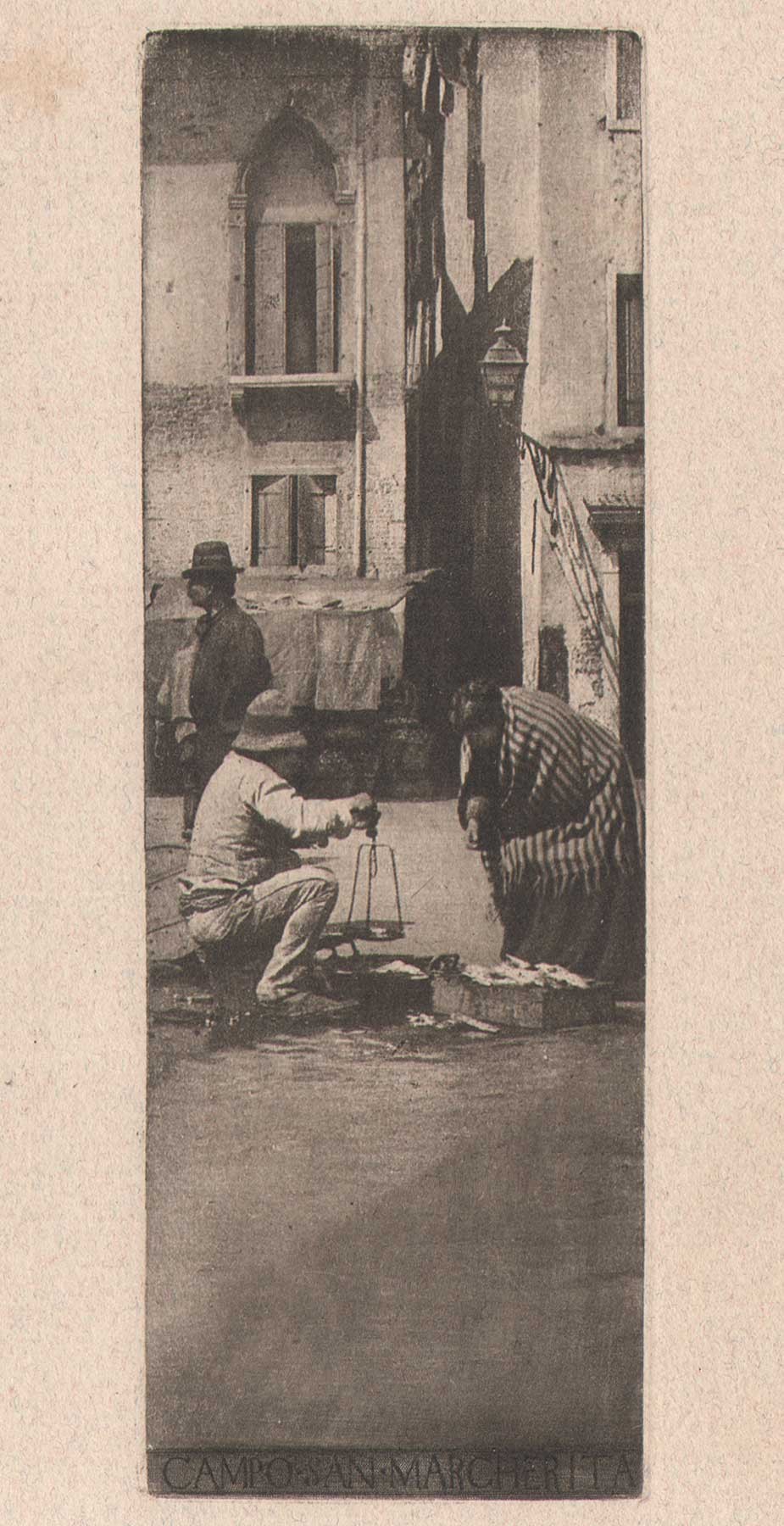 "Campo San Margherita"-cropped to include part of margins: vintage hand-pulled photogravure by James Craig Annan published in Bulletin de l'Association Belge de Photographie: June, 1897: image: 15.0 x 5.1 cm: laid paper support: 22.6 x 15.0 cm: from PhotoSeed Archive
"Campo San Margherita"-cropped to include part of margins: vintage hand-pulled photogravure by James Craig Annan published in Bulletin de l'Association Belge de Photographie: June, 1897: image: 15.0 x 5.1 cm: laid paper support: 22.6 x 15.0 cm: from PhotoSeed Archive
But this is just one opinion, albeit from someone who has spent a lifetime constructing and deconstructing photographs. Hopefully, this insight into one singular example of Annan’s art might give others the chance to see his motives and intent for what they are: a strong example of photographic Modernism ahead of his time.
David Spencer-